ZyXEL Communications V630 VoIP Wi-Fi Phone User Manual SMG 700 User s Guide V1 00 Nov 2004
ZyXEL Communications Corporation VoIP Wi-Fi Phone SMG 700 User s Guide V1 00 Nov 2004
user manual

www.zyxel.com
V630
VoIP Wi-Fi Phone
User’s Guide
Version 1.00
5/2008
Edition 1

About This User's Guide
V630 User’s Guide 3
About This User's Guide
Intended Audience
This manual is intended for people who want to configure the V630 using the keypad or web
configurator.
Related Documentation
• Quick Start Guide
The Quick Start Guide is designed to help you connect and make wireless VoIP calls right
away.
"See the web configurator sections of this User’s Guide for background
information on features that you can configure in the web configurator.
• Supporting Disk
Refer to the included CD for support documents.
• ZyXEL Web Site
Please refer to www.zyxel.com for additional support documentation and product
certifications.
User’s Guide Feedback
Help us help you. Send all User’s Guide-related comments, questions or suggestions for
improvement to the following address, or use e-mail instead. Thank you!
The Technical Writing Team,
ZyXEL Communications Corp.,
6 Innovation Road II,
Science-Based Industrial Park,
Hsinchu, 300, Taiwan.
E-mail: techwriters@zyxel.com.tw

Document Conventions
V630 User’s Guide
4
Document Conventions
Warnings and Notes
These are how warnings and notes are shown in this User’s Guide.
1Warnings tell you about things that could harm you or your V630.
"Notes tell you other important information (for example, other things you may
need to configure or helpful tips) or recommendations.
Syntax Conventions
• The V630 may be referred to as the “V630”, the “device”, the “system” or the “product” in
this User’s Guide.
• Product labels, screen names, field labels and field choices are all in bold font.
• A key stroke is denoted by square brackets and uppercase text, for example, [ENTER]
means the “enter” or “return” key on your keyboard.
• “Enter” means for you to type one or more characters and then press the [ENTER] key.
“Select” or “choose” means for you to use one of the predefined choices.
• A right angle bracket ( > ) within a screen name denotes a mouse click. For example,
Maintenance > Log > Log Setting means you first click Maintenance in the navigation
panel, then the Log sub menu and finally the Log Setting tab to get to that screen.
• Units of measurement may denote the “metric” value or the “scientific” value. For
example, “k” for kilo may denote “1000” or “1024”, “M” for mega may denote “1000000”
or “1048576” and so on.
• “e.g.,” is a shorthand for “for instance”, and “i.e.,” means “that is” or “in other words”.
Icons Used in Figures
Figures in this User’s Guide may use the following generic icons. The V630 icon is not an
exact representation of your V630.

Document Conventions
V630 User’s Guide 5
Table 1 Common Icons
V630 Computer Notebook
Server Printer Telephone
Switch Router Internet Cloud
Firewall Modem Wireless Signal

Safety Warnings
V630 User’s Guide
6
Safety Warnings
1For your safety, be sure to read and follow all warning notices and instructions.
• Do NOT use this product near water, for example, in a wet basement or near a swimming
pool.
• Do NOT expose your device to dampness, dust or corrosive liquids.
• Do NOT store things on the device.
• Do NOT install, use, or service this device during a thunderstorm. There is a remote risk
of electric shock from lightning.
• Connect ONLY suitable accessories to the device.
• Do NOT open the device or unit. Opening or removing covers can expose you to
dangerous high voltage points or other risks. ONLY qualified service personnel should
service or disassemble this device. Please contact your vendor for further information.
• Use ONLY an appropriate power adaptor or cord for your device. Connect it to the right
supply voltage (for example, 110V AC in North America or 230V AC in Europe).
• Do NOT allow anything to rest on the power adaptor or cord and do NOT place the
product where anyone can walk on the power adaptor or cord.
• Do NOT use the device if the power adaptor or cord is damaged as it might cause
electrocution.
• If the power adaptor or cord is damaged, remove it from the device and the power source.
• CAUTION: RISK OF EXPLOSION IF BATTERY (on the motherboard) IS REPLACED
BY AN INCORRECT TYPE. DISPOSE OF USED BATTERIES ACCORDING TO THE
INSTRUCTIONS. Dispose them at the applicable collection point for the recycling of
electrical and electronic equipment. For detailed information about recycling of this
product, please contact your local city office, your household waste disposal service or the
store where you purchased the product.
• Do NOT attempt to repair the power adaptor or cord. Contact your local vendor to order a
new one.
This product is recyclable. Dispose of it properly.

Safety Warnings
V630 User’s Guide 7

Safety Warnings
V630 User’s Guide
8

Contents Overview
V630 User’s Guide 9
Contents Overview
Introduction ............................................................................................................................27
Introducing the V630 ................................................................................................................. 29
LCD Screen Menus ................................................................................................................33
Using the LCD Screen ............................................................................................................... 35
Call Log LCD Menus ................................................................................................................. 41
Profiles LCD Menus ................................................................................................................... 43
General Setup LCD Menus ....................................................................................................... 49
Network LCD Menus ................................................................................................................. 69
The Phonebook ......................................................................................................................... 99
Call Options ............................................................................................................................. 109
The Web Configurator ......................................................................................................... 111
Introducing the Web Configurator .............................................................................................113
Information Screen ...................................................................................................................117
WLAN Profile ............................................................................................................................119
Call Setting .............................................................................................................................. 125
Phone Book ............................................................................................................................. 127
SIP Account Setup .................................................................................................................. 129
Auto Provision ......................................................................................................................... 137
System, Troubleshooting, and Specifications ..................................................................139
System ..................................................................................................................................... 141
Troubleshooting ....................................................................................................................... 145
Product Specifications ............................................................................................................. 151
Appendices and Index .........................................................................................................155

Contents Overview
V630 User’s Guide
10

Table of Contents
V630 User’s Guide 11
Table of Contents
About This User's Guide..........................................................................................................3
Document Conventions............................................................................................................4
Safety Warnings........................................................................................................................6
Contents Overview ...................................................................................................................9
Table of Contents....................................................................................................................11
List of Figures .........................................................................................................................17
List of Tables...........................................................................................................................23
Part I: Introduction................................................................................. 27
Chapter 1
Introducing the V630 ..............................................................................................................29
1.1 Overview .............................................................................................................................. 29
1.2 Applications ......................................................................................................................... 29
1.2.1 Make Calls via Internet Telephony Service Provider .................................................. 29
1.2.2 Make Calls via IP-PBX ............................................................................................... 30
1.2.3 Make Peer to Peer Calls ............................................................................................ 31
1.3 Ways to Manage the V630 .................................................................................................. 31
1.4 Good Habits for Managing the V630 ................................................................................... 31
Part II: LCD Screen Menus.................................................................... 33
Chapter 2
Using the LCD Screen ............................................................................................................35
2.1 Entering the Menu System .................................................................................................. 35
2.2 Navigation ............................................................................................................................ 35
2.3 Entering Numbers, Letters and Symbols ............................................................................. 36
2.4 LCD Menu Overview ........................................................................................................... 37
Chapter 3
Call Log LCD Menus...............................................................................................................41

Table of Contents
V630 User’s Guide
12
3.1 Call Log ............................................................................................................................... 41
3.2 Received Calls ..................................................................................................................... 41
Chapter 4
Profiles LCD Menus................................................................................................................43
4.1 Profiles Setup ...................................................................................................................... 43
4.2 Phone Profile Options .......................................................................................................... 43
4.3 Phone Profile Personalization ............................................................................................. 44
4.4 Tone Personalization ........................................................................................................... 45
4.5 Ring Tone Personalization ................................................................................................... 45
4.6 Volume Personalization ....................................................................................................... 46
4.7 Ring Volume Personalization ............................................................................................... 46
4.8 Ring Mode Personalization ..................................................................................................47
4.9 Adding a Phone Profile ........................................................................................................ 48
Chapter 5
General Setup LCD Menus.....................................................................................................49
5.1 General Setup ..................................................................................................................... 49
5.2 Date and Time Setup ........................................................................................................... 49
5.3 Manual Date or Time Setup ................................................................................................. 50
5.4 Manual Time Setup .............................................................................................................. 51
5.5 Manual Date Setup .............................................................................................................. 51
5.6 Using a Time Server ............................................................................................................ 52
5.7 Specifying a Time Server ..................................................................................................... 52
5.8 Time Zone Setup ................................................................................................................ 53
5.9 General Phone Setup .......................................................................................................... 53
5.10 Language Setup ................................................................................................................ 54
5.11 Keypad Lock Setup ............................................................................................................ 55
5.12 Backlight Setup .................................................................................................................. 55
5.13 Quick Button Setup ............................................................................................................ 56
5.14 Up Quick Button Setup ...................................................................................................... 57
5.15 Enabling or Disabling the Web Configurator ...................................................................... 57
5.16 Firmware Upgrade from an HTTP Server .......................................................................... 58
5.17 HTTP Firmware Upgrade Server Address ......................................................................... 59
5.18 Restore Factory Default Settings ....................................................................................... 59
5.19 Call Settings ...................................................................................................................... 60
5.20 Call Forwarding ................................................................................................................. 60
5.21 Call Forwarding Number ....................................................................................................61
5.22 Call Forwarding Type ......................................................................................................... 61
5.23 Call Forwarding No Answer Time ...................................................................................... 62
5.24 Call Forwarding No Answer Time ...................................................................................... 63
5.25 Send Caller ID ................................................................................................................... 63
5.26 Information ......................................................................................................................... 64

Table of Contents
V630 User’s Guide 13
5.27 TCP/IP Information ............................................................................................................ 64
5.28 WLAN Information ............................................................................................................. 65
5.29 SIP Information .................................................................................................................. 66
5.30 Hardware Information ........................................................................................................ 66
5.31 Log Information .................................................................................................................. 67
Chapter 6
Network LCD Menus...............................................................................................................69
6.1 Network Setup ..................................................................................................................... 69
6.2 Site Scan ............................................................................................................................. 69
6.3 Wireless Security ................................................................................................................. 70
6.4 WLAN Profiles ..................................................................................................................... 71
6.5 WLAN Profiles List ............................................................................................................... 71
6.6 WLAN Profile ....................................................................................................................... 72
6.7 Adding a WLAN Profile ........................................................................................................ 72
6.8 Setting the SSID .................................................................................................................. 73
6.9 Setting the Wireless Security Type ...................................................................................... 73
6.10 Setting the Wireless Security Key ..................................................................................... 74
6.11 IP Settings .......................................................................................................................... 75
6.12 Static IP Settings ............................................................................................................... 75
6.13 Static IP Address Setup ..................................................................................................... 76
6.14 PPPoE Settings ................................................................................................................. 76
6.15 PPPoE Username ............................................................................................................. 77
6.16 Selecting the SIP Account .................................................................................................78
6.17 WPS .................................................................................................................................. 78
6.18 WPS: Push Button Configuration ...................................................................................... 79
6.19 WPS: PIN Mode ................................................................................................................ 80
6.20 SIP Profiles ........................................................................................................................ 80
6.21 SIP Profiles List ................................................................................................................. 81
6.22 SIP Profile .......................................................................................................................... 82
6.23 Adding a SIP Profile .......................................................................................................... 82
6.24 Editing the New SIP Profile ...............................................................................................83
6.25 SIP Display Name ............................................................................................................. 83
6.26 SIP Phone Number ............................................................................................................ 84
6.27 SIP Server ......................................................................................................................... 85
6.28 SIP Server Address ........................................................................................................... 85
6.29 SIP Port Number ............................................................................................................... 86
6.30 SIP Proxy Setup ................................................................................................................ 86
6.31 SIP Proxy Address ............................................................................................................ 87
6.32 SIP Proxy Port ................................................................................................................... 88
6.33 SIP Proxy User Name .......................................................................................................88
6.34 SIP Proxy Password .......................................................................................................... 89
6.35 NAT Traversal .................................................................................................................... 89

Table of Contents
V630 User’s Guide
14
6.36 STUN Setup ...................................................................................................................... 90
6.37 STUN Server Address .......................................................................................................91
6.38 STUN Port Number ........................................................................................................... 91
6.39 Outbound Proxy Setup ......................................................................................................92
6.40 Outbound Proxy Server Address ....................................................................................... 92
6.41 Outbound Proxy Port Number ........................................................................................... 93
6.42 NAT Keep Alive Time ......................................................................................................... 94
6.43 SIP Server Expire Time ..................................................................................................... 94
6.44 Codec Order ...................................................................................................................... 95
6.45 Ping Test ............................................................................................................................ 95
6.46 Manual Ping Test ............................................................................................................... 96
6.47 Ping Test in Progress ......................................................................................................... 97
6.48 Reconnect ......................................................................................................................... 97
Chapter 7
The Phonebook.......................................................................................................................99
7.1 Opening the Phonebook ......................................................................................................99
7.2 Adding a Phonebook Entry .................................................................................................. 99
7.3 Selecting a Phonebook Entry ............................................................................................ 101
7.4 Calling a Phonebook Contact ............................................................................................ 102
7.5 Calling a Number Not in the Phonebook ........................................................................... 102
7.6 Checking a Contact’s Details ............................................................................................. 102
7.7 Editing a Phonebook Entry ................................................................................................ 103
7.8 Deleting a Phonebook Entry .............................................................................................. 104
7.9 Contact Groups .................................................................................................................. 104
7.10 Editing a Contact Group’s Members ................................................................................ 105
7.11 Editing a Contact Group’s Ring Tone ............................................................................... 106
7.12 Speed Dial ....................................................................................................................... 106
7.13 Adding a Speed Dial Entry ............................................................................................... 106
7.14 Editing a Speed Dial Entry ............................................................................................... 107
7.15 Deleting All Phonebook Entries ....................................................................................... 107
7.16 Phonebook Storage Space .............................................................................................. 108
Chapter 8
Call Options...........................................................................................................................109
8.1 Call Volume ....................................................................................................................... 109
8.2 Call Options ....................................................................................................................... 109
Part III: The Web Configurator .............................................................111
Chapter 9
Introducing the Web Configurator ...................................................................................... 113

Table of Contents
V630 User’s Guide 15
9.1 Web Configurator Overview ................................................................................................113
9.2 Accessing the Web Configurator ........................................................................................113
9.2.1 Navigation Panel .......................................................................................................115
9.2.2 Main Window .............................................................................................................116
Chapter 10
Information Screen ............................................................................................................... 117
10.1 Information Screen ...........................................................................................................117
Chapter 11
WLAN Profile......................................................................................................................... 119
11.1 Wireless Network Overview ..............................................................................................119
11.2 Wireless Security Overview ............................................................................................. 120
11.2.1 SSID ....................................................................................................................... 120
11.2.2 User Authentication ................................................................................................ 121
11.2.3 Encryption ..............................................................................................................121
11.3 IP Address Assignment .................................................................................................... 121
11.3.1 DHCP Client ........................................................................................................... 121
11.3.2 Static IP .................................................................................................................. 121
11.3.3 PPPoE .................................................................................................................... 121
11.4 DNS Server ..................................................................................................................... 121
11.5 WLAN Profile Screen ..................................................................................................122
Chapter 12
Call Setting ............................................................................................................................125
12.1 Call Setting Screen .......................................................................................................... 125
Chapter 13
Phone Book...........................................................................................................................127
13.1 Phone Book Screen .........................................................................................................127
13.1.1 Phone Book Add or Edit Screen ............................................................................ 128
Chapter 14
SIP Account Setup................................................................................................................129
14.1 Introduction to VoIP ......................................................................................................... 129
14.1.1 Introduction to SIP .................................................................................................. 129
14.1.2 SIP Identities ..........................................................................................................129
14.1.3 SIP Call Progression .............................................................................................. 130
14.1.4 SIP Client Server .................................................................................................... 130
14.1.5 RTP ........................................................................................................................ 132
14.1.6 NAT and SIP .......................................................................................................... 132
14.1.7 Voice Coding .......................................................................................................... 133
14.2 SIP Settings Screen ........................................................................................................ 134

Table of Contents
V630 User’s Guide
16
Chapter 15
Auto Provision ......................................................................................................................137
15.1 Auto Provision Screen .....................................................................................................137
Part IV: System, Troubleshooting, and Specifications..................... 139
Chapter 16
System ...................................................................................................................................141
16.1 Password Screen ........................................................................................................... 141
16.2 Information Screen .......................................................................................................... 142
16.3 Firmware Upload Screen ................................................................................................. 142
Chapter 17
Troubleshooting....................................................................................................................145
17.1 Power, Hardware Connections, and LEDs ...................................................................... 145
17.2 V630 Web Configurator Access and Login ..................................................................... 146
17.3 Wireless LAN ................................................................................................................... 147
17.4 Phone Calls ..................................................................................................................... 148
Chapter 18
Product Specifications.........................................................................................................151
Part V: Appendices and Index ............................................................ 155
Appendix A Setting up Your Computer’s IP Address............................................................157
Appendix B Wireless LANs ..................................................................................................179
Appendix C Pop-up Windows, JavaScripts and Java Permissions......................................199
Appendix D IP Addresses and Subnetting ...........................................................................207
Appendix E Legal Information ..............................................................................................217
Appendix F Customer Support.............................................................................................221
Index.......................................................................................................................................227

List of Figures
V630 User’s Guide 17
List of Figures
Figure 1 Internet Telephony Service Provider Application ...................................................................... 30
Figure 2 IP-PBX Application .................................................................................................................. 30
Figure 3 Peer-to-peer Calling ................................................................................................................. 31
Figure 4 Main Menu ................................................................................................................................ 35
Figure 5 Menu > Call log ........................................................................................................................ 41
Figure 6 Menu > Call log > Received Calls ............................................................................................ 42
Figure 7 Menu > Profiles ....................................................................................................................... 43
Figure 8 Menu > Profiles > Profile .......................................................................................................... 44
Figure 9 Menu > Profiles > Profile > Personalize .................................................................................. 44
Figure 10 Menu > Profiles > Profile > Personalize > Tone Setting ......................................................... 45
Figure 11 Menu > Profiles > Profile > Personalize > Tone Setting > Ring tones .................................... 45
Figure 12 Menu > Profiles > Profile > Personalize > Volume ................................................................. 46
Figure 13 Menu > Profiles > Profile > Personalize > Volume > Ring Vol. ............................................... 47
Figure 14 Menu > Profiles > Profile > Personalize > Ring Mode ............................................................ 47
Figure 15 Menu > Profiles > Add to Profile ............................................................................................. 48
Figure 16 Menu > Setup ......................................................................................................................... 49
Figure 17 Menu > Setup > DateTime .................................................................................................... 50
Figure 18 Menu > Setup > DateTime > Set Time/Date ......................................................................... 50
Figure 19 Menu > Setup > DateTime > Set Time/Date > Time ............................................................. 51
Figure 20 Menu > Setup > DateTime > Set Time/Date > Date .............................................................. 51
Figure 21 Menu > Setup > DateTime > Auto Clock Syn ........................................................................ 52
Figure 22 Menu > Setup > DateTime > Auto Clock Syn > Enable ........................................................ 52
Figure 23 Menu > Setup > DateTime > Time Zone ............................................................................... 53
Figure 24 Menu > Setup > Phone Setting ............................................................................................. 54
Figure 25 Menu > Setup > Phone Setting > Language ......................................................................... 54
Figure 26 Menu > Setup > Phone Setting > Phone lock ....................................................................... 55
Figure 27 Menu > Setup > Phone Setting > Backlight ........................................................................... 56
Figure 28 Menu > Setup > Phone Setting > Quick button ..................................................................... 56
Figure 29 Menu > Setup > Phone Setting > Quick button > Up Button ................................................. 57
Figure 30 Menu > Setup > Phone Setting > Web Config ...................................................................... 57
Figure 31 Menu > Setup > Phone Setting > FW Upgrade ..................................................................... 58
Figure 32 Menu > Setup > Phone Setting > FW Upgrade > Server Address ........................................ 59
Figure 33 Menu > Setup > Phone Setting > Restore Factory ................................................................ 59
Figure 34 Menu > Setup > Call Setting ................................................................................................. 60
Figure 35 Menu > Setup > Call Setting > Forward ................................................................................ 60
Figure 36 Menu > Setup > Call Setting > Forward > ON ....................................................................... 61
Figure 37 Menu > Setup > Call Setting > Forward > ON > Number ...................................................... 62
Figure 38 Menu > Setup > Call Setting > Forward > ON > Number > Type > No Answer .................... 62

List of Figures
V630 User’s Guide
18
Figure 39 Menu > Setup > Call Setting > Forward > ON > Number > Type > No Answer > Other ...... 63
Figure 40 Menu > Setup > Call Setting > Send Caller ID ...................................................................... 63
Figure 41 Menu > Setup > Information .................................................................................................. 64
Figure 42 Menu > Setup > Information > TCP/IP .................................................................................. 65
Figure 43 Menu > Setup > Information > WLAN ...................................................................................65
Figure 44 Menu > Setup > Information > SIP ........................................................................................ 66
Figure 45 Menu > Setup > Information > HW ........................................................................................ 66
Figure 46 Menu > Setup > Information > Log ........................................................................................ 67
Figure 47 Menu > Network ..................................................................................................................... 69
Figure 48 Menu > Network > Site scan .................................................................................................. 70
Figure 49 Menu > Network > Site scan > AP ......................................................................................... 70
Figure 50 Menu > Network > WLAN Profiles .......................................................................................... 71
Figure 51 Menu > Network > WLAN Profiles > Profiles List ................................................................... 71
Figure 52 Menu > Network > WLAN Profiles > Profiles List > Profile ..................................................... 72
Figure 53 Menu > Network > WLAN Profiles > Add to Profile ................................................................ 72
Figure 54 Menu > Network > WLAN Profiles > Add to Profile > SSID ................................................... 73
Figure 55 Menu > Network > WLAN Profiles > Add to Profile > Security setting ................................... 74
Figure 56 Menu > Network > WLAN Profiles > Add to Profile > Security setting > Security Type ........ 74
Figure 57 Menu > Network > WLAN Profiles > Add to Profile > IP Setting ............................................ 75
Figure 58 Menu > Network > WLAN Profiles > Add to Profile > IP Setting > Static IP ........................... 75
Figure 59 Menu > Network > WLAN Profiles > Add to Profile > IP Setting > Static IP > IP address ...... 76
Figure 60 Menu > Network > WLAN Profiles > Add to Profile > IP Setting > PPPoE ............................. 77
Figure 61 Menu > Network > WLAN Profiles > Add to Profile > IP Setting > PPPoE > Username ........ 77
Figure 62 Menu > Network > WLAN Profiles > Add to Profile > SIP Binding ......................................... 78
Figure 63 Menu > Network > WLAN Profiles > WPS ............................................................................. 78
Figure 64 Menu > Network > WLAN Profiles > WPS > PBC Mode (Scanning) ..................................... 79
Figure 65 Menu > Network > WLAN Profiles > WPS > PBC Mode (Select AP) ..................................... 79
Figure 66 Menu > Network > WLAN Profiles > WPS > PBC Mode (Getting Settings) ........................... 80
Figure 67 Menu > Network > WLAN Profiles > WPS (Security Key) ...................................................... 80
Figure 68 Menu > Network > WLAN Profiles > WPS > PIN mode ......................................................... 80
Figure 69 Menu > Network > SIP Profiles .............................................................................................. 81
Figure 70 Menu > Network > SIP Profiles > Profiles List ........................................................................81
Figure 71 Menu > Network > SIP Profiles > Profiles List > Profile ......................................................... 82
Figure 72 Menu > Network > SIP Profiles > Add to Profile ..................................................................... 82
Figure 73 Menu > Network > SIP Profiles > Add to Profile > Name ....................................................... 83
Figure 74 Menu > Network > SIP Profiles > Add to Profile > Name > Display Name ............................ 84
Figure 75 Menu > Network > SIP Profiles > Add to Profile > Name > Phone Number ........................... 84
Figure 76 Menu > Network > SIP Profiles > Add to Profile > Name > SIP Server ................................. 85
Figure 77 Menu > Network > SIP Profiles > Add to Profile > Name > SIP Server > SIP Address ......... 85
Figure 78 Menu > Network > SIP Profiles > Add to Profile > Name > SIP Server > SIP Port ................ 86
Figure 79 Menu > Network > SIP Profiles > Add to Profile > Name > SIP Proxy ................................... 87
Figure 80 Menu > Network > SIP Profiles > Add to Profile > Name > SIP Proxy > Proxy Address ....... 87
Figure 81 Menu > Network > SIP Profiles > Add to Profile > Name > SIP Proxy > Proxy Port .............. 88

List of Figures
V630 User’s Guide 19
Figure 82 Menu > Network > SIP Profiles > Add to Profile > Name > SIP Proxy > Proxy Username .... 88
Figure 83 Menu > Network > SIP Profiles > Add to Profile > Name > SIP Proxy > Proxy Password ..... 89
Figure 84 Menu > Network > SIP Profiles > Add to Profile > Name > NAT traversal ............................. 90
Figure 85 Menu > Network > SIP Profiles > Add to Profile > Name > NAT traversal > STUN Server .... 90
Figure 86 Menu > Network > SIP Profiles > Add to Profile > Name > NAT traversal > STUN Server > STUN
Address ........................................................................................................................91
Figure 87 Menu > Network > SIP Profiles > Add to Profile > Name > NAT traversal > STUN Server > STUN
Port ............................................................................................................................... 91
Figure 88 Menu > Network > SIP Profiles > Add to Profile > Name > NAT traversal > Outbound Proxy 92
Figure 89 Menu > Network > SIP Profiles > Add to Profile > Name > NAT traversal > Outbound Proxy >
Outbound Address ........................................................................................................ 93
Figure 90 Menu > Network > SIP Profiles > Add to Profile > Name > NAT traversal > Outbound Proxy >
Outbound Port .............................................................................................................. 93
Figure 91 Menu > Network > SIP Profiles > Add to Profile > Name > NAT traversal > NAT Keep Alive 94
Figure 92 Menu > Network > SIP Profiles > Add to Profile > Name > Expire ......................................... 94
Figure 93 Menu > Network > SIP Profiles > Add to Profile > Name > Codec Order .............................. 95
Figure 94 Menu > Network > Ping test ................................................................................................... 96
Figure 95 Menu > Network > Ping test > Manual .................................................................................. 96
Figure 96 Menu > Network > Ping test (In Progress) ............................................................................97
Figure 97 Menu > Network > Re-connect ............................................................................................... 97
Figure 98 Phonebook ............................................................................................................................. 99
Figure 99 Phonebook > Option > Add .................................................................................................. 100
Figure 100 New Contact Name ............................................................................................................ 100
Figure 101 New Contact Number ......................................................................................................... 100
Figure 102 Selecting the Calling Mode ................................................................................................. 101
Figure 103 Entering a Peer’s IP Address ............................................................................................. 101
Figure 104 Entering a Peer’s Port Number .......................................................................................... 101
Figure 105 New Contact Group ............................................................................................................ 101
Figure 106 Phonebook ......................................................................................................................... 102
Figure 107 Phonebook ......................................................................................................................... 102
Figure 108 Contact Details ................................................................................................................... 103
Figure 109 Editing a Contact Name ..................................................................................................... 103
Figure 110 Editing a Contact Number ................................................................................................... 103
Figure 111 New Contact Group ............................................................................................................ 104
Figure 112 Delete a Phonebook Entry .................................................................................................. 104
Figure 113 Contact Groups ................................................................................................................... 104
Figure 114 Contact Group Selected ..................................................................................................... 105
Figure 115 Contact Group Selected ..................................................................................................... 105
Figure 116 Contact Group Member Selected .......................................................................................105
Figure 117 Contact Group Ring tones .................................................................................................. 106
Figure 118 Speed Dial .......................................................................................................................... 106
Figure 119 Set the Speed Dial Entry .................................................................................................... 106
Figure 120 Speed Dial .......................................................................................................................... 107
Figure 121 Speed Dial Entry Change ................................................................................................... 107

List of Figures
V630 User’s Guide
20
Figure 122 Set the Speed Dial Entry .................................................................................................... 107
Figure 123 Delete All Phonebook Entries ............................................................................................. 108
Figure 124 Delete All Phonebook Entries ............................................................................................. 108
Figure 125 Call Options ........................................................................................................................ 109
Figure 126 Password Screen ...............................................................................................................114
Figure 127 The Status Screen ..............................................................................................................115
Figure 128 Information Screen ..............................................................................................................117
Figure 129 Example of a Wireless Network ..........................................................................................119
Figure 130 WLAN ................................................................................................................................ 122
Figure 131 Call Setting ......................................................................................................................... 125
Figure 132 Phone Book ........................................................................................................................ 127
Figure 133 Phone Book > Add ............................................................................................................. 128
Figure 134 SIP User Agent ................................................................................................................... 131
Figure 135 SIP Proxy Server ................................................................................................................ 131
Figure 136 SIP Redirect Server ............................................................................................................ 132
Figure 137 STUN .................................................................................................................................. 133
Figure 138 SIP ...................................................................................................................................... 134
Figure 139 Auto Provision .................................................................................................................... 137
Figure 140 System > Change Password .............................................................................................. 141
Figure 141 System > Upgrade FW ....................................................................................................... 142
Figure 142 WIndows 95/98/Me: Network: Configuration ...................................................................... 158
Figure 143 Windows 95/98/Me: TCP/IP Properties: IP Address .......................................................... 159
Figure 144 Windows 95/98/Me: TCP/IP Properties: DNS Configuration .............................................. 160
Figure 145 Windows XP: Start Menu .................................................................................................... 161
Figure 146 Windows XP: Control Panel ............................................................................................... 161
Figure 147 Windows XP: Control Panel: Network Connections: Properties ......................................... 162
Figure 148 Windows XP: Local Area Connection Properties ............................................................... 162
Figure 149 Windows XP: Internet Protocol (TCP/IP) Properties .......................................................... 163
Figure 150 Windows XP: Advanced TCP/IP Properties ....................................................................... 164
Figure 151 Windows XP: Internet Protocol (TCP/IP) Properties .......................................................... 165
Figure 152 Windows Vista: Start Menu ................................................................................................. 166
Figure 153 Windows Vista: Control Panel ............................................................................................ 166
Figure 154 Windows Vista: Network And Internet ................................................................................ 166
Figure 155 Windows Vista: Network and Sharing Center ..................................................................... 166
Figure 156 Windows Vista: Network and Sharing Center ..................................................................... 167
Figure 157 Windows Vista: Local Area Connection Properties ............................................................ 167
Figure 158 Windows Vista: Internet Protocol Version 4 (TCP/IPv4) Properties ................................... 168
Figure 159 Windows Vista: Advanced TCP/IP Properties .................................................................... 169
Figure 160 Windows Vista: Internet Protocol Version 4 (TCP/IPv4) Properties ................................... 170
Figure 161 Macintosh OS 8/9: Apple Menu .......................................................................................... 171
Figure 162 Macintosh OS 8/9: TCP/IP ................................................................................................. 171
Figure 163 Macintosh OS X: Apple Menu ............................................................................................ 172
Figure 164 Macintosh OS X: Network .................................................................................................. 173

List of Figures
V630 User’s Guide 21
Figure 165 Red Hat 9.0: KDE: Network Configuration: Devices ......................................................... 174
Figure 166 Red Hat 9.0: KDE: Ethernet Device: General .................................................................. 174
Figure 167 Red Hat 9.0: KDE: Network Configuration: DNS ............................................................... 175
Figure 168 Red Hat 9.0: KDE: Network Configuration: Activate ........................................................ 175
Figure 169 Red Hat 9.0: Dynamic IP Address Setting in ifconfig-eth0 ............................................... 176
Figure 170 Red Hat 9.0: Static IP Address Setting in ifconfig-eth0 ................................................... 176
Figure 171 Red Hat 9.0: DNS Settings in resolv.conf ........................................................................ 176
Figure 172 Red Hat 9.0: Restart Ethernet Card ................................................................................. 176
Figure 173 Red Hat 9.0: Checking TCP/IP Properties ....................................................................... 177
Figure 174 Peer-to-Peer Communication in an Ad-hoc Network ......................................................... 179
Figure 175 Basic Service Set ............................................................................................................... 180
Figure 176 Infrastructure WLAN ........................................................................................................... 181
Figure 177 RTS/CTS ........................................................................................................................... 182
Figure 178 WPA(2) with RADIUS Application Example ....................................................................... 189
Figure 179 WPA(2)-PSK Authentication ............................................................................................... 190
Figure 180 Example WPS Process: PIN Method ................................................................................. 193
Figure 181 How WPS works ................................................................................................................. 194
Figure 182 WPS: Example Network Step 1 .......................................................................................... 195
Figure 183 WPS: Example Network Step 2 .......................................................................................... 195
Figure 184 WPS: Example Network Step 3 .......................................................................................... 196
Figure 185 Pop-up Blocker ................................................................................................................... 199
Figure 186 Internet Options: Privacy .................................................................................................... 200
Figure 187 Internet Options: Privacy .................................................................................................... 201
Figure 188 Pop-up Blocker Settings ..................................................................................................... 201
Figure 189 Internet Options: Security ................................................................................................... 202
Figure 190 Security Settings - Java Scripting ....................................................................................... 203
Figure 191 Security Settings - Java ...................................................................................................... 203
Figure 192 Java (Sun) .......................................................................................................................... 204
Figure 193 Mozilla Firefox: Tools > Options ......................................................................................... 205
Figure 194 Mozilla Firefox Content Security ......................................................................................... 205
Figure 195 Network Number and Host ID ............................................................................................ 208
Figure 196 Subnetting Example: Before Subnetting ............................................................................ 210
Figure 197 Subnetting Example: After Subnetting ................................................................................211
Figure 198 Conflicting Computer IP Addresses Example .................................................................... 215
Figure 199 Conflicting Computer IP Addresses Example .................................................................... 215
Figure 200 Conflicting Computer and Router IP Addresses Example .................................................. 216

List of Figures
V630 User’s Guide
22

List of Tables
V630 User’s Guide 23
List of Tables
Table 1 Common Icons ............................................................................................................................ 5
Table 2 Lowercase Mode Keypad Characters ....................................................................................... 36
Table 3 Uppercase Mode Keypad Characters ....................................................................................... 37
Table 4 LCD Main Menus Overview ...................................................................................................... 37
Table 5 LCD Phonebook Menus Overview ............................................................................................ 40
Table 6 Menu > Call log ......................................................................................................................... 41
Table 7 Menu > Call log > Received Calls ............................................................................................. 42
Table 8 Menu > Profiles ......................................................................................................................... 43
Table 9 Menu > Profiles > Profile ........................................................................................................... 44
Table 10 Menu > Profiles > Profile > Personalize .................................................................................. 44
Table 11 Menu > Profiles > Profile > Personalize > Tone Setting .......................................................... 45
Table 12 Menu > Profiles > Profile > Personalize > Tone Setting > Ring tones .................................... 46
Table 13 Menu > Profiles > Profile > Personalize > Volume .................................................................. 46
Table 14 Menu > Profiles > Profile > Personalize > Volume > Ring Vol. ............................................... 47
Table 15 Menu > Profiles > Profile > Personalize > Ring Mode ............................................................ 47
Table 16 Menu > Profiles > Add to Profile ............................................................................................. 48
Table 17 Menu > Setup ......................................................................................................................... 49
Table 18 Menu > Setup > DateTime ...................................................................................................... 50
Table 19 Menu > Setup > DateTime > Set Time/Date ........................................................................... 50
Table 20 Menu > Setup > DateTime > Set Time/Date > Time ............................................................... 51
Table 21 Menu > Setup > DateTime > Set Time/Date > Date ............................................................... 51
Table 22 Menu > Setup > DateTime > Auto Clock Syn ......................................................................... 52
Table 23 Menu > Setup > DateTime > Auto Clock Syn > Enable .......................................................... 53
Table 24 Menu > Setup > DateTime > Time Zone ................................................................................. 53
Table 25 Menu > Setup > Phone Setting ............................................................................................... 54
Table 26 Menu > Setup > Phone Setting > Language ........................................................................... 54
Table 27 Menu > Setup > Phone Setting > Phone lock ......................................................................... 55
Table 28 Menu > Setup > Phone Setting > Backlight ............................................................................ 56
Table 29 Menu > Setup > Phone Setting > Quick button ....................................................................... 56
Table 30 Menu > Setup > Phone Setting > Quick button > Up Button .................................................. 57
Table 31 Menu > Setup > Phone Setting > Web Config ........................................................................ 58
Table 32 Menu > Setup > Phone Setting > FW Upgrade ...................................................................... 58
Table 33 Menu > Setup > Phone Setting > FW Upgrade > Server Address ......................................... 59
Table 34 Menu > Setup > Phone Setting > Restore Factory ................................................................. 60
Table 35 Menu > Setup > Call Setting ................................................................................................... 60
Table 36 Menu > Setup > Call Setting > Forward .................................................................................. 61
Table 37 Menu > Setup > Call Setting > Forward > ON ........................................................................ 61
Table 38 Menu > Setup > Call Setting > Forward > ON > Number ....................................................... 62

List of Tables
V630 User’s Guide
24
Table 39 Menu > Setup > Call Setting > Forward > ON > Number > Type > No Answer ...................... 62
Table 40 Menu > Setup > Call Setting > Forward > ON > Number > Type > No Answer > Other ......... 63
Table 41 Menu > Setup > Call Setting> Send Caller ID ......................................................................... 63
Table 42 Menu > Setup > Information ................................................................................................... 64
Table 43 Menu > Setup > Information > TCP/IP .................................................................................... 65
Table 44 Menu > Setup > Information > WLAN ..................................................................................... 65
Table 45 Menu > Setup > Information > SIP .......................................................................................... 66
Table 46 Menu > Setup > Information > HW ......................................................................................... 66
Table 47 Menu > Setup > Information > Log ......................................................................................... 67
Table 48 Menu > Network ...................................................................................................................... 69
Table 49 Menu > Network > Site scan ................................................................................................... 70
Table 50 Menu > Network > Site scan > AP .......................................................................................... 70
Table 51 Menu > Network > WLAN Profiles .......................................................................................... 71
Table 52 Menu > Network > WLAN Profiles > Profiles List .................................................................... 71
Table 53 Menu > Network > WLAN Profiles > Profiles List > Profile ..................................................... 72
Table 54 Menu > Network > WLAN Profiles > Add to Profile ................................................................. 72
Table 55 Menu > Network > WLAN Profiles > Add to Profile > SSID .................................................... 73
Table 56 Menu > Network > WLAN Profiles > Add to Profile > Security setting .................................... 74
Table 57 Menu > Network > WLAN Profiles > Add to Profile > Security setting > Security Type ......... 74
Table 58 Menu > Network > WLAN Profiles > Add to Profile > IP Setting ............................................. 75
Table 59 Menu > Network > WLAN Profiles > Add to Profile > IP Setting > Static IP ............................ 76
Table 60 Menu > Network > WLAN Profiles > Add to Profile > IP Setting > Static IP > IP address ...... 76
Table 61 Menu > Network > WLAN Profiles > Add to Profile > IP Setting > PPPoE ............................. 77
Table 62 Menu > Network > WLAN Profiles > Add to Profile > IP Setting > PPPoE > Username ........ 77
Table 63 Menu > Network > WLAN Profiles > Add to Profile > SIP Binding .......................................... 78
Table 64 Menu > Network > WLAN Profiles > WPS .............................................................................. 78
Table 65 Menu > Network > WLAN Profiles > WPS .............................................................................. 79
Table 66 Menu > Network > SIP Profiles ............................................................................................... 81
Table 67 Menu > Network > SIP Profiles > Profiles List ........................................................................81
Table 68 Menu > Network > SIP Profiles > Profiles List > Profile .......................................................... 82
Table 69 Menu > Network > SIP Profiles > Add to Profile ..................................................................... 82
Table 70 Menu > Network > SIP Profiles > Add to Profile > Name ....................................................... 83
Table 71 Menu > Network > SIP Profiles > Add to Profile > Name > Display Name ............................. 84
Table 72 Menu > Network > SIP Profiles > Add to Profile > Name > Phone Number ........................... 84
Table 73 Menu > Network > SIP Profiles > Add to Profile > Name > SIP Server .................................. 85
Table 74 Menu > Network > SIP Profiles > Add to Profile > Name > SIP Server > SIP Address .......... 86
Table 75 Menu > Network > SIP Profiles > Add to Profile > Name > SIP Server > SIP Port ................ 86
Table 76 Menu > Network > SIP Profiles > Add to Profile > Name > SIP Proxy ................................... 87
Table 77 Menu > Network > SIP Profiles > Add to Profile > Name > SIP Server > SIP Proxy > Proxy
Address .......................................................................................................................87
Table 78 Menu > Network > SIP Profiles > Add to Profile > Name > SIP Proxy > Proxy Address ........ 88
Table 79 Menu > Network > SIP Profiles > Add to Profile > Name > SIP Proxy > Proxy Username .... 89
Table 80 Menu > Network > SIP Profiles > Add to Profile > Name > SIP Proxy > Proxy Username .... 89

List of Tables
V630 User’s Guide 25
Table 81 Menu > Network > SIP Profiles > Add to Profile > Name > NAT traversal .............................. 90
Table 82 Menu > Network > SIP Profiles > Add to Profile > Name > NAT traversal > STUN Server .... 90
Table 83 Menu > Network > SIP Profiles > Add to Profile > Name > NAT traversal > STUN Server > STUN
Address .......................................................................................................................91
Table 84 Menu > Network > SIP Profiles > Add to Profile > Name > NAT traversal > STUN Server > STUN
Port .............................................................................................................................. 92
Table 85 Menu > Network > SIP Profiles > Add to Profile > Name > NAT traversal > Outbound Proxy 92
Table 86 Menu > Network > SIP Profiles > Add to Profile > Name > NAT traversal > Outbound Proxy >
Outbound Address ....................................................................................................... 93
Table 87 Menu > Network > SIP Profiles > Add to Profile > Name > NAT traversal > Outbound Proxy >
Outbound Port ............................................................................................................. 93
Table 88 Menu > Network > SIP Profiles > Add to Profile > Name > NAT traversal > NAT Keep Alive 94
Table 89 Menu > Network > SIP Profiles > Add to Profile > Name > Expire ......................................... 95
Table 90 Menu > Network > SIP Profiles > Add to Profile > Name > Code Order ................................. 95
Table 91 Menu > Network > Ping test .................................................................................................... 96
Table 92 Menu > Network > Ping test > Manual .................................................................................... 96
Table 93 Menu > Network > Ping test (In Progress) ............................................................................. 97
Table 94 Menu > Network > Re-connect ............................................................................................... 97
Table 95 Menu > Network > SIP Profiles > Add to Profile ................................................................... 100
Table 96 Call Options .......................................................................................................................... 109
Table 97 Navigation Panel Summary ...................................................................................................115
Table 98 Information Screen .................................................................................................................118
Table 99 Wireless Security Types ........................................................................................................ 120
Table 100 WLAN .................................................................................................................................. 122
Table 101 Call Setting .......................................................................................................................... 125
Table 102 Phone Book ........................................................................................................................ 127
Table 103 Phone Book > Add .............................................................................................................. 128
Table 104 SIP Call Progression ........................................................................................................... 130
Table 105 SIP ...................................................................................................................................... 135
Table 106 Auto Provision ..................................................................................................................... 137
Table 107 System > Password ............................................................................................................ 141
Table 108 System > Upgrade FW ........................................................................................................ 142
Table 109 Hardware Specifications ..................................................................................................... 151
Table 110 Firmware Specifications ...................................................................................................... 152
Table 111 Standards Supported ........................................................................................................... 153
Table 112 IEEE 802.11g ...................................................................................................................... 183
Table 113 Wireless Security Levels ..................................................................................................... 184
Table 114 Comparison of EAP Authentication Types .......................................................................... 187
Table 115 Wireless Security Relational Matrix ..................................................................................... 190
Table 116 IP Address Network Number and Host ID Example ............................................................ 208
Table 117 Subnet Masks ..................................................................................................................... 209
Table 118 Maximum Host Numbers ..................................................................................................... 209
Table 119 Alternative Subnet Mask Notation ....................................................................................... 209
Table 120 Subnet 1 ...............................................................................................................................211

List of Tables
V630 User’s Guide
26
Table 121 Subnet 2 .............................................................................................................................. 212
Table 122 Subnet 3 .............................................................................................................................. 212
Table 123 Subnet 4 .............................................................................................................................. 212
Table 124 Eight Subnets ...................................................................................................................... 212
Table 125 24-bit Network Number Subnet Planning ............................................................................ 213
Table 126 16-bit Network Number Subnet Planning ............................................................................ 213

28

V630 User’s Guide 29
CHAPTER 1
Introducing the V630
This chapter introduces the main applications and features of the V630. It also introduces the
ways you can manage the V630.
1.1 Overview
The V630 is a wireless IP phone that allows you to use a wireless network connection to make
and receive phone calls over the Internet. Sending voice signals over the Internet is called
Voice over IP (VoIP). VoIP allows you to call other IP phones, mobile phones or landlines all
over the world. The V630 allows you to make and receive VoIP calls as long you are within
range of an IEEE 802.11b or IEEE 802.11g enabled wireless network.
The V630 uses WMM (Wi-Fi MultiMedia) QoS (Quality of Service) to help ensure the sound
quality of your calls.
The V630 is packed with features - including multiple SIP accounts, phonebook, conference
calls, call transfer, call hold, and others.
You can configure and manage the V630 directly, using its multi-function keypad and LCD
screen. Access the internal web configurator using a computer connected to the network to
upgrade firmware.
1.2 Applications
1.2.1 Make Calls via Internet Telephony Service Provider
When you have a (IEEE 802.11b) wireless connection to the Internet, you can use the Prestige
to make and receive VoIP telephone calls through an Internet Telephony Service Provider’s
(ITSP) call server.
You don’t need to know if the recipient’s connection type is an IP, cellular or land line based
service. Your Prestige can call any land line or mobile telephone that a traditional PSTN
telephone can connect to as well the IP telephone network. Calls received from IP telephones
works exactly as you would expect from the traditional telephone service.
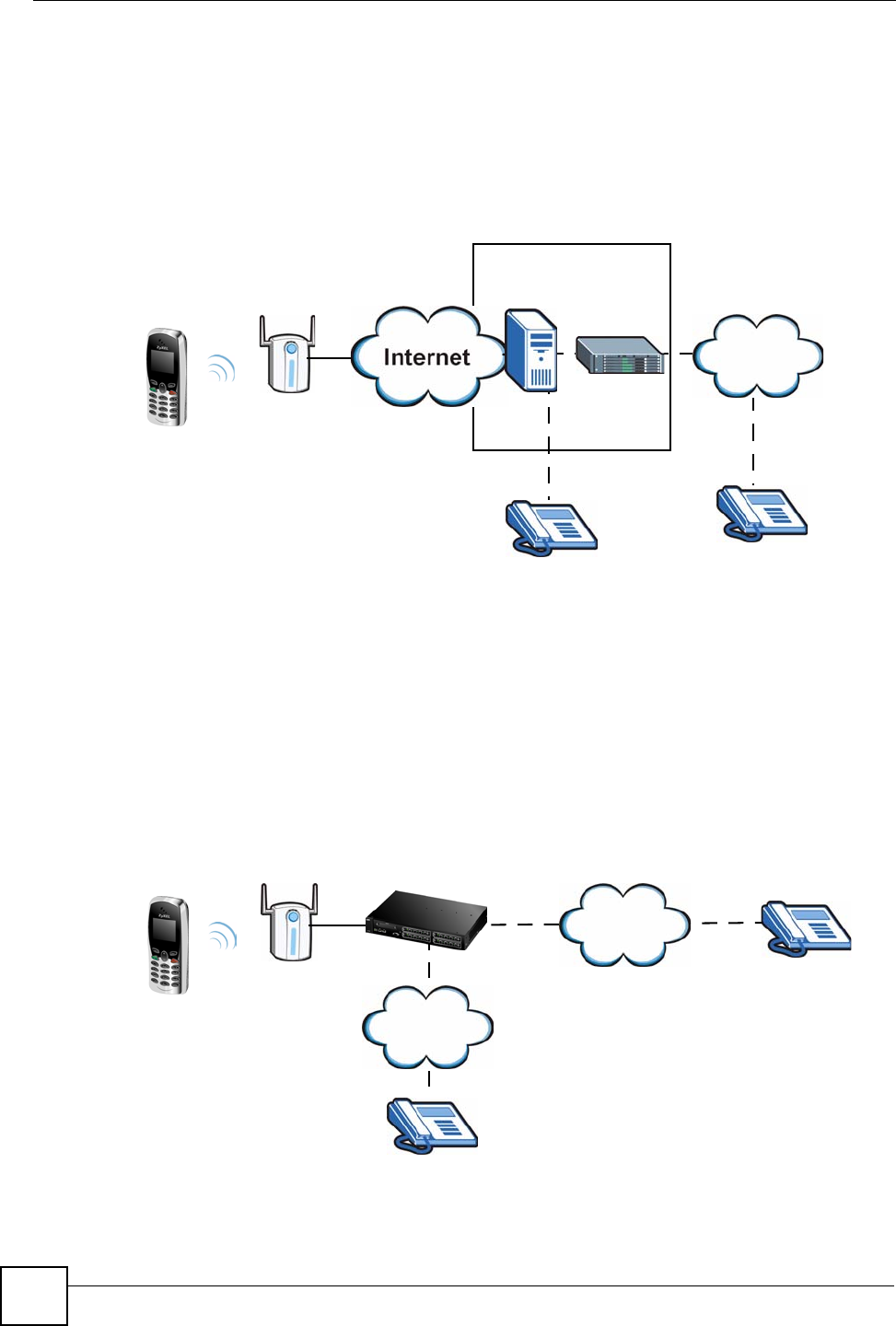
Chapter 1 Introducing the V630
V630 User’s Guide
30
The following figure shows a basic example of how you make a VoIP call through an ITSP. In
this example, you make a call from your V630, which sends the call through your Internet
connection to the ITSP’s SIP server (A). The VoIP call server forwards calls to IP phones (B)
through the Internet. The VoIP call server also forwards calls to PSTN (Public Switched
Telephone Network) phones through a trunking gateway (C) to phones on the PSTN network
(D).
Figure 1 Internet Telephony Service Provider Application
1.2.2 Make Calls via IP-PBX
If your company has an IP-PBX (Internet Protocol Private Branch Exchange), you can use the
V630 to make and receive VoIP telephone calls through it.
In this example, you make a call from your V630, which sends it to the IP-PBX. The IP-PBX
forwards calls to IP phones through an IP network (the IP phones could also be on the
company network or connected to the Internet). The IP-PBX also forwards calls to PSTN
phones.
Figure 2 IP-PBX Application
ITSP
PSTN
AC
B
D
IP-PBX
PSTN
IP Network
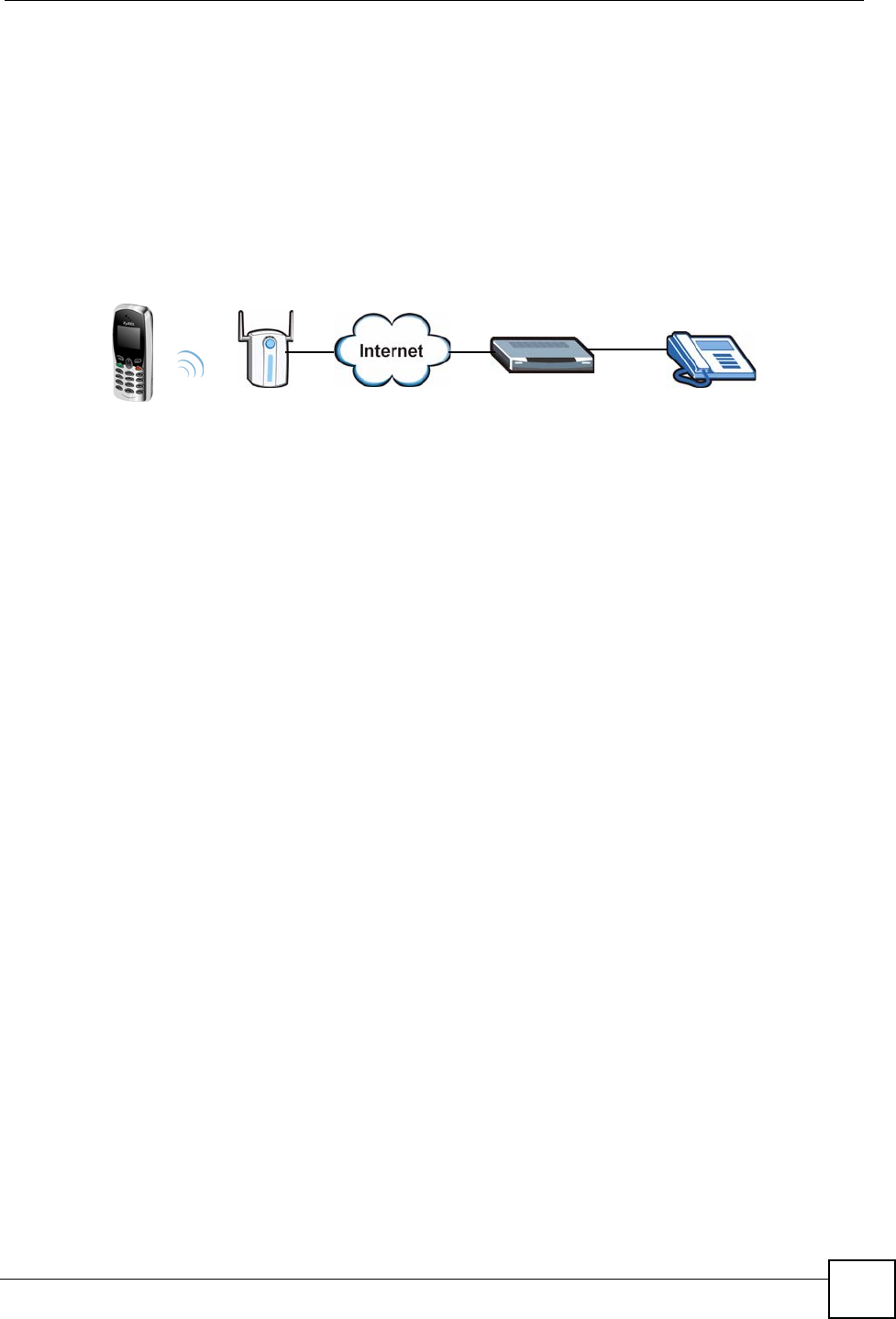
Chapter 1 Introducing the V630
V630 User’s Guide 31
1.2.3 Make Peer to Peer Calls
Use the V630 to make a call to the recipient’s IP address without using a SIP server. Peer-to-
peer calls are also called “P2P”, “Point to Point”, or “IP-to-IP” calls. You must know the
peer’s IP address in order to do this.
The following figure shows a basic example of how you would make a peer-to-peer VoIP call.
You make a call on your V630, which sends your call through your Internet connection to the
peer VoIP device.
Figure 3 Peer-to-peer Calling
1.3 Ways to Manage the V630
Use any of the following methods to manage the V630.
• Hardware keys. Use the control keys and LCD menus on the V630 for basic configuration.
Refer to the Quick Start Guide for descriptions of the hardware features and how to
perform basic phone functions.
• Web Configurator. Use this to upload firmware to the V630 using a (supported) web
browser.
1.4 Good Habits for Managing the V630
Do the following things regularly to make the V630 more secure and to manage the V630
more effectively.
• Change the web configurator password. Use a password that’s not easy to guess and that
consists of different types of characters, such as numbers and letters.
• Write down the password and put it in a safe place.
• Keep the V630 in a safe place. The LCD menus are not password-protected, so anyone
using the phone can access your phonebook, SIP account information, and so on.

Chapter 1 Introducing the V630
V630 User’s Guide
32

34

V630 User’s Guide 35
CHAPTER 2
Using the LCD Screen
This chapter shows how to use and configure the V630 via the LCD screen menu system.
"See the Quick Start Guide for a basic introduction to the LCD screen.
2.1 Entering the Menu System
From the V630’s main screen, press the Left key (Menu) to enter the menus. The Main Menu
screen displays as shown below.
Figure 4 Main Menu
See the following chapters for details on configuring each menu.
2.2 Navigation
Use the following keys to move around the V630’s LCD screen menu system.
•The Up and Down keys
Use this to move the cursor up and down (when selecting a menu item) or left and right
(when editing a field).
• An asterisk (*) next to a menu item identifies the currently configured option.
•The Left and Right keys
Look at the LCD screen. If there is a word or symbol above a softkey, press the key to
perform the function.
• The alphanumeric keypad
Enter a menu item’s number to jump to that item (single-digit numbers only).
-------Main Menu----
1 Call log
2 Profiles
3 Setup
4 Network
Select Back

Chapter 2 Using the LCD Screen
V630 User’s Guide
36
2.3 Entering Numbers, Letters and Symbols
When you enter information into the V630 (when setting up a phonebook entry, for example)
you may need to enter different kinds of characters. The alphanumeric keypad has these input
modes:
• Lowercase mode
• Uppercase mode
Use the # key to cycle between modes.
"Not all modes are available in all screens.
When you press a key to enter a character, wait a short time until the cursor moves on to the
next space. Press a key multiple times to access the different characters. For example, in
Uppercase mode press 9 four times to enter “Z”.
The following tables show the numbers, letters and symbols you can enter in each mode.
Table 2 Lowercase Mode Keypad Characters
Character Entered for Each Number of Key Presses
12 3 456 7 8910111213
KEY
1. , ‘ ?! - & #1_€
2ab c 2àá â ãäåç
3d e f 3 è é ê ë
4g h i 4 ì í î ï
5j k l 5 £
6mn o 6ñò ó ôõöø
7p q r s 7 ß $
8t u v 8 ù ú û ü
9wx y z 9 ý
** @
00,
+space
# [CYCLE MODE]

Chapter 2 Using the LCD Screen
V630 User’s Guide 37
2.4 LCD Menu Overview
This section shows the main LCD menus, and describes what you can do with each.
Table 3 Uppercase Mode Keypad Characters
Character Entered for Each Number of Key Presses
12 3 456 7 8910111213
KEY
1. , ‘ ?! - & #1_€
2AB C 2ÀÁ Â ÃÄÅÇ
3DE F 3 È É Ê Ë
4GH I 4 Ì Í Î Ï
5J K L 5 £
6MN O 6 ÑÒ Ó ÔÕÖØ
7P Q R S7 $
8T U V 8 ÙÚ Û Ü
9WX Y Z 9 ý
** @
00,
+space
# [CYCLE MODE]
Table 4 LCD Main Menus Overview
MENU DESCRIPTION
Call Log Missed Calls Use this menu to list the originating numbers of
unanswered calls.
Received Calls Use this menu to list the originating numbers of
answered calls.
Dialed Calls Use this menu to list the numbers the V630 has
called.
Delete all Use this menu to clear all the records in the call
log.

Chapter 2 Using the LCD Screen
V630 User’s Guide
38
Profiles Normal Activate Select this phone profile to use regular tone,
volume, and ring settings.
Personalize Use this menu to customize the normal profile’s
tone, volume, and ring settings.
Meeting Activate Select this phone profile for more discrete tone,
volume, and ring settings.
Personalize Use this menu to customize the meeting
profile’s tone, volume, and ring settings.
Outdoor Activate Select this phone profile for louder tone,
volume, and ring settings.
Personalize Use this menu to customize the outdoor profile’s
tone, volume, and ring settings.
Add to Profile Use this menu to create a new profile of tone,
volume, and ring settings.
Setup DateTime Set Time/Date Manually set the time and date.
Auto Clock Sync. Set whether or not the V630 gets the time from
an NTP time server. When you enable this,
specify the server’s address.
Set Time Zone Set the V630 to the local time zone.
Phone Setting Language Select the menu display language.
Phone lock Enable or disable the keypad locking function or
set the keypad lock to turn on automatically if
you do not use the V630 for a specific time.
Backlight Set how long the backlight stays on after you
stop pressing the V630’s keys. You can also set
it to be always on or off.
Quick Button Set the functions of the Up and Down keys in
the main screen.
Web Config Turn web configurator access on or off.
FW Upgrade Upgrade firmware from an HTTP server. Specify
the server’s IP address and port number.
Restore factory Reset the V630 to the factory default settings.
Call Setting Forward Use this to configure call forwarding.
Send Caller ID Set whether or not the V630 sends its phone
number to the callee.
Information TCP/IP Check the V630’s IP settings.
WLAN Check the V630’s wireless LAN settings.
SIP Check the V630’s VoIP settings.
HW Check the V630’s free storage space, firmware,
and MAC address.
Log Check V630’s system events log.
Table 4 LCD Main Menus Overview (continued)
MENU DESCRIPTION

Chapter 2 Using the LCD Screen
V630 User’s Guide 39
Network Site scan Looks for available Access Points (APs).
WLAN Profiles Profiles List Look through and edit already configured
profiles of WLAN settings.
Add to Profile Create a profile of WLAN settings.
WPS Connect to a WPS-enabled AP.
SIP Profiles Profiles List Look through and edit already configured
profiles of SIP settings.
Add to Profile Create a profile of SIP settings.
Ping test Manual Specify an IP address to which to send a ping.
Gateway Send a ping to the gateway IP address.
DNS Send a ping to the DNS server IP address.
SIP Server Send a ping to the SIP server.
SIP Proxy Send a ping to the SIP proxy server.
Outbound Proxy Send a ping to the SIP outbound proxy server.
Stun Server Send a ping to the STUN server.
Re-connect Have the V630 attempt to connect to the WLAN.
Table 4 LCD Main Menus Overview (continued)
MENU DESCRIPTION

Chapter 2 Using the LCD Screen
V630 User’s Guide
40
This section describes the phonebook LCD menus which you access by pressing the Right key
from the main screen.
Table 5 LCD Phonebook Menus Overview
MENU DESCRIPTION
Phonebook Talk Call the selected contact.
Detail Display the information configured for the
selected contact.
Edit Use this to modify the information configured for
the selected contact.
Delete Remove the selected contact.
Add Create a new contact entry.
Group None Select this to not add the contact to any group.
Business Add members to this group and specify the ring
tone for incoming calls coming from them.
Family Add members to this group and specify the ring
tone for incoming calls coming from them.
Friends Add members to this group and specify the ring
tone for incoming calls coming from them.
VIP Add members to this group and specify the ring
tone for incoming calls coming from them.
Other Add members to this group and specify the ring
tone for incoming calls coming from them.
Speed Dial Set up one-touch calling for phone numbers you
call often.
Delete All Remove all phone book entries.
Memory Status This shows how many more phone book entries
the V630 can store.

V630 User’s Guide 41
CHAPTER 3
Call Log LCD Menus
This chapter discusses the V630’s Call Log LCD menus.
3.1 Call Log
The Call Log menu allows you to quickly check the numbers of the most recent missed,
received, or dialed calls. Press Menu > Call Log to display the following screen.
Figure 5 Menu > Call log
The following table describes the labels in this screen.
3.2 Received Calls
The Received Calls menu allows you to quickly check the numbers of the most recent
received calls. Press Menu > Call Log > Received Calls to display the following screen. The
missed calls and dialed calls lists work in the same manner.
Table 6 Menu > Call log
LABEL DESCRIPTION
Missed Calls Use this menu to list the originating numbers of unanswered calls.
Received Calls Use this menu to list the originating numbers of answered calls.
Dialed Calls Use this menu to list the numbers the V630 has called.
Delete all Use this menu to clear all the records in the call log.
Select Press this to choose the highlighted field in the menu.
Back Press this to return to the previous screen.
-------Call log----
1 Missed Calls
2 Received Calls
3 Dialed Calls
4 Delete all
Select Back

Chapter 3 Call Log LCD Menus
V630 User’s Guide
42
Figure 6 Menu > Call log > Received Calls
The following table describes the labels in this screen.
Table 7 Menu > Call log > Received Calls
LABEL DESCRIPTION
Received Calls Select an entry to see the time and date of the call.
Select Press this to choose the highlighted field in the menu.
Back Press this to return to the previous screen.
---Received calls---
1 Tom
2 Bill
3 Jim
Select Back
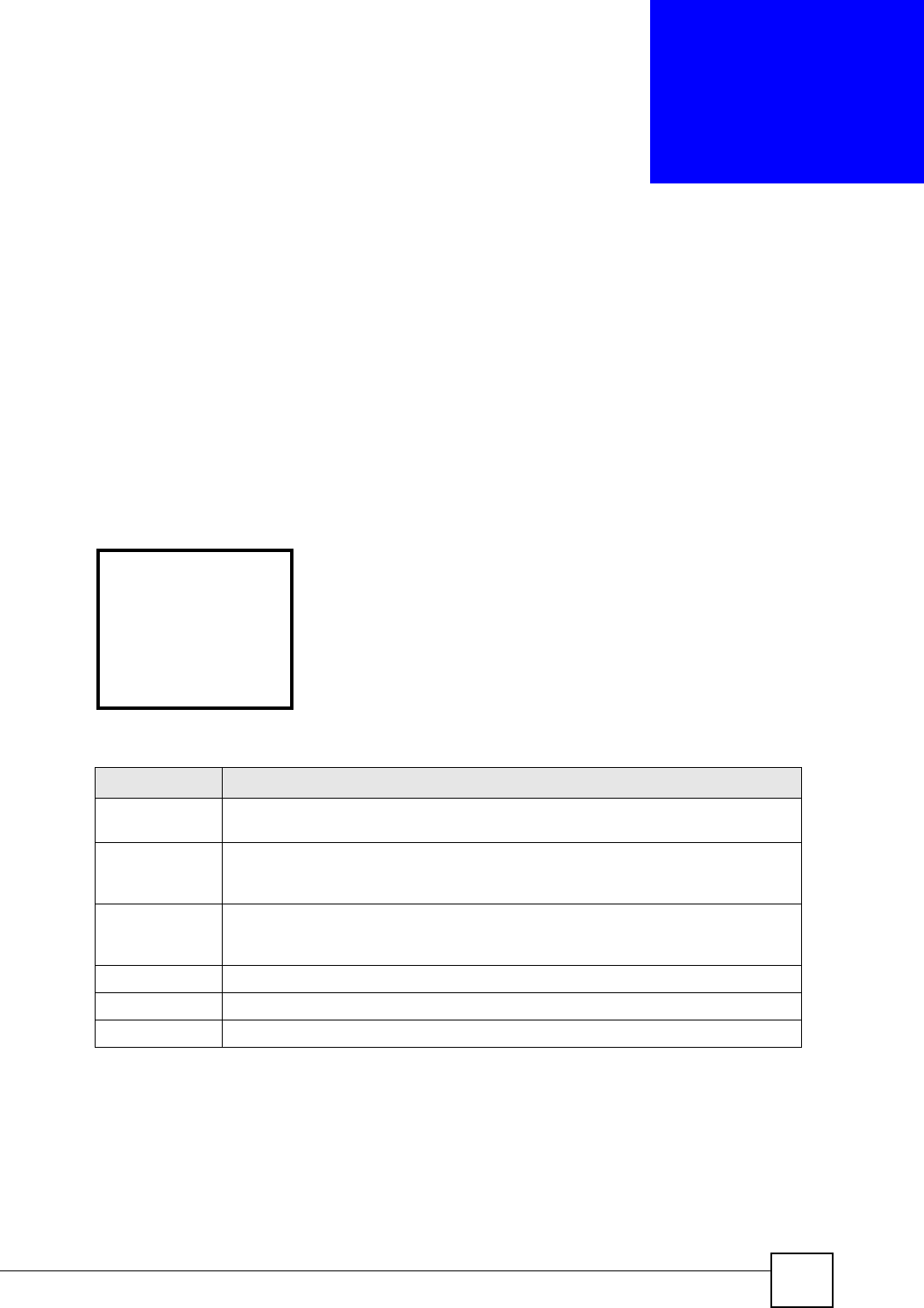
V630 User’s Guide 43
CHAPTER 4
Profiles LCD Menus
This chapter discusses the V630’s Profiles LCD menus.
4.1 Profiles Setup
Use the Profiles menu to select or modify a profile of tone, volume, and ring settings. Press
Menu > Profiles to display the following screen.
Figure 7 Menu > Profiles
The following table describes the labels in this screen.
4.2 Phone Profile Options
Press Menu > Profiles to display the profiles. Select a profile to open the following menu. A
user-added profile named TEST is shown in this example). You can turn on the profile or
configure its settings. You can also rename or delete a user-added profile.
Table 8 Menu > Profiles
LABEL DESCRIPTION
Normal Use this menu to turn on the normal profile and/or configure the normal profile’s
tone, volume, and ring settings.
Meeting The meeting profile provides more discrete tone, volume, and ring settings. Use this
menu to turn on the meeting profile and/or configure the meeting profile’s tone,
volume, and ring settings.
Outdoor The outdoors profile has louder tone, volume, and ring settings. Use this menu to
turn on the outdoors profile and/or configure the outdoors profile’s tone, volume, and
ring settings.
Add to Profile Use this menu to create a new profile of tone, volume, and ring settings.
Select Press this to choose the highlighted field in the menu.
Back Press this to return to the previous screen.
---Profiles Setup---
1 *Normal
2 Meeting
3 Outdoor
4 Add to Profile
Select Back

Chapter 4 Profiles LCD Menus
V630 User’s Guide
44
Figure 8 Menu > Profiles > Profile
The following table describes the labels in this screen.
4.3 Phone Profile Personalization
Press Menu > Profiles to display the profiles. Select a profile (Meeting in this example) and
then select Personalize to open the following menu. Select whether you want to edit the
profile’s tone, volume, or ring settings.
Figure 9 Menu > Profiles > Profile > Personalize
The following table describes the labels in this screen.
Table 9 Menu > Profiles > Profile
LABEL DESCRIPTION
Activate Select this to have the V630 use the profile’s tone, volume, and ring settings.
Note: There is also a quick button shortcut. Hold down the * key to
switch between the current profile and the meeting profile.
Personalize Select this to configure the profile’s tone, volume, and ring settings.
Rename Select this to change the name of the profile. This option only appears for profiles
that you add. It does not appear with the default profiles.
Delete Select this to remove the profile. This option only appears for profiles that you add.
It does not appear with the default profiles.
Select Press this to choose the highlighted field in the menu.
Back Press this to return to the previous screen.
--------TEST-------
1 Activate
2 Personalize
3 Rename
4 Delete
Select Back
Table 10 Menu > Profiles > Profile > Personalize
LABEL DESCRIPTION
Tone setting Select this to configure the profile’s ring and/or key tone settings.
Volume Select this to configure the profile’s ring, receiver, speaker, and/or key tone volume
settings.
Ring mode Select this to set the profile to have the V630 ring, vibrate, ring and vibrate, or
vibrate and then ring for incoming calls.
-------Meeting------
1 Tone setting
2 Volume
3 Ring mode
Select Back

Chapter 4 Profiles LCD Menus
V630 User’s Guide 45
4.4 Tone Personalization
Press Menu > Profiles to display the profiles. Select a profile (Meeting in this example) and
then select Personalize > Tone setting to open the following menu. Select whether you want
to edit the profile’s ring tone or key tone settings.
Figure 10 Menu > Profiles > Profile > Personalize > Tone Setting
The following table describes the labels in this screen.
4.5 Ring Tone Personalization
Press Menu > Profiles to display the profiles. Select a profile (Meeting in this example) and
then select Personalize > Tone setting > Ring tones to open the following menu. Use this to
select the profile’s ring tone.
Figure 11 Menu > Profiles > Profile > Personalize > Tone Setting > Ring tones
Select Press this to choose the highlighted field in the menu.
Back Press this to return to the previous screen.
Table 10 Menu > Profiles > Profile > Personalize
LABEL DESCRIPTION
Table 11 Menu > Profiles > Profile > Personalize > Tone Setting
LABEL DESCRIPTION
Ring tones Select this to chose the ring tone for incoming calls.
Key tone Select this to turn the key tone (sounds when you press the keys) on or off.
Select Press this to choose the highlighted field in the menu.
Back Press this to return to the previous screen.
-------Meeting------
1 Ring tones
2 Key tone
Select Back
----Select Melody---
1 Allegro
2 Bach
3 Beethoven 5th
4 Birthday
Select Back

Chapter 4 Profiles LCD Menus
V630 User’s Guide
46
The following table describes the labels in this screen.
4.6 Volume Personalization
Press Menu > Profiles to display the profiles. Select a profile (Meeting in this example) and
then select Personalize > Volume to open the following menu. You can modify the profile’s
ring, receiver, speaker, and/or key tone volume settings.
Figure 12 Menu > Profiles > Profile > Personalize > Volume
The following table describes the labels in this screen.
4.7 Ring Volume Personalization
Press Menu > Profiles to display the profiles. Select a profile (Meeting in this example) and
then select Personalize > Volume. When you select an option in the Volume menu, a screen
similar to the following displays. This example uses the Ring Vol. screen.
Table 12 Menu > Profiles > Profile > Personalize > Tone Setting > Ring tones
LABEL DESCRIPTION
Select Melody Select the ring tone for incoming calls. Leave the cursor on a ring tone for a
preview of the tone. The V630’s current phone profile must be set to use an
audible ring for incoming calls in order for you to here the preview.
Select Press this to choose the highlighted field in the menu.
Back Press this to return to the previous screen.
Table 13 Menu > Profiles > Profile > Personalize > Volume
LABEL DESCRIPTION
Ring Vol. Select this to set how loud the ring tone for incoming calls is.
Receiver Vol. Select this to set how loud your voice sounds to the person you are talking to.
Speaker Vol. Select this to set the volume of the V630’s speaker (how loud the voice of the
person you are talking to sounds).
Key tone Vol. Select this to set the key tone volume (how load the sounds are when you press the
keys).
Select Press this to choose the highlighted field in the menu.
Back Press this to return to the previous screen.
-------Volume------
1 Ring Vol.
2 Receiver Vol.
3 Speaker Vol.
4 Key tone Vol.
Select Back

Chapter 4 Profiles LCD Menus
V630 User’s Guide 47
Figure 13 Menu > Profiles > Profile > Personalize > Volume > Ring Vol.
The following table describes the labels in this screen.
4.8 Ring Mode Personalization
Press Menu > Profiles to display the profiles. Select a profile (Meeting in this example) and
then select Personalize > Ring Mode to open the following menu. You can set the profile to
have the V630 ring, vibrate, ring and vibrate, or vibrate and then ring for incoming calls.
Figure 14 Menu > Profiles > Profile > Personalize > Ring Mode
The following table describes the labels in this screen.
Table 14 Menu > Profiles > Profile > Personalize > Volume > Ring Vol.
LABEL DESCRIPTION
Ring Vol. The bar in the screen displays the volume setting. Use the numbers on the keypad
to set the volume higher or lower.
Back Press this to return to the previous screen.
------Ring Vol.-----
Select Back
Table 15 Menu > Profiles > Profile > Personalize > Ring Mode
LABEL DESCRIPTION
Ring only Select this to have the phone only ring for incoming calls (not vibrate).
Vibrate Select this to have the phone only vibrate for incoming calls (not ring).
Ring and Vib. Select this to have the phone ring and vibrate for incoming calls.
Vib, then Ring Select this to have the phone vibrate first for an incoming call and then ring if you
haven’t answered it yet.
Select Press this to choose the highlighted field in the menu.
Back Press this to return to the previous screen.
------Ring Mode-----
1 Ring only
2 Vibrate
3 Ring and Vib.
4 Vib, then R..
Select Back

Chapter 4 Profiles LCD Menus
V630 User’s Guide
48
4.9 Adding a Phone Profile
Press Menu > Profiles to display the profiles. Select Add to Profile to open the following
menu. Use this menu to configure the name of the new profile. Then you can use the menus to
configure the profile in the same way that you configure an existing profile.
Figure 15 Menu > Profiles > Add to Profile
The following table describes the labels in this screen.
Table 16 Menu > Profiles > Add to Profile
LABEL DESCRIPTION
Input the name of the profile. When you press a key, other character options appear
above the input field. Press a key multiple times to input one of the characters
above.
Done Press this to save your setting.
ABC Press # to switch between the lower-case and upper-case input modes.
Back Press this to return to the previous screen.
Clear After you start inputting text, Back changes to Clear. Press this to backspace.
----Add to Profile--
Done ABC Back
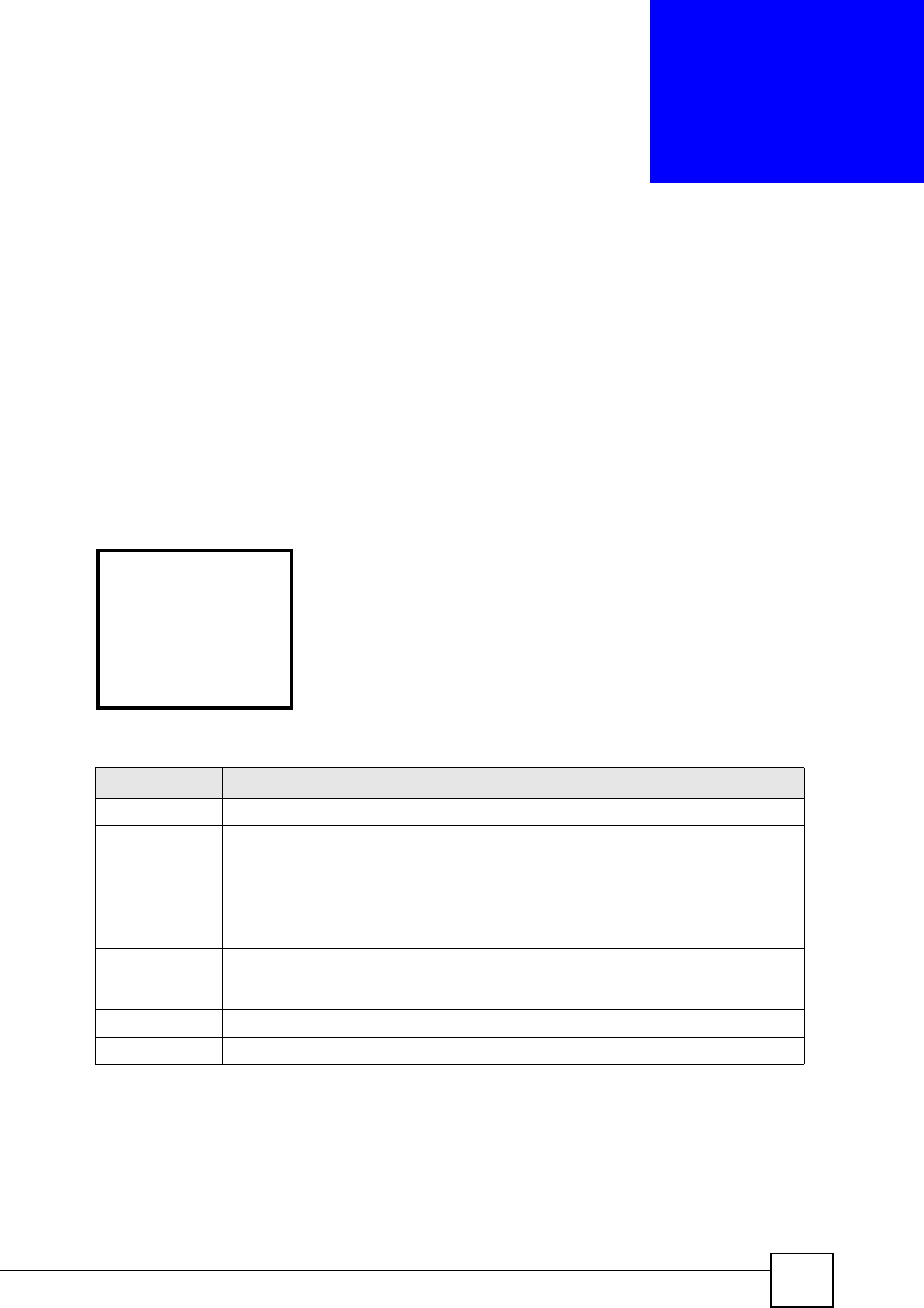
V630 User’s Guide 49
CHAPTER 5
General Setup LCD Menus
This chapter discusses the V630’s Setup LCD menus.
5.1 General Setup
Use the Setup menu to configure the V630’s general settings and display various types of
status information. Press Menu > Setup to display the following screen.
Figure 16 Menu > Setup
The following table describes the labels in this screen.
5.2 Date and Time Setup
Press Menu > Setup > DateTime to display the following screen. Use this menu to select
what time and date settings you want to configure.
Table 17 Menu > Setup
LABEL DESCRIPTION
DateTime Select this to configure the V630’s time and date settings.
Phone Setting Select this to configure the V630’s general phone settings such as the display
language, keypad lock, backlight, quick access buttons, and web configurator
access. You can also upgrade the V630’s firmware or reset the V630 to the factory
default settings.
Call Setting Select this to configure call forwarding and whether or not the V630 sends its phone
number to the callee.
Information Select this to check the V630’s IP, wireless LAN, and VoIP settings. You can also
display the V630’s free storage space, firmware, MAC address, and system events
log.
Select Press this to choose the highlighted field in the menu.
Back Press this to return to the previous screen.
-------Setup-------
1 DateTime
2 Phone Setting
3 Call Setting
4 Information
Select Back

Chapter 5 General Setup LCD Menus
V630 User’s Guide
50
Figure 17 Menu > Setup > DateTime
The following table describes the labels in this screen.
5.3 Manual Date or Time Setup
Press Menu > Setup > DateTime > Set Time/Date to display the following screen. Use this
menu to select whether to want to manually set the time or the date.
Figure 18 Menu > Setup > DateTime > Set Time/Date
The following table describes the labels in this screen.
Table 18 Menu > Setup > DateTime
LABEL DESCRIPTION
Set Time/Date Select this to manually set the time and date.
Auto Clock
Sync. Select this to set whether or not the V630 gets the time from an NTP time server.
When you enable this, specify the server’s address.
Set Time Zone Select this to set the V630 to the local time zone.
Select Press this to choose the highlighted field in the menu.
Back Press this to return to the previous screen.
----Set Time/Date---
1 Set Time/Date
2 Auto Clock Syn
3 Set Time Zone
Select Back
Table 19 Menu > Setup > DateTime > Set Time/Date
LABEL DESCRIPTION
Time Select this to manually set the time.
Date Select this to manually set the date.
Select Press this to choose the highlighted field in the menu.
Back Press this to return to the previous screen.
----Set Time/Date---
1 Time
2 Date
Select Back

Chapter 5 General Setup LCD Menus
V630 User’s Guide 51
5.4 Manual Time Setup
Press Menu > Setup > DateTime > Set Time/Date > Time to display the following screen.
Use this menu to select whether to manually set the time.
Figure 19 Menu > Setup > DateTime > Set Time/Date > Time
The following table describes the labels in this screen.
5.5 Manual Date Setup
Press Menu > Setup > DateTime > Set Time/Date > Date to display the following screen.
Use this menu to select whether to manually set the date.
Figure 20 Menu > Setup > DateTime > Set Time/Date > Date
The following table describes the labels in this screen.
Table 20 Menu > Setup > DateTime > Set Time/Date > Time
LABEL DESCRIPTION
24 hour time Use the numbers on the keypad to set the hour (in 24-hour format) and then the
minute. Use the Up and Down keys if you need to move the cursor.
Set Press this to enter your setting.
Back Press this to return to the previous screen.
---------Time-------
24 hour time
0:30
Set Back
Table 21 Menu > Setup > DateTime > Set Time/Date > Date
LABEL DESCRIPTION
Month/Day/Year Use the numbers on the keypad to set the month, day, and year. Use the Up and
Down keys if you need to move the cursor.
Set Press this to enter your setting.
Back Press this to return to the previous screen.
---------Date-------
Month/Day/Year
1/1/2000
Set Back
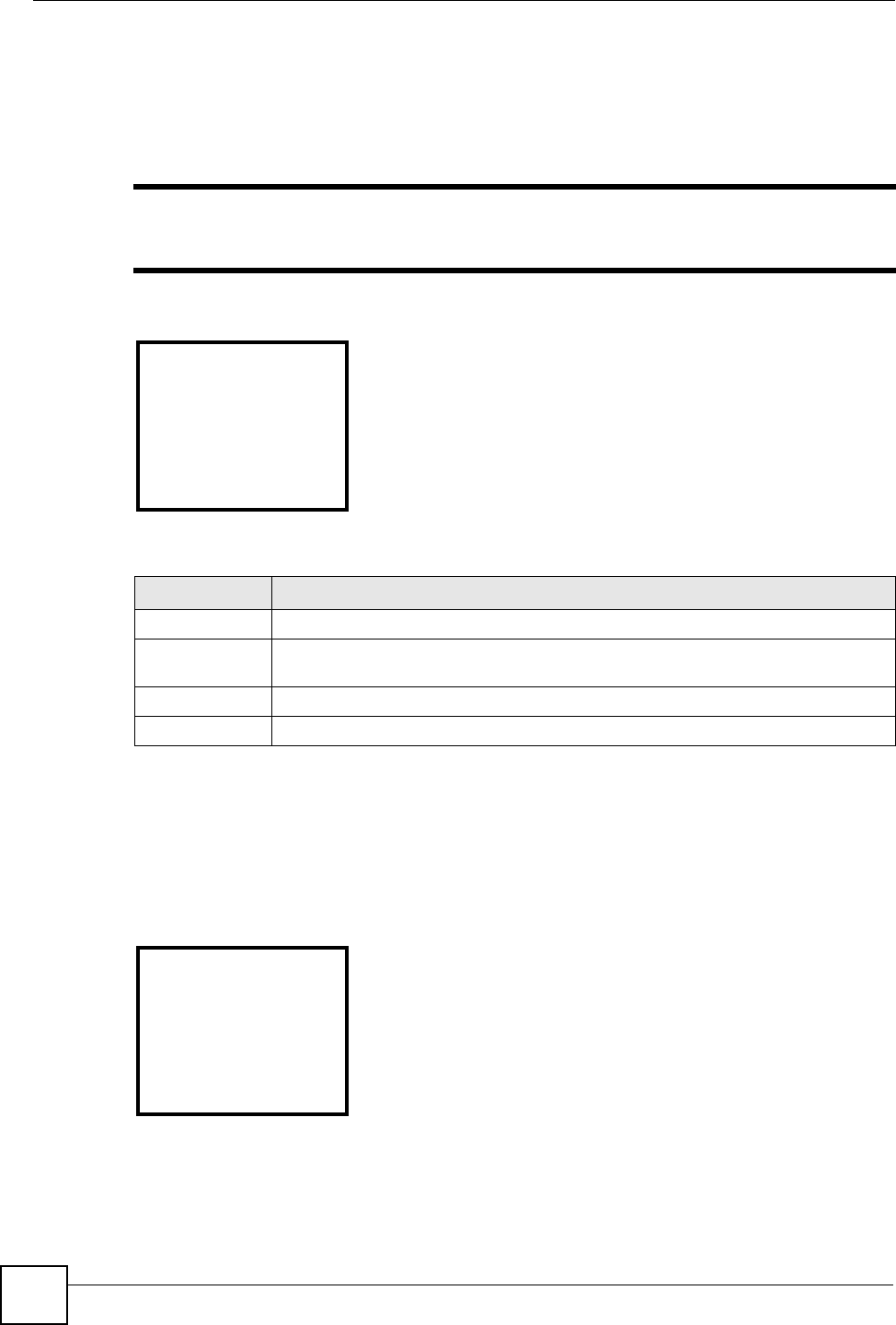
Chapter 5 General Setup LCD Menus
V630 User’s Guide
52
5.6 Using a Time Server
Press Menu > Setup > DateTime > Auto Clock Syn to display the following screen. Use this
menu to set whether or not the V630 uses a time server.
"The V630 has to be able to connect to the Internet to actually get the time and
date from a time server.
Figure 21 Menu > Setup > DateTime > Auto Clock Syn
The following table describes the labels in this screen.
5.7 Specifying a Time Server
Press Menu > Setup > DateTime > Auto Clock Syn > Enable to display the following
screen. Use this menu to specify a time server for the V630 to use.
Figure 22 Menu > Setup > DateTime > Auto Clock Syn > Enable
Table 22 Menu > Setup > DateTime > Auto Clock Syn
LABEL DESCRIPTION
Enable Select this to have the V630 attempt to get the time from an NTP time server.
Date Select this to stop the V630 from attempting to get the time from an NTP time
server.
Select Press this to choose the highlighted field in the menu.
Back Press this to return to the previous screen.
---Auto clock set---
1 Enable
2 Disable
Select Back
-----NTP Server-----
Done ABC Back

Chapter 5 General Setup LCD Menus
V630 User’s Guide 53
The following table describes the labels in this screen.
5.8 Time Zone Setup
Press Menu > Setup > DateTime > Set Time Zone to display the following screen. Use this
menu to set the V630 to use the local time zone.
Figure 23 Menu > Setup > DateTime > Time Zone
The following table describes the labels in this screen.
5.9 General Phone Setup
Press Menu > Setup > Phone Setting to display the following screen. Use this menu to select
which of the V630’s general phone settings to configure. You can set the display language,
keypad lock, backlight, quick access buttons, and web configurator access. You can also
upgrade the V630’s firmware or reset the V630 to the factory default settings.
Table 23 Menu > Setup > DateTime > Auto Clock Syn > Enable
LABEL DESCRIPTION
NTP Server Input the IP address or URL of the NTP time server. When you press a key, other
character options appear above the input field. Press a key multiple times to input
one of the characters above.
Done Press this to save your setting.
ABC Press # to switch between the lower-case and upper-case input modes.
Back Press this to return to the previous screen.
Clear After you start inputting text, Back changes to Clear. Press this to backspace.
Table 24 Menu > Setup > DateTime > Time Zone
LABEL DESCRIPTION
Time Zone Use the Up or Down to your local time zone.
GMT0 This shows how many hours the time zone is ahead of or behind GMT (Greenwich
Mean Time).
Select Press this to choose the highlighted field in the menu.
Back Press this to return to the previous screen.
-------TimeZone-----
Greenwich
Mean Time:
London
GMT0
Select Back

Chapter 5 General Setup LCD Menus
V630 User’s Guide
54
Figure 24 Menu > Setup > Phone Setting
The following table describes the labels in this screen.
5.10 Language Setup
Press Menu > Setup > Phone Setting > Language to display the following screen. Use this
menu to select the V630’s display language.1
Figure 25 Menu > Setup > Phone Setting > Language
The following table describes the labels in this screen.
Table 25 Menu > Setup > Phone Setting
LABEL DESCRIPTION
Language Select the menu display language.
Phone lock Enable or disable the automatic keypad locking function or set the keypad lock to
turn on automatically if you do not use the V630 for a specific time.
Backlight Set how long the backlight stays on after you stop pressing the V630’s keys. You
can also set it to be always on or off.
Quick Button Set the functions of the Up and Down keys in the main screen.
Web Config Turn web configurator access on or off.
FW Upgrade Upgrade firmware from an HTTP server. Specify the server’s IP address and port
number.
Restore factory Reset the V630 to the factory default settings.
Select Press this to choose the highlighted field in the menu.
Back Press this to return to the previous screen.
----Phone Setting---
1 Language
2 Phone Lock
3 Backlight
4 Quick Button
Select Back
1. Only English is supported at the time of writing.
Table 26 Menu > Setup > Phone Setting > Language
LABEL DESCRIPTION
Language Select the menu display language.
-------Language-----
1 English
Select Back

Chapter 5 General Setup LCD Menus
V630 User’s Guide 55
5.11 Keypad Lock Setup
Press Menu > Setup > Phone Setting > Phone lock to display the following screen. The
V630’s keypad lock helps prevent accidental calls. Use this menu to set the V630’s automatic
keypad lock.
"Regardless of the setting in this menu, you can still press the Left key and *
from the main screen to lock or unlock the V630’s keypad.
Figure 26 Menu > Setup > Phone Setting > Phone lock
The following table describes the labels in this screen.
5.12 Backlight Setup
Press Menu > Setup > Phone Setting > Backlight to display the following screen. Use this
menu to set how long the V630’s backlight stays on.
Select Press this to choose the highlighted field in the menu.
Back Press this to return to the previous screen.
Table 26 Menu > Setup > Phone Setting > Language
LABEL DESCRIPTION
Table 27 Menu > Setup > Phone Setting > Phone lock
LABEL DESCRIPTION
Phone lock Select OFF to turn off the automatic keypad lock function (to always leave the
keypad unlocked).
Or select the number of idle seconds after which the V630 automatically locks the
keypad. For example, select 30s to have the V630 lock the keypad after you stop
using the V630 for longer than 30 seconds.
Select Press this to choose the highlighted field in the menu.
Back Press this to return to the previous screen.
------Phone lock----
1 *OFF
2 15s
3 30s
4 60s
Select Back

Chapter 5 General Setup LCD Menus
V630 User’s Guide
56
Figure 27 Menu > Setup > Phone Setting > Backlight
The following table describes the labels in this screen.
5.13 Quick Button Setup
Press Menu > Setup > Phone Setting > Quick button to display the following screen. Use
this menu to select which quick access button you want to configure.
Figure 28 Menu > Setup > Phone Setting > Quick button
The following table describes the labels in this screen.
Table 28 Menu > Setup > Phone Setting > Backlight
LABEL DESCRIPTION
Phone lock Select OFF to turn off the backlight all the time.
Or select the number of idle seconds after which the V630 automatically turns off the
backlight. For example, select 10s to have the V630 turn off the backlight 10
seconds after you stop pressing the keys.
Select Press this to choose the highlighted field in the menu.
Back Press this to return to the previous screen.
------Backlight----
1 OFF
2 4s
3 7s
4 *10s
Select Back
Table 29 Menu > Setup > Phone Setting > Quick button
LABEL DESCRIPTION
Up Button Select this to configure the function of the Up key in the main screen.
Down Button Select this to configure the function of the Down key in the main screen.
Select Press this to choose the highlighted field in the menu.
Back Press this to return to the previous screen.
-----Quick button---
1 Up Button
2 Down Button
Select Back

Chapter 5 General Setup LCD Menus
V630 User’s Guide 57
5.14 Up Quick Button Setup
Press Menu > Setup > Phone Setting > Quick button > Up Button to display the following
screen. Use this menu to configure the function of the Up key in the main screen. The
configuration for the Down key works in the same manner.
Figure 29 Menu > Setup > Phone Setting > Quick button > Up Button
The following table describes the labels in this screen.
5.15 Enabling or Disabling the Web Configurator
Press Menu > Setup > Phone Setting > Web Config to display the following screen. Use this
menu to turn web configurator access on or off.
Figure 30 Menu > Setup > Phone Setting > Web Config
Table 30 Menu > Setup > Phone Setting > Quick button > Up Button
LABEL DESCRIPTION
Information
Speaker Volume Select this to open the talking volume setting when you press the Up key in the main
screen.
Receiver
Volume Select this to open the listening volume setting when you press the Up key in the
main screen.
Profiles Select this to be able to select or configure phone profiles when you press the Up
key in the main screen.
Select Press this to choose the highlighted field in the menu.
Back Press this to return to the previous screen.
-----Quick button---
1 Information
2 Speaker Volume
3 Receiver Vol..
4 Profiles
Select Back
------Web Config----
1 *OFF
2 On
Select Back

Chapter 5 General Setup LCD Menus
V630 User’s Guide
58
The following table describes the labels in this screen.
5.16 Firmware Upgrade from an HTTP Server
Press Menu > Setup > Phone Setting > FW Upgrade to display the following screen. Use
this menu to select whether you want to upgrade firmware from an HTTP server, specify the
server’s address, or specify the server’s port number.
"Your network administrator or service provider must have an HTTP server set
up with the firmware file in order for you to use this.
Figure 31 Menu > Setup > Phone Setting > FW Upgrade
The following table describes the labels in this screen.
Table 31 Menu > Setup > Phone Setting > Web Config
LABEL DESCRIPTION
OFF Select this to not allow access to the web configurator.
ON Select this to allow access to the web configurator.
Note: Allowing access to the web configurator reduces
battery life.
Select Press this to choose the highlighted field in the menu.
Back Press this to return to the previous screen.
Table 32 Menu > Setup > Phone Setting > FW Upgrade
LABEL DESCRIPTION
Upgrade Now Select this to upload new firmware from the HTTP server. You need to have the
server’s address and port number configured already to be able to use this.
Server Address Select this to go to a menu where you can enter the address of the HTTP server.
Server Port Select this to go to a menu where you can enter the port number of the HTTP
server. You need to do this if the HTTP server with the firmware is not using the
standard port number (80).
Select Press this to choose the highlighted field in the menu.
Back Press this to return to the previous screen.
------FW Upgrade----
1 Upgrade Now
2 Server Address
3 Server Port
Select Back

Chapter 5 General Setup LCD Menus
V630 User’s Guide 59
5.17 HTTP Firmware Upgrade Server Address
Press Menu > Setup > Phone Setting > FW Upgrade > Server Address to display the
following screen. Use this menu to specify the server’s address. The port configuration menu
works in a similar manner, except you can only input numbers.
Figure 32 Menu > Setup > Phone Setting > FW Upgrade > Server Address
The following table describes the labels in this screen.
5.18 Restore Factory Default Settings
Press Menu > Setup > Phone Setting > Restore Factory to display the following screen. Use
this menu to reset the V630 to the factory default settings.
"Restoring the factory default settings resets all of the phone’s settings except
your phone book entries.
Figure 33 Menu > Setup > Phone Setting > Restore Factory
Table 33 Menu > Setup > Phone Setting > FW Upgrade > Server Address
LABEL DESCRIPTION
Server Address Input the IP address or URL of the HTTP server with the firmware file. When you
press a key, other character options appear above the input field. Press a key
multiple times to input one of the characters above.
Done Press this to save your setting.
ABC Press # to switch between the lower-case and upper-case input modes.
Back Press this to return to the previous screen.
Clear After you start inputting text, Back changes to Clear. Press this to backspace.
---Server Address---
Done ABC Back
---Restore Factory--
Are you sure,
reset to
default?
Yes Cancel

Chapter 5 General Setup LCD Menus
V630 User’s Guide
60
The following table describes the labels in this screen.
5.19 Call Settings
Press Menu > Setup > Call Setting to display the following screen. Use this menu to go to
menus where you can configure call forwarding or whether or not the V630 sends its phone
number to the callee.
Figure 34 Menu > Setup > Call Setting
The following table describes the labels in this screen.
5.20 Call Forwarding
Press Menu > Setup > Call Setting > Forward to display the following screen. Use this
menu to turn call forwarding on or off.
Figure 35 Menu > Setup > Call Setting > Forward
Table 34 Menu > Setup > Phone Setting > Restore Factory
LABEL DESCRIPTION
Yes Select this to reset the V630 to the factory default settings.
Cancel Select this to return to the previous screen without resetting the V630 to the factory
default settings.
Table 35 Menu > Setup > Call Setting
LABEL DESCRIPTION
Forward Use this to configure call forwarding.
Send Caller ID Set whether or not the V630 sends its phone number to the callee.
Select Press this to choose the highlighted field in the menu.
Back Press this to return to the previous screen.
-----Call Setting---
1 Forward
2 Send Caller ID
Select Back
--------Forward-----
1 *OFF
2 ON
Select Back

Chapter 5 General Setup LCD Menus
V630 User’s Guide 61
The following table describes the labels in this screen.
5.21 Call Forwarding Number
Press Menu > Setup > Call Setting > Forward > ON to display the following screen. Use
this menu to input the phone number to which you want to forward calls.
Figure 36 Menu > Setup > Call Setting > Forward > ON
The following table describes the labels in this screen.
5.22 Call Forwarding Type
Press Menu > Setup > Call Setting > Forward > ON and input a phone number to display
the following screen. Use this menu to set under what circumstances you want to apply call
forwarding.
Table 36 Menu > Setup > Call Setting > Forward
LABEL DESCRIPTION
OFF Select this to not forward calls.
ON Select this to forward calls.
Select Press this to choose the highlighted field in the menu.
Back Press this to return to the previous screen.
Table 37 Menu > Setup > Call Setting > Forward > ON
LABEL DESCRIPTION
Forward
Number Use the number keys to input the phone number to which you want to forward calls.
Done Press this to save your setting.
Back Press this to return to the previous screen.
Clear After you start inputting text, Back changes to Clear. Press this to backspace.
----Forward Number--
Done Back

Chapter 5 General Setup LCD Menus
V630 User’s Guide
62
Figure 37 Menu > Setup > Call Setting > Forward > ON > Number
The following table describes the labels in this screen.
5.23 Call Forwarding No Answer Time
When you set the call forwarding type to No Answer or Busy & No Answer, use this menu to
specify how long the V630 waits before forwarding an unanswered call.
Figure 38 Menu > Setup > Call Setting > Forward > ON > Number > Type > No Answer
The following table describes the labels in this screen.
Table 38 Menu > Setup > Call Setting > Forward > ON > Number
LABEL DESCRIPTION
Always Select this to forward all calls to the specified number (regardless of whether or not
your line is busy).
Busy Select this to forward calls when your line is busy.
No Answer Select this to forward calls when you do not answer the phone. You will be able to
specify how long the V630 waits before forwarding an unanswered call.
Busy & No
Answer Select this to forward calls when your line is busy or you do not answer the phone.
You will be able to specify how long the V630 waits before forwarding an
unanswered call.
Select Press this to choose the highlighted field in the menu.
Back Press this to return to the previous screen.
-----Forward Type---
1 *Always
2 Busy
3 No Answer
4 Busy & No An..
Select Back
Table 39 Menu > Setup > Call Setting > Forward > ON > Number > Type > No Answer
LABEL DESCRIPTION
NoAnswer Time Specify how long the V630 waits before forwarding an unanswered call. You can
use one of the pre-defined settings (5, 10, 15 or 20 seconds) or select Other to
manually configure another time period.
Busy Select this to forward calls when your line is busy.
Select Press this to choose the highlighted field in the menu.
Back Press this to return to the previous screen.
----NoAnswer Time---
1 5s
2 10s
3 15s
4 20s
Select Back

Chapter 5 General Setup LCD Menus
V630 User’s Guide 63
5.24 Call Forwarding No Answer Time
When you set the call forwarding type to No Answer or Busy & No Answer and select Other
as the no answer time, use this menu to specify a custom time period for how long the V630
waits before forwarding an unanswered call.
Figure 39 Menu > Setup > Call Setting > Forward > ON > Number > Type > No Answer >
Other
The following table describes the labels in this screen.
5.25 Send Caller ID
Press Menu > Setup > Call Setting > Send Caller ID to display the following screen. Use
this menu to set whether or not the V630 sends your phone number to the phones you call.
Figure 40 Menu > Setup > Call Setting > Send Caller ID
The following table describes the labels in this screen.
Table 40 Menu > Setup > Call Setting > Forward > ON > Number > Type > No Answer >
Other
LABEL DESCRIPTION
Enter NoAnser
Secs Use the number keys to input the number of seconds the V630 waits before
forwarding an unanswered call
Done Press this to save your setting.
Back Press this to return to the previous screen.
Clear After you start inputting text, Back changes to Clear. Press this to backspace.
Enter NoAnser Secs
Done Back
Table 41 Menu > Setup > Call Setting> Send Caller ID
LABEL DESCRIPTION
OFF Select this to have the V630 not send your phone number to the phones you call.
ON Select this to have the V630 send your phone number to the phones you call.
---Send Caller Id---
1 OFF
2 *ON
Select Back

Chapter 5 General Setup LCD Menus
V630 User’s Guide
64
5.26 Information
Press Menu > Setup > Information to display the following screen. Use this menu to go to
menus where you can check the V630’s IP, wireless LAN, and VoIP settings. You can also
display the V630’s free storage space, firmware, MAC address, and system events log.
Figure 41 Menu > Setup > Information
The following table describes the labels in this screen.
5.27 TCP/IP Information
Press Menu > Setup > Information > TCP/IP to display the following screen. Use this menu
to check the V630’s IP address, subnet mask, default gateway IP address, and DNS server IP
address. The IP address displays first. Use the Down key to scroll in order to display the other
settings.
"“Network Not Up Yet!” displays if the V630 has not connected to an AP yet.
Select Press this to choose the highlighted field in the menu.
Back Press this to return to the previous screen.
Table 41 Menu > Setup > Call Setting> Send Caller ID
LABEL DESCRIPTION
Table 42 Menu > Setup > Information
LABEL DESCRIPTION
TCP/IP Select this to check the V630’s IP settings.
WLAN Select this to check the V630’s wireless LAN settings.
SIP Select this to check the V630’s VoIP settings.
HW Select this to check the V630’s free storage space, firmware, and MAC address.
Log Select this to check the V630’s system events log.
Select Press this to choose the highlighted field in the menu.
Back Press this to return to the previous screen.
-----Information----
1 TCP/IP
2 WLAN
3 SIP
4 HW
Select Back

Chapter 5 General Setup LCD Menus
V630 User’s Guide 65
Figure 42 Menu > Setup > Information > TCP/IP
The following table describes the labels in this screen.
5.28 WLAN Information
Press Menu > Setup > Information > WLAN to display the following screen. Use this menu
to check the V630’s wireless LAN settings. The SSID displays first. Use the Down key to
scroll in order to display the other settings.
Figure 43 Menu > Setup > Information > WLAN
The following table describes the labels in this screen.
Table 43 Menu > Setup > Information > TCP/IP
LABEL DESCRIPTION
IP Address This is the IP address currently assigned to the V630.
IP Subnet Mask This is the subnet mask currently configured on the V630.
Gateway This is the IP address of the device on the network that your V630 uses to access
other networks (like the Internet).
DNS This is the DNS (Domain Name System) server your V630 uses.
Back Press this to return to the previous screen.
--------TCP/IP------
IP Address
192.168.1.34
Back
Table 44 Menu > Setup > Information > WLAN
LABEL DESCRIPTION
SSID This is the SSID that the V630 is currently using.
BSSID This is the V630’s MAC (Media Access Control) address. Every network device has
a unique MAC address that identifies it across the network.
Channel This is the radio frequency that the V630 is currently using.
Security This is the type of wireless security that the V630 is currently using. The V630
supports WEP, WPA PSK, WPA2 PSK, WPA, and WPA2.
Back Press this to return to the previous screen.
--------WLAN--------
SSID
WLAN_example
Back

Chapter 5 General Setup LCD Menus
V630 User’s Guide
66
5.29 SIP Information
Press Menu > Setup > Information > SIP to display the following screen. Use this menu to
check the settings for the SIP account the V630 is currently using. The phone number displays
first. Use the Down key to scroll in order to display the other settings.
Figure 44 Menu > Setup > Information > SIP
The following table describes the labels in this screen.
5.30 Hardware Information
Press Menu > Setup > Information > HW to display the following screen. Use this menu to
check details about the V630’s hardware. The available storage space displays first. Use the
Down key to scroll in order to display the other settings.
Figure 45 Menu > Setup > Information > HW
The following table describes the labels in this screen.
Table 45 Menu > Setup > Information > SIP
LABEL DESCRIPTION
Phone Number This is the SIP account’s phone number.
SIP Server This is the address of the SIP server for the SIP account.
SIP Proxy This is the address of the SIP proxy server for the SIP account.
Outbound Proxy This is the address of the outbound proxy server for the SIP account.
Stun Server This is the address of the STUN server for the SIP account.
Expire This is the SIP server expire time.
Back Press this to return to the previous screen.
---------SIP--------
Phone Number
123456789
Back
Table 46 Menu > Setup > Information > HW
LABEL DESCRIPTION
Storage Free This shows how much of the V630’s storage space is available.
FW Version This is the firmware (embedded software) version and creation date.
----------HW--------
Storage Free
98% free
Free: 807.572 KB
Total: 823.752 KB
Back

Chapter 5 General Setup LCD Menus
V630 User’s Guide 67
5.31 Log Information
Press Menu > Setup > Information > Log to display the following screen. Use this menu to
check the V630’s system events log. Use the Down key to scroll through the log entries.
Figure 46 Menu > Setup > Information > Log
The following table describes the labels in this screen.
Mac Address This is the V630’s MAC (Media Access Control) address. Every network device has
a unique MAC address that identifies it across the network.
Back Press this to return to the previous screen.
Table 46 Menu > Setup > Information > HW
LABEL DESCRIPTION
Table 47 Menu > Setup > Information > Log
LABEL DESCRIPTION
<1> This is the log entry’s index number.
Time This is the time that the log was created (in hour:minute:second format).
Message This is the reason for the log.
Back Press this to return to the previous screen.
---------Log--------
<1> 10:12:57
BSS_DISCONNEC
TED
Back

Chapter 5 General Setup LCD Menus
V630 User’s Guide
68

V630 User’s Guide 69
CHAPTER 6
Network LCD Menus
This chapter discusses the V630’s Network LCD menus.
6.1 Network Setup
Use the Network menu to select or modify a profile of tone, volume, and ring settings. Press
Menu > Network to display the following screen.
Figure 47 Menu > Network
The following table describes the labels in this screen.
6.2 Site Scan
Press Menu > Network > Site scan to have the V630 check for available APs. After the V630
finishes scanning, use the Down key to scroll to the AP to which you want to connect.
Table 48 Menu > Network
LABEL DESCRIPTION
Site scan Use this menu to have the V630 check for available Access Points (APs).
WLAN Profiles Use these menus to edit configured profiles of WLAN settings, add new profiles of
WLAN settings, or connect to a WPS-enabled AP.
SIP Profiles Use these menus to add and edit profiles of SIP settings.
Ping test Use this menu to have the V630 send a ping to an IP address to check the network
connectivity to a device.
Re-connect Use this menu to have the V630 attempt to connect to the WLAN.
Select Press this to choose the highlighted field in the menu.
Back Press this to return to the previous screen.
--------Network-----
1 Site scan
2 WLAN Profiles
3 SIP Profiles
4 Ping test
Select Back

Chapter 6 Network LCD Menus
V630 User’s Guide
70
Figure 48 Menu > Network > Site scan
The following table describes the labels in this screen.
6.3 Wireless Security
After you use the site scan and select the AP to which you want to connect, this menu displays
if the AP uses security. Use this menu to enter the wireless network’s security key (password).
Figure 49 Menu > Network > Site scan > AP
The following table describes the labels in this screen.
Table 49 Menu > Network > Site scan
LABEL DESCRIPTION
SSID The wireless network’s SSID (name) displays at the top of the entry.
RSSI This is the RSSI (Received Signal Strength Indicator) of the wireless connection.
Chan This is the radio frequency that the wireless network is using.
Select Press this to choose the highlighted field in the menu.
Back Press this to return to the previous screen.
------WLAN Scan-----
WLAN_example
RSSI:
Chan:
Select Back
Table 50 Menu > Network > Site scan > AP
LABEL DESCRIPTION
Enter Key Use the V630’s alphanumeric keypad to input the AP’s security key (password).
When you press a key, other character options appear above the input field. Press a
key multiple times to input one of the characters above.
Done Press this to save your setting. The Add to Profile menu appears. Wait a few
minutes while the V630 attempts to connect to the AP. The signal strength icon
displays after the V630 connects to the AP. See Section 6.7 on page 72 for details
on editing WLAN profiles.
abc Press # to switch between the lower-case and upper-case input modes.
Back Press this to go to the WLAN profile’s setup menu.
Clear After you start inputting text, Back changes to Clear. Press this to backspace.
-------Enter Key----
Done abc Back

Chapter 6 Network LCD Menus
V630 User’s Guide 71
6.4 WLAN Profiles
Press Menu > Network > WLAN Profiles to display the following menu. Use this menu to
select whether you want to go to the list of already configured profiles of WLAN settings,
create a profile of WLAN settings, or connect to a WPS-enabled AP.
Figure 50 Menu > Network > WLAN Profiles
The following table describes the labels in this screen.
6.5 WLAN Profiles List
Press Menu > Network > WLAN Profiles > Profiles List to display the following menu. Use
this menu to look through and edit already configured profiles of WLAN settings.
Figure 51 Menu > Network > WLAN Profiles > Profiles List
The following table describes the labels in this screen.
Table 51 Menu > Network > WLAN Profiles
LABEL DESCRIPTION
Profiles List Look through and edit already configured profiles of WLAN settings.
Add to Profile Create a profile of WLAN settings.
WPS Connect to a WPS-enabled AP.
Select Press this to choose the highlighted field in the menu.
Back Press this to return to the previous screen.
----WLAN Profiles---
1 Profiles List
2 Add to Profile
3 WPS
Select Back
Table 52 Menu > Network > WLAN Profiles > Profiles List
LABEL DESCRIPTION
Profiles List These are the already configured profiles of WLAN settings. An asterisk (*) identifies
the profile the V630 is currently using. Select a profile to connect to the AP or edit or
delete the profile.
Select Press this to choose the highlighted field in the menu.
Back Press this to return to the previous screen.
----Profiles List---
1 *WLAN_example
2 Some_AP
3 Another_AP
Select Back

Chapter 6 Network LCD Menus
V630 User’s Guide
72
6.6 WLAN Profile
Press Menu > Network > WLAN Profiles > Profiles List and select a profile to display the
following menu. Use this menu to use the selected profile or delete the selected profile. You
can also go to other menus to edit it.
Figure 52 Menu > Network > WLAN Profiles > Profiles List > Profile
The following table describes the labels in this screen.
6.7 Adding a WLAN Profile
Press Menu > Network > WLAN Profiles > Add to Profile to display the following menu.
Use this menu to create a profile of WLAN settings.
Figure 53 Menu > Network > WLAN Profiles > Add to Profile
The following table describes the labels in this screen.
Table 53 Menu > Network > WLAN Profiles > Profiles List > Profile
LABEL DESCRIPTION
Connect Select this to connect to the AP.
Edit Select this to modify the profile. This opens a menu were you can select what you
want to modify. See Section 6.7 on page 72 for details on the WLAN profile editing
screens.
Delete Select this to remove the profile.
Select Press this to choose the highlighted field in the menu.
Back Press this to return to the previous screen.
-----WLAN_example---
1 Connect
2 Edit
3 Delete
Select Back
Table 54 Menu > Network > WLAN Profiles > Add to Profile
LABEL DESCRIPTION
SSID Select this to specify the AP’s SSID (name).
Security setting Select this to specify the type of security the AP uses and the security key
(password).
---Add to Profile---
1 SSID
2 Security set..
3 IP Setting
4 SIP Binding
Select Back

Chapter 6 Network LCD Menus
V630 User’s Guide 73
6.8 Setting the SSID
Press Menu > Network > WLAN Profiles > Add to Profile > SSID to display the following
menu. Use this menu to specify the AP’s SSID (name).
Figure 54 Menu > Network > WLAN Profiles > Add to Profile > SSID
The following table describes the labels in this screen.
6.9 Setting the Wireless Security Type
Press Menu > Network > WLAN Profiles > Add to Profile > Security setting to display the
following menu. Use this menu to specify the type of wireless security the AP uses. An
asterisk (*) identifies the profile’s currently selected security setting.
IP Setting Select this to set the V630’s IP address settings.
SIP Binding Select this to specify the SIP profile to use when connecting to this AP.
Select Press this to choose the highlighted field in the menu.
Back Press this to return to the previous screen.
Table 54 Menu > Network > WLAN Profiles > Add to Profile
LABEL DESCRIPTION
Table 55 Menu > Network > WLAN Profiles > Add to Profile > SSID
LABEL DESCRIPTION
SSID Use the V630’s alphanumeric keypad to input the AP’s SSID (name). When you
press a key, other character options appear above the input field. Press a key
multiple times to input one of the characters above.
Done Press this to save your setting.
abc Press # to switch between the lower-case and upper-case input modes.
Back Press this to go to the WLAN profile’s setup menu.
Clear After you start inputting text, Back changes to Clear. Press this to backspace.
---------SSID-------
Done abc Back

Chapter 6 Network LCD Menus
V630 User’s Guide
74
Figure 55 Menu > Network > WLAN Profiles > Add to Profile > Security setting
The following table describes the labels in this screen.
6.10 Setting the Wireless Security Key
Press Menu > Network > WLAN Profiles > Add to Profile > Security setting and select a
security type to display the following menu. Use this menu to enter the wireless network’s
security key (password).
Figure 56 Menu > Network > WLAN Profiles > Add to Profile > Security setting > Security
Type
The following table describes the labels in this screen.
Table 56 Menu > Network > WLAN Profiles > Add to Profile > Security setting
LABEL DESCRIPTION
Disable Select this option if the AP does not use wireless security.
WEP Select this option if the AP uses WEP wireless security.
WPA PSK/TKIP Select this option if the AP uses WPA-PSK wireless security.
WPA2 PSK/AES Select this option if the AP uses WPA2-PSK wireless security.
WPA-EAP Select this option if the AP uses WPA wireless security.
WPA2-EAP Select this option if the AP uses WPA2 wireless security.
Select Press this to choose the highlighted field in the menu.
Back Press this to return to the previous screen.
--Security setting--
1*Disable
2 WEP
3 WPA PSK/TKIP
4 WPA2 PSK/AES
Select Back
Table 57 Menu > Network > WLAN Profiles > Add to Profile > Security setting > Security
Type
LABEL DESCRIPTION
Enter Key Use the V630’s alphanumeric keypad to input the AP’s security key (password).
When you press a key, other character options appear above the input field. Press a
key multiple times to input one of the characters above.
Done Press this to save your setting.
abc Press # to switch between the lower-case and upper-case input modes.
-------Enter Key----
Done abc Back

Chapter 6 Network LCD Menus
V630 User’s Guide 75
6.11 IP Settings
Press Menu > Network > WLAN Profiles > Add to Profile > IP Setting to display the
following menu. Use this menu to modify the V630’s IP address settings.
Figure 57 Menu > Network > WLAN Profiles > Add to Profile > IP Setting
The following table describes the labels in this screen.
6.12 Static IP Settings
Press Menu > Network > WLAN Profiles > Add to Profile > IP Setting > Static IP to
display the following menu. Use this menu to assign the V630 static IP address settings.
Figure 58 Menu > Network > WLAN Profiles > Add to Profile > IP Setting > Static IP
Back Press this to go to the previous menu.
Clear After you start inputting text, Back changes to Clear. Press this to backspace.
Table 57 Menu > Network > WLAN Profiles > Add to Profile > Security setting > Security
Type
LABEL DESCRIPTION
Table 58 Menu > Network > WLAN Profiles > Add to Profile > IP Setting
LABEL DESCRIPTION
DHCP Select this option to have the V630 get an IP address automatically.
Static IP Select this option to assign the V630 an static IP address.
PPPoE Select this option if the V630 needs to use a PPPoE account.
Select Press this to choose the highlighted field in the menu.
Back Press this to return to the previous screen.
------IP Setting----
1*DHCP
2 Static IP
3 PPPoE
Select Back
---Static IP Setup--
1 IP address
2 Netmask
3 Gateway
4 DNS
Select Back

Chapter 6 Network LCD Menus
V630 User’s Guide
76
The following table describes the labels in this screen.
6.13 Static IP Address Setup
Press Menu > Network > WLAN Profiles > Add to Profile > IP Setting > Static IP > IP
address to display the following menu. Use this menu to specify the IP address the V630
uses. Configure the other static IP settings in the same manner.
Figure 59 Menu > Network > WLAN Profiles > Add to Profile > IP Setting > Static IP > IP
address
The following table describes the labels in this screen.
6.14 PPPoE Settings
Press Menu > Network > WLAN Profiles > Add to Profile > IP Setting > PPPoE to
display the following menu. If the V630 needs to use PPPoE, use this menu to go to screens
where you configure the PPPoE user name and password.
Table 59 Menu > Network > WLAN Profiles > Add to Profile > IP Setting > Static IP
LABEL DESCRIPTION
IP address Select this option to specify the IP address the V630 uses.
Netmask Select this option to specify the subnet mask the V630 uses
Gateway Select this option to specify the IP address of the default gateway that the V630
uses.
DNS Select this option to specify the IP address of the DNS server that the V630 uses.
Select Press this to choose the highlighted field in the menu.
Back Press this to return to the previous screen.
Table 60 Menu > Network > WLAN Profiles > Add to Profile > IP Setting > Static IP > IP
address
LABEL DESCRIPTION
IP address Use the V630’s alphanumeric keypad to input the IP address the V630 is to use with
this profile. Use the Down or Up key if you need to move the cursor.
Set Press this to save your setting.
Back Press this to return to the previous screen.
------IP address----
0. 0. 0. 0
Set Back

Chapter 6 Network LCD Menus
V630 User’s Guide 77
Figure 60 Menu > Network > WLAN Profiles > Add to Profile > IP Setting > PPPoE
The following table describes the labels in this screen.
6.15 PPPoE Username
Press Menu > Network > WLAN Profiles > Add to Profile > IP Setting > PPPoE >
Username to display the following menu. If the V630 needs to use PPPoE, use this menu to
enter the PPPoE user name. The PPPoE password configuration works in the same manner.
Figure 61 Menu > Network > WLAN Profiles > Add to Profile > IP Setting > PPPoE >
Username
The following table describes the labels in this screen.
Table 61 Menu > Network > WLAN Profiles > Add to Profile > IP Setting > PPPoE
LABEL DESCRIPTION
Username Select this option to enter the user name for the PPPoE account.
Password Select this option to enter the password for the PPPoE account.
Select Press this to choose the highlighted field in the menu.
Back Press this to return to the previous screen.
------pppoe menu----
1 Username
2 Password
Select Back
Table 62 Menu > Network > WLAN Profiles > Add to Profile > IP Setting > PPPoE >
Username
LABEL DESCRIPTION
Username Input the user name of the PPPoE account. When you press a key, other character
options appear above the input field. Press a key multiple times to input one of the
characters above.
Done Press this to save your setting.
abc Press # to switch between the lower-case and upper-case input modes.
Back Press this to return to the previous screen.
Clear After you start inputting text, Back changes to Clear. Press this to backspace.
-------Username-----
Done abc Back

Chapter 6 Network LCD Menus
V630 User’s Guide
78
6.16 Selecting the SIP Account
Press Menu > Network > WLAN Profiles > Add to Profile > SIP Binding to display the
following menu. You can configure more than one SIP account in the V630. Use this menu to
select which SIP account this WLAN profile uses.
Figure 62 Menu > Network > WLAN Profiles > Add to Profile > SIP Binding
The following table describes the labels in this screen.
6.17 WPS
Press Menu > Network > WLAN Profiles > WPS to display the following menu. Use this
menu to select which WPS mode you want to use. See Appendix B on page 179 for details on
WPS.
Figure 63 Menu > Network > WLAN Profiles > WPS
The following table describes the labels in this screen.
Table 63 Menu > Network > WLAN Profiles > Add to Profile > SIP Binding
LABEL DESCRIPTION
SIP Binding This screen lists the SIP profiles configured in the V630. Select the one to use with
this WLAN profile.
Select Press this to choose the highlighted field in the menu.
Back Press this to return to the previous screen.
------SIP Binding---
1 test
2 test2
Select Back
Table 64 Menu > Network > WLAN Profiles > WPS
LABEL DESCRIPTION
PBC mode Push the WPS button on the AP to have it send the security settings to the V630,
then select this Push Button Configuration (PBC) option within two minutes. The
V630 scans for devices with WPS activated.
PIN mode Select this to generate a security key that you can input into an AP that supports
PIN mode.
----WPS: do now:----
1 PBC mode
2 PIN mode 125..
Select Back
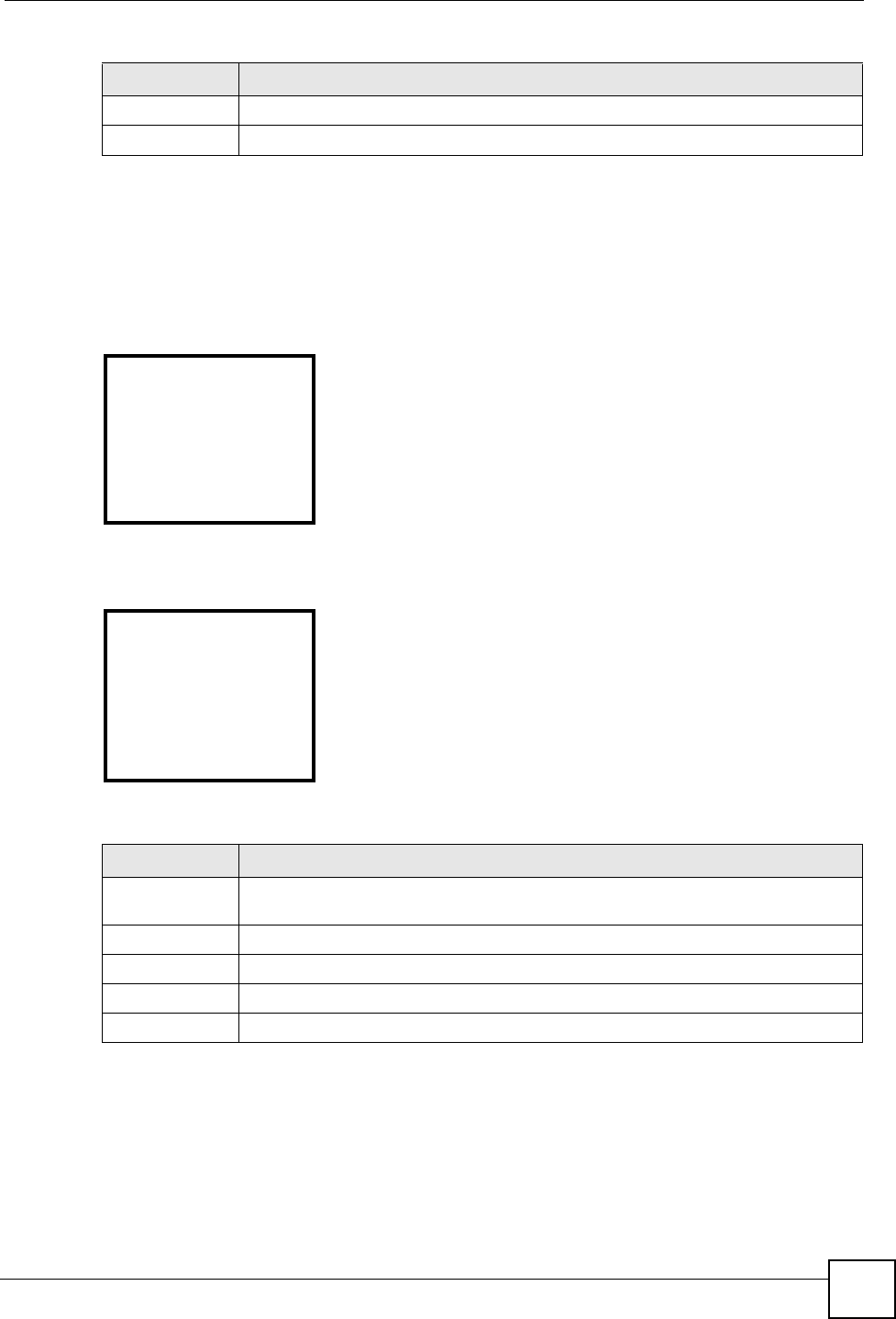
Chapter 6 Network LCD Menus
V630 User’s Guide 79
6.18 WPS: Push Button Configuration
When you press Menu > Network > WLAN Profiles > WPS > PBC mode, the V630 scans
for devices with WPS activated.
Figure 64 Menu > Network > WLAN Profiles > WPS > PBC Mode (Scanning)
The V630 lists devices with WPS activated. Select the AP to which you want to connect.
Figure 65 Menu > Network > WLAN Profiles > WPS > PBC Mode (Select AP)
The following table describes the labels in this screen.
The V630 gets network settings from the AP.
Select Press this to choose the highlighted field in the menu.
Back Press this to return to the previous screen.
Table 64 Menu > Network > WLAN Profiles > WPS
LABEL DESCRIPTION
Table 65 Menu > Network > WLAN Profiles > WPS
LABEL DESCRIPTION
Name The SSID (name) of the AP displays first. Select the AP to which you want the V630
to connect.
RSSI This is the RSSI (Received Signal Strength Indicator) of the wireless connection.
WPS ready (PB) This means the AP has the WPS Push Button Configuration (PBC) option activated.
Select Press this to choose the highlighted field in the menu.
Back Press this to return to the previous screen.
Scanning...
Cancel
-------WLAN Scan----
ZyXEL WPS
Example
RSSI: 63
WPS ready (PB)
Select Back

Chapter 6 Network LCD Menus
V630 User’s Guide
80
Figure 66 Menu > Network > WLAN Profiles > WPS > PBC Mode (Getting Settings)
After obtaining the settings, the V630 connects to the AP and attempts to register with the SIP
server.
6.19 WPS: PIN Mode
When you press Menu > Network > WLAN Profiles > WPS, the V630 generates a security
key that you can input into an AP that supports PIN mode. Move the cursor to PIN mode to
see the full key.
Figure 67 Menu > Network > WLAN Profiles > WPS (Security Key)
After you input the security key in the AP’s PIN mode interface, start WPS in the AP and
select PIN mode in the V630’s WPS menu.
Figure 68 Menu > Network > WLAN Profiles > WPS > PIN mode
6.20 SIP Profiles
Press Menu > Network > SIP Profiles to display the following menu. Use this menu to select
whether you want to go to the list of already configured profiles of SIP settings or create a
profile of SIP settings.
---------WPS--------
5/13
Cancel
----WPS: do now:----
1 PBC mode
2 mode 28295396
Select Back
Scanning...
Cancel

Chapter 6 Network LCD Menus
V630 User’s Guide 81
Figure 69 Menu > Network > SIP Profiles
The following table describes the labels in this screen.
6.21 SIP Profiles List
Press Menu > Network > SIP Profiles > Profiles List to display the following menu. Use this
menu to look through and edit already configured profiles of WLAN settings.
"You can configure multiple SIP profiles. See Section 6.16 on page 78 for how
to select which SIP profile to use with a WLAN profile.
Figure 70 Menu > Network > SIP Profiles > Profiles List
The following table describes the labels in this screen.
Table 66 Menu > Network > SIP Profiles
LABEL DESCRIPTION
Profiles List Look through and edit already configured profiles of SIP settings.
Add to Profile Create a profile of WLAN settings.
Select Press this to choose the highlighted field in the menu.
Back Press this to return to the previous screen.
----SIP Profiles---
1 Profiles List
2 Add to Profile
Select Back
Table 67 Menu > Network > SIP Profiles > Profiles List
LABEL DESCRIPTION
Profiles List These are the already configured profiles of SIP settings. Select a profile to edit or
delete it.
Select Press this to choose the highlighted field in the menu.
Back Press this to return to the previous screen.
----Profiles List---
1 test
2 example
Select Back

Chapter 6 Network LCD Menus
V630 User’s Guide
82
6.22 SIP Profile
Press Menu > Network > SIP Profiles > Profiles List and select a profile to display the
following menu. Use this menu to choose whether to edit or delete the selected profile.
Figure 71 Menu > Network > SIP Profiles > Profiles List > Profile
The following table describes the labels in this screen.
6.23 Adding a SIP Profile
Press Menu > Network > SIP Profiles > Add to Profile to display the following menu. Use
this menu to create a profile of SIP settings.
Figure 72 Menu > Network > SIP Profiles > Add to Profile
The following table describes the labels in this screen.
Table 68 Menu > Network > SIP Profiles > Profiles List > Profile
LABEL DESCRIPTION
Edit Select this to modify the profile. This opens a menu were you can select what you
want to modify. See Section 6.7 on page 72 for details on the SIP profile editing
screens.
Delete Select this to remove the profile.
Select Press this to choose the highlighted field in the menu.
Back Press this to return to the previous screen.
---------test-------
1 Edit
2 Delete
Select Back
Table 69 Menu > Network > SIP Profiles > Add to Profile
LABEL DESCRIPTION
New Profile
Name Input the name of the profile. When you press a key, other character options appear
above the input field. Press a key multiple times to input one of the characters
above.
Done Press this to save your setting.
abc Press # to switch between the lower-case and upper-case input modes.
--New Profile Name--
Done abc Back

Chapter 6 Network LCD Menus
V630 User’s Guide 83
6.24 Editing the New SIP Profile
Press Menu > Network > SIP Profiles > Add to Profile and specify a name to display the
following menu. Use this menu to create a profile of SIP settings.
Figure 73 Menu > Network > SIP Profiles > Add to Profile > Name
The following table describes the labels in this screen.
6.25 SIP Display Name
Press Menu > Network > SIP Profiles > Add to Profile, specify a name and then select
Display Name to open the following menu. Use this menu to specify the profile name that you
want to display.
Back Press this to return to the previous screen.
Clear After you start inputting text, Back changes to Clear. Press this to backspace.
Table 69 Menu > Network > SIP Profiles > Add to Profile
LABEL DESCRIPTION
Table 70 Menu > Network > SIP Profiles > Add to Profile > Name
LABEL DESCRIPTION
Display Name Select this to specify the profile name that you want to display. This is the title that
displays on the LCD main screen when the SIP account is registered.
Phone Number Select this to specify the phone number of the SIP account.
SIP Server Select this to specify the SIP server that the SIP account uses.
SIP Proxy Select this to specify the SIP server that the SIP account uses. If you have more
than one server’s address, use this menu to enter the registrar server’s address.
NAT traversal Select this if you need to specify a STUN server, outbound proxy server, or NAT
keep alive time.
Expire Select this to specify the SIP server expire time.
Codec Order Change the order for which codec the V630 attempts to use in making a call.
Select Press this to choose the highlighted field in the menu.
Back Press this to return to the previous screen.
---Add to Profile---
1 Display Name
2 Phone Number
3 SIP Server
4 SIP Proxy
Select Back

Chapter 6 Network LCD Menus
V630 User’s Guide
84
Figure 74 Menu > Network > SIP Profiles > Add to Profile > Name > Display Name
The following table describes the labels in this screen.
6.26 SIP Phone Number
Press Menu > Network > SIP Profiles > Add to Profile, specify a name and then select
Phone Number to open the following menu. Use this menu to specify the phone number of
the SIP account.
Figure 75 Menu > Network > SIP Profiles > Add to Profile > Name > Phone Number
The following table describes the labels in this screen.
Table 71 Menu > Network > SIP Profiles > Add to Profile > Name > Display Name
LABEL DESCRIPTION
Display Name Input the profile’s display name. When you press a key, other character options
appear above the input field. Press a key multiple times to input one of the
characters above.
Done Press this to save your setting.
abc Press # to switch between the lower-case and upper-case input modes.
Clear Press this to backspace.
Back Press this to return to the previous screen. After you clear all the text, Clear
changes to Back.
-----Display Name---
ZyXEL V630
Done abc Clear
Table 72 Menu > Network > SIP Profiles > Add to Profile > Name > Phone Number
LABEL DESCRIPTION
Phone Number Input the profile’s SIP phone number. For example, if you have a SIP account like
1234567@voip-provider.com, your SIP account number is 1234567. When you
press a key, other character options appear above the input field. Press a key
multiple times to input one of the characters above.
Done Press this to save your setting.
Back Press this to return to the previous screen.
Clear After you start inputting text, Back changes to Clear. Press this to backspace.
-----Phone Number---
Done Back

Chapter 6 Network LCD Menus
V630 User’s Guide 85
6.27 SIP Server
Press Menu > Network > SIP Profiles > Add to Profile, specify a name and then select SIP
Server to open the following menu. Use this menu to select whether you want to edit the SIP
server’s address or SIP port number.
Figure 76 Menu > Network > SIP Profiles > Add to Profile > Name > SIP Server
The following table describes the labels in this screen.
6.28 SIP Server Address
Press Menu > Network > SIP Profiles > Add to Profile, specify a name and then select SIP
Server > SIP Address to open the following menu. Use this menu to enter the SIP server’s
address.
Figure 77 Menu > Network > SIP Profiles > Add to Profile > Name > SIP Server > SIP
Address
Table 73 Menu > Network > SIP Profiles > Add to Profile > Name > SIP Server
LABEL DESCRIPTION
SIP Address Select this to enter the IP address of the SIP server for this account.
SIP Port Select this to enter the SIP port number of the SIP server for this account.
Select Press this to choose the highlighted field in the menu.
Back Press this to return to the previous screen.
--SIP Server Setup--
1 SIP Address
2 SIP Port
Done Back
-----SIP Address----
Done abc Back

Chapter 6 Network LCD Menus
V630 User’s Guide
86
The following table describes the labels in this screen.
6.29 SIP Port Number
Press Menu > Network > SIP Profiles > Add to Profile, specify a name and then select SIP
Server > SIP Address to open the following menu. Use this menu to enter the SIP server’s
port number.
Figure 78 Menu > Network > SIP Profiles > Add to Profile > Name > SIP Server > SIP Port
The following table describes the labels in this screen.
6.30 SIP Proxy Setup
Press Menu > Network > SIP Profiles > Add to Profile, specify a name and then select SIP
Proxy to open the following menu. Use this menu to specify which SIP proxy settings you
want to enter.
Table 74 Menu > Network > SIP Profiles > Add to Profile > Name > SIP Server > SIP
Address
LABEL DESCRIPTION
SIP Address Enter the IP address or domain name of the SIP server for this account. If you have
more than one server’s address, enter the registrar server’s address. When you
press a key, other character options appear above the input field. Press a key
multiple times to input one of the characters above.
Done Press this to save your setting.
abc Press # to switch between the lower-case and upper-case input modes.
Back Press this to return to the previous screen.
Clear After you start inputting text, Back changes to Clear. Press this to backspace.
Table 75 Menu > Network > SIP Profiles > Add to Profile > Name > SIP Server > SIP Port
LABEL DESCRIPTION
SIP Port Enter the SIP port number that the SIP server uses.
Done Press this to save your setting.
Back Press this to return to the previous screen.
Clear After you start inputting text, Back changes to Clear. Press this to backspace.
-------SIP Port-----
5060
Done Back

Chapter 6 Network LCD Menus
V630 User’s Guide 87
Figure 79 Menu > Network > SIP Profiles > Add to Profile > Name > SIP Proxy
The following table describes the labels in this screen.
6.31 SIP Proxy Address
Press Menu > Network > SIP Profiles > Add to Profile, specify a name and then select SIP
Proxy > Proxy Address to open the following menu. Use this menu to enter the SIP proxy
server’s address.
Figure 80 Menu > Network > SIP Profiles > Add to Profile > Name > SIP Proxy > Proxy
Address
The following table describes the labels in this screen.
Table 76 Menu > Network > SIP Profiles > Add to Profile > Name > SIP Proxy
LABEL DESCRIPTION
Proxy Address If the VoIP service provider provided a SIP proxy server address, select this to
configure it.
Proxy Port If the VoIP service provider provided a port number other than 5060, select this to
configure it.
Proxy Username Select this to enter your SIP account’s user name.
Proxy Password Select this to enter your SIP account’s password.
Select Press this to choose the highlighted field in the menu.
Back Press this to return to the previous screen.
-----Proxy Setup----
1 Proxy Address
2 Proxy Port
3 Proxy Username
4 Proxy Password
Done Back
Table 77 Menu > Network > SIP Profiles > Add to Profile > Name > SIP Server > SIP Proxy >
Proxy Address
LABEL DESCRIPTION
Proxy Address Enter the IP address or domain name of the SIP proxy server for this account. When
you press a key, other character options appear above the input field. Press a key
multiple times to input one of the characters above.
Done Press this to save your setting.
abc Press # to switch between the lower-case and upper-case input modes.
----Proxy Address---
Done abc Back

Chapter 6 Network LCD Menus
V630 User’s Guide
88
6.32 SIP Proxy Port
Press Menu > Network > SIP Profiles > Add to Profile, specify a name and then select SIP
Proxy > Proxy Port to open the following menu. Use this menu to enter the SIP proxy
server’s port number.
Figure 81 Menu > Network > SIP Profiles > Add to Profile > Name > SIP Proxy > Proxy Port
The following table describes the labels in this screen.
6.33 SIP Proxy User Name
Press Menu > Network > SIP Profiles > Add to Profile, specify a name and then select SIP
Proxy > Proxy Username to open the following menu. Use this menu to enter the SIP
account’s user name.
Figure 82 Menu > Network > SIP Profiles > Add to Profile > Name > SIP Proxy > Proxy
Username
Back Press this to return to the previous screen.
Clear After you start inputting text, Back changes to Clear. Press this to backspace.
Table 77 Menu > Network > SIP Profiles > Add to Profile > Name > SIP Server > SIP Proxy >
Proxy Address
LABEL DESCRIPTION
Table 78 Menu > Network > SIP Profiles > Add to Profile > Name > SIP Proxy > Proxy
Address
LABEL DESCRIPTION
Proxy Port Enter the SIP port number that the SIP proxy server uses.
Done Press this to save your setting.
Back Press this to return to the previous screen.
Clear After you start inputting text, Back changes to Clear. Press this to backspace.
-----Proxy Port----
5060
Done abc Back
---Proxy Username---
Done abc Back

Chapter 6 Network LCD Menus
V630 User’s Guide 89
The following table describes the labels in this screen.
6.34 SIP Proxy Password
Press Menu > Network > SIP Profiles > Add to Profile, specify a name and then select SIP
Proxy > Proxy Password to open the following menu. Use this menu to enter the SIP
account’s user name.
Figure 83 Menu > Network > SIP Profiles > Add to Profile > Name > SIP Proxy > Proxy
Password
The following table describes the labels in this screen.
6.35 NAT Traversal
Press Menu > Network > SIP Profiles > Add to Profile, specify a name and then select NAT
traversal to open the following menu. Use this menu to select which NAT traversal settings
you want to enter.
Table 79 Menu > Network > SIP Profiles > Add to Profile > Name > SIP Proxy > Proxy
Username
LABEL DESCRIPTION
Proxy Username Enter the user name for this account. When you press a key, other character options
appear above the input field. Press a key multiple times to input one of the
characters above.
Done Press this to save your setting.
abc Press # to switch between the lower-case and upper-case input modes.
Back Press this to return to the previous screen.
Clear After you start inputting text, Back changes to Clear. Press this to backspace.
Table 80 Menu > Network > SIP Profiles > Add to Profile > Name > SIP Proxy > Proxy
Username
LABEL DESCRIPTION
Proxy Password Enter the password for this account. When you press a key, other character options
appear above the input field. Press a key multiple times to input one of the
characters above.
Done Press this to save your setting.
abc Press # to switch between the lower-case and upper-case input modes.
Back Press this to return to the previous screen.
Clear After you start inputting text, Back changes to Clear. Press this to backspace.
---Proxy Password---
Done abc Back

Chapter 6 Network LCD Menus
V630 User’s Guide
90
Figure 84 Menu > Network > SIP Profiles > Add to Profile > Name > NAT traversal
The following table describes the labels in this screen.
6.36 STUN Setup
Press Menu > Network > SIP Profiles > Add to Profile, specify a name and then select NAT
traversal > STUN Server to open the following menu. Use this menu to select whether you
want to edit the STUN server’s address or port number setting.
Figure 85 Menu > Network > SIP Profiles > Add to Profile > Name > NAT traversal > STUN
Server
The following table describes the labels in this screen.
Table 81 Menu > Network > SIP Profiles > Add to Profile > Name > NAT traversal
LABEL DESCRIPTION
STUN Server Select this to configure the V630 to get NAT information automatically from a
STUN (Simple Traversal of User Datagram Protocol (UDP) through Network
Address Translators) server.
Outbound Proxy Select this if you have an outbound proxy server.
NAT Keep Alive Select this to configure NAT keep alive to stop NAT routers between the V630 and
the SIP server from dropping the SIP session.
Select Press this to choose the highlighted field in the menu.
Back Press this to return to the previous screen.
----NAT traversal---
1 STUN Server
2 Outbound Proxy
3 NAT Keep Ali..
Done Back
Table 82 Menu > Network > SIP Profiles > Add to Profile > Name > NAT traversal > STUN
Server
LABEL DESCRIPTION
STUN Address Select this to enter the IP address or domain name of the SIP server for this
account.
STUN Port Select this to enter the SIP port number of the SIP server for this account.
Select Press this to choose the highlighted field in the menu.
Back Press this to return to the previous screen.
------STUN Setup----
1 STUN Address
2 STUN Port
Done Back

Chapter 6 Network LCD Menus
V630 User’s Guide 91
6.37 STUN Server Address
Press Menu > Network > SIP Profiles > Add to Profile, specify a name and then select NAT
traversal > STUN Server > STUN Address to open the following menu. Use this menu to
enter the STUN server’s address.
Figure 86 Menu > Network > SIP Profiles > Add to Profile > Name > NAT traversal > STUN
Server > STUN Address
The following table describes the labels in this screen.
6.38 STUN Port Number
Press Menu > Network > SIP Profiles > Add to Profile, specify a name and then select NAT
traversal > STUN Server > STUN Port to open the following menu. Use this menu to enter
the STUN server’s port number.
Figure 87 Menu > Network > SIP Profiles > Add to Profile > Name > NAT traversal > STUN
Server > STUN Port
Table 83 Menu > Network > SIP Profiles > Add to Profile > Name > NAT traversal > STUN
Server > STUN Address
LABEL DESCRIPTION
STUN Address Enter the IP address or domain name of the STUN server. When you press a key,
other character options appear above the input field. Press a key multiple times to
input one of the characters above.
Done Press this to save your setting.
abc Press # to switch between the lower-case and upper-case input modes.
Back Press this to return to the previous screen.
Clear After you start inputting text, Back changes to Clear. Press this to backspace.
-----STUN Address---
Done abc Back
------STUN Port-----
3478
Done Back

Chapter 6 Network LCD Menus
V630 User’s Guide
92
The following table describes the labels in this screen.
6.39 Outbound Proxy Setup
Press Menu > Network > SIP Profiles > Add to Profile, specify a name and then select NAT
traversal > Outbound Proxy to open the following menu. Use this menu to select whether
you want to edit the outbound proxy server’s address or port number setting.
Figure 88 Menu > Network > SIP Profiles > Add to Profile > Name > NAT traversal >
Outbound Proxy
The following table describes the labels in this screen.
6.40 Outbound Proxy Server Address
Press Menu > Network > SIP Profiles > Add to Profile, specify a name and then select NAT
traversal > Outbound Proxy > Outbound Address to open the following menu. Use this
menu to enter the outbound proxy server’s address.
Table 84 Menu > Network > SIP Profiles > Add to Profile > Name > NAT traversal > STUN
Server > STUN Port
LABEL DESCRIPTION
STUN Port Enter the port number that the STUN server uses.
Done Press this to save your setting.
Back Press this to return to the previous screen.
Clear After you start inputting text, Back changes to Clear. Press this to backspace.
Table 85 Menu > Network > SIP Profiles > Add to Profile > Name > NAT traversal >
Outbound Proxy
LABEL DESCRIPTION
Outbound
Address Select this to enter the IP address or domain name of the outbound proxy server.
Outbound Port Select this to enter the port number of the outbound proxy server.
Select Press this to choose the highlighted field in the menu.
Back Press this to return to the previous screen.
---Outbound Setup---
1 Outbound Address
2 Outbound Port
Done Back

Chapter 6 Network LCD Menus
V630 User’s Guide 93
Figure 89 Menu > Network > SIP Profiles > Add to Profile > Name > NAT traversal >
Outbound Proxy > Outbound Address
The following table describes the labels in this screen.
6.41 Outbound Proxy Port Number
Press Menu > Network > SIP Profiles > Add to Profile, specify a name and then select NAT
traversal > Outbound Proxy > Outbound Port to open the following menu. Use this menu
to enter the outbound proxy server’s port number.
Figure 90 Menu > Network > SIP Profiles > Add to Profile > Name > NAT traversal >
Outbound Proxy > Outbound Port
The following table describes the labels in this screen.
Table 86 Menu > Network > SIP Profiles > Add to Profile > Name > NAT traversal >
Outbound Proxy > Outbound Address
LABEL DESCRIPTION
Outbound
Address Enter the IP address or domain name of the outbound proxy server. When you
press a key, other character options appear above the input field. Press a key
multiple times to input one of the characters above.
Done Press this to save your setting.
abc Press # to switch between the lower-case and upper-case input modes.
Back Press this to return to the previous screen.
Clear After you start inputting text, Back changes to Clear. Press this to backspace.
--Outbound Address--
Done abc Back
Table 87 Menu > Network > SIP Profiles > Add to Profile > Name > NAT traversal >
Outbound Proxy > Outbound Port
LABEL DESCRIPTION
Outbound Port Enter the port number that the outbound proxy server uses.
Done Press this to save your setting.
Back Press this to return to the previous screen.
Clear After you start inputting text, Back changes to Clear. Press this to backspace.
---Outbound Port---
3478
Done Back

Chapter 6 Network LCD Menus
V630 User’s Guide
94
6.42 NAT Keep Alive Time
Press Menu > Network > SIP Profiles > Add to Profile, specify a name and then select NAT
traversal > NAT Keep Alive to open the following menu. Use this menu to set the NAT keep
alive time.
Figure 91 Menu > Network > SIP Profiles > Add to Profile > Name > NAT traversal > NAT
Keep Alive
The following table describes the labels in this screen.
6.43 SIP Server Expire Time
Press Menu > Network > SIP Profiles > Add to Profile, specify a name and then select
Expire to open the following menu. Use this menu to set the SIP server expiration time.
Figure 92 Menu > Network > SIP Profiles > Add to Profile > Name > Expire
Table 88 Menu > Network > SIP Profiles > Add to Profile > Name > NAT traversal > NAT
Keep Alive
LABEL DESCRIPTION
NAT Keep Alive
Time Enter the number of NAT keep alive time seconds.
Done Press this to save your setting.
Back Press this to return to the previous screen.
Clear After you start inputting text, Back changes to Clear. Press this to backspace.
NAT Keep Alive Time
15
Done Back
--------Expire------
3600
Done Back

Chapter 6 Network LCD Menus
V630 User’s Guide 95
The following table describes the labels in this screen.
6.44 Codec Order
Press Menu > Network > SIP Profiles > Add to Profile, specify a name and then select
Codec Order to open the following menu. Use this menu to set the order for which codec the
V630 attempts to use in making a call.
Figure 93 Menu > Network > SIP Profiles > Add to Profile > Name > Codec Order
The following table describes the labels in this screen.
6.45 Ping Test
Press Menu > Network > Ping test to display the following menu. Use this menu to have the
V630 send a ping to an IP address to check the network connectivity to a device.
Table 89 Menu > Network > SIP Profiles > Add to Profile > Name > Expire
LABEL DESCRIPTION
Expire Enter the SIP server’s expiration time (in seconds). This is how long an entry
remains registered with the SIP server. After the time period expires, the SIP
register server deletes the V630’s entry from the database of registered SIP
numbers. Different register servers may use different time periods. The V630 sends
another registration request after half of the time period configured here has
expired.
Done Press this to save your setting.
Back Press this to return to the previous screen.
Clear After you start inputting text, Back changes to Clear. Press this to backspace.
Table 90 Menu > Network > SIP Profiles > Add to Profile > Name > Code Order
LABEL DESCRIPTION
Codec Order Use the Up or Down key to change the order for which codec the V630 attempts to
use in making a call.
Done Press this to save your setting.
Cancel Press this to return to the previous screen.
-----Codec Order----
G.711
G.726
G.729
Done Back

Chapter 6 Network LCD Menus
V630 User’s Guide
96
Figure 94 Menu > Network > Ping test
The following table describes the labels in this screen.
6.46 Manual Ping Test
Press Menu > Network > Ping test > Manual to display the following menu. Use this menu
to have the V630 send a ping to an IP address to check the network connectivity to a device.
Figure 95 Menu > Network > Ping test > Manual
The following table describes the labels in this screen.
Table 91 Menu > Network > Ping test
LABEL DESCRIPTION
Manual Select this to go to a menu where you can specify an IP address to which to send a
ping.
Gateway Select this to send a ping to check the connectivity to the V630’s gateway device.
DNS Select this to send a ping to check the connectivity to the V630’s DNS server.
SIP Server Select this to send a ping to check the connectivity to the V630’s SIP server.
SIP Proxy Select this to send a ping to check the connectivity to the V630’s SIP proxy server.
Outbound Proxy Select this to send a ping to check the connectivity to the V630’s SIP outbound
proxy server.
Stun Server Select this to send a ping to check the connectivity to the V630’s STUN server.
Select Press this to choose the highlighted field in the menu.
Back Press this to return to the previous screen.
-------Ping test----
1 Manual
2 Gateway
3 DNS
4 SIP Server
Select Back
Table 92 Menu > Network > Ping test > Manual
LABEL DESCRIPTION
IP address Use the V630’s alphanumeric keypad to input the IP address to which the V630 is to
send a ping. Use the Down or Up key if you need to move the cursor.
Set Press this to save your setting.
Back Press this to return to the previous screen.
--------Manual------
Enter IP Address
0. 0. 0. 0
Set Back

Chapter 6 Network LCD Menus
V630 User’s Guide 97
6.47 Ping Test in Progress
Here is an example of the results when the V630 performs a ping test (in this case to the
gateway).
Figure 96 Menu > Network > Ping test (In Progress)
The following table describes the labels in this screen.
6.48 Reconnect
Press Menu > Network > Re-connect to display the following screen. Use this menu to
reconnect to the AP.
Figure 97 Menu > Network > Re-connect
The following table describes the labels in this screen.
Table 93 Menu > Network > Ping test (In Progress)
LABEL DESCRIPTION
time This is how many milliseconds it took to get a response from the IP address to which
the V630 sent a ping.
timeout. Timeout means the V630 did not receive a reply from the IP address to which it sent
a ping.
Cancel Press this to stop the ping test and return to the previous screen.
-------Gateway------
time 4.6ms
timeout.
Cancel
Table 94 Menu > Network > Re-connect
LABEL DESCRIPTION
Re-connect The V630 attempt to re-establish its connection to the AP.
------Re-connect----
Waiting...

Chapter 6 Network LCD Menus
V630 User’s Guide
98

V630 User’s Guide 99
CHAPTER 7
The Phonebook
Use the V630’s phonebook to store the names and phone numbers of your contacts. You can
either add phonebook entries yourself, or they can be supplied via auto provisioning.
The entries can be regular phone numbers (that you use a SIP server to call) or Peer to Peer
(P2P) numbers. Use P2P entries to call directly to the callee’s SIP phone number and IP
address without using a SIP server. This is also called a ““Point to Point”, or “IP-to-IP” call.
The following sections describe how to use the phonebook.
7.1 Opening the Phonebook
While in the main screen, press the Right key to open the phonebook. The contact list
appears.
Figure 98 Phonebook
7.2 Adding a Phonebook Entry
To add a contact into the V630’s phonebook, either add the number from your call log or do
the following.
1While in the main screen, press the Right key to open the phonebook. The contact list
appears.
2Press Option > Add to display the following screen.
-----Search Name----
1 OK
2 TEST
Option ABC Back

Chapter 7 The Phonebook
V630 User’s Guide
100
Figure 99 Phonebook > Option > Add
The following table describes the labels in this screen.
3The following screen displays. Press the Left key (Yes).
Figure 100 New Contact Name
4A screen displays with the contact’s name at the top. Use the alphanumeric keypad to
enter the contact’s phone number. Then press Done.
Figure 101 New Contact Number
5Select SIP mode if you will use a SIP server to call the callee. Select P2P mode if you
will call the callee’s SIP phone number and IP address without using a SIP serve
Table 95 Menu > Network > SIP Profiles > Add to Profile
LABEL DESCRIPTION
Find/add name Input the name of the contact. When you press a key, other character options
appear above the input field. Press a key multiple times to input one of the
characters above.
Done Press this to save your setting.
abc Press # to switch between the lower-case and upper-case input modes.
Back Press this to return to the previous screen.
Clear After you start inputting text, Back changes to Clear. Press this to backspace.
-------Add name-----
Done ABC Back
---Add new name ?---
example
Yes Back
-------Number-------
987654321
Done Back

Chapter 7 The Phonebook
V630 User’s Guide 101
Figure 102 Selecting the Calling Mode
6If you selected SIP, skip to step 8 on page 101. Enter the callee’s IP address and press
Done.
Figure 103 Entering a Peer’s IP Address
7Enter the callee’s SIP port number (if it is different from the default of 5060) and press
Done. Then press the Left key to start the call.
Figure 104 Entering a Peer’s Port Number
8Select a group to add the contact to, or just select None to not add the contact to a group.
Figure 105 New Contact Group
9The contact’s entry is stored alphabetically in the phonebook. Note that the alphabetical
order starts over for the entries that start with lower-case letters.
7.3 Selecting a Phonebook Entry
1While in the main screen, press the Right key to open the phonebook’s contact list.
---------Mode------
1 SIP
2 P2P
Done abc Back
------P2P Domain----
Done abc Back
-------P2P Port-----
5060
Done Back
--------Group-------
1 None
2 Business
3 Family
4 Friends
Select Back

Chapter 7 The Phonebook
V630 User’s Guide
102
2Either use the Up and Down keys to scroll through the entries, or use the alphanumeric
keypad to enter the first letter of a contact’s name. For example, press the 2 key three
times to enter a “C”. The cursor jumps to the first entry starting with that letter (if no
entries start with that letter, nothing happens).
"The numbers that display to the left of a contact’s phone number are index
numbers only - you cannot use them to select an entry.
Figure 106 Phonebook
7.4 Calling a Phonebook Contact
Here’s how to call a number you previously entered into the V630’s phonebook.
1While in the main screen, press the Right key to open the phonebook’s contact list.
Figure 107 Phonebook
2Highlight the entry you want to call and press the green Talk key to begin the call.
7.5 Calling a Number Not in the Phonebook
To call a number that is not in your V630’s phonebook, from the main screen, use the
alphanumeric keypad to dial the number and press the green Talk key to start the call.
7.6 Checking a Contact’s Details
Do the following to check a contact’s number and group setting.
1While in the main screen, press the Right key to open the phonebook’s contact list.
-----Search Name----
1 a_example
2 Charles
3 friend
4 work
Select Back
-----Search Name----
1 a_example
2 Charles
3 friend
4 work
Select Back

Chapter 7 The Phonebook
V630 User’s Guide 103
2Select the entry you want to check. Press Option > Detail to display the following
screen. Scroll down to see the contact’s number and which group it belongs to (if any).
Figure 108 Contact Details
7.7 Editing a Phonebook Entry
Take the following steps to change the details of a contact you already entered into the V630’s
phonebook.
1While in the main screen, press the Right key to open the phonebook’s contact list.
2Select the entry you want to change. Press Option > Edit to display the following screen
for editing the contact name. Edit the name and press Done when you are finished.
Figure 109 Editing a Contact Name
3Use this screen to edit the contact’s phone number and press Done.
Figure 110 Editing a Contact Number
4Select which group to add the contact to, or just select None to not add the contact to a
group.
------Phone Book----
Name
Tom
Talk Back
-------example------
example
Done abc Back
-------example------
987654321
Done Back

Chapter 7 The Phonebook
V630 User’s Guide
104
Figure 111 New Contact Group
5The contact’s entry is now edited and stored alphabetically in the phonebook. Note that
the alphabetical order starts over for the entries that start with lower-case letters.
7.8 Deleting a Phonebook Entry
Take the following steps to remove a contact’s entry from the V630’s phonebook.
1While in the main screen, press the Right key to open the phonebook’s contact list.
1Select the entry you want to remove. Press Option > Delete. The following screen
displays.
Figure 112 Delete a Phonebook Entry
2Press Yes to delete the entry, or press Cancel to return to the previous screen.
7.9 Contact Groups
Use contact groups to specify the ring tone for incoming calls from the group’s members. Do
the following to edit a contact group.
1While in the main screen, press the Right key to open the phonebook’s contact list.
Press Option > Group to display the following screen. Select the group that you want to
edit.
Figure 113 Contact Groups
--------Group-------
1 None
2 Business
3 Family
4 Friends
Select Back
----Delete entry----
Delete entry
example?
Yes Cancel
--------Group-------
1 Business
2 Family
3 Friends
4 VIP
Select Back

Chapter 7 The Phonebook
V630 User’s Guide 105
2Select whether to edit the group’s members (see Section 7.10 on page 105) or set the ring
tone to use for incoming calls from the group’s members (see Section 7.11 on page 106).
Figure 114 Contact Group Selected
7.10 Editing a Contact Group’s Members
If you selected Member List in Figure 114 on page 105, the following menu displays. This
menu lists the group’s members.
Figure 115 Contact Group Selected
Select a member to display the following screen. Select Edit to modify the contact’s details
(see Section 7.7 on page 103 for more on this). Select Delete to remove the contact from the
phone book.
"Delete in this screen actually removes the contact from the phone book, not
just from the contact group.
Figure 116 Contact Group Member Selected
--------Group-------
1 Member List
2 Ring tones
Select Back
--------Group-------
1 Tom
2 example
Select Back
---------Tom--------
1 Edit
2 Delete
Select Back

Chapter 7 The Phonebook
V630 User’s Guide
106
7.11 Editing a Contact Group’s Ring Tone
If you selected Ring tones in Figure 114 on page 105, the following menu displays. Select the
ring tone for incoming calls from the selected contact group’s members.
Figure 117 Contact Group Ring tones
7.12 Speed Dial
Set up speed dial entries to be able to call someone by dialing a single number.
7.13 Adding a Speed Dial Entry
Do the following to make an existing phonebook entry into a speed dial entry.
1While in the main screen, press the Right key to open the phonebook’s contact list.
2Select the entry you want to add to speed dial. Press Option > Speed Dial to display the
following screen. Select for which key you want to create a speed dial entry. This
example uses key 2.
Figure 118 Speed Dial
3The following screen displays. Select Yes to add the contact as a speed dial entry.
Figure 119 Set the Speed Dial Entry
----Select Melody---
1 Allegro
2 Bach
3 Beethoven 5th
4 Birthday
Select Back
------Speed Dial----
1 Key1: [Empty]
2 Key2: [Empty]
3 Key3: [Empty]
4 Key4: [Empty]
Done abc Back
--Set Speed Dial #2-
1 Yes
2 No
Done abc Back

Chapter 7 The Phonebook
V630 User’s Guide 107
7.14 Editing a Speed Dial Entry
Do the following to edit an existing speed dial entry.
1While in the main screen, press the Right key to open the phonebook’s contact list.
2Select the entry you want to edit. Press Option > Speed Dial to display the following
screen. Select the speed dial entry you want to edit. This example uses 2.
Figure 120 Speed Dial
The following screen displays. Select Change to set whether or not to use the contact as a
speed dial entry.
"Delete in this screen removes the contact from the phonebook, not just from
the contact group.
Figure 121 Speed Dial Entry Change
3The following screen displays. Select No to not use the contact as a speed dial entry.
Figure 122 Set the Speed Dial Entry
7.15 Deleting All Phonebook Entries
Take the following steps to remove all of your contact entries from the V630’s phonebook.
------Speed Dial----
1 Key1: [Empty]
2 Key2: [Example]
3 Key3: [Empty]
4 Key4: [Empty]
Done abc Back
---- Speed Dial #2--
1 Change
2 Delete
Done abc Back
--Set Speed Dial #2-
1 Yes
2 No
Done abc Back

Chapter 7 The Phonebook
V630 User’s Guide
108
1While in the main screen, press the Right key to open the phonebook’s contact list.
2Press Option > Delete All. The following screen displays.
Figure 123 Delete All Phonebook Entries
3Press Yes to remove all of the phonebook entries, or press Cancel to return to the
previous screen.
7.16 Phonebook Storage Space
Do the following to see how much storage space the phonebook has free for entries.
1While in the main screen, press the Right key to open the phonebook’s contact list.
2Press Option > Memory status. The following screen displays briefly. This screen
shows how many more phonebook entries you can add.
Figure 124 Delete All Phonebook Entries
-----Phone Book-----
Are you sure?
Delete All
Yes Cancel
-----Phone Book-----
198 Records
Free.

V630 User’s Guide 109
CHAPTER 8
Call Options
This chapter describes the options you can use during a call.
8.1 Call Volume
During a call, press the Up or Down key to adjust the volume.
8.2 Call Options
During a call, press Option to open the following screen.
Figure 125 Call Options
The following table describes the labels in this screen.
Table 96 Call Options
LABEL DESCRIPTION
Hold/Unhold Select this to put the call on hold or take it off hold.
Mute/Unmute Select this to mute or unmute the call. When you mute the call, you can still hear the
other party, but the other party cannot hear you.
Blind Transfer Select this to transfer the call to another number.
Phone Book Select this to open the V630’s phone book.
Use Speaker Select this to turn on the speaker phone function.
Select Press this to choose the highlighted field in the menu.
Back Press this to return to the previous screen.
-----Call Options---
1 Hold
2 Mute
3 Blind Trans..
4 Phone Book
Select Back

Chapter 8 Call Options
V630 User’s Guide
110

112

V630 User’s Guide 113
CHAPTER 9
Introducing the Web
Configurator
This chapter describes how to access the V630’s web configurator and provides an overview
of its screens.
9.1 Web Configurator Overview
The web configurator is an HTML-based management interface that allows easy V630 setup
and management via Internet browser. Use Internet Explorer 6.0 and later versions. The
recommended screen resolution is 1024 by 768 pixels.
In order to use the web configurator you need to allow:
• Web browser pop-up windows from your device. Web pop-up blocking is enabled by
default in Windows XP SP (Service Pack) 2.
• JavaScripts (enabled by default).
• Java permissions (enabled by default).
See Appendix C on page 199 if you want to make sure these functions are allowed in Internet
Explorer.
9.2 Accessing the Web Configurator
1Launch your web browser.
"Before you can access the web configurator, you must enable it in the Menu >
Setup > Phone Setting > Web Configurator LCD screen.
2Enter the V630’s IP address as the URL. If the V630 got an IP address automatically,
you may need to check the Menu > Setup > Information > TCP/IP LCD screen to find
it’s IP address (see Section 5.27 on page 64). The following screen displays.
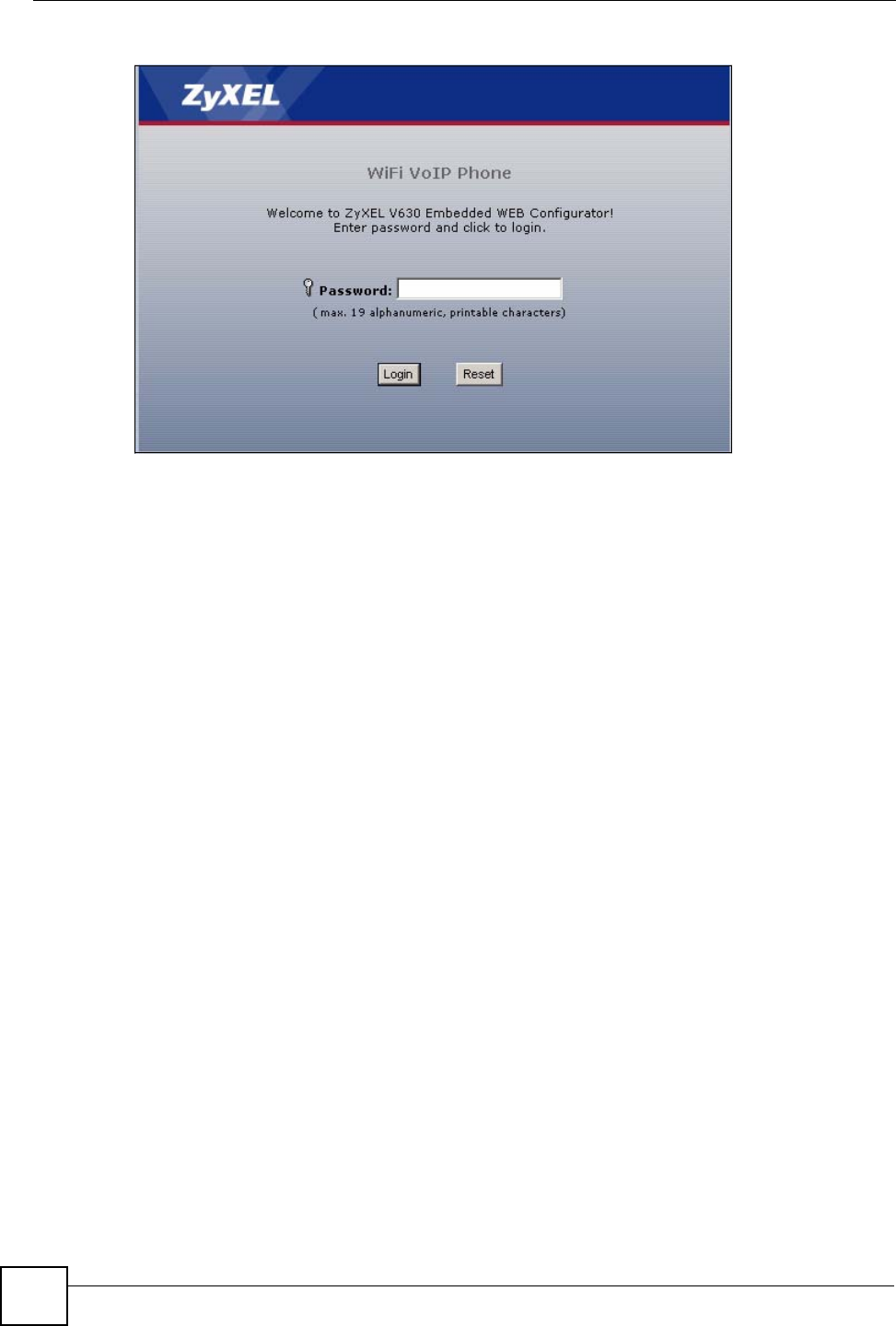
Chapter 9 Introducing the Web Configurator
V630 User’s Guide
114
Figure 126 Password Screen
3For user access, type password (default) as the password. For administrator access, type
admin (default). Click Login.
4It is recommended that you change your password. See Section 16.1 on page 141 for
details.
5The Device Information screen displays.
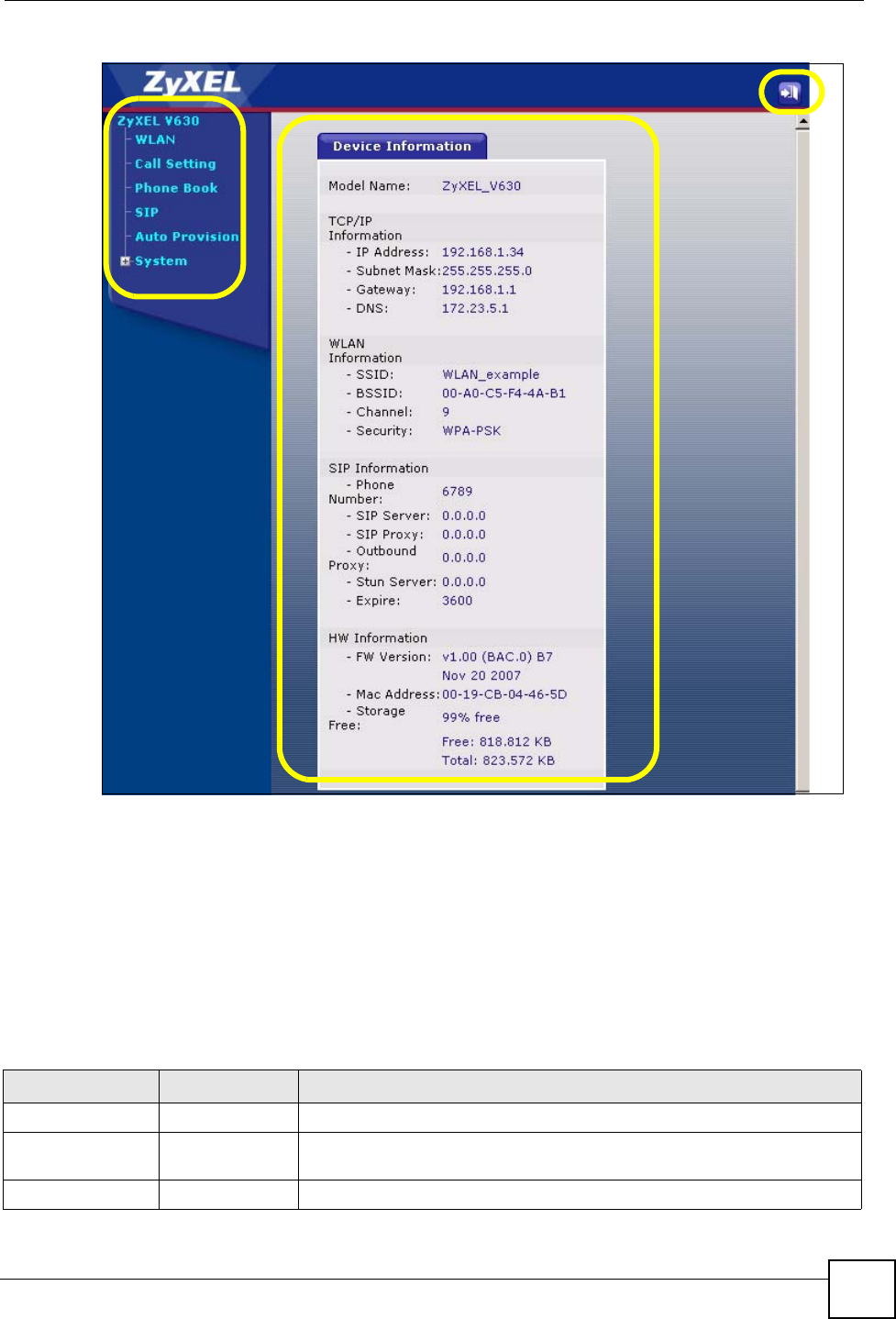
Chapter 9 Introducing the Web Configurator
V630 User’s Guide 115
Figure 127 The Status Screen
As illustrated above, the web configurator screen is divided into four parts.
•A - navigation panel
•B - main window
•C - logout icon
9.2.1 Navigation Panel
Use the menu items on the navigation panel to open screens and configure the V630’s features.
The following table describes the menu items.
B
A
C
Table 97 Navigation Panel Summary
LINK TAB FUNCTION
WLAN WLAN Profile Use this screen to configure WLAN profile settings.
Call Setting Call Setting Use this screen to configure call forwarding and whether or not the V630
sends its phone number to callees.
Phone Book Phone Book Use these screens to configure contact entries.

Chapter 9 Introducing the Web Configurator
V630 User’s Guide
116
9.2.2 Main Window
The main window displays information and configuration fields. It is discussed in the rest of
this document.
The Information screen displays after you log in. See Chapter 10 on page 117 for more
information about the Information screen.
SIP SIP Profile Use this screen to configure the V630 to use a SIP account.
Auto Provision Auto Provision Use this screen if you have an auto-provisioning server on the network.
System
Change Passwd Basic Use this screen to change the user password.
System Use this screen to change the administrator password.
Information This screen displays the current status of the V630, its system resources,
and current TCP/IP, WLAN, and SIP settings.
Upgrade FW Use this screen to upload firmware to the V630.
Table 97 Navigation Panel Summary
LINK TAB FUNCTION
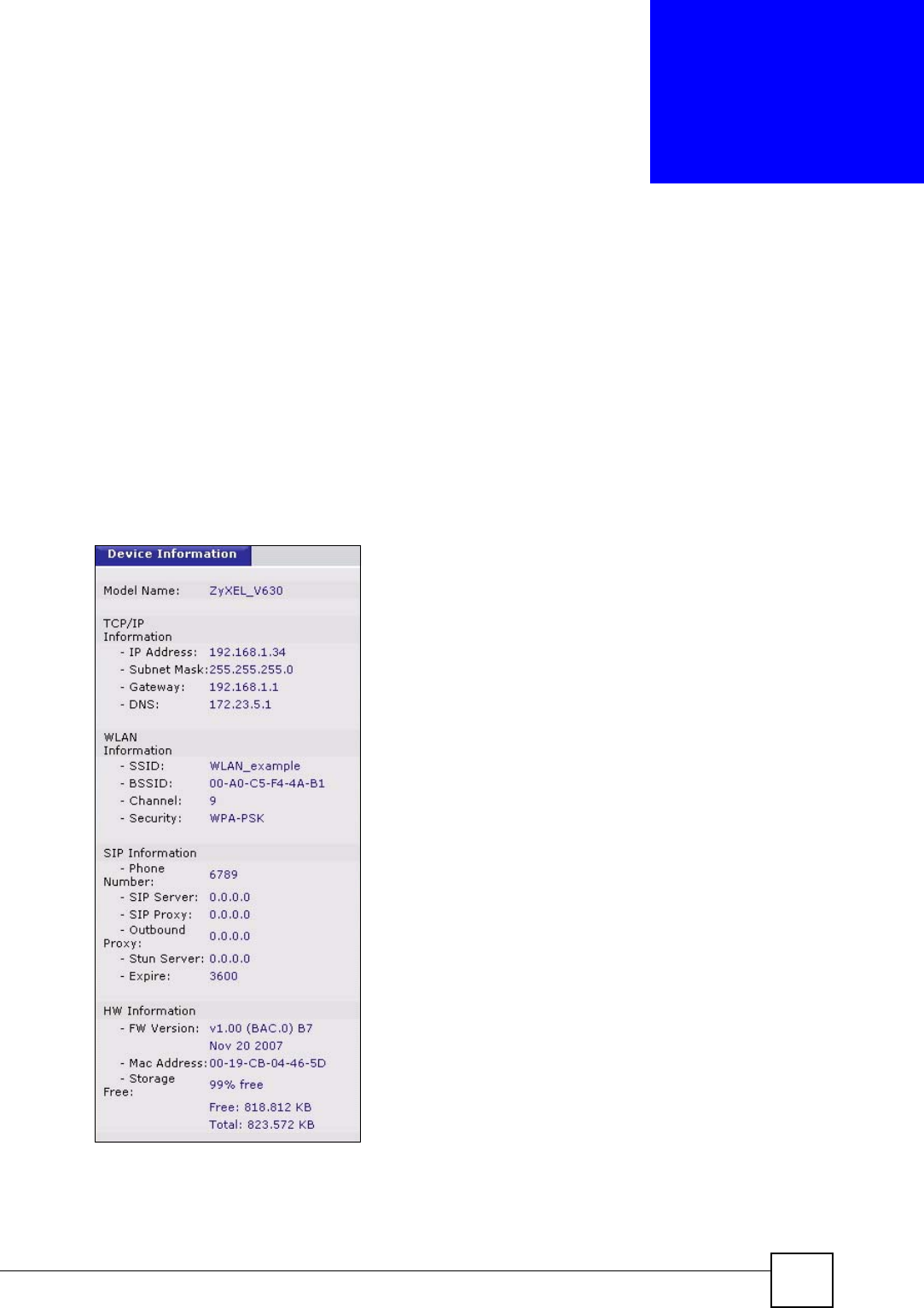
V630 User’s Guide 117
CHAPTER 10
Information Screen
Use the Information screen to see the current status of the V630, its system resources, and
current TCP/IP, WLAN, and SIP settings.
10.1 Information Screen
Click System > Information to open this screen.
Figure 128 Information Screen

Chapter 10 Information Screen
V630 User’s Guide
118
Each field is described in the following table.
Table 98 Information Screen
LABEL DESCRIPTION
Model Name This field displays the V630’s model name.
TCP/IP Information These fields display the V630’s current TCP/IP settings.
IP Address This field displays the current IP address of the V630 on the WLAN.
Subnet Mask This field displays the current subnet mask on the WLAN.
Gateway This field displays the IP address of the router that forwards the V630’s traffic.
DNS This is the IP address of the DNS (Domain Name System) server your V630
uses.
WLAN Information These fields display the V630’s current wireless LAN settings.
SSID This is the SSID (name) of the wireless network that the V630 is currently
using.
BSSID This is the V630’s MAC (Media Access Control) address. Every network device
has a unique MAC address that identifies it across the network.
Channel This is the radio frequency that the V630 is currently using.
Security This is the type of wireless security that the V630 is currently using. The V630
supports WEP, WPA PSK, WPA2 PSK, WPA, and WPA2.
SIP Information These fields display the V630’s current SIP settings.
Phone Number This is the SIP account’s phone number.
SIP Server This is the address of the SIP server for the SIP account.
SIP Proxy This is the address of the SIP proxy server for the SIP account.
Outbound Proxy This is the address of the outbound proxy server for the SIP account.
Stun Server This is the address of the STUN server for the SIP account.
Expire This is the SIP server expire time.
HW Information These fields display the V630’s hardware settings and status.
FW Version This is the firmware (embedded software) version and creation date.
Mac Address This is the V630’s MAC (Media Access Control) address. Every network device
has a unique MAC address that identifies it across the network.
Storage Free This shows how much of the V630’s storage space is available.
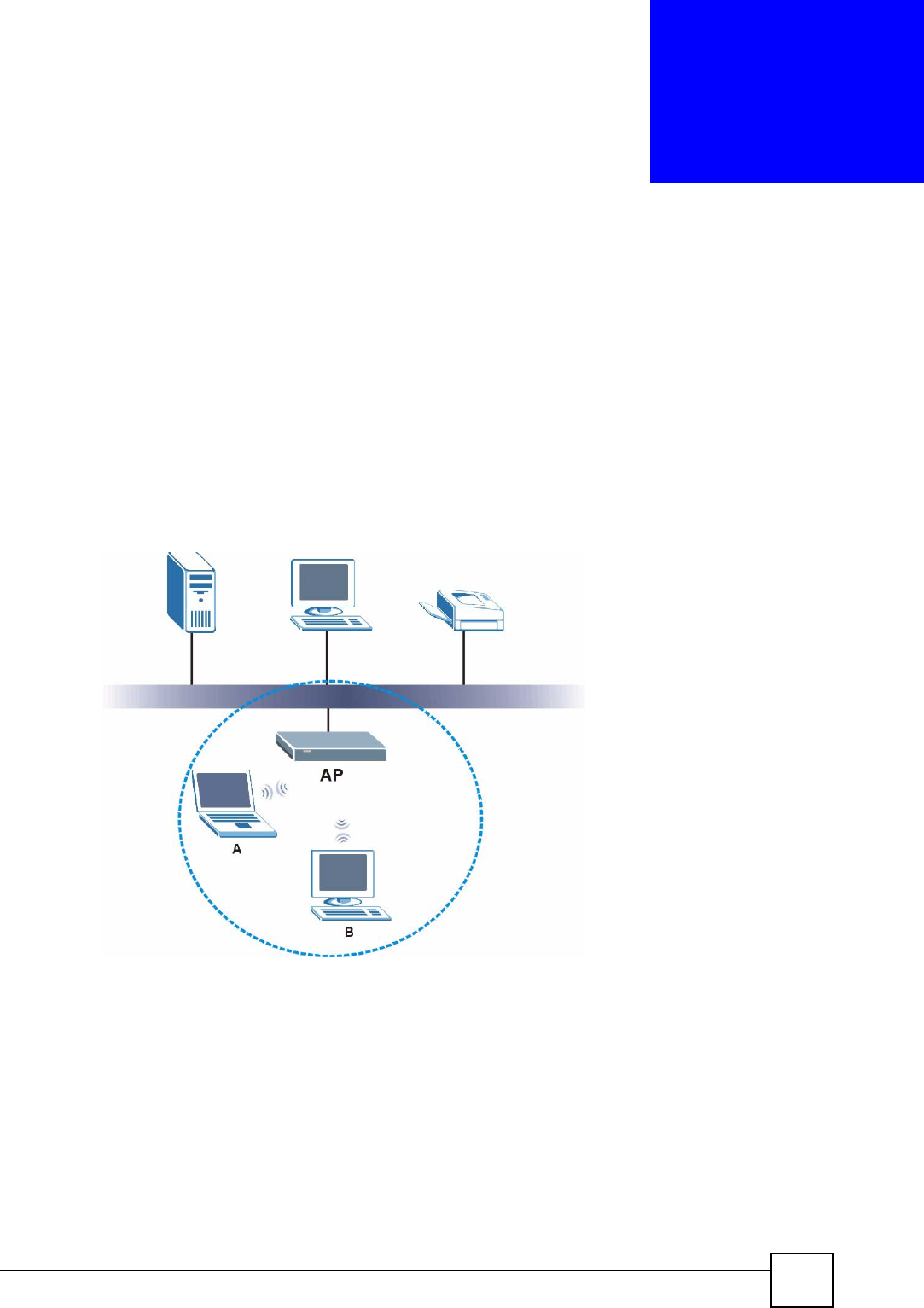
V630 User’s Guide 119
CHAPTER 11
WLAN Profile
Use the WLAN Profile screen to configure profiles of wireless and TCP/IP settings. You can
also select which SIP profile each WLAN profile uses.
11.1 Wireless Network Overview
The following figure provides an example of a wireless network.
Figure 129 Example of a Wireless Network
The wireless network is the part in the blue circle. In this wireless network, devices A and B
are called wireless clients. The wireless clients use the access point (AP) to interact with other
devices (such as the printer) or with the Internet. Your V630 is a wireless client.
Every wireless network must follow these basic guidelines.
• Every wireless client in the same wireless network must use the same SSID.
The SSID is the name of the wireless network. It stands for Service Set IDentity.
• If two wireless networks overlap, they should use different channels.
Like radio stations or television channels, each wireless network uses a specific channel,
or frequency, to send and receive information.

Chapter 11 WLAN Profile
V630 User’s Guide
120
• Every wireless client in the same wireless network must use security compatible with the
AP.
Security stops unauthorized devices from using the wireless network. It can also protect
the information that is sent in the wireless network.
11.2 Wireless Security Overview
The following table shows the relative strengths of common types of wireless security. Use the
strongest security that every wireless client in the wireless network supports.
If you have a RADIUS server, you can use WPA or WPA2 so users have to log into the
wireless network before using it. This is called user authentication. RADIUS servers are more
common in businesses (WPA and WPA2 are also called the enterprise version of WPA).
If you do not have a RADIUS server, the strongest wireless security you can use is WPA2-
PSK (WPA2-PSK and WPA-PSK are also known as the personal version of WPA).
"It is recommended that wireless networks use WPA-PSK, WPA, or stronger
security. WEP is better than no security, but it is still possible for unauthorized
devices to figure out the original information pretty quickly.
When you select WPA2 or WPA2-PSK in your V630, you can also select an option (WPA
Compatible) to support WPA as well. In this case, if some wireless clients support WPA and
some support WPA2, you should set up WPA2-PSK or WPA2 (depending on the type of
wireless network login) and select the WPA Compatible option in the V630.
11.2.1 SSID
Normally, the AP acts like a beacon and regularly broadcasts the SSID in the area. You can
hide the SSID instead, in which case the AP does not broadcast the SSID. In addition, you
should change the default SSID to something that is difficult to guess.
This type of security is fairly weak, however, because there are ways for unauthorized devices
to get the SSID. In addition, unauthorized devices can still see the information that is sent in
the wireless network.
Table 99 Wireless Security Types
NO RADIUS SERVER RADIUS SERVER
Weakest No Security
WPA
Static WEP
WPA-PSK
Strongest WPA2-PSK WPA2

Chapter 11 WLAN Profile
V630 User’s Guide 121
11.2.2 User Authentication
You can use WPA or WPA2 to have a RADIUS server authenticate users before they can use
the wireless network. You store each user’s user name and password on the RADIUS server.
However, every wireless client in the wireless network has to support IEEE 802.1x to do this.
Unauthorized devices can still see the information that is sent in the wireless network, even if
they cannot use the wireless network. Furthermore, there are ways for unauthorized wireless
users to get a valid user name and password. Then, they can use that user name and password
to use the wireless network.
11.2.3 Encryption
Wireless networks can use encryption to protect the information that is sent in the wireless
network. Encryption is like a secret code. If you do not know the secret code, you cannot
understand the message.
Many types of encryption use a key to protect the information in the wireless network. The
longer the key, the stronger the encryption. Every wireless client in the wireless network must
have the same key.
11.3 IP Address Assignment
Every computer on a network must have a unique IP address.
11.3.1 DHCP Client
The V630 can get an IP address automatically if the network has a DHCP (Dynamic Host
Control Protocol) server to give them out.
11.3.2 Static IP
If you have a static (fixed) IP address from the ISP, you can manually assign it to the V630’s
WAN port.
11.3.3 PPPoE
The V630 supports PPPoE (Point-to-Point Protocol over Ethernet) for a dial-up connection.
You will need a user name and password from the Internet Service Provider (ISP).
11.4 DNS Server
A DNS (Domain Name System) server maps domain names (like www.zyxel.com) to their
corresponding IP addresses (204.217.0.2 in the case of www.zyxel.com). This lets you use
domain names to access web sites without having to know their IP addresses. When using
DHCP. the V630 can receive the IP address of a DNS server automatically (along with the
V630’s own IP address). With a static IP address, you can also manually enter a DNS server IP
address in the V630.
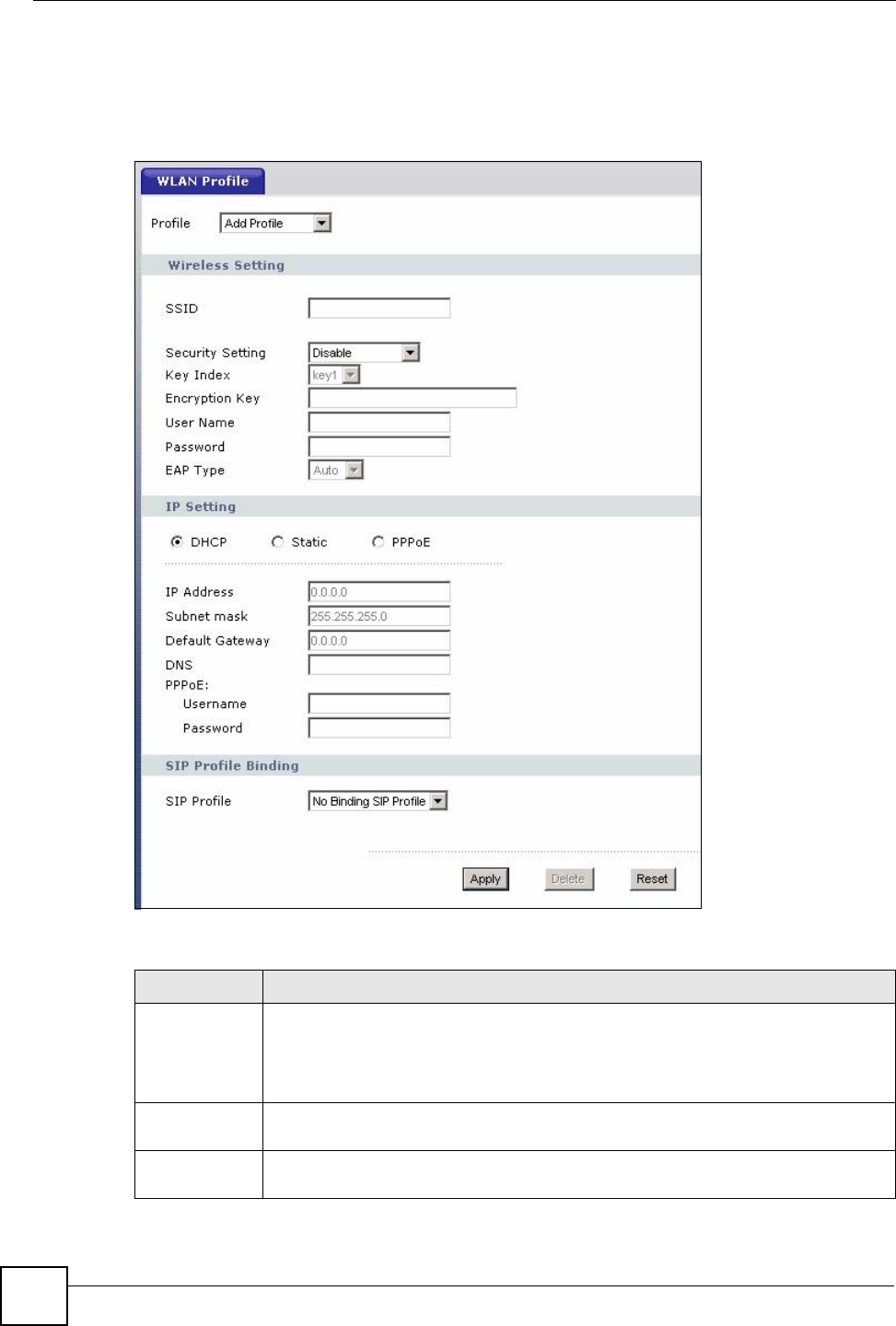
Chapter 11 WLAN Profile
V630 User’s Guide
122
11.5 WLAN Profile Screen
Click WLAN to open the following screen.
Figure 130 WLAN
The following table describes the general wireless LAN labels in this screen.
Table 100 WLAN
LABEL DESCRIPTION
Profile Select a profile of WLAN settings to edit or select Add Profile to create a new one.
Note: You cannot edit the WLAN profile that the V630 is currently
using.
SSID Enter the SSID (Service Set IDentity) of the wireless network to which you want to
connect the V630.
Security
Setting Select the type of security that the wireless network uses. Select Disable if the
wireless network does not use security.

Chapter 11 WLAN Profile
V630 User’s Guide 123
Key Index Select a default WEP key to use for data encryption. The key displays in the adjacent
field.
Encryption Key Enter the WEP key in the field provided.
If you select 64 Bits in the WEP field.
Enter either 10 hexadecimal digits in the range of “A-F”, “a-f” and “0-9” (for
example, 11AA22BB33) for HEX key type.
or
Enter 5 ASCII characters (case sensitive) ranging from “a-z”, “A-Z” and “0-9” (for
example, MyKey) for ASCII key type.
If you select 128 Bits in the WEP field,
Enter either 26 hexadecimal digits in the range of “A-F”, “a-f” and “0-9” (for
example, 00112233445566778899AABBCC) for HEX key type
or
Enter 13 ASCII characters (case sensitive) ranging from “a-z”, “A-Z” and “0-9” (for
example, MyKey12345678) for ASCII key type.
Note: The values for the WEP keys must be set up exactly the same
on all wireless devices in the same wireless LAN. ASCII WEP
keys are case sensitive.
User Name When using WPA or WPA2, enter your user name here.
Password When using WPA or WPA2, enter your password here.
EAP Type When using WPA-EAP or WPA2-EAP, select the type of EAP authentication that the
wireless network uses (or select Auto).
IP Setting Select DHCP if you do not have a fixed IP address to use.
Select Static if you were given a fixed IP address information to use. Then fill in the
IP Address, Subnet Mask, Default Gateway and DNS fields.
Select PPPoE if the V630 needs to use a PPPoE account. You will also need a
PPPoE user name and password to use this.
IP Address If you set the IP Setting to Static, enter the V630’s IP address here.
Subnet Mask If you set the IP Setting to Static, enter the V630’s subnet mask here.
Default
Gateway If you set the IP Setting to Static, enter the IP address of the default gateway here.
The default gateway is the device on the network that your V630 uses to access
other networks (like the Internet).
DNS If you set the IP Setting to Static, enter the DNS (Domain Name System) server
your V630 uses here.
PPPoE
Username If you set the IP Setting to PPPoE, enter the user name for the PPPoE account
here.
Password If you set the IP Setting to PPPoE, enter the password for the PPPoE account here.
SIP Profile Select the profile of SIP settings to use with this WLAN profile.
Apply Click Apply to save your changes back to the V630.
Delete Click Delete to remove the profile.
Reset Click Reset to return the screen to the most recently saved settings.
Table 100 WLAN
LABEL DESCRIPTION

Chapter 11 WLAN Profile
V630 User’s Guide
124
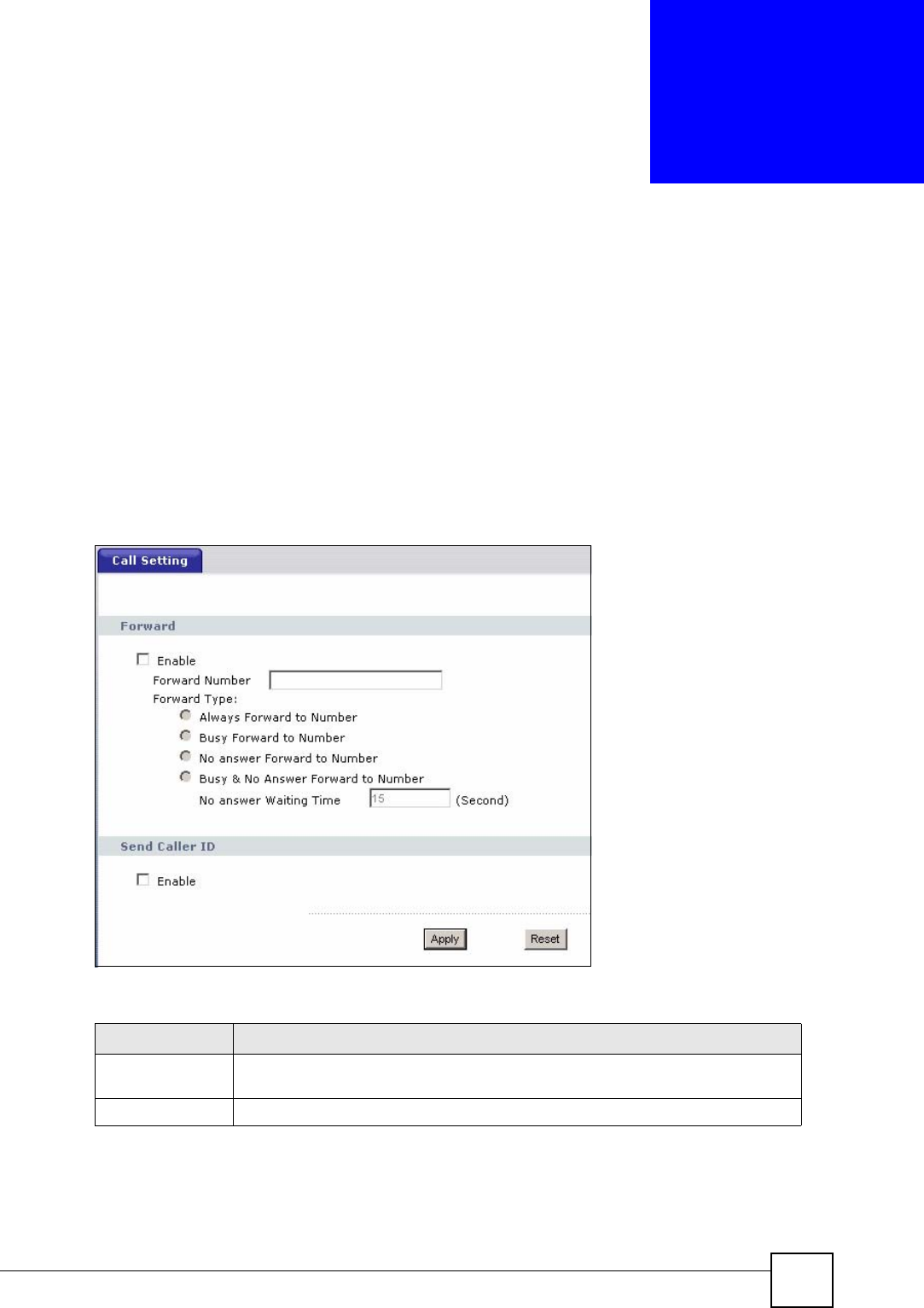
V630 User’s Guide 125
CHAPTER 12
Call Setting
This chapter discusses the Call Setting screen.
12.1 Call Setting Screen
Click Call Setting to display the following screen. Use this screen to configure call
forwarding for incoming calls and caller ID.
Figure 131 Call Setting
The following table describes the labels in this screen.
Table 101 Call Setting
LABEL DESCRIPTION
Enable Select this check box to turn on call forwarding. This setting applies to all call
forwarding on the V630.
Forward Number Specify the phone number to which the V630 should forward incoming calls.

Chapter 12 Call Setting
V630 User’s Guide
126
Forward Type Select Always Forward to Number to forward all calls to the specified number
(regardless of whether or not your line is busy).
Select Busy Forward to Number to forward calls when your line is busy.
Select No Answer Forward to Number to forward calls when you do not answer
the phone. You will be able to specify how long the V630 waits before forwarding
an unanswered call.
Select Busy & No Answer Forward to Number to forward calls when your line is
busy or you do not answer the phone. Specify how long the V630 waits before
forwarding an unanswered call.
Send Caller ID Select this to have the V630 send your phone number to the phones you call.
Apply Click Apply to save your changes back to the V630.
Reset Click Reset to return the screen to the most recently saved settings.
Table 101 Call Setting
LABEL DESCRIPTION
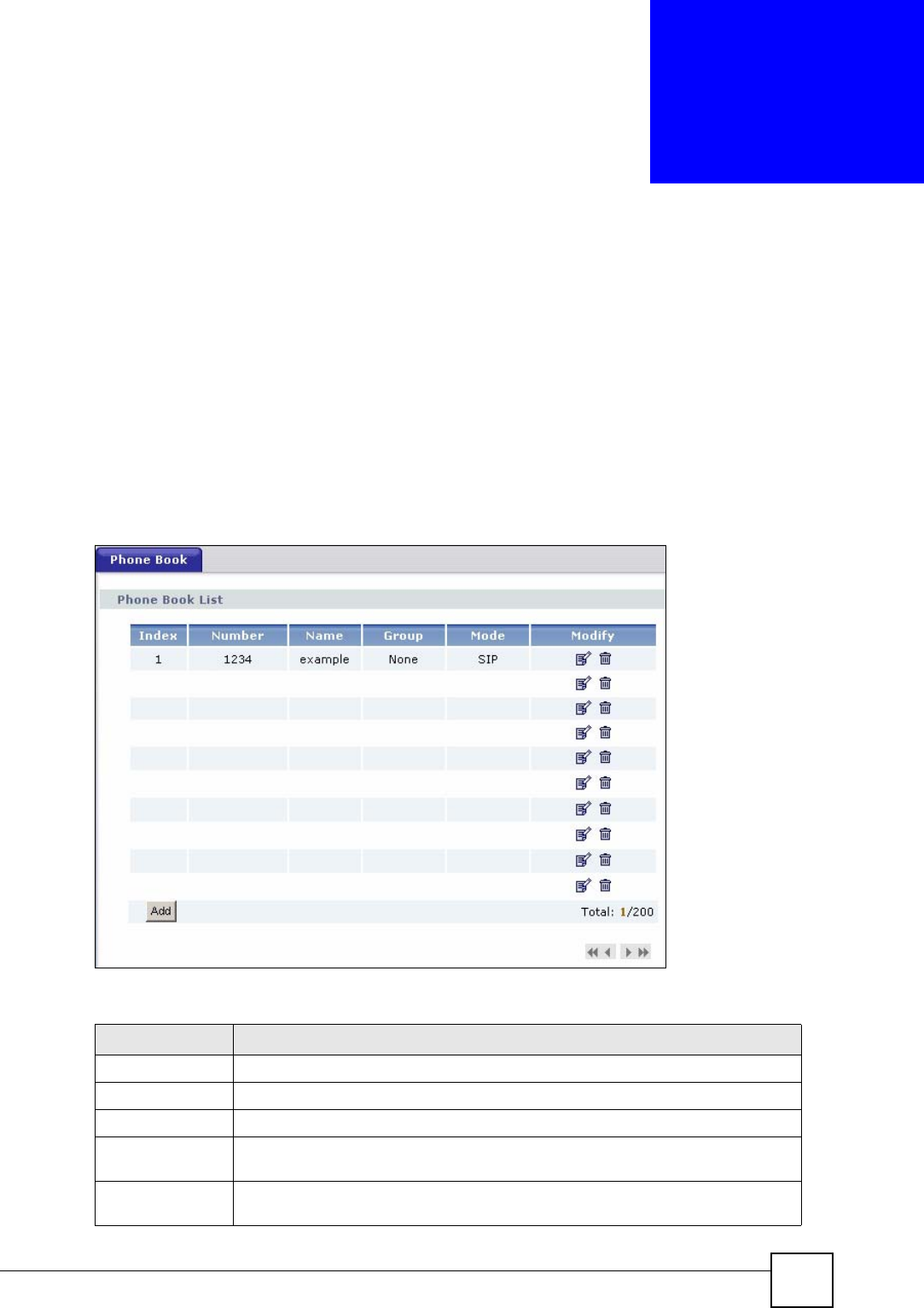
V630 User’s Guide 127
CHAPTER 13
Phone Book
This chapter discusses the Phone Book screens.
13.1 Phone Book Screen
Use this screen to manage your phone book list of contacts. Click Phone Book to open the
following screen.
Figure 132 Phone Book
The following table describes the labels in this screen.
Table 102 Phone Book
LABEL DESCRIPTION
Index This shows the index number of the contact’s entry.
Number This is the contact’s phone number.
Name This is the contact’s name.
Group This is the group to which the contact belongs (if any). You can use the LCD
menus to assign a different ring for incoming calls from each group.
Mode This shows whether you use a SIP server to call the contact or a direct peer-to-
peer call.
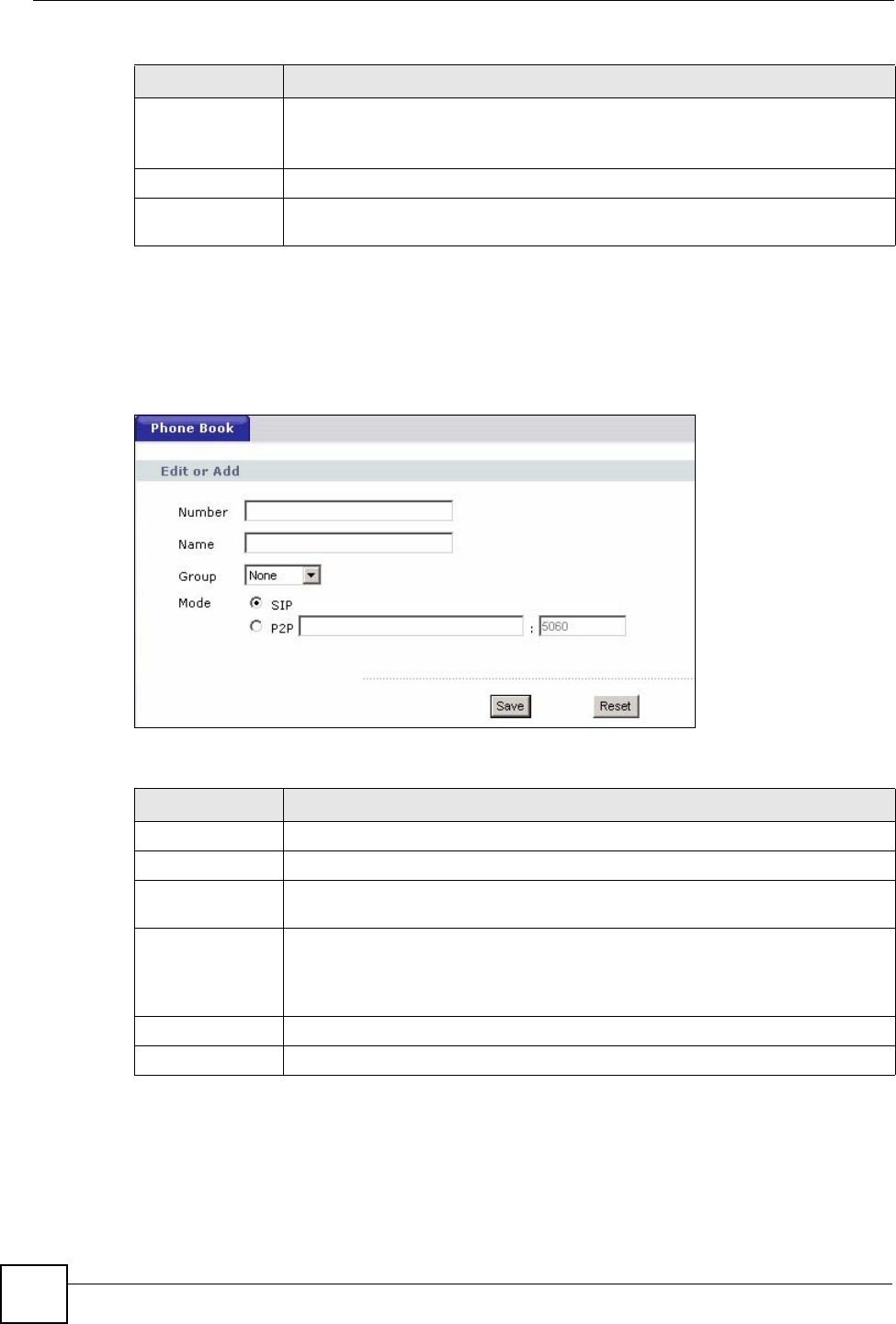
Chapter 13 Phone Book
V630 User’s Guide
128
13.1.1 Phone Book Add or Edit Screen
Use this screen to add or edit phone book entries. Click Phone Book. The following screen
displays.
Figure 133 Phone Book > Add
The following table describes the labels in this screen.
Modify Click the Edit icon to change this entry’s details.
Click the Remove icon to delete the entry from the phonebook. If you do this, the
information cannot be recovered.
Add Click this to create a new phone book entry.
Total This shows how many phone book entries the V630 has out of its total possible
number of entries. Use the navigation arrows to go to other pages of entries.
Table 102 Phone Book (continued)
LABEL DESCRIPTION
Table 103 Phone Book > Add
LABEL DESCRIPTION
Number Enter the contact’s phone number.
Name Enter the contact’s name.
Group Select the group to which the contact should belong (if any). You can use the LCD
menus to assign a different ring for incoming calls from each group.
Mode Select SIP if you will use a SIP server to call the contact.
Select P2P if you will make a direct peer-to-peer call to the contact. For P2P you
must also enter the callee’s IP address. Enter the callee’s SIP port number if it is
different from the default of 5060.
Save Click Save to save your changes back to the V630.
Reset Click Reset to return the screen to the most recently saved settings.

V630 User’s Guide 129
CHAPTER 14
SIP Account Setup
This chapter discusses the V630’s VoIP > SIP screens.
14.1 Introduction to VoIP
VoIP (Voice over IP) is the sending of voice signals over the Internet Protocol. This allows you
to make phone calls and send faxes over the Internet at a fraction of the cost of using the
traditional circuit-switched telephone network. You can also use servers to run telephone
service applications like PBX services and voice mail. Internet Telephony Service Provider
(ITSP) companies provide VoIP service. A company could alternatively set up an IP-PBX and
provide its own VoIP service.
Circuit-switched telephone networks require 64 kilobits per second (kbps) in each direction to
handle a telephone call. VoIP can use advanced voice coding techniques with compression to
reduce the required bandwidth.
14.1.1 Introduction to SIP
The Session Initiation Protocol (SIP) is an application-layer control (signaling) protocol that
handles the setting up, altering and tearing down of voice and multimedia sessions over the
Internet.
SIP signaling is separate from the media for which it handles sessions. The media that is
exchanged during the session can use a different path from that of the signaling. SIP handles
telephone calls and can interface with traditional circuit-switched telephone networks.
14.1.2 SIP Identities
A SIP account uses an identity (sometimes referred to as a SIP address). A complete SIP
identity is called a SIP URI (Uniform Resource Identifier). A SIP account's URI identifies the
SIP account in a way similar to the way an e-mail address identifies an e-mail account. The
format of a SIP identity is SIP-Number@SIP-Service-Domain.
14.1.2.1 SIP Number
The SIP number is the part of the SIP URI that comes before the “@” symbol. A SIP number
can use letters like in an e-mail address (johndoe@your-ITSP.com for example) or numbers
like a telephone number (1122334455@VoIP-provider.com for example).

Chapter 14 SIP Account Setup
V630 User’s Guide
130
14.1.2.2 SIP Service Domain
The SIP service domain of the VoIP service provider (the company that lets you make phone
calls over the Internet) is the domain name in a SIP URI. For example, if the SIP address is
1122334455@VoIP-provider.com, then “VoIP-provider.com” is the SIP service domain.
14.1.3 SIP Call Progression
The following figure displays the basic steps in the setup and tear down of a SIP call. A calls
B.
1A sends a SIP INVITE request to B. This message is an invitation for B to participate in
a SIP telephone call.
2B sends a response indicating that the telephone is ringing.
3B sends an OK response after the call is answered.
4A then sends an ACK message to acknowledge that B has answered the call.
5Now A and B exchange voice media (talk).
6After talking, A hangs up and sends a BYE request.
7B replies with an OK response confirming receipt of the BYE request and the call is
terminated.
14.1.4 SIP Client Server
SIP is a client-server protocol. A SIP client is an application program or device that sends SIP
requests. A SIP server responds to the SIP requests.
When you use SIP to make a VoIP call, it originates at a client and terminates at a server. A
SIP client could be a computer or a SIP phone. One device can act as both a SIP client and a
SIP server.
14.1.4.1 SIP User Agent
A SIP user agent can make and receive VoIP telephone calls. This means that SIP can be used
for peer-to-peer communications even though it is a client-server protocol. In the following
figure, either A or B can act as a SIP user agent client to initiate a call. A and B can also both
act as a SIP user agent to receive the call.
Table 104 SIP Call Progression
A B
1. INVITE
2. Ringing
3. OK
4. ACK
5.Dialogue (voice traffic)
6. BYE
7. OK
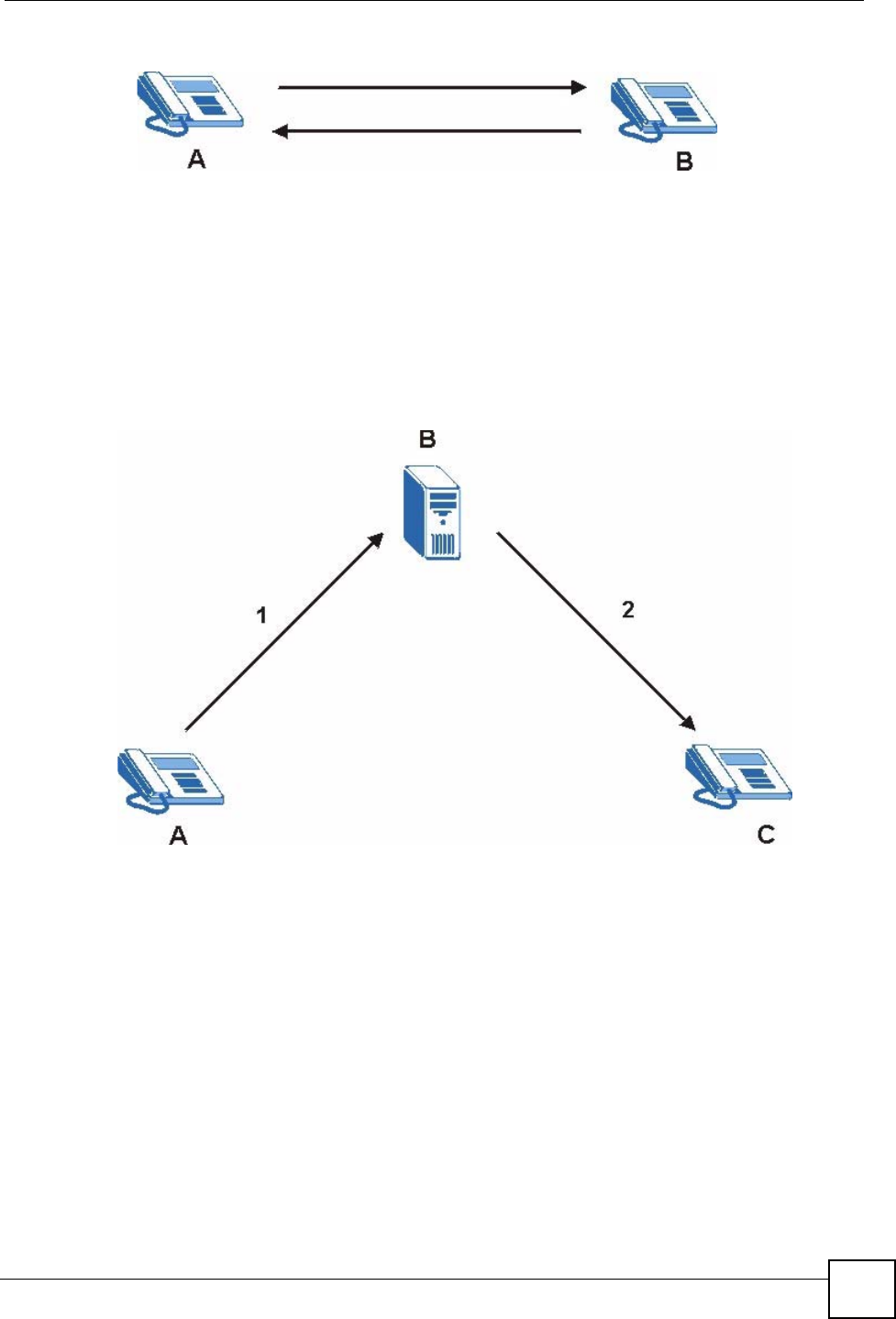
Chapter 14 SIP Account Setup
V630 User’s Guide 131
Figure 134 SIP User Agent
14.1.4.2 SIP Proxy Server
A SIP proxy server receives requests from clients and forwards them to another server.
In the following example, you want to use client device A to call someone who is using client
device C.
1The client device (A in the figure) sends a call invitation to the SIP proxy server (B).
2The SIP proxy server forwards the call invitation to C.
Figure 135 SIP Proxy Server
14.1.4.3 SIP Redirect Server
A SIP redirect server accepts SIP requests, translates the destination address to an IP address
and sends the translated IP address back to the device that sent the request. Then the client
device that originally sent the request can send requests to the IP address that it received back
from the redirect server. Redirect servers do not initiate SIP requests.
In the following example, you want to use client device A to call someone who is using client
device C.
1Client device A sends a call invitation for C to the SIP redirect server (B).
2The SIP redirect server sends the invitation back to A with C’s IP address (or domain
name).
3Client device A then sends the call invitation to client device C.
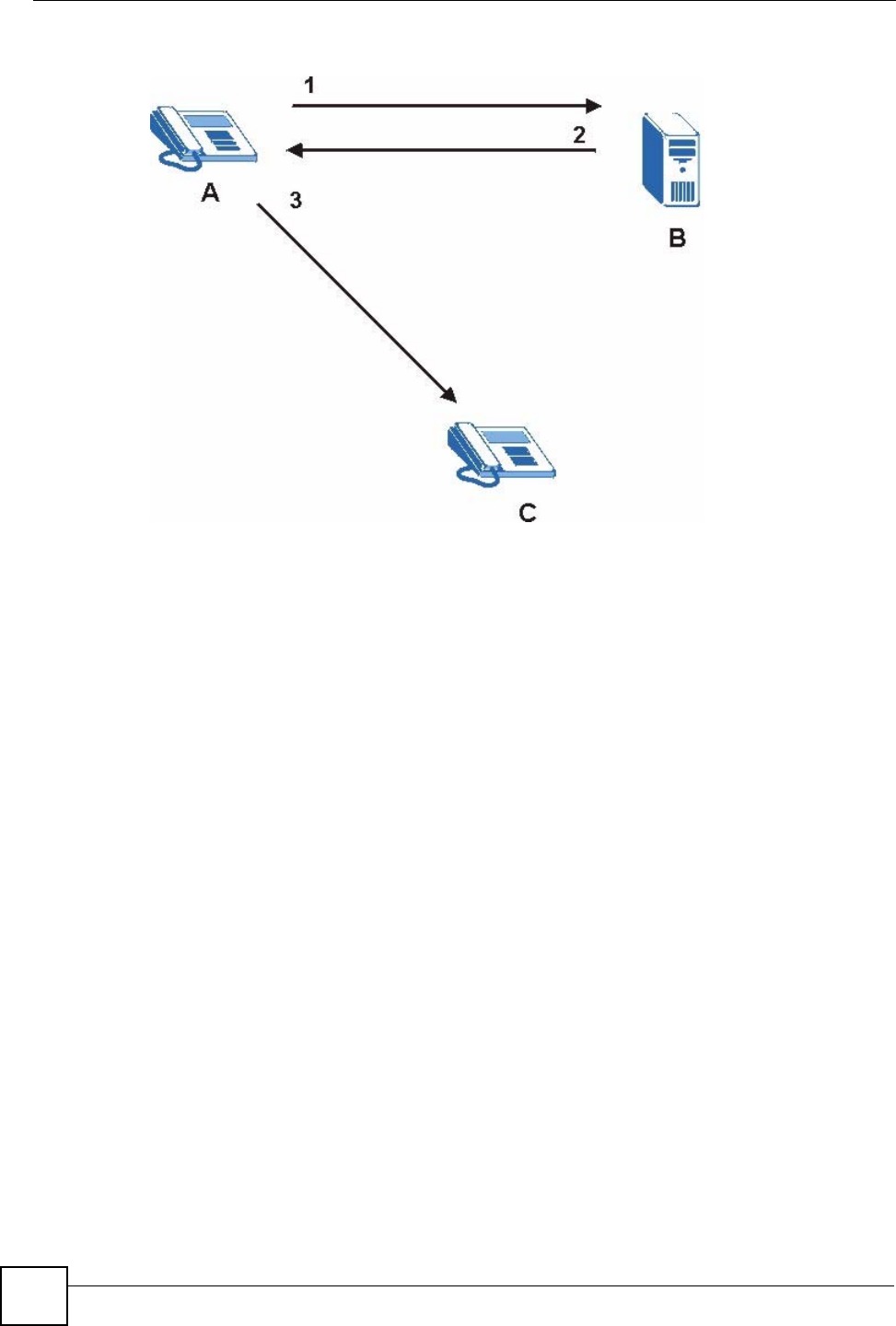
Chapter 14 SIP Account Setup
V630 User’s Guide
132
Figure 136 SIP Redirect Server
14.1.4.4 SIP Register Server
A SIP register server (also known as a registrar server) maintains a database of SIP identity-to-
IP address (or domain name) mapping. The register server checks your user name and
password when you register.
14.1.5 RTP
When you make a VoIP call using SIP, the RTP (Real time Transport Protocol) is used to
handle voice data transfer. See RFC 1889 for details on RTP.
14.1.6 NAT and SIP
NAT (Network Address Translation - NAT, RFC 1631) is the translation of the IP address of a
host in a packet, for example, the source address of an outgoing packet, used within one
network to a different IP address known within another network.
The V630 must register its public IP address with a SIP register server. If there is a NAT router
between the V630 and the SIP register server, the V630 probably has a private IP address. The
V630 lists its IP address in the SIP message that it sends to the SIP register server. NAT does
not translate this IP address in the SIP message. The SIP register server gets the V630’s IP
address from inside the SIP message and maps it to your SIP identity. If the V630 has a private
IP address listed in the SIP message, the SIP server cannot map it to your SIP identity.
Use STUN or outbound proxy to allow the V630 to list its public IP address in the SIP
messages.
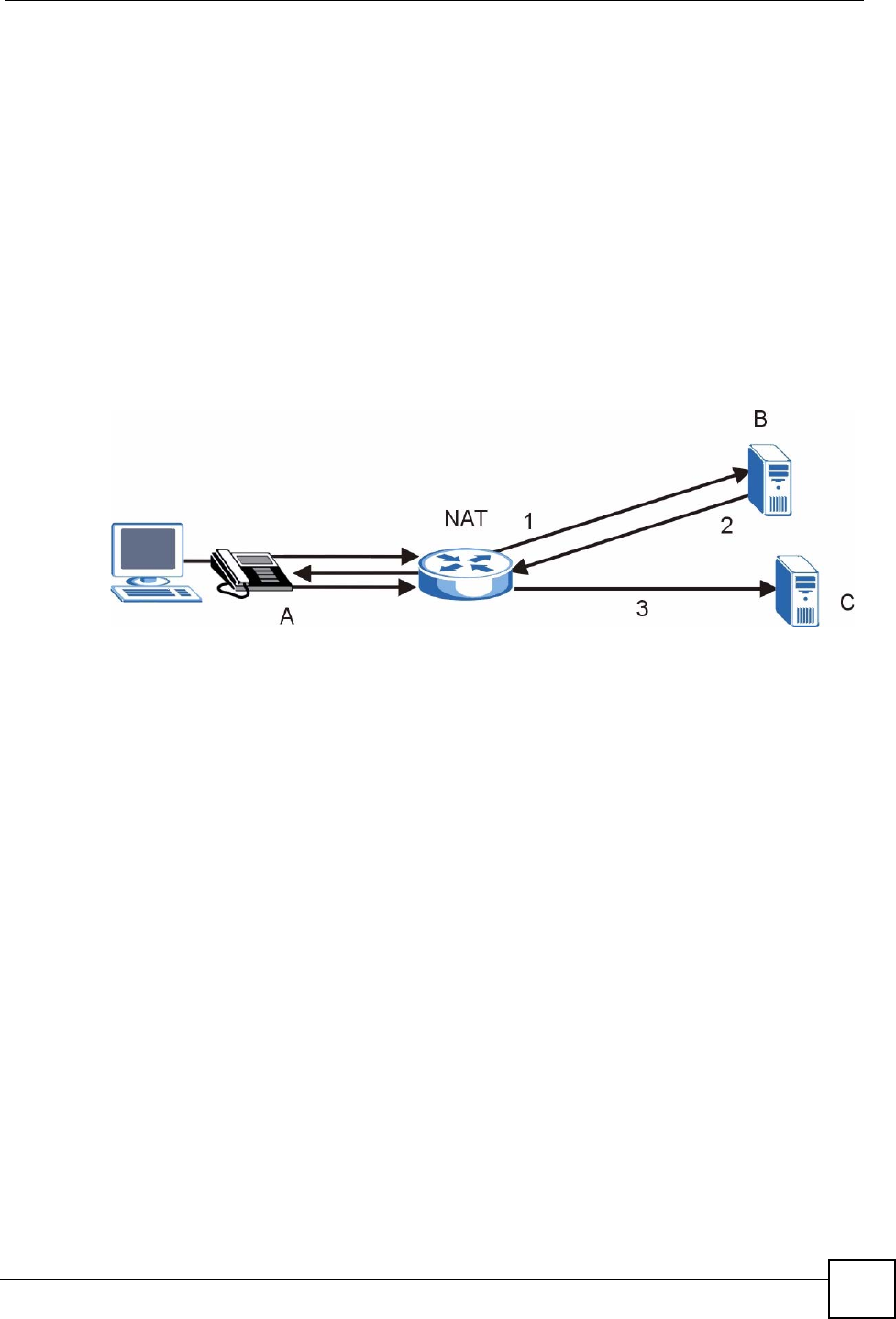
Chapter 14 SIP Account Setup
V630 User’s Guide 133
14.1.6.1 STUN
STUN (Simple Traversal of User Datagram Protocol (UDP) through Network Address
Translators) allows the V630 to find the presence and types of NAT routers and/or firewalls
between it and the public Internet. STUN also allows the V630 to find the public IP address
that NAT assigned, so the V630 can embed it in the SIP data stream. STUN does not work
with symmetric NAT routers or firewalls. See RFC 3489 for details on STUN.
The following figure shows how STUN works.
1The V630 (A) sends SIP packets to the STUN server (B).
2The STUN server (B) finds the public IP address and port number that the NAT router
used on the V630’s SIP packets and sends them to the V630.
3The V630 uses the public IP address and port number in the SIP packets that it sends to
the SIP server (C).
Figure 137 STUN
14.1.6.2 Outbound Proxy
Your VoIP service provider may host a SIP outbound proxy server to handle all of the V630’s
VoIP traffic. This allows the V630 to work with any type of NAT router and eliminates the
need for STUN or a SIP ALG. Turn off a SIP ALG on a NAT router in front of the V630 to
keep it from retranslating the IP address (since this is already handled by the outbound proxy
server).
14.1.7 Voice Coding
A codec (coder/decoder) codes analog voice signals into digital signals and decodes the digital
signals back into voice signals. The V630 supports the following codecs.
•G.711 is a Pulse Code Modulation (PCM) waveform codec. PCM measures analog signal
amplitudes at regular time intervals (sampling) and converts them into digital bits
(quantization). Quantization “reads” the analog signal and then “writes” it to the nearest
digital value. For this reason, a digital sample is usually slightly different from its analog
original (this difference is known as “quantization noise”).
•G.726 is an ADPCM waveform codec that uses a lower bit rate than standard PCM
conversion. G.726 operates at 16, 24, 32 or 40 kbps.
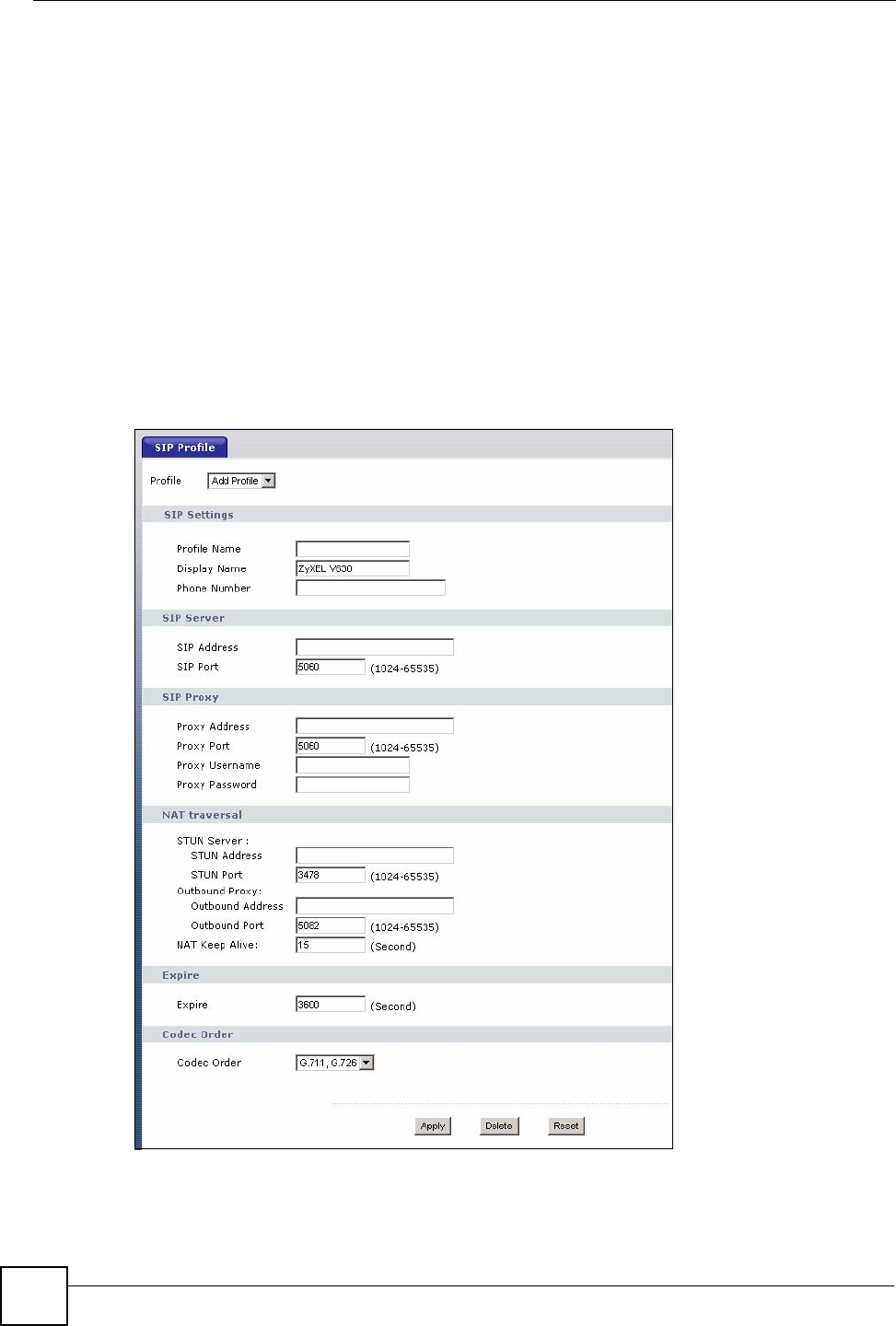
Chapter 14 SIP Account Setup
V630 User’s Guide
134
•G.729 is an Analysis-by-Synthesis (AbS) hybrid waveform codec that uses a filter based
on information about how the human vocal tract produces sounds. The codec analyzes the
incoming voice signal and attempts to synthesize it using its list of voice elements. It tests
the synthesized signal against the original and, if it is acceptable, transmits details of the
voice elements it used to make the synthesis. Because the codec at the receiving end has
the same list, it can exactly recreate the synthesized audio signal. G.729 provides good
sound quality and reduces the required bandwidth to 8kbps.
14.2 SIP Settings Screen
Click SIP to open the following screen. Use this screen to maintain basic information about
each SIP account. Your VoIP service provider (the company that lets you make phone calls
over the Internet) should provide this.
Figure 138 SIP

Chapter 14 SIP Account Setup
V630 User’s Guide 135
Each field is described in the following table.
Table 105 SIP
LABEL DESCRIPTION
Profile Select a profile of SIP settings to edit or select Add Profile to create a new one.
SIP Settings
Profile Name Specify the name to use for the SIP account within the V630.
Display Name Specify the profile name that you want to display on the LCD main screen when
the SIP account is registered.
Active Select this if you want the V630 to use this account. Clear it if you do not want the
V630 to use this account.
Phone
Number Enter your SIP number. In the full SIP URI, this is the part before the @ symbol.
You can use up to 50 printable English keyboard characters.
SIP Server
SIP Address Enter the IP address or domain name of the SIP server provided by your VoIP
service provider. You can use up to 32 printable English keyboard characters. It
does not matter whether the SIP server is a proxy, redirect or register server.
SIP Port Enter the SIP server’s listening port number, if your VoIP service provider gave
you one. Otherwise, keep the default value.
SIP Proxy
Proxy Address If the VoIP service provider provided a SIP proxy server address, select this to
configure it. If you have more than one server’s address, use this menu to enter
the registrar server’s address.
Proxy Port If the VoIP service provider provided a port number other than 5060, select this to
configure it.
Proxy
Username Enter the user name for registering this SIP account, exactly as it was given to
you.
Proxy
Password Enter the user name for registering this SIP account, exactly as it was given to
you.
NAT traversal NAT traversal deals with problems SIP has going through NAT.
STUN Server Configure the STUN server fields if all of the following conditions are satisfied.
• There is a NAT router between the V630 and the SIP server.
• The NAT router is not a SIP ALG.
• Your VoIP service provider gave you an IP address or domain name for a
STUN server.
STUN
Address Enter the IP address or domain name of the STUN server provided by your VoIP
service provider.
STUN Port Enter the STUN server’s listening port, if your VoIP service provider gave you one.
Otherwise, keep the default value.
Outbound Proxy Configure the outbound proxy fields if your service provider has a SIP outbound
server to handle voice calls. This allows the V630 to work with any type of NAT
router and eliminates the need for STUN or a SIP ALG. Turn off any SIP ALG on a
NAT router in front of the V630 to keep it from retranslating the IP address (since
this is already handled by the outbound proxy server.
Outbound
address Enter the IP address or domain name of the SIP outbound proxy server.
Outbound Port Enter the outbound proxy server’s listening port, if your VoIP service provider gave
you one. Otherwise, keep the default value.

Chapter 14 SIP Account Setup
V630 User’s Guide
136
NAT Keep Alive Use NAT keep alive to stop NAT routers between the V630 and SIP server (a SIP
proxy server or outbound proxy server) from dropping the SIP session. The V630
does this by sending SIP notify messages to the SIP server based on the specified
interval.
Enter how often (in seconds) the V630 should send SIP notify messages to the
SIP server.
Expire Enter the number of seconds your SIP account is registered with the SIP register
server before it is deleted. The V630 automatically tries to re-register your SIP
account when one-half of this time has passed. (The SIP register server might
have a different expiration.)
Codec Order Select the type of voice coder/decoder (codec) that you want the V630 to attempt
to use first.
•G.711 provides high voice quality but requires more bandwidth (64 kbps).
•G.726 operates at 16, 24, 32 or 40 kbps.
•G.729 operates at 8 kbps.
The V630 must use the same codec as the peer. When two SIP devices start a
SIP session, they must agree on a codec.
Apply Click Apply to save your changes back to the V630.
Delete Click Delete to remove the profile.
Reset Click Reset to return the screen to the most recently saved settings.
Table 105 SIP
LABEL DESCRIPTION
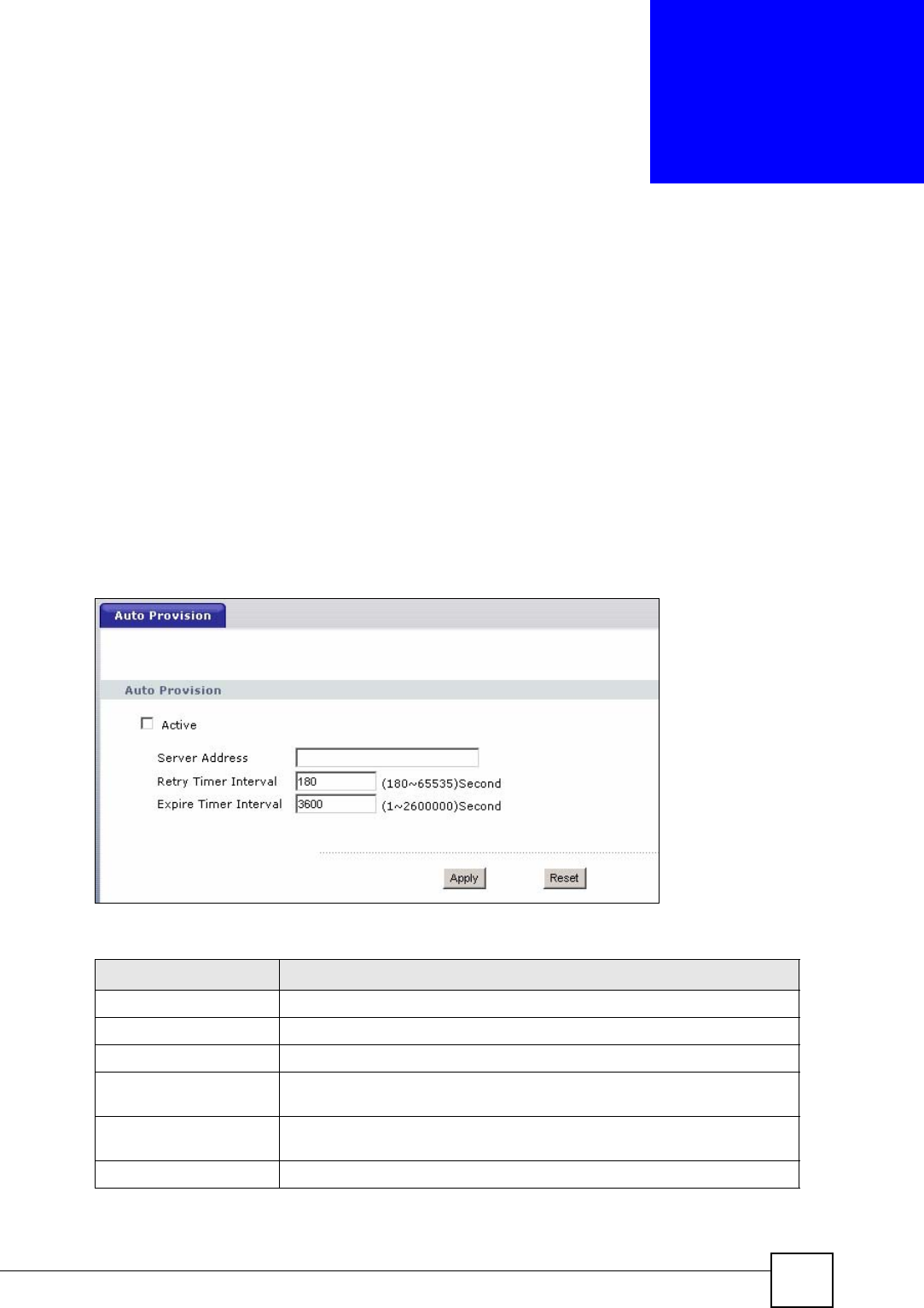
V630 User’s Guide 137
CHAPTER 15
Auto Provision
Use the Auto Provision screen to set the V630 to use an auto-provisioning server.
15.1 Auto Provision Screen
Click Auto Provision to open the following screen.
If there is an auto-provisioning server on the network, use this screen to configure the V630 to
use it. When auto-provisioning is used, the V630 downloads SIP settings automatically from
the auto-provisioning server, meaning you do not have to input them manually.
Figure 139 Auto Provision
The following table describes the labels in this screen.
Table 106 Auto Provision
LABEL DESCRIPTION
Active Select this to set the V630 to request and receive auto-provisioning files.
Server Address Enter the auto provisioning server’s IP address.
Port Enter the auto-provisioning server’s port number.
Retry Timer Interval Select this to see or edit how long the V630 waits, if it requests an auto-
provisioning file but does not receive one, before requesting the file again.
Expire Timer Interval Select this to see or edit how long the V630 waits after it successfully
receives an auto-provisioning file before it requests another.
Select Press this to choose the highlighted entry in the menu.

Chapter 15 Auto Provision
V630 User’s Guide
138
Apply Click Apply to save your changes back to the V630.
Reset Click Reset to return the screen to the most recently saved settings.
Table 106 Auto Provision
LABEL DESCRIPTION

140
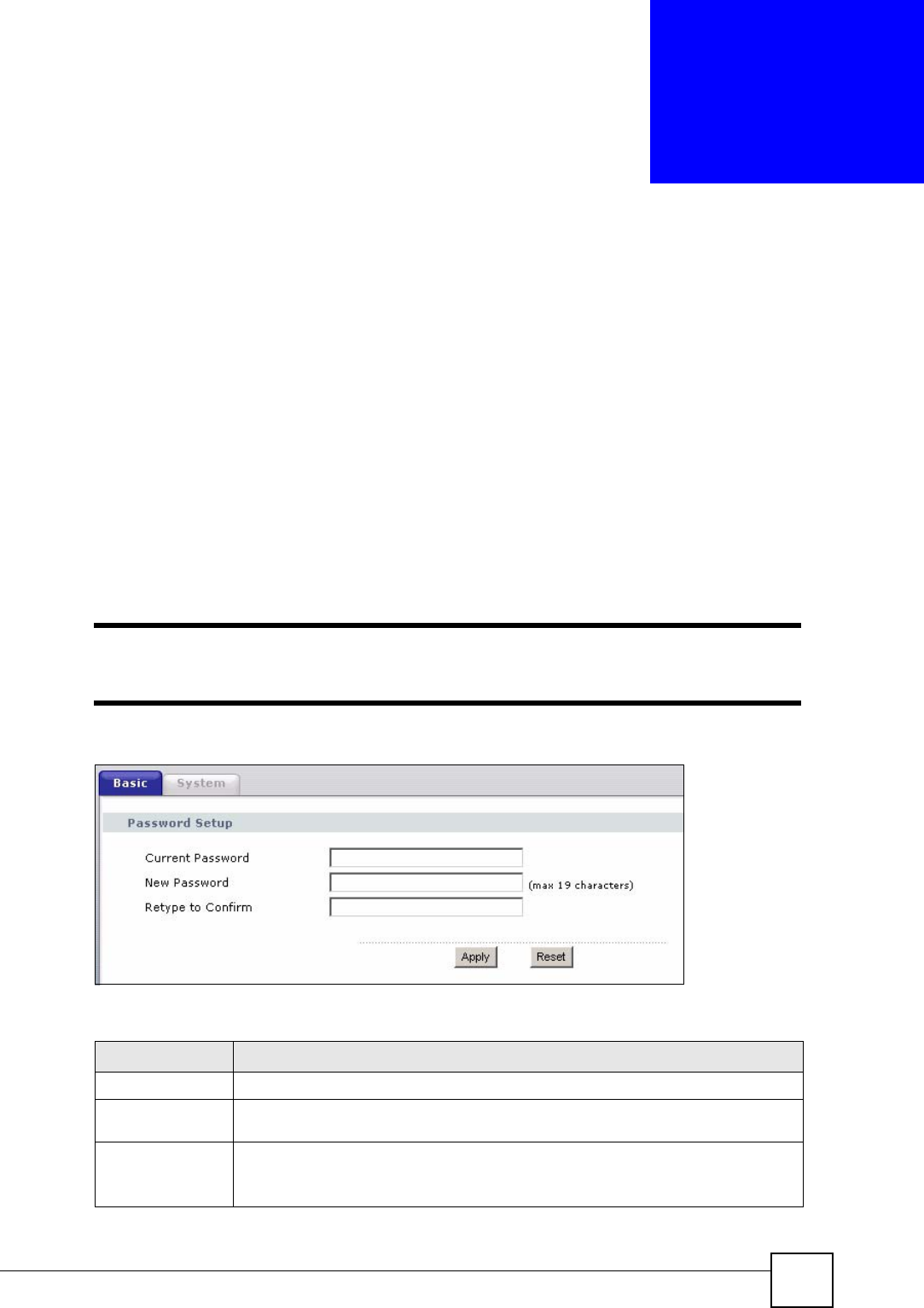
V630 User’s Guide 141
CHAPTER 16
System
Use the System screens to change the V630’s passwords, display information, or upload
firmware.
16.1 Password Screen
Click System > Change Password to open the following screen. Use this screen to change the
web configurator login password.
• Use the Basic tab to configure the user login password.
• Use the System tab to configure the administrator login password.
"If you forget your password you will need to reset the device. See your Quick
Start Guide for details.
Figure 140 System > Change Password
The following table describes the labels in this screen.
Table 107 System > Password
LABEL DESCRIPTION
Password Setup
Current
Password Type in the existing password (“1234” is the default password).
New
Password Type the new password.
Note that as you type a password, the screen displays an asterisk (*) for each
character you type.
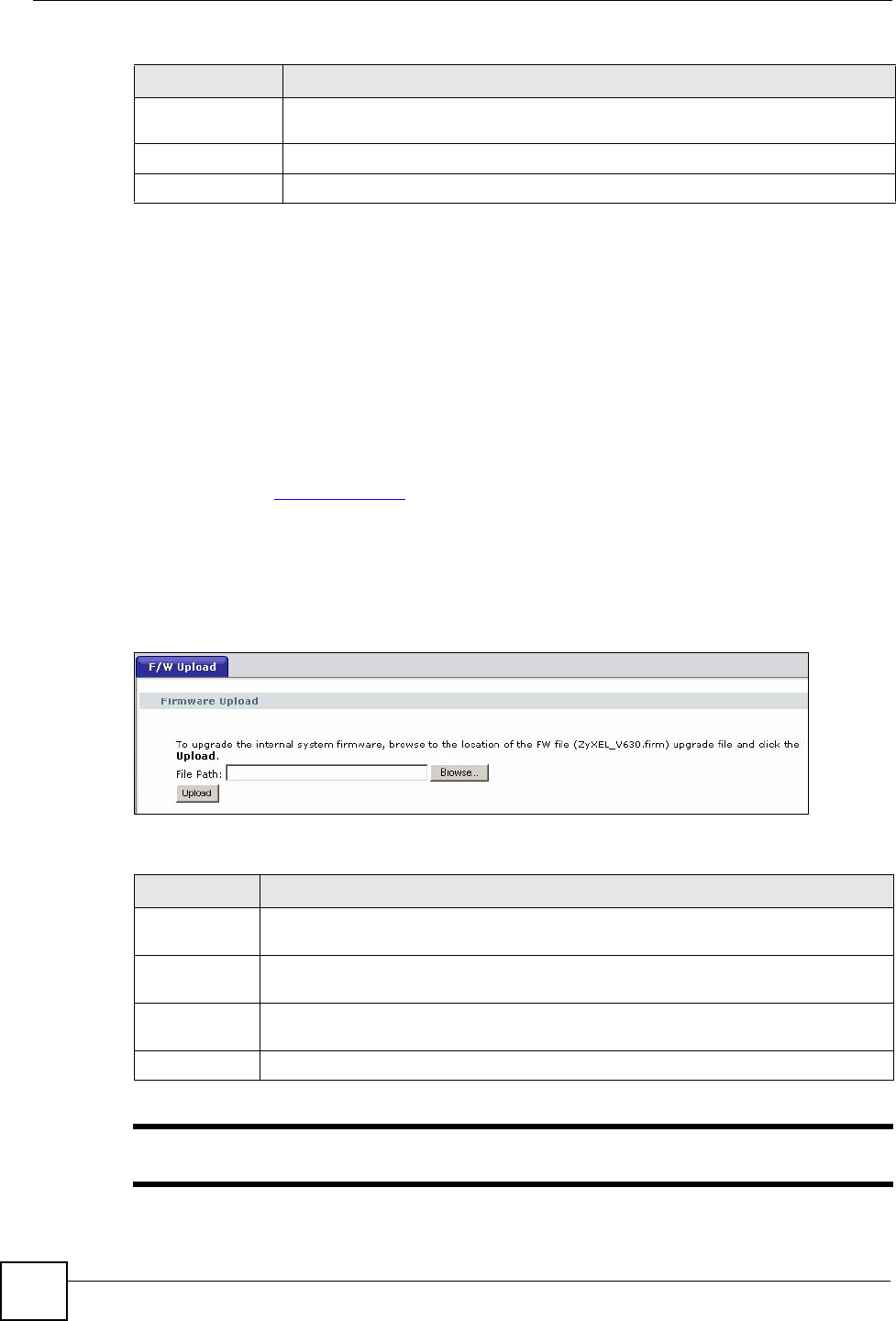
Chapter 16 System
V630 User’s Guide
142
16.2 Information Screen
Use the System > Information screen to see the current status of the V630, its system
resources, and current TCP/IP, WLAN, and SIP settings. See Chapter 10 on page 117 for
details.
16.3 Firmware Upload Screen
Find firmware at www.zyxel.com in a file that (usually) uses the system model name with a
"*.bin" extension, e.g., "V630.bin". The upload process uses HTTP (Hypertext Transfer
Protocol) and may take up to two minutes. After a successful upload, the system will reboot.
Click System > Upgrade FW. Follow the instructions in this screen to upload firmware to
your V630.
Figure 141 System > Upgrade FW
The following table describes the labels in this screen.
"Do not turn off the V630 while firmware upload is in progress!
Retype to
Confirm Retype your new system password for confirmation.
Apply Click this to save your changes back to the device.
Reset Click this to return the screen to the most recently saved settings.
Table 107 System > Password (continued)
LABEL DESCRIPTION
Table 108 System > Upgrade FW
LABEL DESCRIPTION
Firmware
Upload
File Path Type in the location of the file you want to upload in this field or click Browse... to find
it.
Browse... Click Browse... to find the .bin file you want to upload. Remember that you must
decompress compressed (.zip) files before you can upload them.
Upload Click Upload to begin the upload process. This process may take up to two minutes.

Chapter 16 System
V630 User’s Guide 143
Wait two minutes before logging into the V630 again. The V630 automatically restarts. After
two minutes, log in again and check your new firmware version in the System > Information
screen.

Chapter 16 System
V630 User’s Guide
144

V630 User’s Guide 145
CHAPTER 17
Troubleshooting
This chapter offers some suggestions to solve problems you might encounter. The potential
problems are divided into the following categories.
•Power, Hardware Connections, and LEDs
•V630 Web Configurator Access and Login
•Phone Calls
17.1 Power, Hardware Connections, and LEDs
VThe V630 does not turn on.
1Make sure you have the battery installed and charged.
2If you need to charge the battery make sure the appropriate power adaptor or cord is
connected to the V630 and plugged in to an appropriate power source. Make sure the
power source is turned on.
3If charging does not help, remove the battery and reinstall it. Make sure the charger/USB
cable is unplugged and remove the battery cover. Then pull the battery’s plastic tab and
lift the battery out. See the Quick Start Guide for how to install the battery.
The contacts (the metal parts) on the battery or the V630 may be dirty or corroded. Clean
them.
1Do not use liquid of any kind to clean the battery or the V630.
4If the problem continues, contact the vendor.
VA key or LED does not behave as expected.
1Make sure you understand the normal behavior of the key or LED. See the Quick Start
Guide.

Chapter 17 Troubleshooting
V630 User’s Guide
146
2Make sure the keypad is unlocked. Press # and the Left key to unlock it.
17.2 V630 Web Configurator Access and Login
VI forgot the IP address for the V630.
1Check the IP address the V630 is using in the Setup > Information > TCP/IP LCD
menu.
2Set a static IP address for the V630 in the Network > WLAN Profiles > Profiles List >
Edit > IP Setting menus (see Section 6.12 on page 75).
VI forgot the password.
1The default user password is password. The default administrator password is admin.
2If this does not work, you have to reset the device to its factory defaults. See Section
5.18 on page 59.
VI cannot see or access the Login screen in the web configurator.
1Before you can access the web configurator, you must enable it in the Menu > Setup >
Phone Setting > Web Configurator LCD menu.
2Make sure you are using the correct IP address.
• Check the IP address the V630 is using in the Setup > Information > TCP/IP LCD
menu.
• If you changed the IP address (Section 16.1 on page 141), use the new IP address.
3Check that the phone is on and connected to an AP. You should see the wireless signal
icon.
4Make sure your Internet browser does not block pop-up windows and has JavaScripts
and Java enabled. See Appendix C on page 199.
5Make sure your computer is in the same subnet as the V630. See Appendix A on page
157 and Appendix D on page 207. (If you know that there are routers between your
computer and the V630, skip this step.)
6If the problem continues, contact the network administrator or vendor.
VI can see the Login screen, but I cannot log in to the V630.

Chapter 17 Troubleshooting
V630 User’s Guide 147
1Make sure you have entered the user name and password correctly. The default password
is 1234. This field is case-sensitive, so make sure [Caps Lock] is not on.
2Close your browser session and open a new one.
You may also need to clear your Internet browser’s cache. In Internet Explorer, click
Tools and then Internet Options to open the Internet Options screen.
In the General tab, click Delete Files. In the pop-up window, select the Delete all offline
content check box and click OK. Click OK in the Internet Options screen to close it.
3Turn the phone off and on again.
17.3 Wireless LAN
VWhen I scan for an access point I can’t find one, or I can’t find the right one.
If you scan for an access point (AP) and find none, either the V630 is out of the AP’s coverage
area (out of range), or the AP is set to not broadcast its SSID (the network name). Move closer
to the AP and try again.
If the AP still does not show on the scan result, either:
• Input the ESSID manually and try to connect.
• Access the AP’s configuration interface and set it to broadcast the SSID.
If other APs display when you scan, the V630 is working correctly. However, if you know that
there are other APs in the area, and no APs display when you scan, you may have a hardware
problem. In this case, contact your vendor.
VI can’t connect to the access point.
If you find the AP when you scan, but you cannot connect to it, there may be a problem with
the wireless security settings.
• Ensure that the V630 supports the security standard the AP uses.
• Ensure that the V630 and the AP use exactly the same settings.
• If you continue to experience difficulties, set the AP to use no security (disconnect it from
the network first) and try to connect.
• If you have another wireless client (a notebook wireless card, for example) try using it to
connect. If it connects successfully, your V630 may have a hardware problem. Contact
your vendor. If the other wireless client does not connect successfully, the AP may be
malfunctioning or misconfigured.

Chapter 17 Troubleshooting
V630 User’s Guide
148
17.4 Phone Calls
VI cannot make calls.
Ensure that your V630 is set up as shown in your Quick Start Guide.
Look at the LCD screen. You should see the signal strength icon.If a SIP account is registered,
the name of its profile appears in the main screen. If a SIP account is not registered, No SIP
Service displays.
If no SIP account is registered, do the following.
1The V630’s SIP settings may be misconfigured. Check your SIP settings and re-enter
them if necessary (see Section 6.24 on page 83 for details).
2If No SIP Service still displays, check your network settings (see Section 6.7 on page
72). If they are not correct, change them using information supplied by your ISP or
network administrator. If this does not help, contact your ISP or network administrator.
If a SIP account is registered, try to make a call. If you still cannot call out, do the following.
1Check your DNS (Domain Name Service) settings (see Section 5.27 on page 64).
• If you use a static IP address, see Section 6.13 on page 76 for how to change DNS
settings.
• If you use a dynamic IP address (DHCP) your DNS settings are controlled by the
DHCP server. The DHCP server may belong to your service provider, or it may be on
your network. If your V630 does not get DNS server information automatically, check
the settings on the AP to which the V630 is connected, or contact your ISP or network
administrator.
• If you use PPPoE, your DNS settings are controlled by your Internet Service Provider.
If your V630 does not get DNS server information automatically, contact your ISP.
2Make sure that your V630 uses the voice codecs that the callee’s device supports.
VI can make some calls, but not others.
The V630’s DNS (Domain Name Service) settings may be misconfigured. See the suggestions
about DNS in the troubleshooting section for “I cannot make calls.”.
If this does not help, the phone of the person you are calling may be malfunctioning or
misconfigured.
VMy phone service works for a while and then cuts off and the V630 has to re-
register.

Chapter 17 Troubleshooting
V630 User’s Guide 149
The SIP server’s expiration time is how long an entry remains registered with the SIP server.
After the time period expires, the SIP register server deletes the V630’s entry from the
database of registered SIP numbers. Different register servers may use different time periods.
You may need to configure a shorter time in the Expire menu. See Section 6.43 on page 94.
VI can make phone calls, but I cannot receive them.
Check your V630’s call forwarding settings (see Section 5.19 on page 60). If they are
misconfigured, certain calls may be mistakenly forwarded.
VMy calls are of poor audio quality.
1The Wireless LAN signal may be weak. Move closer to the access point, and away from
potential sources of radio interference (such as microwave ovens, electric motors and
other radio frequency emitting devices). If you have more than one access point, scan for
and connect to the one with the stronger signal.
2If your V630 is connected to a router with configurable bandwidth management settings,
check these settings. Consult the router’s documentation for more information.
3Your V630 may be set to use a voice codec (audio coder / decoder) that does not provide
optimal sound quality. See Section 6.44 on page 95 and check with your VoIP service
provider to find out the codecs you should use.
4Your VoIP service provider may be using settings that reduce voice quality in order to
conserve bandwidth. You may need to subscribe to a different calling plan to get better
call quality.
5The VoIP service’s channels may all be full. Wait a short time and try again.
6If call quality is always poor when you call certain phone numbers, the other person’s
connection may be at fault.
VI cannot use some calling features.
Some features your V630 supports depend on your VoIP service provider. You may have to
subscribe to certain services. Contact your VoIP service provider for more information.
VThe incoming or outgoing audio is too quiet or too loud.
During a call, press the Up or Down key to adjust the volume.

V630 User’s Guide 151
CHAPTER 18
Product Specifications
The following tables summarize the V630’s hardware and firmware features.
Table 109 Hardware Specifications
Dimensions (L x W x D) 105 mm x 45 mm x 20 mm
Weight 75 g (including the battery)
Power Adaptor
Specification 100~240 V AC 50/60 Hz .15A input
5.0 V 600 mA output
Ports USB
LCD Screen 1.5” mono-chrome
96 by 64 pixel
(Headset) Microphone
Port 3.5mm
Antenna Embedded PIFA antenna, 3.8 dBi peak gain
(Headset) Headphone
Port 3.5 mm
Operating Temperature 0~40 C
Storage Temperature -30~60 C
Operating Humidity 10~95 %
Storage Humidity 10~95 %
Speakerphone Internal speaker and microphone.
Phone Functions Call forwarding
Call transferring
Conference calling
Voice mail indicator
Call muting
Phonebook
RADIO SPECIFICATIONS
Communications
Standards IEEE 802.11b
IEEE 802.11g
Frequency IEEE 802.11b/g: Industrial Scientific Medical Band
North America (FCC): 2.412 ~ 2.462 GHz
Japan (ARIB): 2.412 ~ 2.472 GHz
Europe (ETSI): 2.412 ~ 2.472 GHz
IEEE 802.1b/g
Operating Channels North American and Taiwan: 11
Europe: 13

Chapter 18 Product Specifications
V630 User’s Guide
152
IEEE 802.1b/g Data
Rate IEEE 802.11b: 11Mbps with automatic fallback to 5.5, 2, 1 Mbps
IEEE 802.11g: 54Mbps with automatic fallback to 48, 36, 24, 18, 12, 9, 6
Mbps
Modulation IEEE 802.11b: CCK (11 and 5.5 Mbps), DQPSK (2 Mbps) and DBPSK (1
Mbps)
IEEE 802.11g: OFDM with BPSK, QPSK and 16/64-QAM sub-Carrier
modulations
Maximum Output Power Tolerance: +/- 1.5 dBm
IEEE 802.11b: 15 dBm at 11/5.5/2/1 Mbps
IEEE 802.11g: 13 dBm at 54 Mbps
RX Sensitivity Tolerance: +/- 1 dBm
IEEE 802.11b: -80 dBm at 11 Mbps
IEEE 802.11g: -65 dBm at 54 Mbps
Table 110 Firmware Specifications
FEATURE DESCRIPTION
Default IP Setting DHCP client
Default User Password password
Default Administrator
Password admin
Device Management Use the V630’s LCD screen menus or the web configurator to easily
configure the rich range of features.
Firmware Upgrade Download new firmware (when available) from the ZyXEL web site and
use the web configurator to put it on the V630.
Note: Only upload firmware for your specific model!
Number of Wireless
Profiles Up to 10 configurable.
Number of SIP Profiles Up to 10 configurable.
Phonebook Up to 200 contacts
Call History Up to 30 records (including called, missed, and received calls).
Time and Date Get the current time and date from an external server when you turn on
your V630. You can also set the time manually. These dates and times
are then used in logs.
Logs Use logs for troubleshooting.
PPPoE PPPoE mimics a dial-up Internet access connection.
Auto-provisioning support When auto-provisioning is used, the V630 downloads SIP settings
automatically from the auto-provisioning server, meaning you do not
have to input them manually.
Dynamic Jitter Buffer The built-in adaptive buffer helps to smooth out the variations in delay
(jitter) for voice traffic. This helps ensure good voice quality for your
conversations.
Voice Activity Detection/
Silence Suppression Voice Activity Detection (VAD) reduces the bandwidth that a call uses by
not transmitting when you are not speaking.
Table 109 Hardware Specifications

Chapter 18 Product Specifications
V630 User’s Guide 153
The following list, which is not exhaustive, illustrates the standards supported in the V630.
Comfort Noise Generation Your device generates background noise to fill moments of silence when
the other device in a call stops transmitting because the other party is
not speaking (as total silence could easily be mistaken for a lost
connection).
Echo Cancellation You device supports G.168, an ITU-T standard for eliminating the echo
caused by the sound of your voice reverberating in the telephone
receiver while you talk.
QoS (Quality of Service) Quality of Service (QoS) mechanisms help to provide better service on a
per-flow basis. Your device supports Type of Service (ToS) tagging. This
allows the device to tag voice frames so they can be prioritized over the
network.
Voice Codecs G.711 (64 kbps) , G.726 (16/24/32/40 kbps), G.729 (8 kbps)
DTMF Out-of band (RFC2833)
Table 111 Standards Supported
STANDARD DESCRIPTION
RFC 1305 Network Time Protocol (NTP version 3)
RFC 1321 The MD5 Message-Digest Algorithm
RFC 1661 The Point-to-Point Protocol (PPP)
RFC 2327 SDP: Session Description Protocol.
RFC 2516 A Method for Transmitting PPP Over Ethernet (PPPoE)
RFC 2833 RTP Payload for DTMF Digits, Telephony Tones and Telephony Signals
RFC 2976 The SIP INFO Method
RFC 3261 SIP: Session Initiation Protocol. (Updated by RFC3265, RFC3853)
RFC 3262 Reliability of Provisional Responses in Session Initiation
RFC 3263 Session Initiation Protocol (SIP): Locating SIP Servers.
RFC 3264 An Offer/Answer Model with Session Description Protocol (SDP)
RFC 3311 The Session Initiation Protocol (SIP) UPDATE Method
RFC 3323 A Privacy Mechanism for the Session Initiation Protocol (SIP)
RFC 3325 Private Extensions to the Session Initiation Protocol (SIP) for Asserted
Identity within Trusted Networks
RFC 3389 Real-time Transport Protocol (RTP) Payload for Comfort Noise (CN)
RFC 3420 Internet Media Type message/sipfrag
RFC 3489 STUN (Simple Traversal of User Datagram Protocol (UDP) through
Network Address Translators) server.
RFC 3515 The Session Initiation Protocol (SIP) Refer Method.
RFC 3550 RTP: A Transport Protocol for Real-Time Applications.
RFC 3551 RTP Profile for Audio and Video Conferences with Minimal Control
RFC 3581 An Extension to the Session Initiation Protocol (SIP) for Symmetric
Response Routing.
RFC 3665 Session Initiation Protocol (SIP) Basic Call Flow Examples
Table 110 Firmware Specifications
FEATURE DESCRIPTION

Chapter 18 Product Specifications
V630 User’s Guide
154
RFC 3842 A Message Summary and Message Waiting Indication Event Package for
the Session Initiation Protocol (SIP)
RFC 3891 The Session Initiation Protocol (SIP) "Replaces" Header
RFC 3911 The Session Initiation Protocol (SIP) ``Join'' Header
RFC 4028 Session Timers in the Session Initiation Protocol (SIP)
Table 111 Standards Supported (continued)
STANDARD DESCRIPTION

156

V630 User’s Guide 157
APPENDIX A
Setting up Your Computer’s IP
Address
"The purpose of this appendix is to show you how to configure an IP address
on your computer depending on what operating system you have.
All computers must have a 10M or 100M Ethernet adapter card and TCP/IP installed.
Windows 95/98/Me/NT/2000/XP/Vista, Macintosh OS 7 and later operating systems and all
versions of UNIX/LINUX include the software components you need to install and use TCP/
IP on your computer. Windows 3.1 requires the purchase of a third-party TCP/IP application
package.
TCP/IP should already be installed on computers using Windows NT/2000/XP, Macintosh OS
7 and later operating systems.
After the appropriate TCP/IP components are installed, configure the TCP/IP settings in order
to "communicate" with your network.
If you manually assign IP information instead of using dynamic assignment, make sure that
your computers have IP addresses that place them in the same subnet as the V630’s LAN port.
Windows 95/98/Me
Click Start, Settings, Control Panel and double-click the Network icon to open the Network
window.
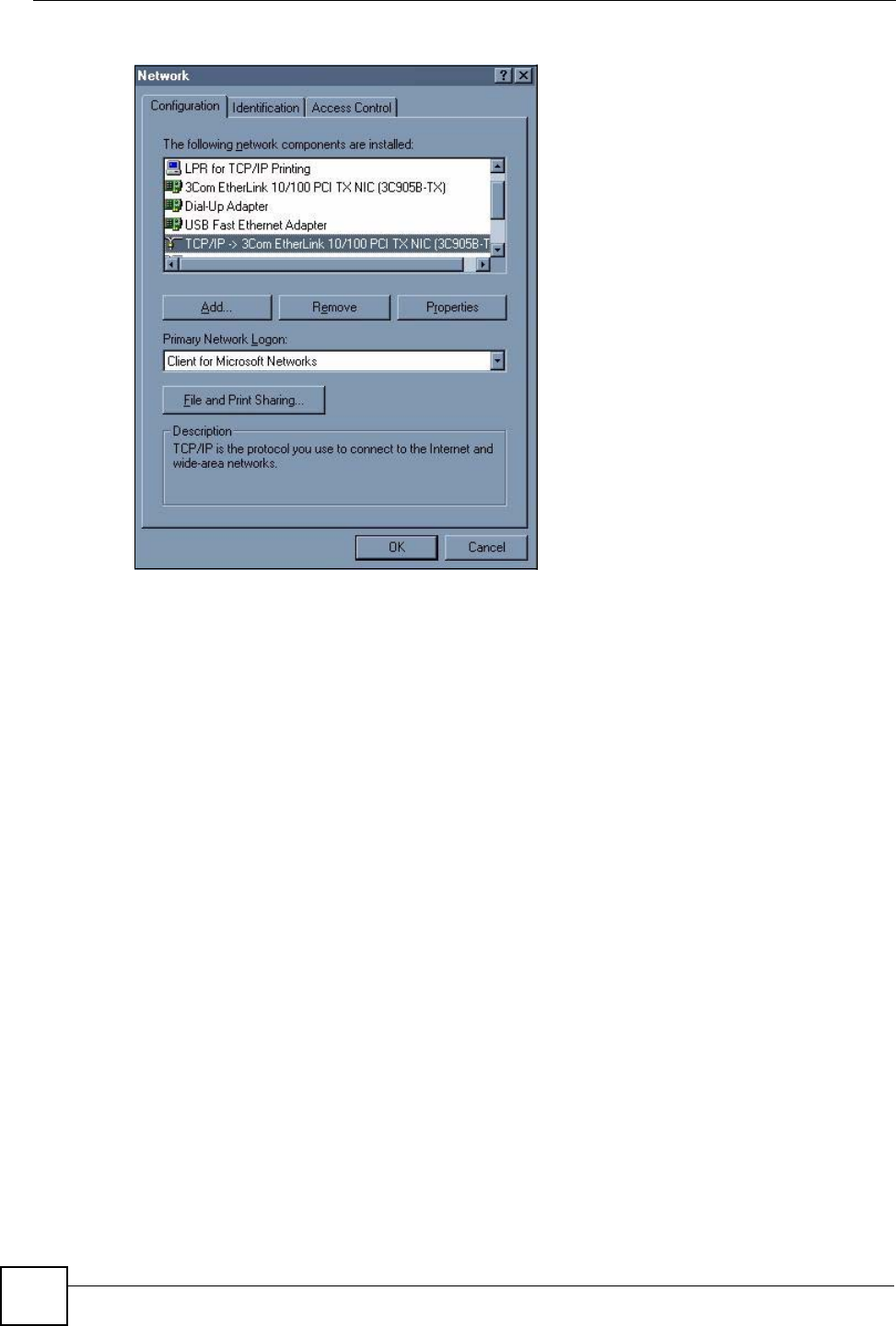
Appendix A Setting up Your Computer’s IP Address
V630 User’s Guide
158
Figure 142 WIndows 95/98/Me: Network: Configuration
Installing Components
The Network window Configuration tab displays a list of installed components. You need a
network adapter, the TCP/IP protocol and Client for Microsoft Networks.
If you need the adapter:
1In the Network window, click Add.
2Select Adapter and then click Add.
3Select the manufacturer and model of your network adapter and then click OK.
If you need TCP/IP:
1In the Network window, click Add.
2Select Protocol and then click Add.
3Select Microsoft from the list of manufacturers.
4Select TCP/IP from the list of network protocols and then click OK.
If you need Client for Microsoft Networks:
1Click Add.
2Select Client and then click Add.
3Select Microsoft from the list of manufacturers.
4Select Client for Microsoft Networks from the list of network clients and then click
OK.
5Restart your computer so the changes you made take effect.
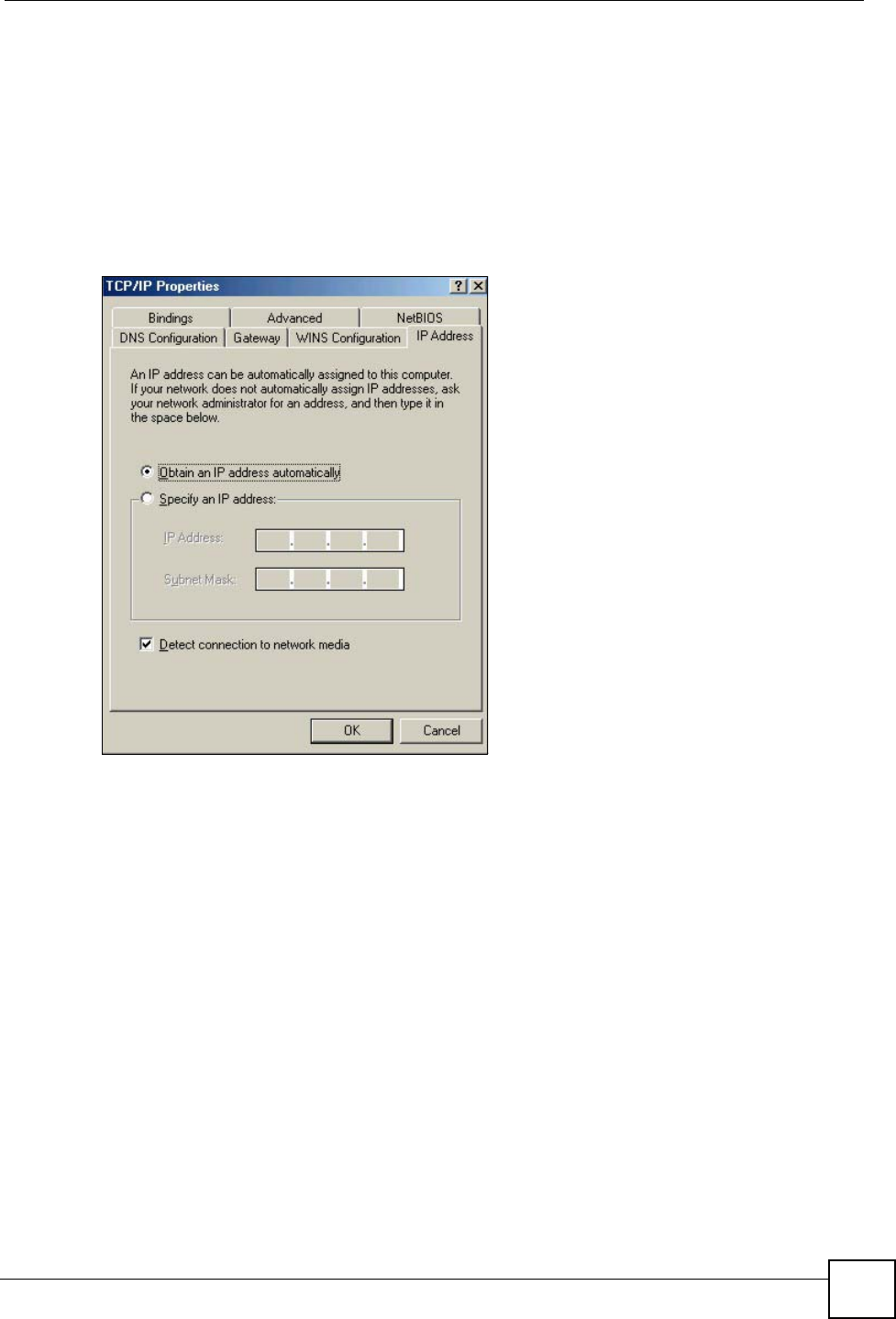
Appendix A Setting up Your Computer’s IP Address
V630 User’s Guide 159
Configuring
1In the Network window Configuration tab, select your network adapter's TCP/IP entry
and click Properties
2Click the IP Address tab.
• If your IP address is dynamic, select Obtain an IP address automatically.
• If you have a static IP address, select Specify an IP address and type your
information into the IP Address and Subnet Mask fields.
Figure 143 Windows 95/98/Me: TCP/IP Properties: IP Address
3Click the DNS Configuration tab.
• If you do not know your DNS information, select Disable DNS.
• If you know your DNS information, select Enable DNS and type the information in
the fields below (you may not need to fill them all in).
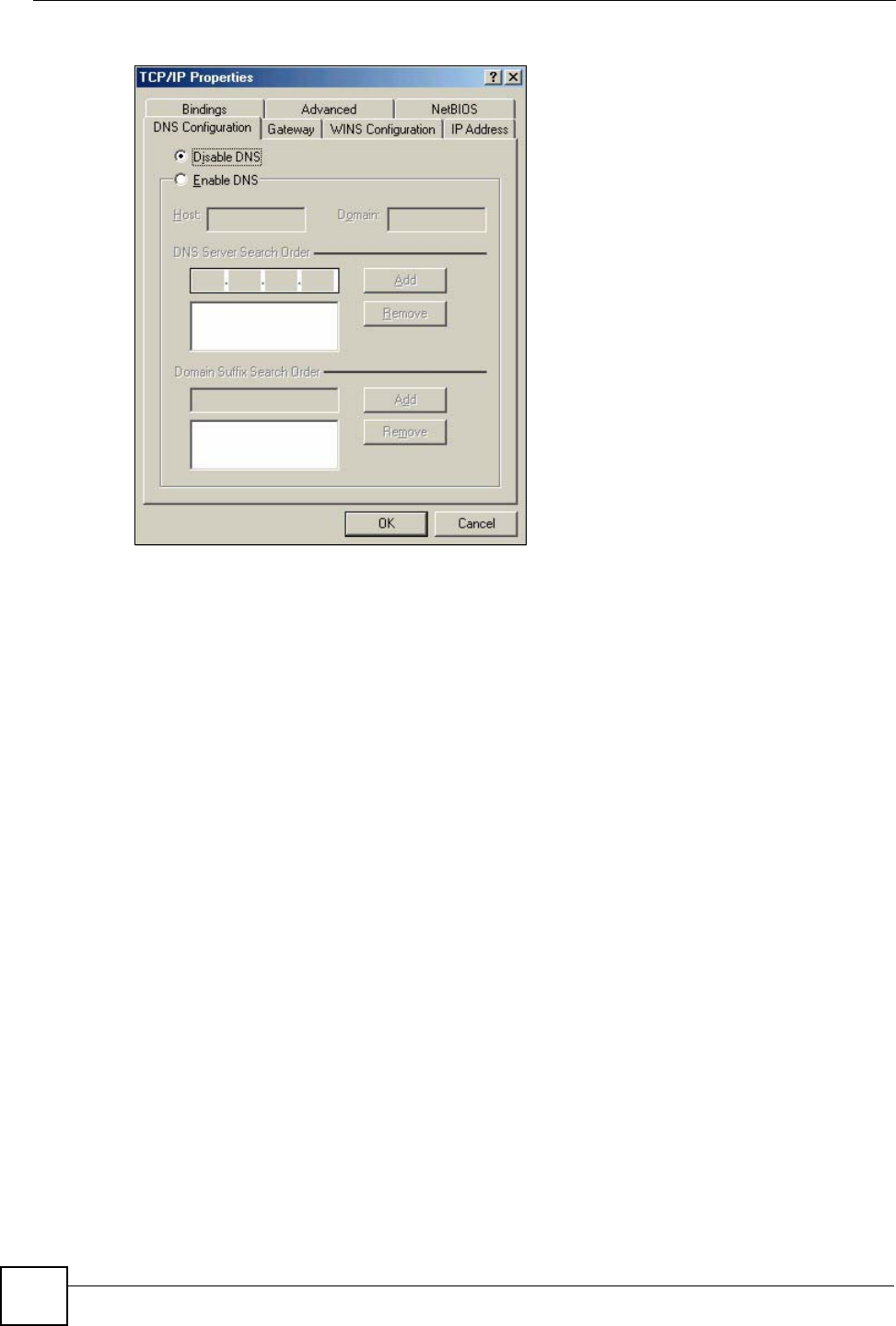
Appendix A Setting up Your Computer’s IP Address
V630 User’s Guide
160
Figure 144 Windows 95/98/Me: TCP/IP Properties: DNS Configuration
4Click the Gateway tab.
• If you do not know your gateway’s IP address, remove previously installed gateways.
• If you have a gateway IP address, type it in the New gateway field and click Add.
5Click OK to save and close the TCP/IP Properties window.
6Click OK to close the Network window. Insert the Windows CD if prompted.
7Turn on your V630 and restart your computer when prompted.
Verifying Settings
1Click Start and then Run.
2In the Run window, type "winipcfg" and then click OK to open the IP Configuration
window.
3Select your network adapter. You should see your computer's IP address, subnet mask
and default gateway.
Windows 2000/NT/XP
The following example figures use the default Windows XP GUI theme.
1Click start (Start in Windows 2000/NT), Settings, Control Panel.
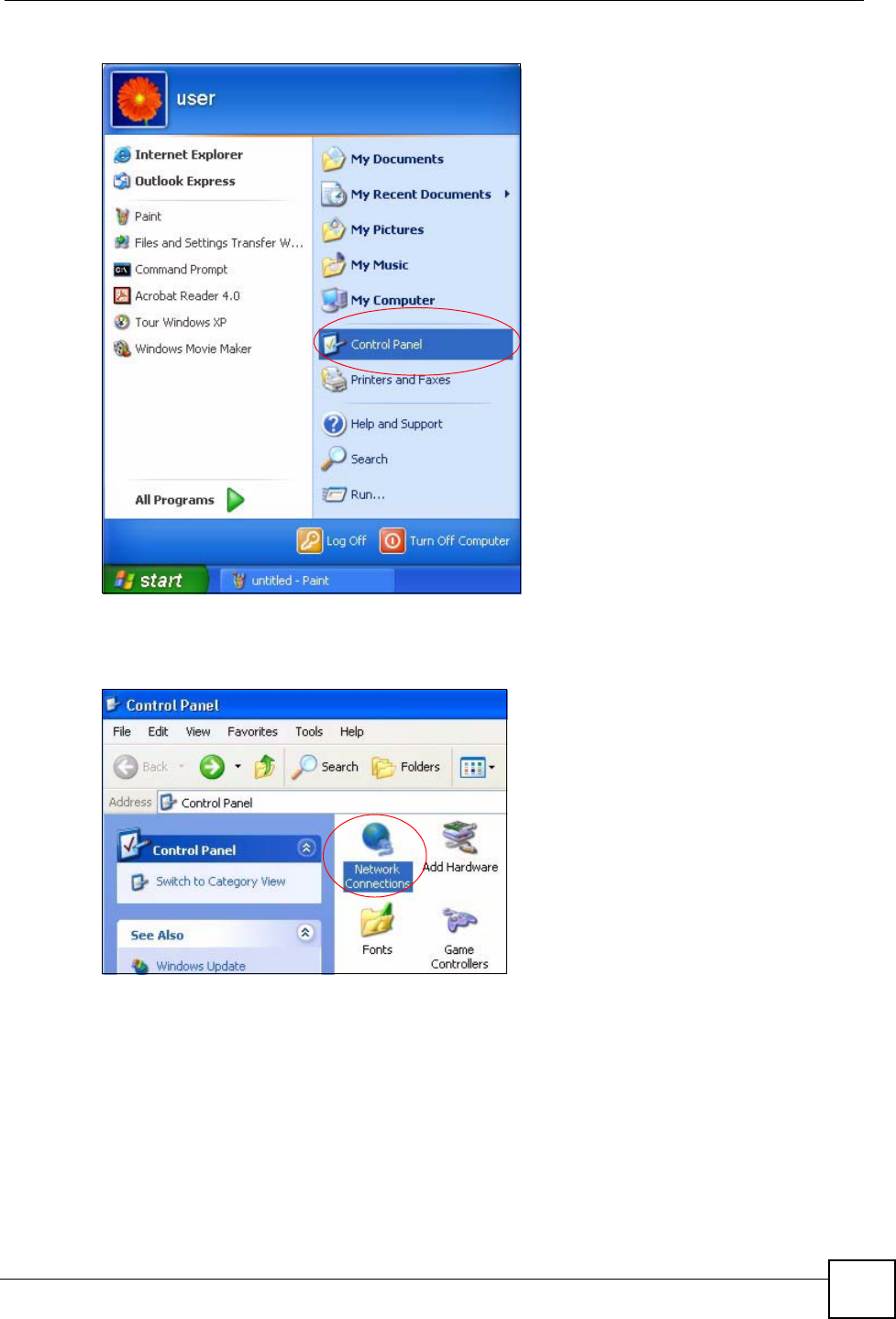
Appendix A Setting up Your Computer’s IP Address
V630 User’s Guide 161
Figure 145 Windows XP: Start Menu
2In the Control Panel, double-click Network Connections (Network and Dial-up
Connections in Windows 2000/NT).
Figure 146 Windows XP: Control Panel
3Right-click Local Area Connection and then click Properties.
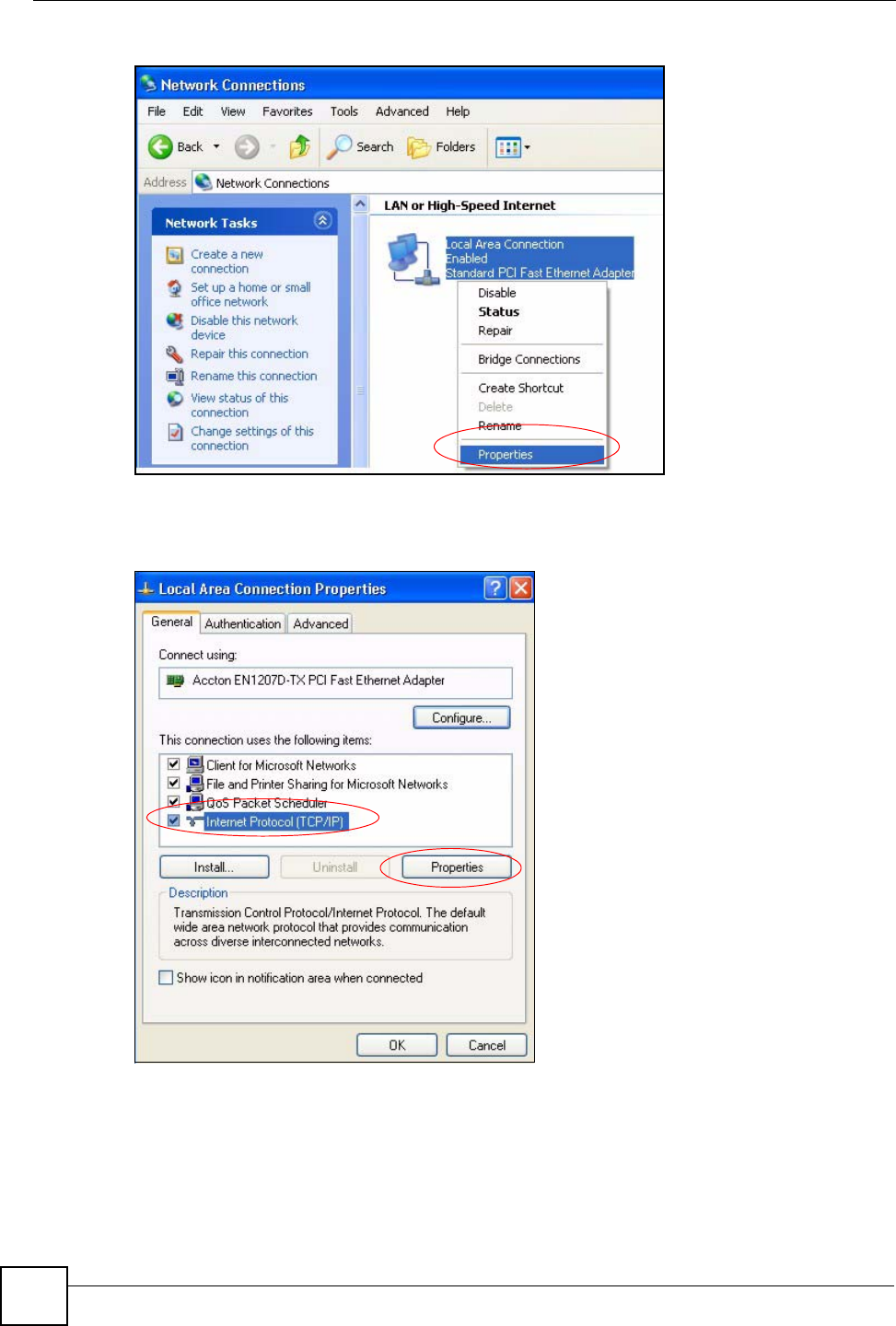
Appendix A Setting up Your Computer’s IP Address
V630 User’s Guide
162
Figure 147 Windows XP: Control Panel: Network Connections: Properties
4Select Internet Protocol (TCP/IP) (under the General tab in Win XP) and then click
Properties.
Figure 148 Windows XP: Local Area Connection Properties
5The Internet Protocol TCP/IP Properties window opens (the General tab in Windows
XP).
• If you have a dynamic IP address click Obtain an IP address automatically.
• If you have a static IP address click Use the following IP Address and fill in the IP
address, Subnet mask, and Default gateway fields.
• Click Advanced.
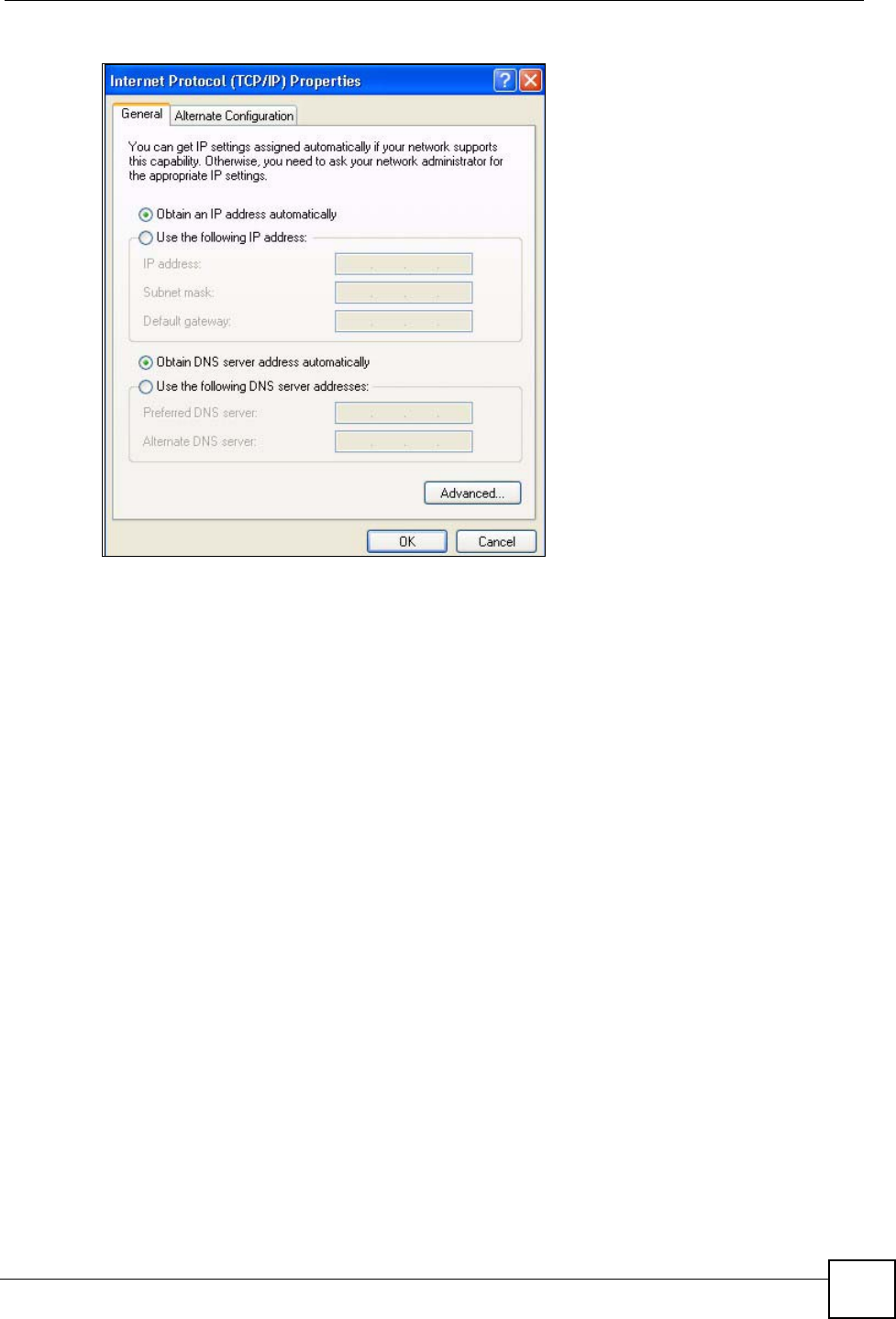
Appendix A Setting up Your Computer’s IP Address
V630 User’s Guide 163
Figure 149 Windows XP: Internet Protocol (TCP/IP) Properties
6 If you do not know your gateway's IP address, remove any previously installed
gateways in the IP Settings tab and click OK.
Do one or more of the following if you want to configure additional IP addresses:
•In the IP Settings tab, in IP addresses, click Add.
•In TCP/IP Address, type an IP address in IP address and a subnet mask in Subnet
mask, and then click Add.
• Repeat the above two steps for each IP address you want to add.
• Configure additional default gateways in the IP Settings tab by clicking Add in
Default gateways.
•In TCP/IP Gateway Address, type the IP address of the default gateway in Gateway.
To manually configure a default metric (the number of transmission hops), clear the
Automatic metric check box and type a metric in Metric.
• Click Add.
• Repeat the previous three steps for each default gateway you want to add.
• Click OK when finished.
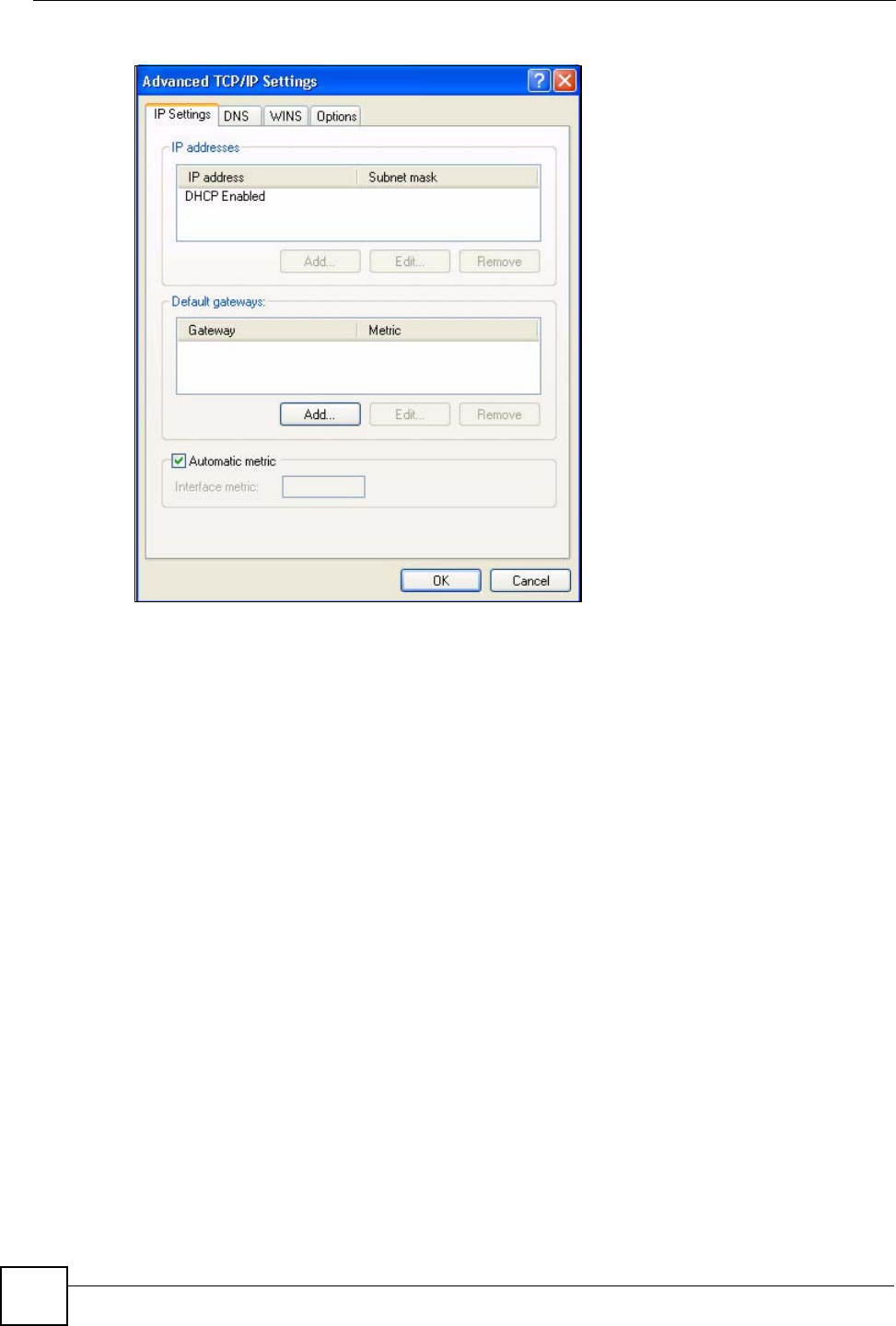
Appendix A Setting up Your Computer’s IP Address
V630 User’s Guide
164
Figure 150 Windows XP: Advanced TCP/IP Properties
7In the Internet Protocol TCP/IP Properties window (the General tab in Windows
XP):
• Click Obtain DNS server address automatically if you do not know your DNS
server IP address(es).
• If you know your DNS server IP address(es), click Use the following DNS server
addresses, and type them in the Preferred DNS server and Alternate DNS server
fields.
If you have previously configured DNS servers, click Advanced and then the DNS
tab to order them.
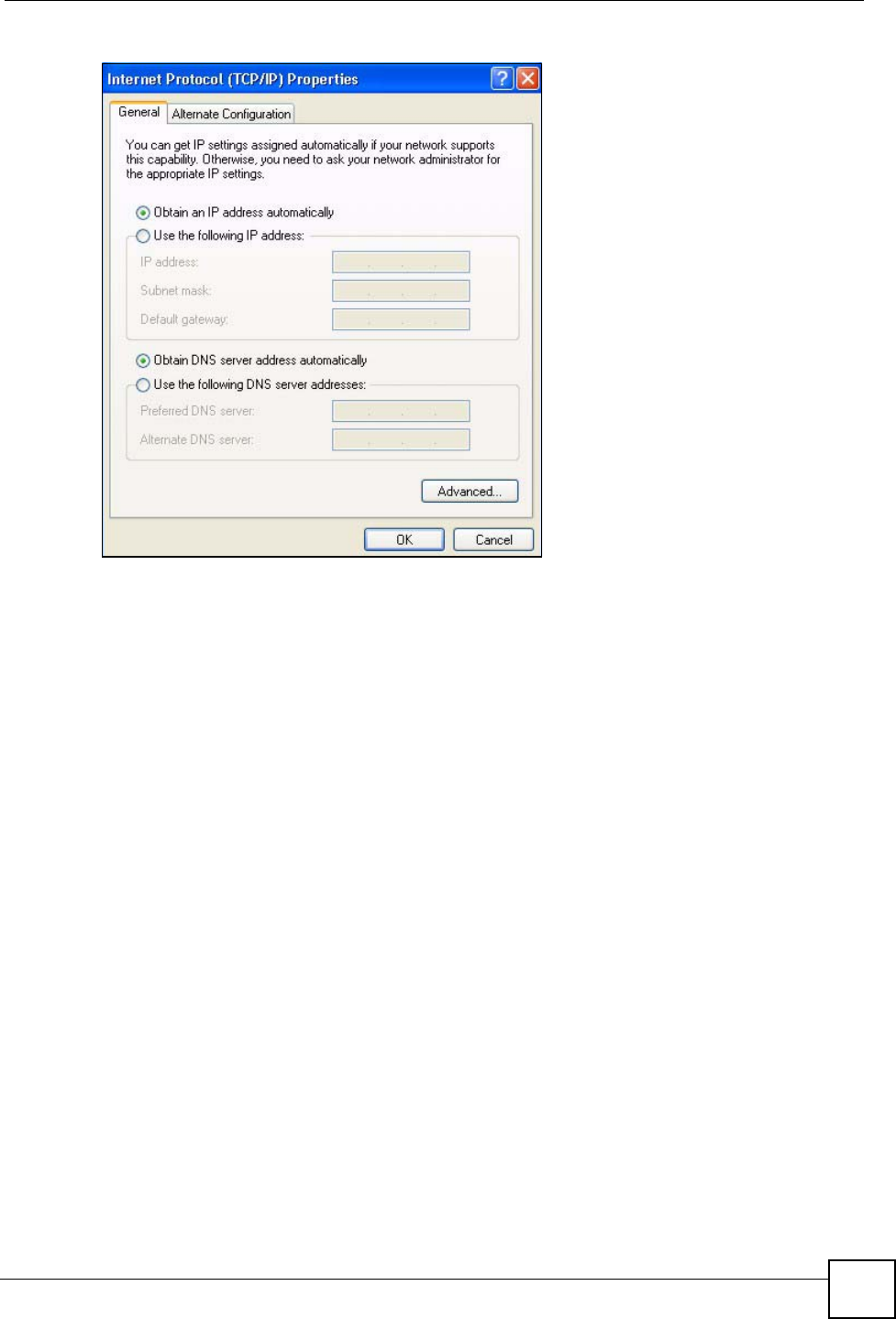
Appendix A Setting up Your Computer’s IP Address
V630 User’s Guide 165
Figure 151 Windows XP: Internet Protocol (TCP/IP) Properties
8Click OK to close the Internet Protocol (TCP/IP) Properties window.
9Click Close (OK in Windows 2000/NT) to close the Local Area Connection
Properties window.
10 Close the Network Connections window (Network and Dial-up Connections in
Windows 2000/NT).
11 Turn on your V630 and restart your computer (if prompted).
Verifying Settings
1Click Start, All Programs, Accessories and then Command Prompt.
2In the Command Prompt window, type "ipconfig" and then press [ENTER]. You can
also open Network Connections, right-click a network connection, click Status and
then click the Support tab.
Windows Vista
This section shows screens from Windows Vista Enterprise Version 6.0.
1Click the Start icon, Control Panel.
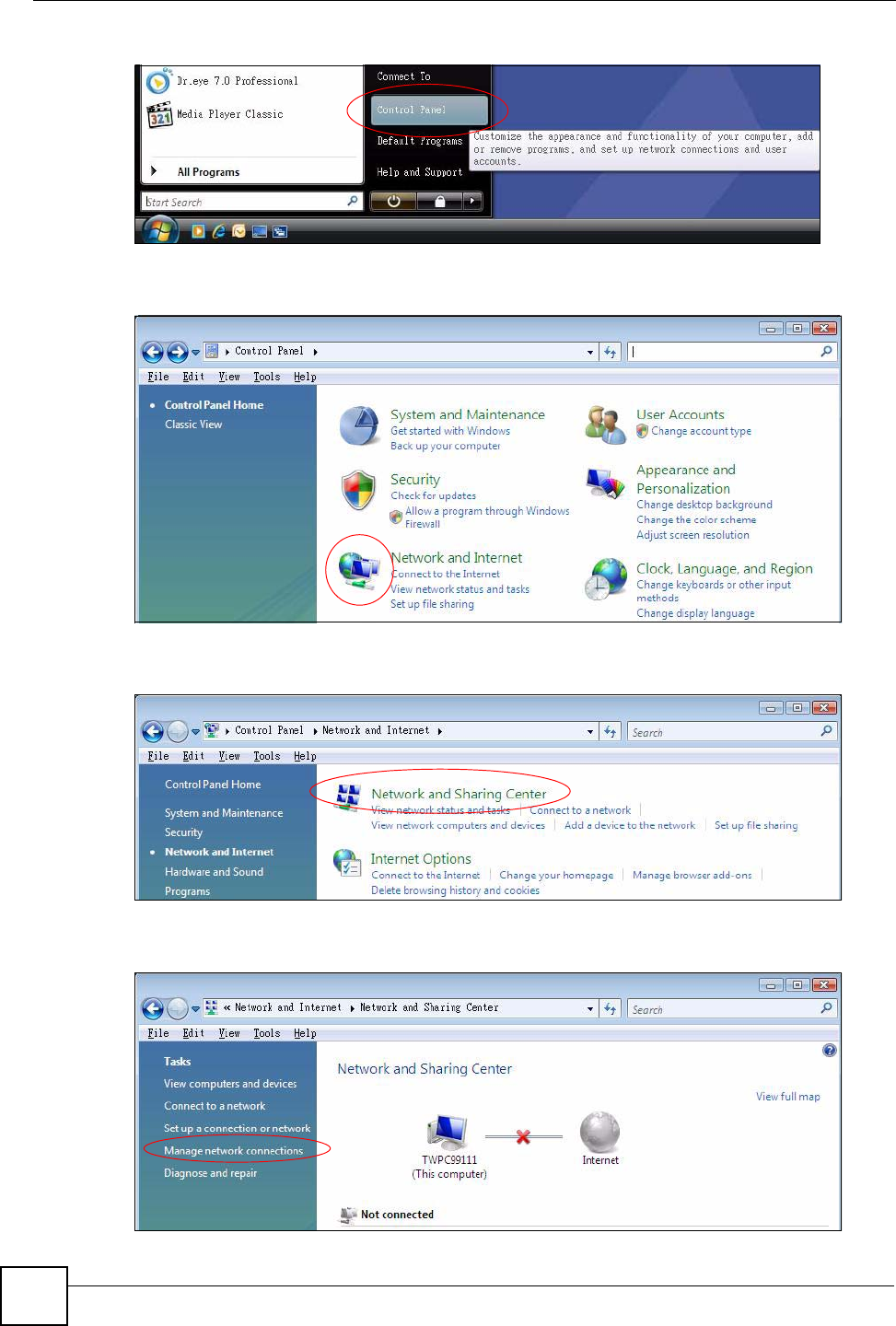
Appendix A Setting up Your Computer’s IP Address
V630 User’s Guide
166
Figure 152 Windows Vista: Start Menu
2In the Control Panel, double-click Network and Internet.
Figure 153 Windows Vista: Control Panel
3Click Network and Sharing Center.
Figure 154 Windows Vista: Network And Internet
4Click Manage network connections.
Figure 155 Windows Vista: Network and Sharing Center
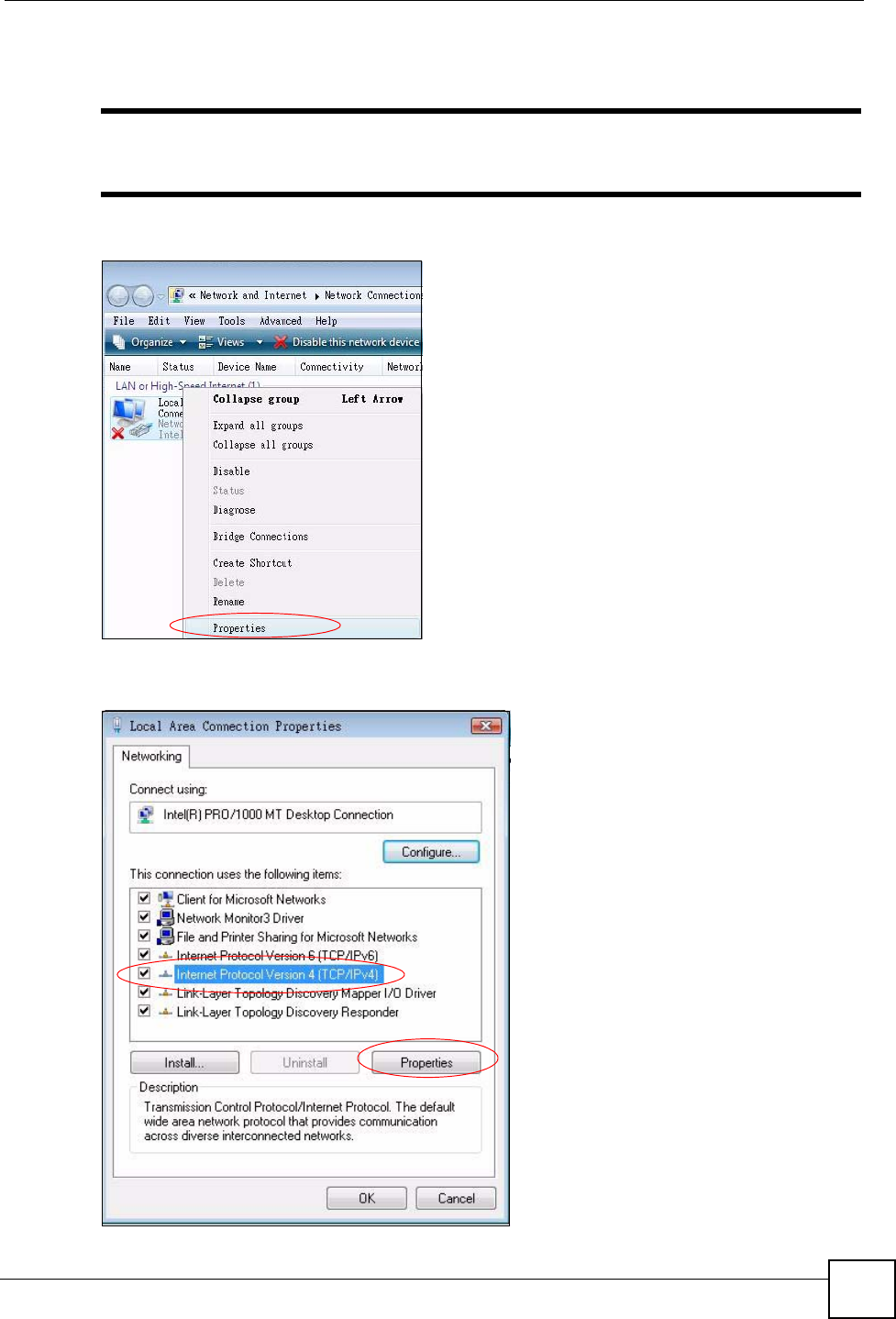
Appendix A Setting up Your Computer’s IP Address
V630 User’s Guide 167
5Right-click Local Area Connection and then click Properties.
"During this procedure, click Continue whenever Windows displays a screen
saying that it needs your permission to continue.
Figure 156 Windows Vista: Network and Sharing Center
6Select Internet Protocol Version 4 (TCP/IPv4) and click Properties.
Figure 157 Windows Vista: Local Area Connection Properties
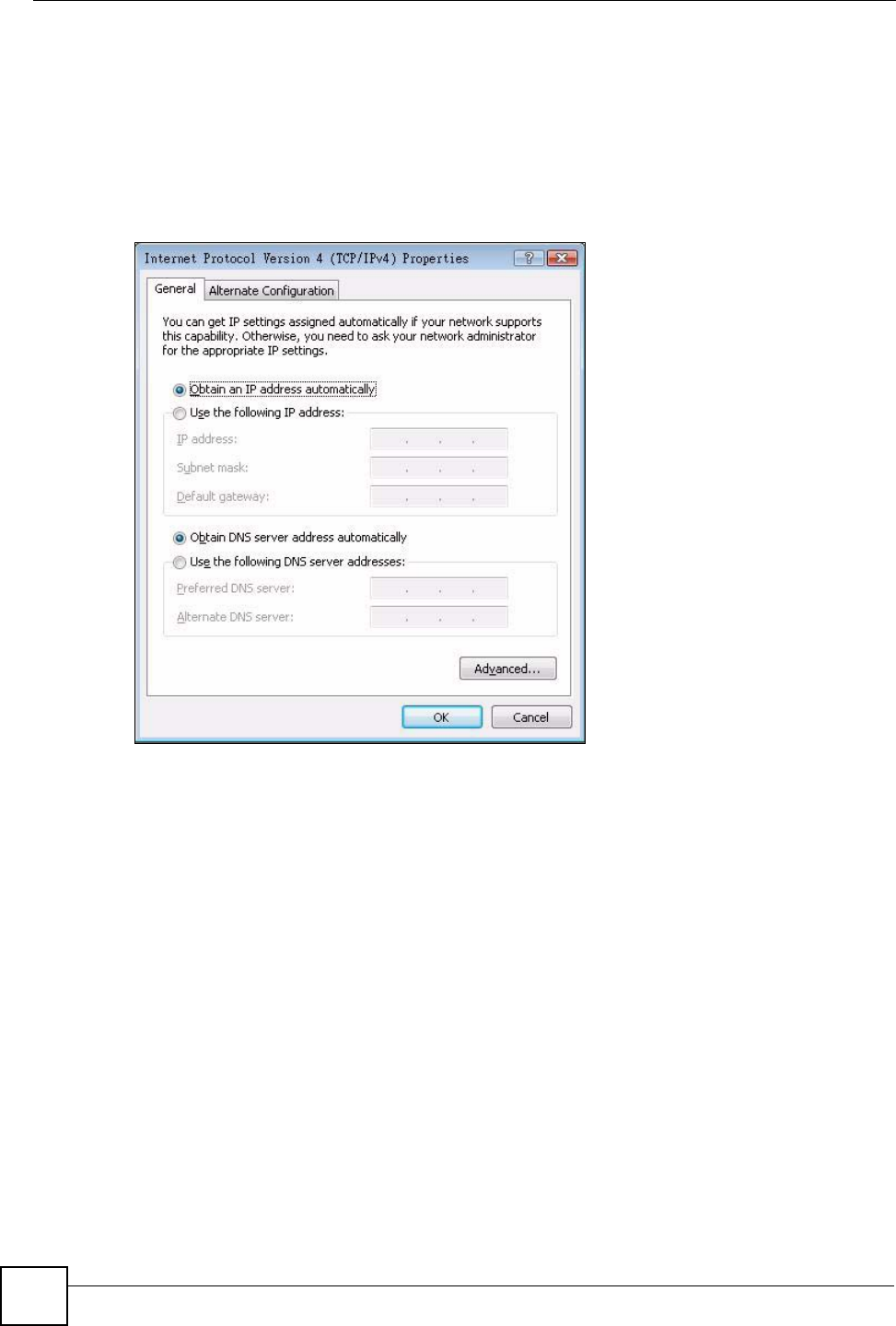
Appendix A Setting up Your Computer’s IP Address
V630 User’s Guide
168
7The Internet Protocol Version 4 (TCP/IPv4) Properties window opens (the General
tab).
• If you have a dynamic IP address click Obtain an IP address automatically.
• If you have a static IP address click Use the following IP address and fill in the IP
address, Subnet mask, and Default gateway fields.
• Click Advanced.
Figure 158 Windows Vista: Internet Protocol Version 4 (TCP/IPv4) Properties
8 If you do not know your gateway's IP address, remove any previously installed
gateways in the IP Settings tab and click OK.
Do one or more of the following if you want to configure additional IP addresses:
•In the IP Settings tab, in IP addresses, click Add.
•In TCP/IP Address, type an IP address in IP address and a subnet mask in Subnet
mask, and then click Add.
• Repeat the above two steps for each IP address you want to add.
• Configure additional default gateways in the IP Settings tab by clicking Add in
Default gateways.
•In TCP/IP Gateway Address, type the IP address of the default gateway in Gateway.
To manually configure a default metric (the number of transmission hops), clear the
Automatic metric check box and type a metric in Metric.
• Click Add.
• Repeat the previous three steps for each default gateway you want to add.
• Click OK when finished.
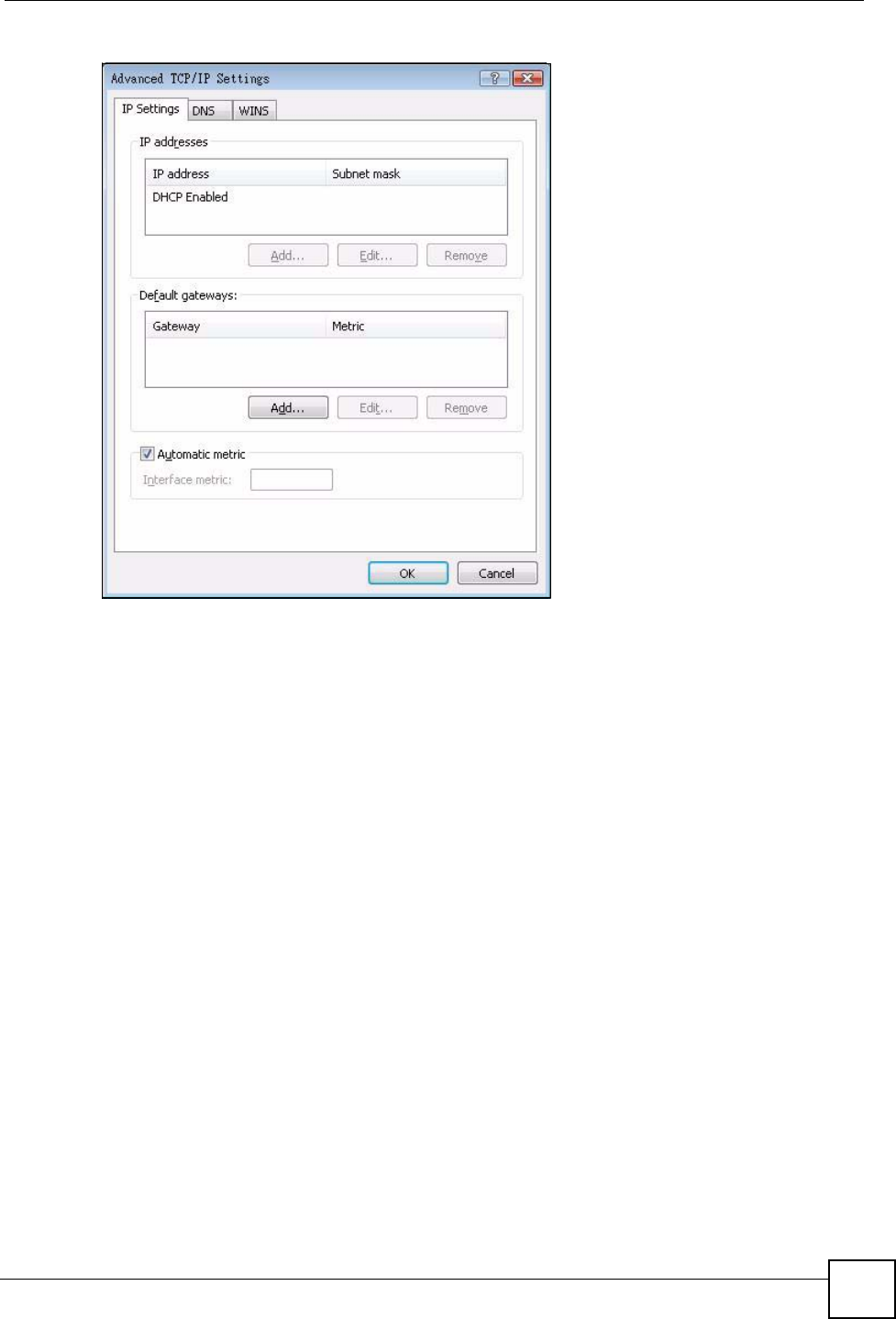
Appendix A Setting up Your Computer’s IP Address
V630 User’s Guide 169
Figure 159 Windows Vista: Advanced TCP/IP Properties
9In the Internet Protocol Version 4 (TCP/IPv4) Properties window, (the General tab):
• Click Obtain DNS server address automatically if you do not know your DNS
server IP address(es).
• If you know your DNS server IP address(es), click Use the following DNS server
addresses, and type them in the Preferred DNS server and Alternate DNS server
fields.
If you have previously configured DNS servers, click Advanced and then the DNS
tab to order them.
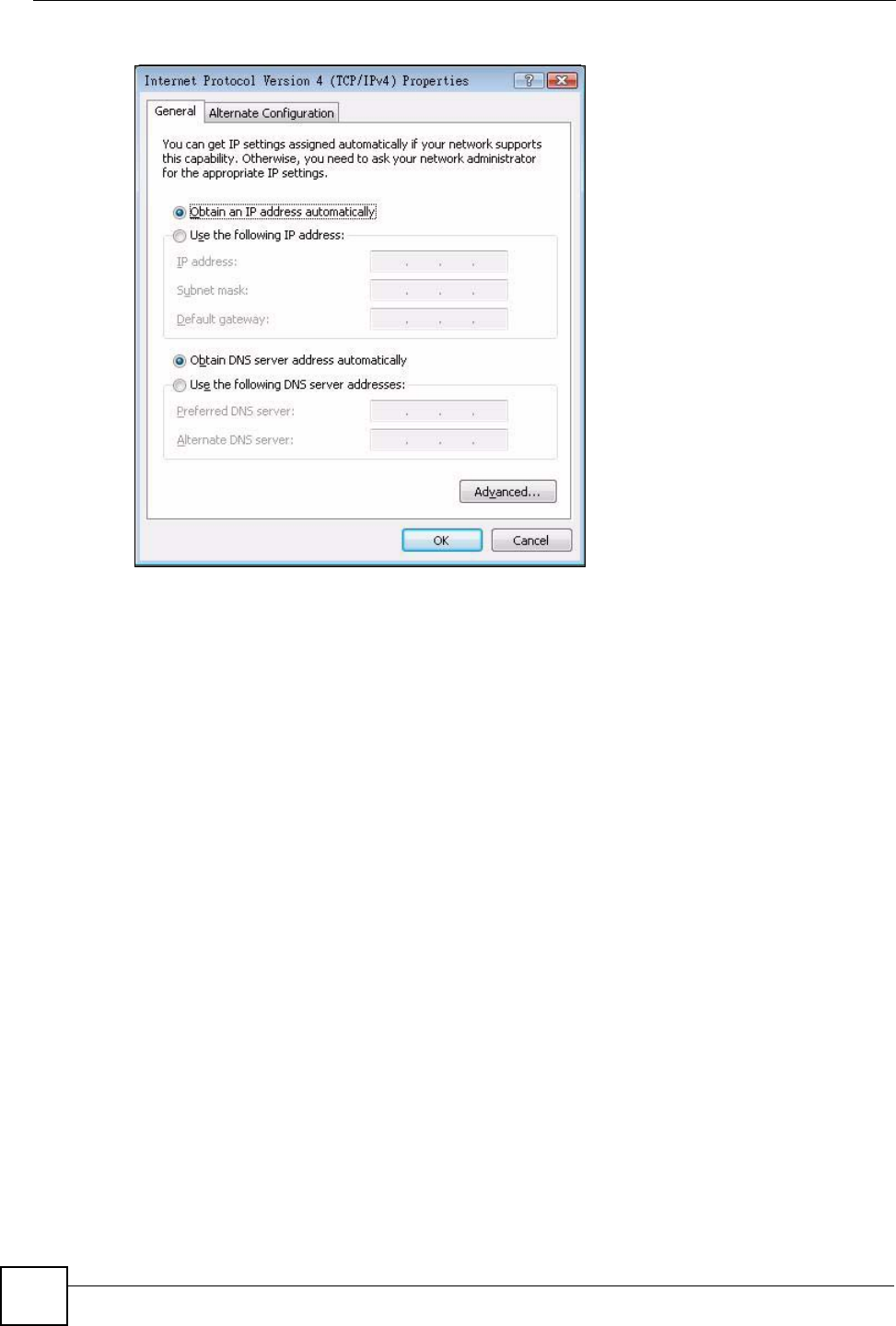
Appendix A Setting up Your Computer’s IP Address
V630 User’s Guide
170
Figure 160 Windows Vista: Internet Protocol Version 4 (TCP/IPv4) Properties
10 Click OK to close the Internet Protocol Version 4 (TCP/IPv4) Properties window.
11 Click Close to close the Local Area Connection Properties window.
12 Close the Network Connections window.
13 Turn on your V630 and restart your computer (if prompted).
Verifying Settings
1Click Start, All Programs, Accessories and then Command Prompt.
2In the Command Prompt window, type "ipconfig" and then press [ENTER]. You can
also open Network Connections, right-click a network connection, click Status and
then click the Support tab.
Macintosh OS 8/9
1Click the Apple menu, Control Panel and double-click TCP/IP to open the TCP/IP
Control Panel.
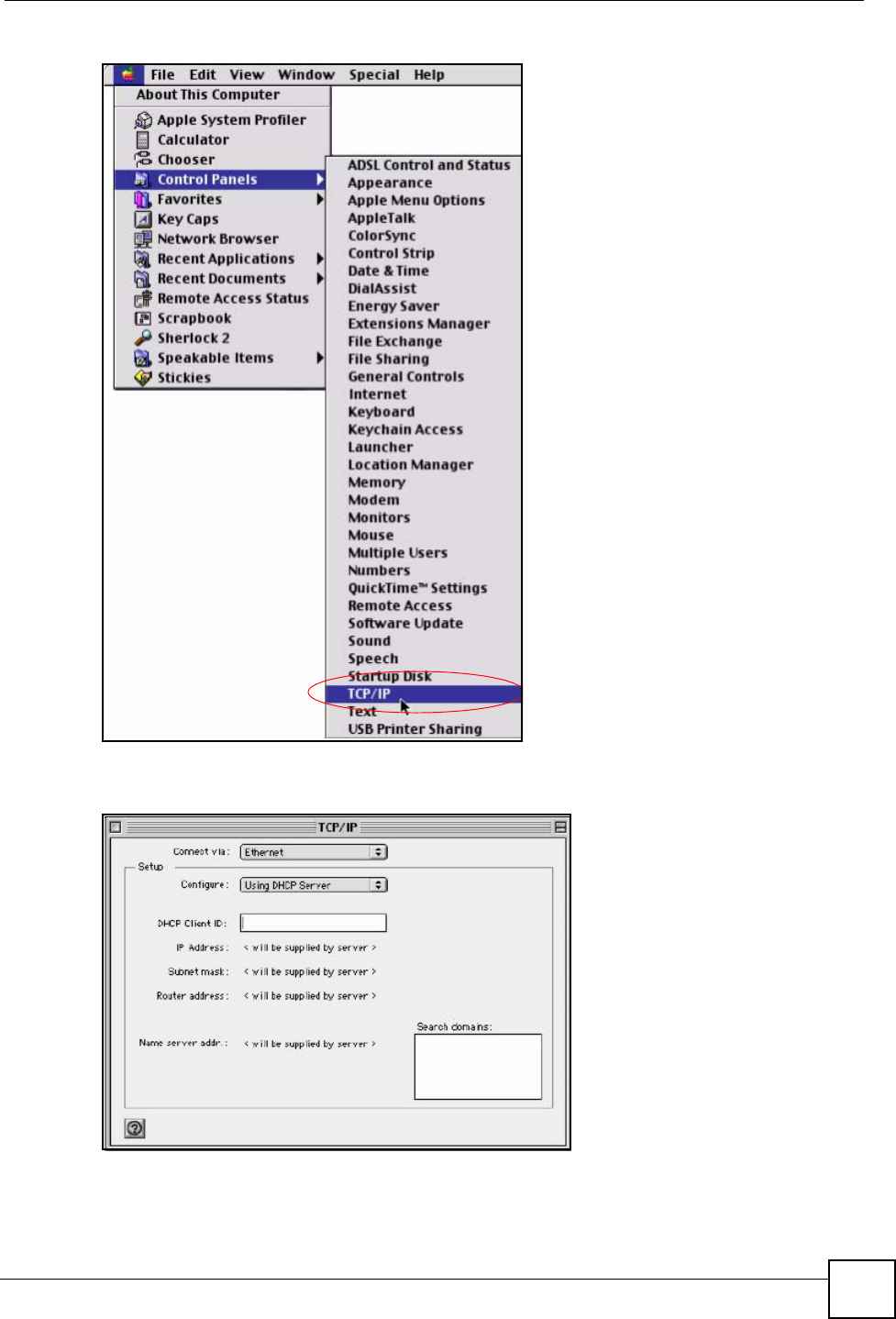
Appendix A Setting up Your Computer’s IP Address
V630 User’s Guide 171
Figure 161 Macintosh OS 8/9: Apple Menu
2Select Ethernet built-in from the Connect via list.
Figure 162 Macintosh OS 8/9: TCP/IP
3For dynamically assigned settings, select Using DHCP Server from the Configure: list.
4For statically assigned settings, do the following:
•From the Configure box, select Manually.
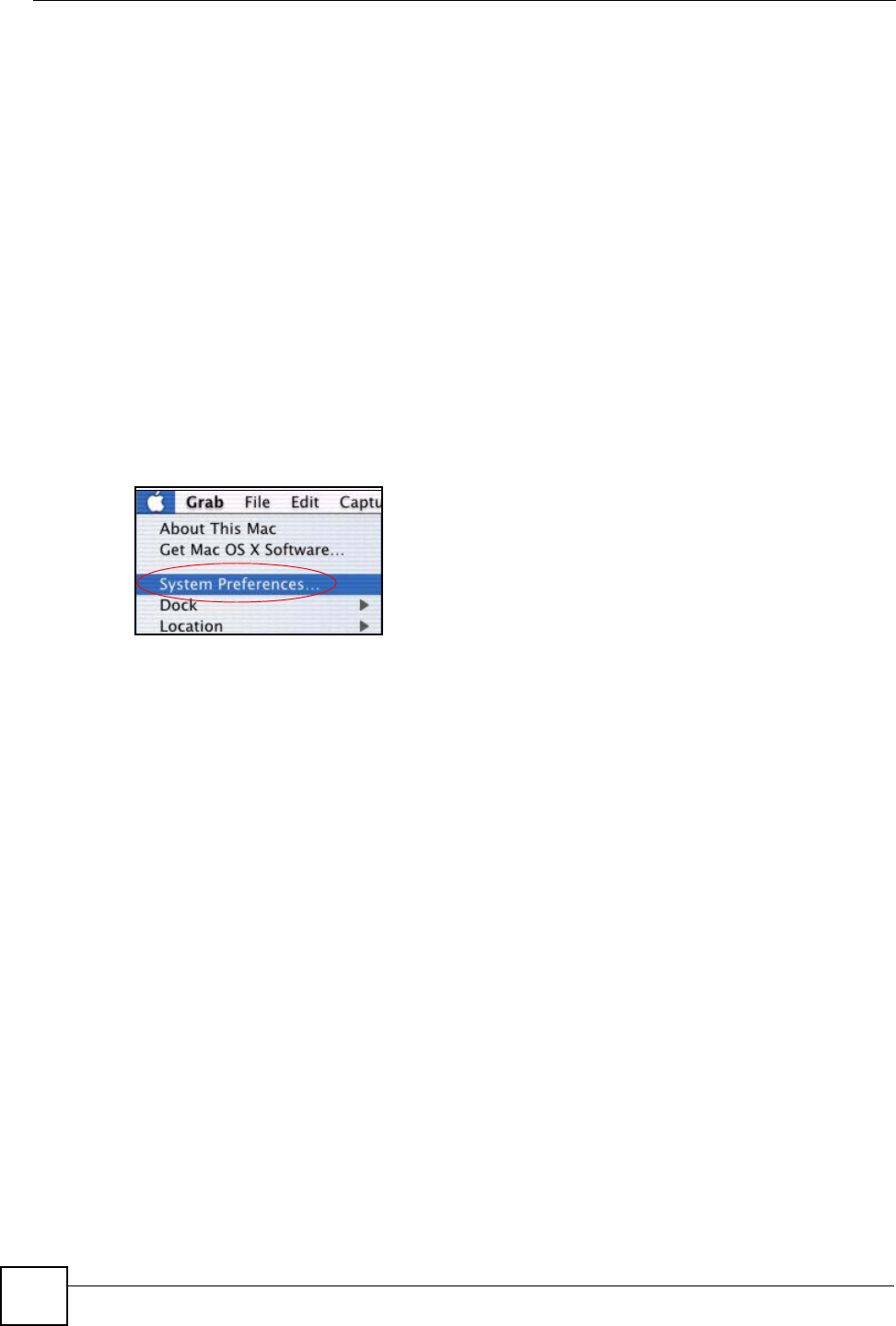
Appendix A Setting up Your Computer’s IP Address
V630 User’s Guide
172
• Type your IP address in the IP Address box.
• Type your subnet mask in the Subnet mask box.
• Type the IP address of your V630 in the Router address box.
5Close the TCP/IP Control Panel.
6Click Save if prompted, to save changes to your configuration.
7Turn on your V630 and restart your computer (if prompted).
Verifying Settings
Check your TCP/IP properties in the TCP/IP Control Panel window.
Macintosh OS X
1Click the Apple menu, and click System Preferences to open the System Preferences
window.
Figure 163 Macintosh OS X: Apple Menu
2Click Network in the icon bar.
• Select Automatic from the Location list.
• Select Built-in Ethernet from the Show list.
• Click the TCP/IP tab.
3For dynamically assigned settings, select Using DHCP from the Configure list.
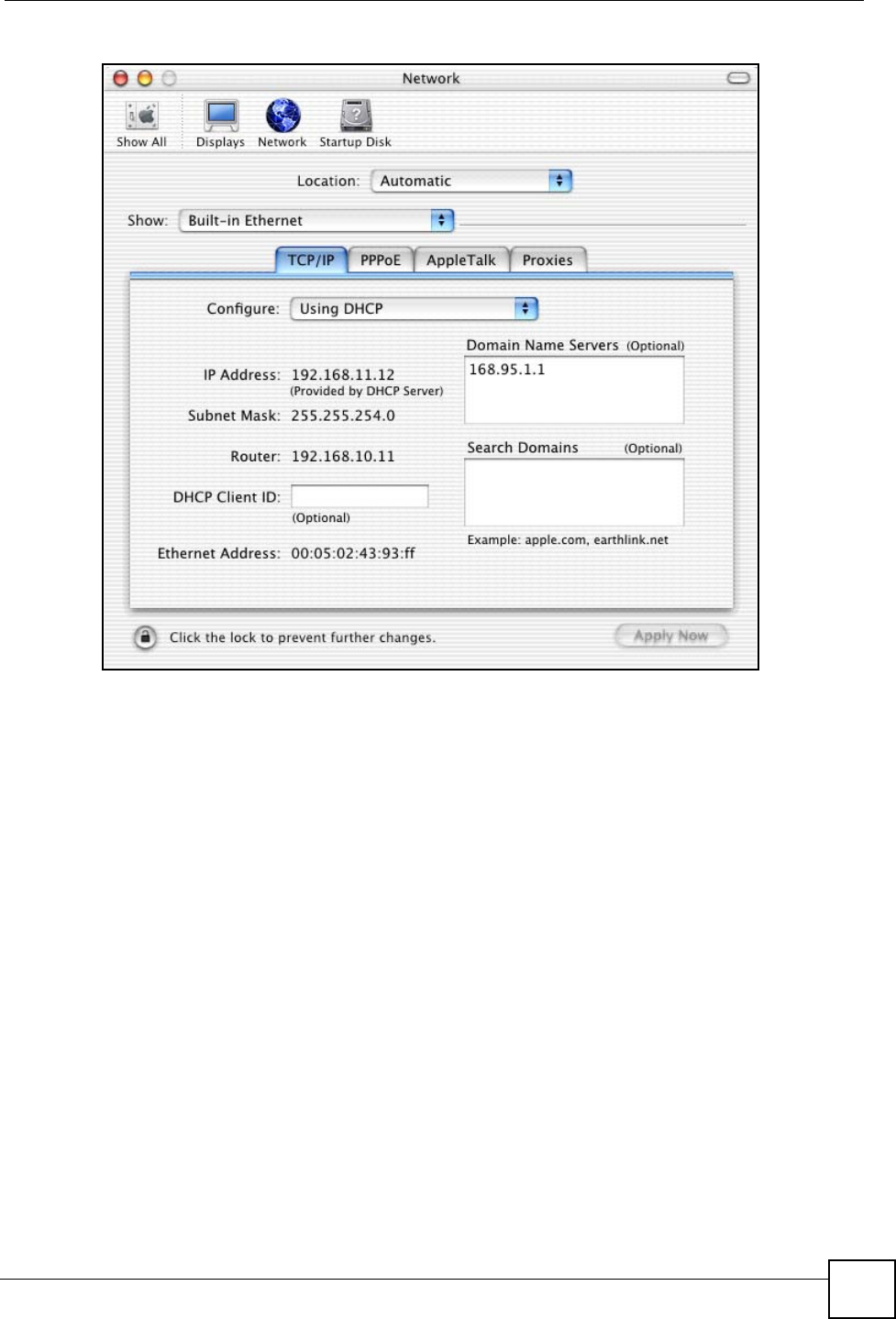
Appendix A Setting up Your Computer’s IP Address
V630 User’s Guide 173
Figure 164 Macintosh OS X: Network
4For statically assigned settings, do the following:
•From the Configure box, select Manually.
• Type your IP address in the IP Address box.
• Type your subnet mask in the Subnet mask box.
• Type the IP address of your V630 in the Router address box.
5Click Apply Now and close the window.
6Turn on your V630 and restart your computer (if prompted).
Verifying Settings
Check your TCP/IP properties in the Network window.
Linux
This section shows you how to configure your computer’s TCP/IP settings in Red Hat Linux
9.0. Procedure, screens and file location may vary depending on your Linux distribution and
release version.
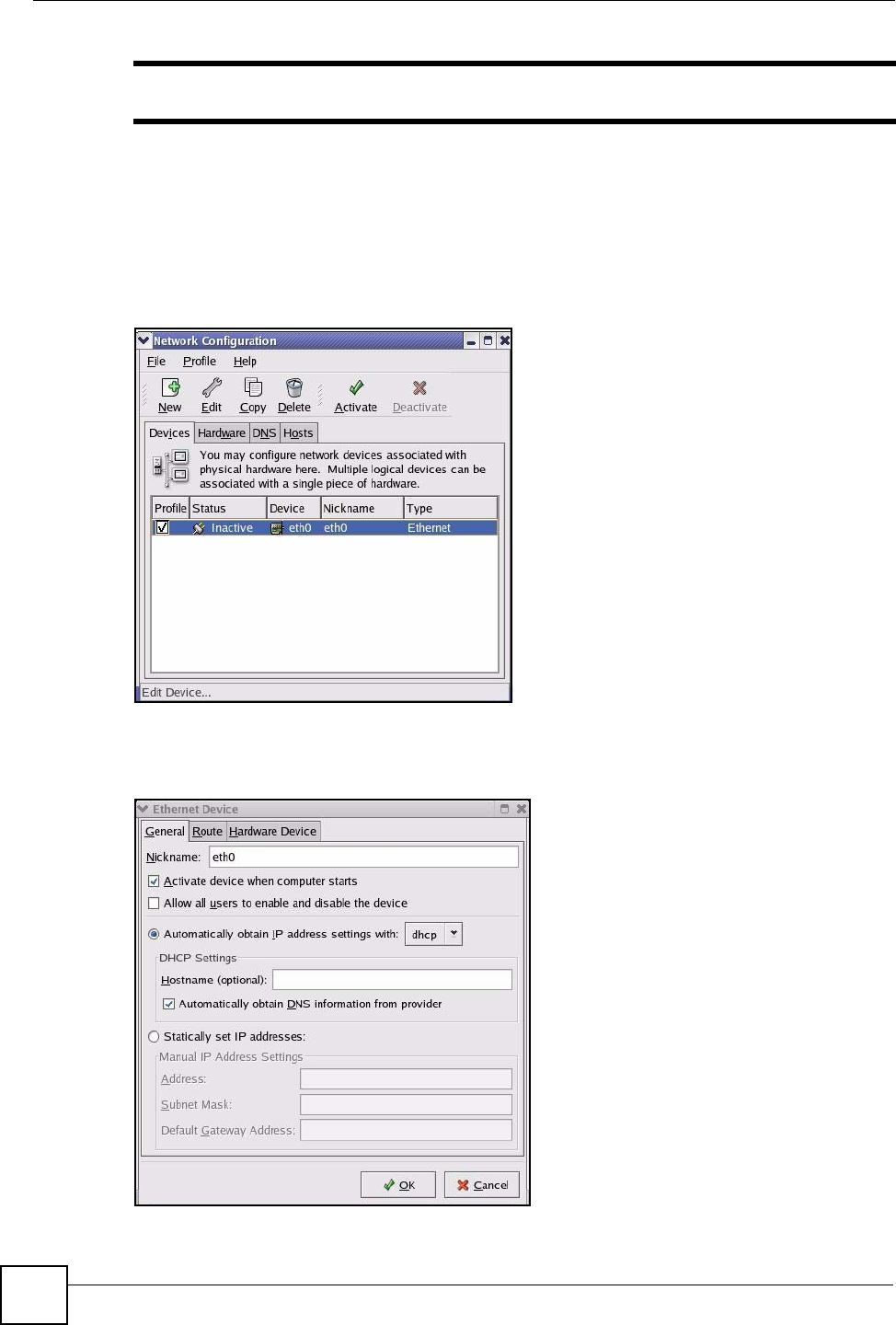
Appendix A Setting up Your Computer’s IP Address
V630 User’s Guide
174
"Make sure you are logged in as the root administrator.
Using the K Desktop Environment (KDE)
Follow the steps below to configure your computer IP address using the KDE.
1Click the Red Hat button (located on the bottom left corner), select System Setting and
click Network.
Figure 165 Red Hat 9.0: KDE: Network Configuration: Devices
2Double-click on the profile of the network card you wish to configure. The Ethernet
Device General screen displays as shown.
Figure 166 Red Hat 9.0: KDE: Ethernet Device: General
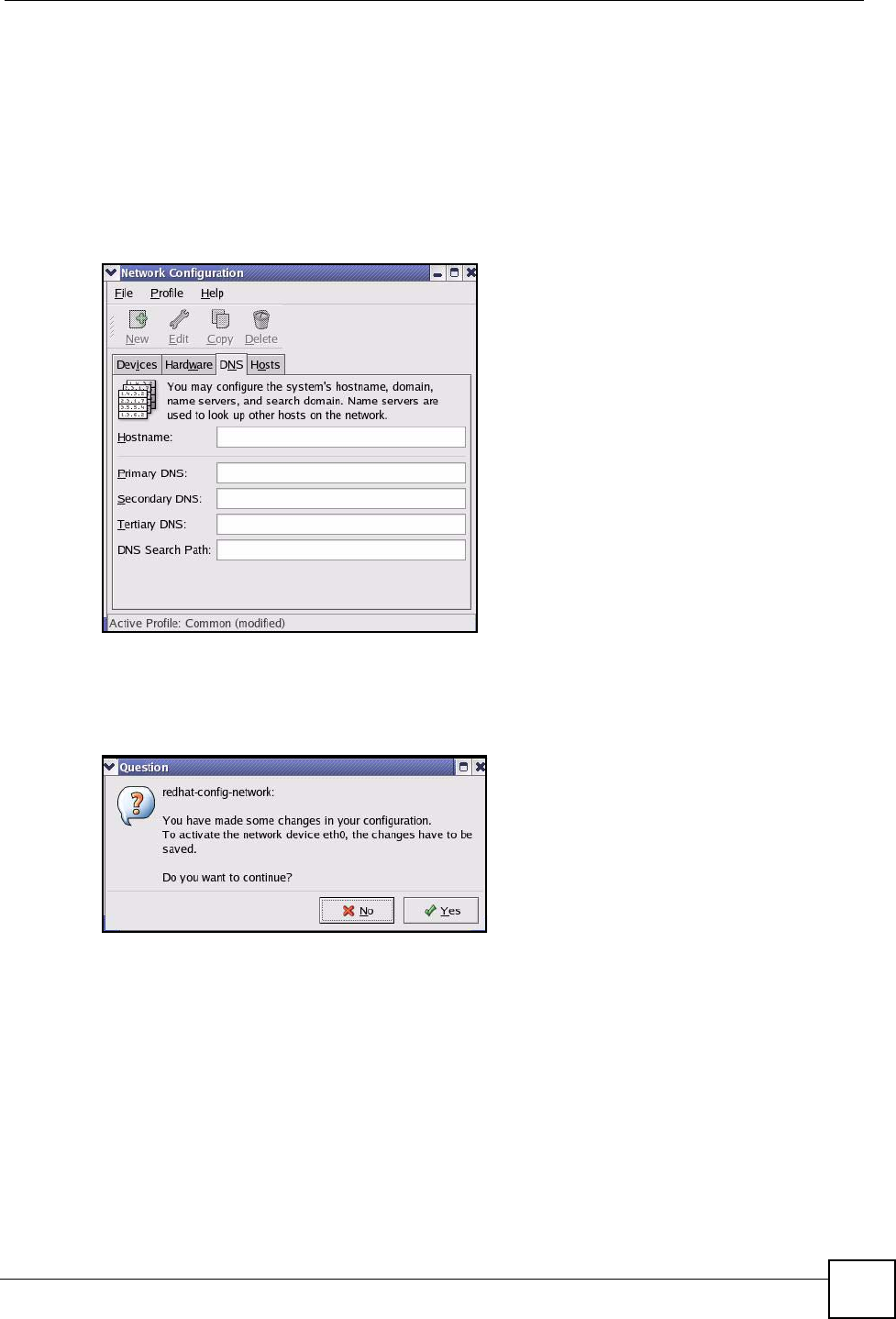
Appendix A Setting up Your Computer’s IP Address
V630 User’s Guide 175
• If you have a dynamic IP address, click Automatically obtain IP address settings
with and select dhcp from the drop down list.
• If you have a static IP address, click Statically set IP Addresses and fill in the
Address, Subnet mask, and Default Gateway Address fields.
3Click OK to save the changes and close the Ethernet Device General screen.
4If you know your DNS server IP address(es), click the DNS tab in the Network
Configuration screen. Enter the DNS server information in the fields provided.
Figure 167 Red Hat 9.0: KDE: Network Configuration: DNS
5Click the Devices tab.
6Click the Activate button to apply the changes. The following screen displays. Click Yes
to save the changes in all screens.
Figure 168 Red Hat 9.0: KDE: Network Configuration: Activate
7After the network card restart process is complete, make sure the Status is Active in the
Network Configuration screen.
Using Configuration Files
Follow the steps below to edit the network configuration files and set your computer IP
address.
1Assuming that you have only one network card on the computer, locate the ifconfig-
eth0 configuration file (where eth0 is the name of the Ethernet card). Open the
configuration file with any plain text editor.
• If you have a dynamic IP address, enter dhcp in the BOOTPROTO= field. The
following figure shows an example.

Appendix A Setting up Your Computer’s IP Address
V630 User’s Guide
176
Figure 169 Red Hat 9.0: Dynamic IP Address Setting in ifconfig-eth0
• If you have a static IP address, enter static in the BOOTPROTO= field. Type
IPADDR= followed by the IP address (in dotted decimal notation) and type NETMASK=
followed by the subnet mask. The following example shows an example where the
static IP address is 192.168.1.10 and the subnet mask is 255.255.255.0.
Figure 170 Red Hat 9.0: Static IP Address Setting in ifconfig-eth0
2If you know your DNS server IP address(es), enter the DNS server information in the
resolv.conf file in the /etc directory. The following figure shows an example where
two DNS server IP addresses are specified.
Figure 171 Red Hat 9.0: DNS Settings in resolv.conf
3After you edit and save the configuration files, you must restart the network card. Enter
./network restart in the /etc/rc.d/init.d directory. The following figure
shows an example.
Figure 172 Red Hat 9.0: Restart Ethernet Card
DEVICE=eth0
ONBOOT=yes
BOOTPROTO=dhcp
USERCTL=no
PEERDNS=yes
TYPE=Ethernet
DEVICE=eth0
ONBOOT=yes
BOOTPROTO=static
IPADDR=192.168.1.10
NETMASK=255.255.255.0
USERCTL=no
PEERDNS=yes
TYPE=Ethernet
nameserver 172.23.5.1
nameserver 172.23.5.2
[root@localhost init.d]# network restart
Shutting down interface eth0: [OK]
Shutting down loopback interface: [OK]
Setting network parameters: [OK]
Bringing up loopback interface: [OK]
Bringing up interface eth0: [OK]

Appendix A Setting up Your Computer’s IP Address
V630 User’s Guide 177
Verifying Settings
Enter ifconfig in a terminal screen to check your TCP/IP properties.
Figure 173 Red Hat 9.0: Checking TCP/IP Properties
[root@localhost]# ifconfig
eth0 Link encap:Ethernet HWaddr 00:50:BA:72:5B:44
inet addr:172.23.19.129 Bcast:172.23.19.255 Mask:255.255.255.0
UP BROADCAST RUNNING MULTICAST MTU:1500 Metric:1
RX packets:717 errors:0 dropped:0 overruns:0 frame:0
TX packets:13 errors:0 dropped:0 overruns:0 carrier:0
collisions:0 txqueuelen:100
RX bytes:730412 (713.2 Kb) TX bytes:1570 (1.5 Kb)
Interrupt:10 Base address:0x1000
[root@localhost]#

Appendix A Setting up Your Computer’s IP Address
V630 User’s Guide
178

V630 User’s Guide 179
APPENDIX B
Wireless LANs
Wireless LAN Topologies
This section discusses ad-hoc and infrastructure wireless LAN topologies.
Ad-hoc Wireless LAN Configuration
The simplest WLAN configuration is an independent (Ad-hoc) WLAN that connects a set of
computers with wireless adapters (A, B, C). Any time two or more wireless adapters are within
range of each other, they can set up an independent network, which is commonly referred to as
an ad-hoc network or Independent Basic Service Set (IBSS). The following diagram shows an
example of notebook computers using wireless adapters to form an ad-hoc wireless LAN.
Figure 174 Peer-to-Peer Communication in an Ad-hoc Network
BSS
A Basic Service Set (BSS) exists when all communications between wireless clients or
between a wireless client and a wired network client go through one access point (AP).
Intra-BSS traffic is traffic between wireless clients in the BSS. When Intra-BSS is enabled,
wireless client A and B can access the wired network and communicate with each other. When
Intra-BSS is disabled, wireless client A and B can still access the wired network but cannot
communicate with each other.
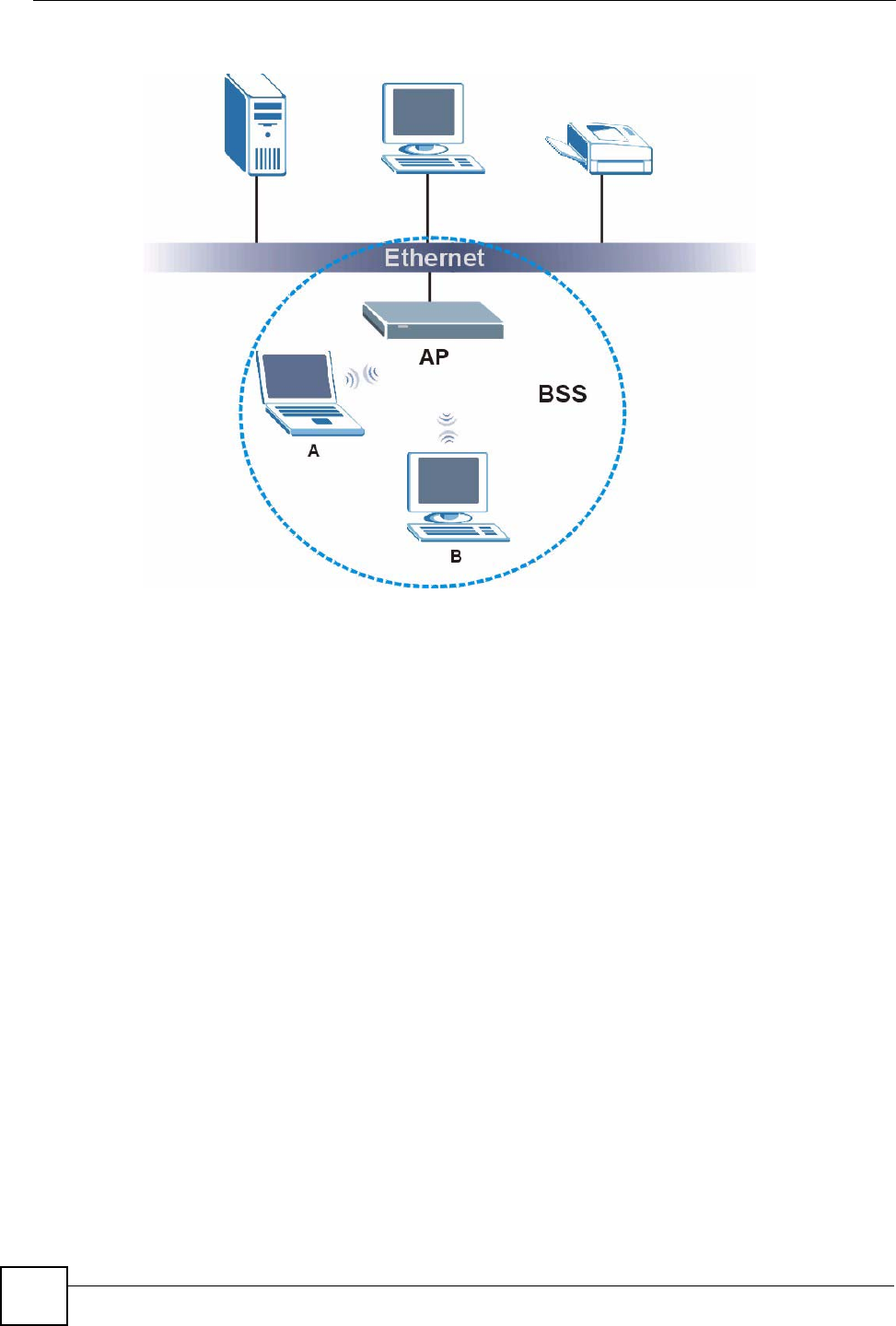
Appendix B Wireless LANs
V630 User’s Guide
180
Figure 175 Basic Service Set
ESS
An Extended Service Set (ESS) consists of a series of overlapping BSSs, each containing an
access point, with each access point connected together by a wired network. This wired
connection between APs is called a Distribution System (DS).
This type of wireless LAN topology is called an Infrastructure WLAN. The Access Points not
only provide communication with the wired network but also mediate wireless network traffic
in the immediate neighborhood.
An ESSID (ESS IDentification) uniquely identifies each ESS. All access points and their
associated wireless clients within the same ESS must have the same ESSID in order to
communicate.
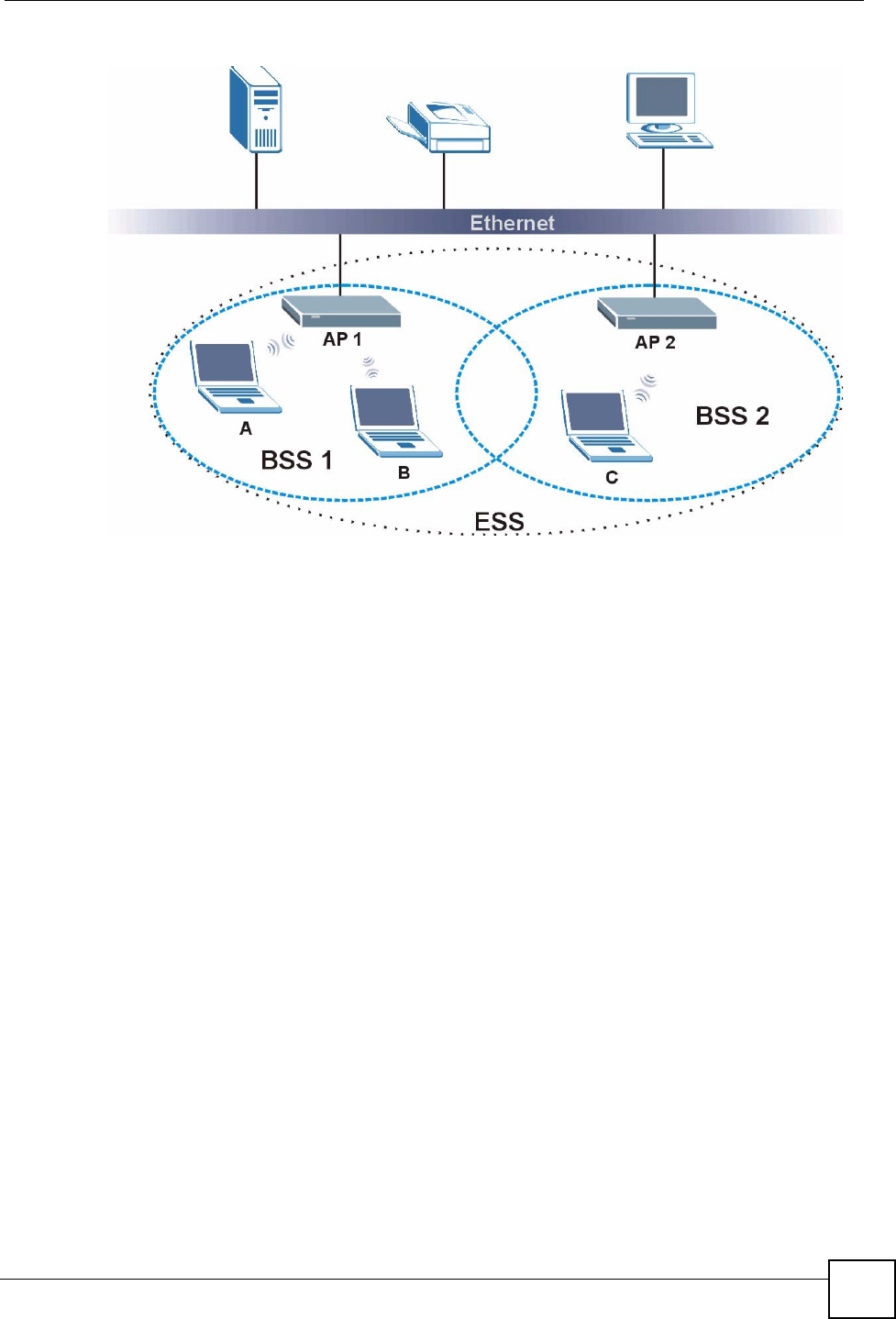
Appendix B Wireless LANs
V630 User’s Guide 181
Figure 176 Infrastructure WLAN
Channel
A channel is the radio frequency(ies) used by wireless devices to transmit and receive data.
Channels available depend on your geographical area. You may have a choice of channels (for
your region) so you should use a channel different from an adjacent AP (access point) to
reduce interference. Interference occurs when radio signals from different access points
overlap causing interference and degrading performance.
Adjacent channels partially overlap however. To avoid interference due to overlap, your AP
should be on a channel at least five channels away from a channel that an adjacent AP is using.
For example, if your region has 11 channels and an adjacent AP is using channel 1, then you
need to select a channel between 6 or 11.
RTS/CTS
A hidden node occurs when two stations are within range of the same access point, but are not
within range of each other. The following figure illustrates a hidden node. Both stations (STA)
are within range of the access point (AP) or wireless gateway, but out-of-range of each other,
so they cannot "hear" each other, that is they do not know if the channel is currently being
used. Therefore, they are considered hidden from each other.
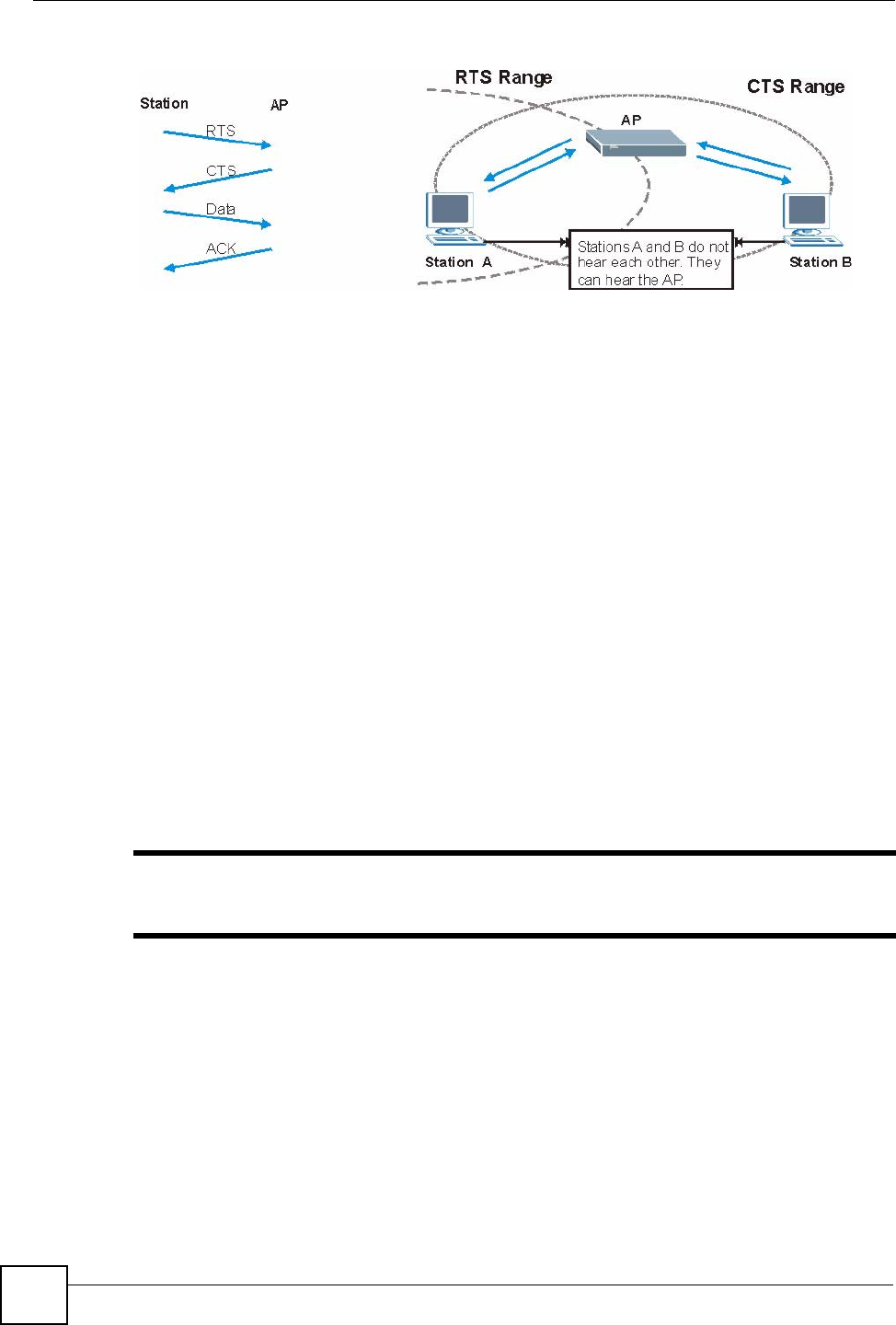
Appendix B Wireless LANs
V630 User’s Guide
182
Figure 177 RTS/CTS
When station A sends data to the AP, it might not know that the station B is already using the
channel. If these two stations send data at the same time, collisions may occur when both sets
of data arrive at the AP at the same time, resulting in a loss of messages for both stations.
RTS/CTS is designed to prevent collisions due to hidden nodes. An RTS/CTS defines the
biggest size data frame you can send before an RTS (Request To Send)/CTS (Clear to Send)
handshake is invoked.
When a data frame exceeds the RTS/CTS value you set (between 0 to 2432 bytes), the station
that wants to transmit this frame must first send an RTS (Request To Send) message to the AP
for permission to send it. The AP then responds with a CTS (Clear to Send) message to all
other stations within its range to notify them to defer their transmission. It also reserves and
confirms with the requesting station the time frame for the requested transmission.
Stations can send frames smaller than the specified RTS/CTS directly to the AP without the
RTS (Request To Send)/CTS (Clear to Send) handshake.
You should only configure RTS/CTS if the possibility of hidden nodes exists on your network
and the "cost" of resending large frames is more than the extra network overhead involved in
the RTS (Request To Send)/CTS (Clear to Send) handshake.
If the RTS/CTS value is greater than the Fragmentation Threshold value (see next), then the
RTS (Request To Send)/CTS (Clear to Send) handshake will never occur as data frames will
be fragmented before they reach RTS/CTS size.
"Enabling the RTS Threshold causes redundant network overhead that could
negatively affect the throughput performance instead of providing a remedy.
Fragmentation Threshold
A Fragmentation Threshold is the maximum data fragment size (between 256 and 2432
bytes) that can be sent in the wireless network before the AP will fragment the packet into
smaller data frames.
A large Fragmentation Threshold is recommended for networks not prone to interference
while you should set a smaller threshold for busy networks or networks that are prone to
interference.

Appendix B Wireless LANs
V630 User’s Guide 183
If the Fragmentation Threshold value is smaller than the RTS/CTS value (see previously)
you set then the RTS (Request To Send)/CTS (Clear to Send) handshake will never occur as
data frames will be fragmented before they reach RTS/CTS size.
Preamble Type
Preamble is used to signal that data is coming to the receiver. Short and long refer to the length
of the synchronization field in a packet.
Short preamble increases performance as less time sending preamble means more time for
sending data. All IEEE 802.11 compliant wireless adapters support long preamble, but not all
support short preamble.
Use long preamble if you are unsure what preamble mode other wireless devices on the
network support, and to provide more reliable communications in busy wireless networks.
Use short preamble if you are sure all wireless devices on the network support it, and to
provide more efficient communications.
Use the dynamic setting to automatically use short preamble when all wireless devices on the
network support it, otherwise the V630 uses long preamble.
"The wireless devices MUST use the same preamble mode in order to
communicate.
IEEE 802.11g Wireless LAN
IEEE 802.11g is fully compatible with the IEEE 802.11b standard. This means an IEEE
802.11b adapter can interface directly with an IEEE 802.11g access point (and vice versa) at
11 Mbps or lower depending on range. IEEE 802.11g has several intermediate rate steps
between the maximum and minimum data rates. The IEEE 802.11g data rate and modulation
are as follows:
Wireless Security Overview
Wireless security is vital to your network to protect wireless communication between wireless
clients, access points and the wired network.
Table 112 IEEE 802.11g
DATA RATE (MBPS) MODULATION
1 DBPSK (Differential Binary Phase Shift Keyed)
2 DQPSK (Differential Quadrature Phase Shift Keying)
5.5 / 11 CCK (Complementary Code Keying)
6/9/12/18/24/36/48/54 OFDM (Orthogonal Frequency Division Multiplexing)

Appendix B Wireless LANs
V630 User’s Guide
184
Wireless security methods available on the V630 are data encryption, wireless client
authentication, restricting access by device MAC address and hiding the V630 identity.
The following figure shows the relative effectiveness of these wireless security methods
available on your V630.
"You must enable the same wireless security settings on the V630 and on all
wireless clients that you want to associate with it.
IEEE 802.1x
In June 2001, the IEEE 802.1x standard was designed to extend the features of IEEE 802.11 to
support extended authentication as well as providing additional accounting and control
features. It is supported by Windows XP and a number of network devices. Some advantages
of IEEE 802.1x are:
• User based identification that allows for roaming.
• Support for RADIUS (Remote Authentication Dial In User Service, RFC 2138, 2139) for
centralized user profile and accounting management on a network RADIUS server.
• Support for EAP (Extensible Authentication Protocol, RFC 2486) that allows additional
authentication methods to be deployed with no changes to the access point or the wireless
clients.
RADIUS
RADIUS is based on a client-server model that supports authentication, authorization and
accounting. The access point is the client and the server is the RADIUS server. The RADIUS
server handles the following tasks:
• Authentication
Determines the identity of the users.
• Authorization
Table 113 Wireless Security Levels
SECURITY
LEVEL SECURITY TYPE
Least
S e c u r e
Most Secure
Unique SSID (Default)
Unique SSID with Hide SSID Enabled
MAC Address Filtering
WEP Encryption
IEEE802.1x EAP with RADIUS Server Authentication
Wi-Fi Protected Access (WPA)
WPA2

Appendix B Wireless LANs
V630 User’s Guide 185
Determines the network services available to authenticated users once they are connected
to the network.
• Accounting
Keeps track of the client’s network activity.
RADIUS is a simple package exchange in which your AP acts as a message relay between the
wireless client and the network RADIUS server.
Types of RADIUS Messages
The following types of RADIUS messages are exchanged between the access point and the
RADIUS server for user authentication:
• Access-Request
Sent by an access point requesting authentication.
• Access-Reject
Sent by a RADIUS server rejecting access.
• Access-Accept
Sent by a RADIUS server allowing access.
• Access-Challenge
Sent by a RADIUS server requesting more information in order to allow access. The
access point sends a proper response from the user and then sends another Access-Request
message.
The following types of RADIUS messages are exchanged between the access point and the
RADIUS server for user accounting:
• Accounting-Request
Sent by the access point requesting accounting.
• Accounting-Response
Sent by the RADIUS server to indicate that it has started or stopped accounting.
In order to ensure network security, the access point and the RADIUS server use a shared
secret key, which is a password, they both know. The key is not sent over the network. In
addition to the shared key, password information exchanged is also encrypted to protect the
network from unauthorized access.
Types of EAP Authentication
This section discusses some popular authentication types: EAP-MD5, EAP-TLS, EAP-TTLS,
PEAP and LEAP. Your wireless LAN device may not support all authentication types.
EAP (Extensible Authentication Protocol) is an authentication protocol that runs on top of the
IEEE 802.1x transport mechanism in order to support multiple types of user authentication. By
using EAP to interact with an EAP-compatible RADIUS server, an access point helps a
wireless station and a RADIUS server perform authentication.
The type of authentication you use depends on the RADIUS server and an intermediary AP(s)
that supports IEEE 802.1x. .

Appendix B Wireless LANs
V630 User’s Guide
186
For EAP-TLS authentication type, you must first have a wired connection to the network and
obtain the certificate(s) from a certificate authority (CA). A certificate (also called digital IDs)
can be used to authenticate users and a CA issues certificates and guarantees the identity of
each certificate owner.
EAP-MD5 (Message-Digest Algorithm 5)
MD5 authentication is the simplest one-way authentication method. The authentication server
sends a challenge to the wireless client. The wireless client ‘proves’ that it knows the password
by encrypting the password with the challenge and sends back the information. Password is
not sent in plain text.
However, MD5 authentication has some weaknesses. Since the authentication server needs to
get the plaintext passwords, the passwords must be stored. Thus someone other than the
authentication server may access the password file. In addition, it is possible to impersonate an
authentication server as MD5 authentication method does not perform mutual authentication.
Finally, MD5 authentication method does not support data encryption with dynamic session
key. You must configure WEP encryption keys for data encryption.
EAP-TLS (Transport Layer Security)
With EAP-TLS, digital certifications are needed by both the server and the wireless clients for
mutual authentication. The server presents a certificate to the client. After validating the
identity of the server, the client sends a different certificate to the server. The exchange of
certificates is done in the open before a secured tunnel is created. This makes user identity
vulnerable to passive attacks. A digital certificate is an electronic ID card that authenticates the
sender’s identity. However, to implement EAP-TLS, you need a Certificate Authority (CA) to
handle certificates, which imposes a management overhead.
EAP-TTLS (Tunneled Transport Layer Service)
EAP-TTLS is an extension of the EAP-TLS authentication that uses certificates for only the
server-side authentications to establish a secure connection. Client authentication is then done
by sending username and password through the secure connection, thus client identity is
protected. For client authentication, EAP-TTLS supports EAP methods and legacy
authentication methods such as PAP, CHAP, MS-CHAP and MS-CHAP v2.
PEAP (Protected EAP)
Like EAP-TTLS, server-side certificate authentication is used to establish a secure connection,
then use simple username and password methods through the secured connection to
authenticate the clients, thus hiding client identity. However, PEAP only supports EAP
methods, such as EAP-MD5, EAP-MSCHAPv2 and EAP-GTC (EAP-Generic Token Card),
for client authentication. EAP-GTC is implemented only by Cisco.
LEAP
LEAP (Lightweight Extensible Authentication Protocol) is a Cisco implementation of IEEE
802.1x.

Appendix B Wireless LANs
V630 User’s Guide 187
Dynamic WEP Key Exchange
The AP maps a unique key that is generated with the RADIUS server. This key expires when
the wireless connection times out, disconnects or reauthentication times out. A new WEP key
is generated each time reauthentication is performed.
If this feature is enabled, it is not necessary to configure a default encryption key in the
wireless security configuration screen. You may still configure and store keys, but they will
not be used while dynamic WEP is enabled.
"EAP-MD5 cannot be used with Dynamic WEP Key Exchange
For added security, certificate-based authentications (EAP-TLS, EAP-TTLS and PEAP) use
dynamic keys for data encryption. They are often deployed in corporate environments, but for
public deployment, a simple user name and password pair is more practical. The following
table is a comparison of the features of authentication types.
WPA and WPA2
Wi-Fi Protected Access (WPA) is a subset of the IEEE 802.11i standard. WPA2 (IEEE
802.11i) is a wireless security standard that defines stronger encryption, authentication and
key management than WPA.
Key differences between WPA or WPA2 and WEP are improved data encryption and user
authentication.
If both an AP and the wireless clients support WPA2 and you have an external RADIUS
server, use WPA2 for stronger data encryption. If you don't have an external RADIUS server,
you should use WPA2-PSK (WPA2-Pre-Shared Key) that only requires a single (identical)
password entered into each access point, wireless gateway and wireless client. As long as the
passwords match, a wireless client will be granted access to a WLAN.
If the AP or the wireless clients do not support WPA2, just use WPA or WPA-PSK depending
on whether you have an external RADIUS server or not.
Select WEP only when the AP and/or wireless clients do not support WPA or WPA2. WEP is
less secure than WPA or WPA2.
Table 114 Comparison of EAP Authentication Types
EAP-MD5 EAP-TLS EAP-TTLS PEAP LEAP
Mutual Authentication No Yes Yes Yes Yes
Certificate – Client No Yes Optional Optional No
Certificate – Server No Yes Yes Yes No
Dynamic Key Exchange No Yes Yes Yes Yes
Credential Integrity None Strong Strong Strong Moderate
Deployment Difficulty Easy Hard Moderate Moderate Moderate
Client Identity Protection No No Yes Yes No

Appendix B Wireless LANs
V630 User’s Guide
188
Encryption
Both WPA and WPA2 improve data encryption by using Temporal Key Integrity Protocol
(TKIP), Message Integrity Check (MIC) and IEEE 802.1x. WPA and WPA2 use Advanced
Encryption Standard (AES) in the Counter mode with Cipher block chaining Message
authentication code Protocol (CCMP) to offer stronger encryption than TKIP.
TKIP uses 128-bit keys that are dynamically generated and distributed by the authentication
server. AES (Advanced Encryption Standard) is a block cipher that uses a 256-bit
mathematical algorithm called Rijndael. They both include a per-packet key mixing function,
a Message Integrity Check (MIC) named Michael, an extended initialization vector (IV) with
sequencing rules, and a re-keying mechanism.
WPA and WPA2 regularly change and rotate the encryption keys so that the same encryption
key is never used twice.
The RADIUS server distributes a Pairwise Master Key (PMK) key to the AP that then sets up
a key hierarchy and management system, using the PMK to dynamically generate unique data
encryption keys to encrypt every data packet that is wirelessly communicated between the AP
and the wireless clients. This all happens in the background automatically.
The Message Integrity Check (MIC) is designed to prevent an attacker from capturing data
packets, altering them and resending them. The MIC provides a strong mathematical function
in which the receiver and the transmitter each compute and then compare the MIC. If they do
not match, it is assumed that the data has been tampered with and the packet is dropped.
By generating unique data encryption keys for every data packet and by creating an integrity
checking mechanism (MIC), with TKIP and AES it is more difficult to decrypt data on a Wi-Fi
network than WEP and difficult for an intruder to break into the network.
The encryption mechanisms used for WPA(2) and WPA(2)-PSK are the same. The only
difference between the two is that WPA(2)-PSK uses a simple common password, instead of
user-specific credentials. The common-password approach makes WPA(2)-PSK susceptible to
brute-force password-guessing attacks but it’s still an improvement over WEP as it employs a
consistent, single, alphanumeric password to derive a PMK which is used to generate unique
temporal encryption keys. This prevent all wireless devices sharing the same encryption keys.
(a weakness of WEP)
User Authentication
WPA and WPA2 apply IEEE 802.1x and Extensible Authentication Protocol (EAP) to
authenticate wireless clients using an external RADIUS database. WPA2 reduces the number
of key exchange messages from six to four (CCMP 4-way handshake) and shortens the time
required to connect to a network. Other WPA2 authentication features that are different from
WPA include key caching and pre-authentication. These two features are optional and may not
be supported in all wireless devices.
Key caching allows a wireless client to store the PMK it derived through a successful
authentication with an AP. The wireless client uses the PMK when it tries to connect to the
same AP and does not need to go with the authentication process again.
Pre-authentication enables fast roaming by allowing the wireless client (already connecting to
an AP) to perform IEEE 802.1x authentication with another AP before connecting to it.
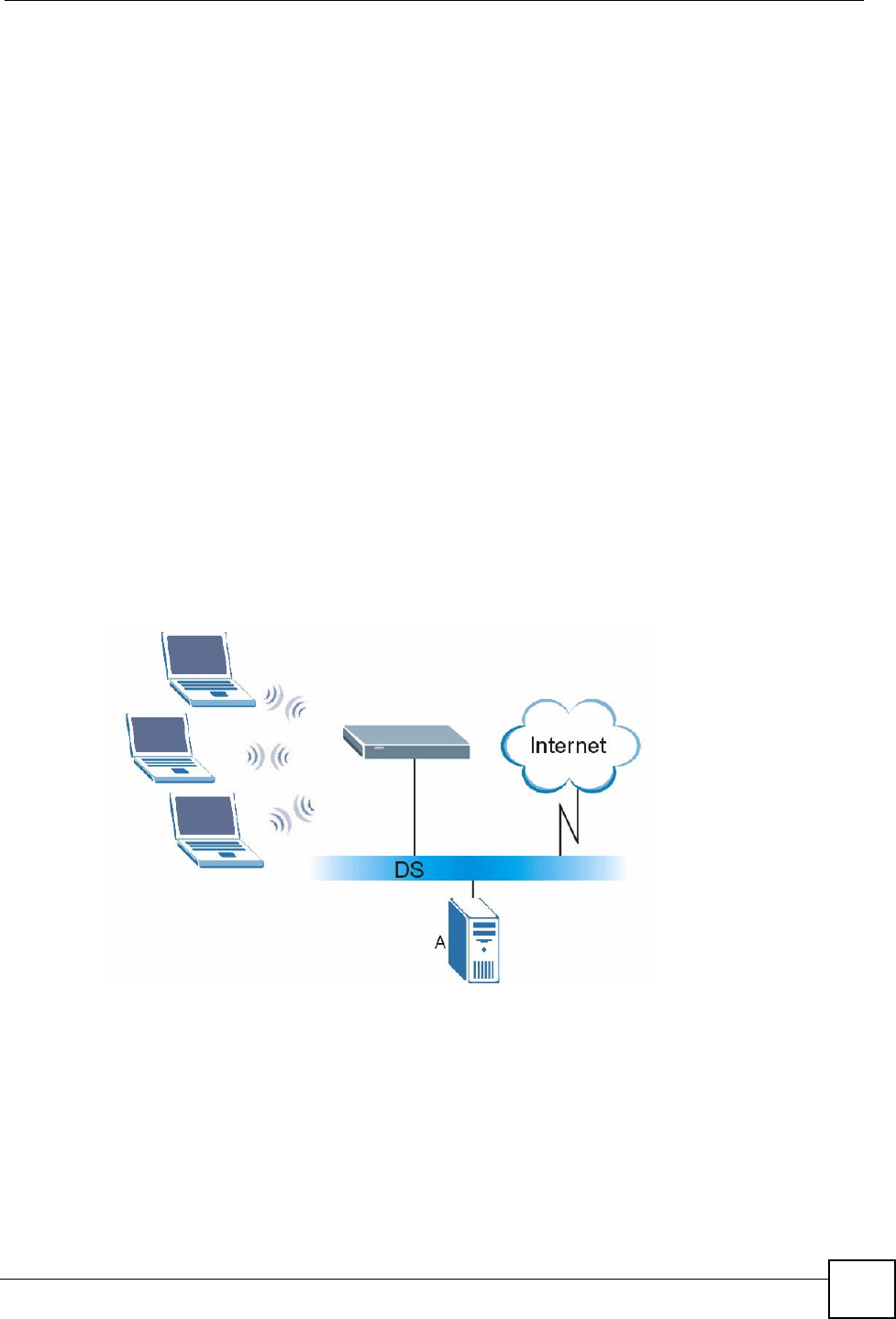
Appendix B Wireless LANs
V630 User’s Guide 189
Wireless Client WPA Supplicants
A wireless client supplicant is the software that runs on an operating system instructing the
wireless client how to use WPA. At the time of writing, the most widely available supplicant is
the WPA patch for Windows XP, Funk Software's Odyssey client.
The Windows XP patch is a free download that adds WPA capability to Windows XP's built-in
"Zero Configuration" wireless client. However, you must run Windows XP to use it.
WPA(2) with RADIUS Application Example
To set up WPA(2), you need the IP address of the RADIUS server, its port number (default is
1812), and the RADIUS shared secret. A WPA(2) application example with an external
RADIUS server looks as follows. "A" is the RADIUS server. "DS" is the distribution system.
1The AP passes the wireless client's authentication request to the RADIUS server.
2The RADIUS server then checks the user's identification against its database and grants
or denies network access accordingly.
3A 256-bit Pairwise Master Key (PMK) is derived from the authentication process by the
RADIUS server and the client.
4The RADIUS server distributes the PMK to the AP. The AP then sets up a key hierarchy
and management system, using the PMK to dynamically generate unique data encryption
keys. The keys are used to encrypt every data packet that is wirelessly communicated
between the AP and the wireless clients.
Figure 178 WPA(2) with RADIUS Application Example
WPA(2)-PSK Application Example
A WPA(2)-PSK application looks as follows.
1First enter identical passwords into the AP and all wireless clients. The Pre-Shared Key
(PSK) must consist of between 8 and 63 ASCII characters or 64 hexadecimal characters
(including spaces and symbols).
2The AP checks each wireless client's password and allows it to join the network only if
the password matches.
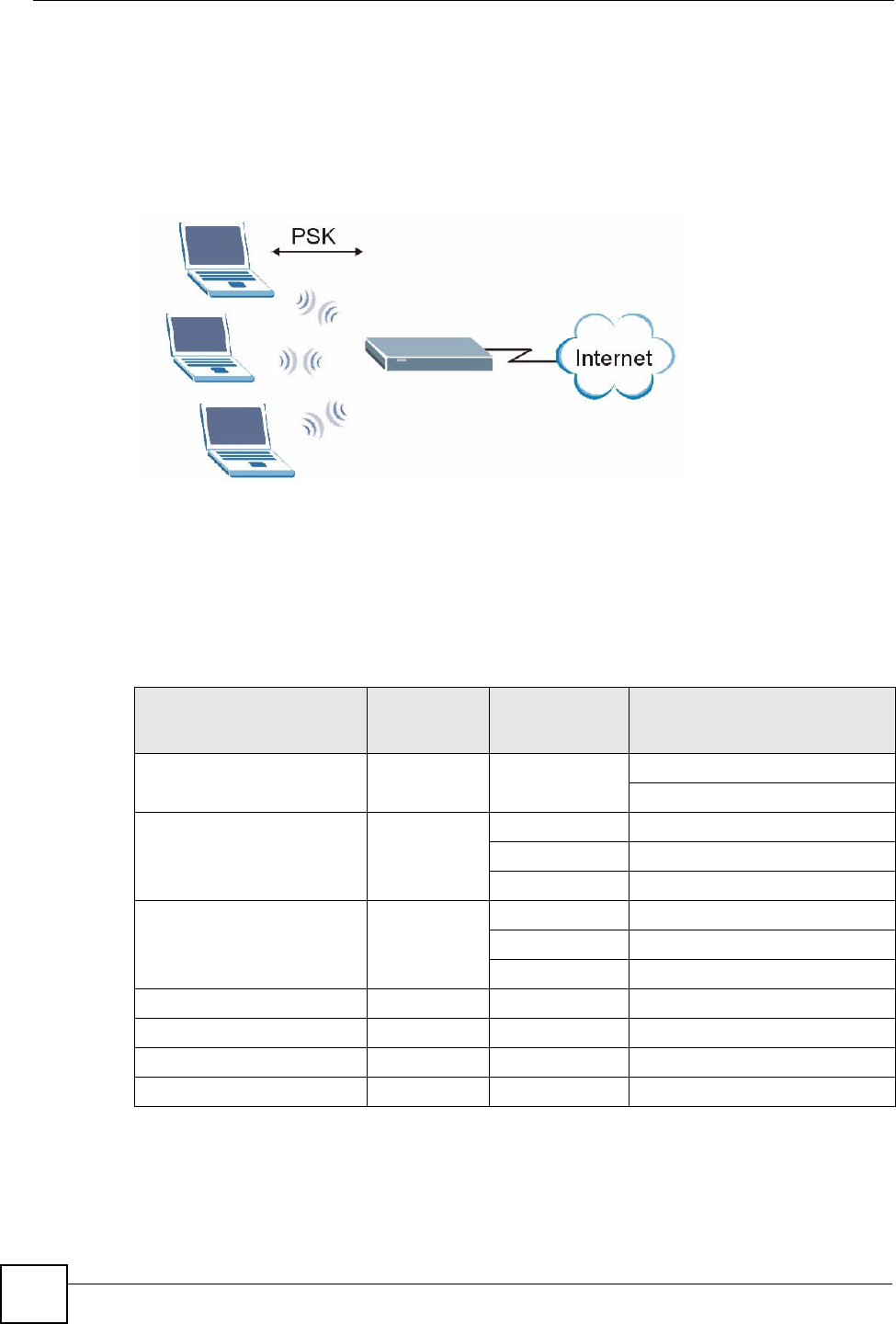
Appendix B Wireless LANs
V630 User’s Guide
190
3The AP and wireless clients generate a common PMK (Pairwise Master Key). The key
itself is not sent over the network, but is derived from the PSK and the SSID.
4The AP and wireless clients use the TKIP or AES encryption process, the PMK and
information exchanged in a handshake to create temporal encryption keys. They use
these keys to encrypt data exchanged between them.
Figure 179 WPA(2)-PSK Authentication
Security Parameters Summary
Refer to this table to see what other security parameters you should configure for each
authentication method or key management protocol type. MAC address filters are not
dependent on how you configure these security features.
Table 115 Wireless Security Relational Matrix
AUTHENTICATION
METHOD/ KEY
MANAGEMENT PROTOCOL
ENCRYPTIO
N METHOD ENTER
MANUAL KEY IEEE 802.1X
Open None No Disable
Enable without Dynamic WEP Key
Open WEP No Enable with Dynamic WEP Key
Yes Enable without Dynamic WEP Key
Yes Disable
Shared WEP No Enable with Dynamic WEP Key
Yes Enable without Dynamic WEP Key
Yes Disable
WPA TKIP/AES No Enable
WPA-PSK TKIP/AES Yes Disable
WPA2 TKIP/AES No Enable
WPA2-PSK TKIP/AES Yes Disable

Appendix B Wireless LANs
V630 User’s Guide 191
WPS Details
Your V630 supports WiFi Protected Setup (WPS), which is an easy way to set up a secure
wireless network. WPS is an industry standard specification, defined by the WiFi Alliance.
WPS allows you to quickly set up a wireless network with strong security, without having to
configure security settings manually. Each WPS connection works between two devices. Both
devices must support WPS (check each device’s documentation to make sure).
Depending on the devices you have, you can either press a button (on the device itself, or in its
configuration utility) or enter a PIN (a unique Personal Identification Number that allows one
device to authenticate the other) in each of the two devices. When WPS is activated on a
device, it has two minutes to find another device that also has WPS activated. Then, the two
devices connect and set up a secure network by themselves.
Push Button Configuration
WPS Push Button Configuration (PBC) is initiated by pressing a button on each WPS-enabled
device, and allowing them to connect automatically. You do not need to enter any information.
Not every WPS-enabled device has a physical WPS button. Some may have a WPS PBC
button in their configuration utilities instead of or in addition to the physical button.
Take the following steps to set up WPS using the button.
1Ensure that the two devices you want to set up are within wireless range of one another.
2Look for a WPS button on each device. If the device does not have one, log into its
configuration utility and locate the button (see the device’s User’s Guide for how to do
this).
3Press the button on one of the devices (it doesn’t matter which).
4Within two minutes, press the button on the other device. The registrar sends the network
name (SSID) and security key through an secure connection to the enrollee.
If you need to make sure that WPS worked, check the list of associated wireless clients in the
AP’s configuration utility. If you see the wireless client in the list, WPS was successful.
PIN Configuration
Each WPS-enabled device has its own PIN (Personal Identification Number). This may either
be static (it cannot be changed) or dynamic (you can change it to a new random number by
clicking on a button in the configuration interface).
When you use the PIN method, you must enter the enrollee’s PIN into the registrar. Then,
when WPS is activated on the enrollee, it presents its PIN to the registrar. If the PIN matches,
the registrar sends the network and security information to the enrollee, allowing it to join the
network.
The advantage of using the PIN method rather than the PBC method is that you can ensure that
the connection is established between the devices you specify, not just the first two devices to
activate WPS in the area. However, you need to log into the configuration interfaces of both
devices.
Take the following steps to set up WPS using the PIN method.
1Decide which device you want to be the registrar (usually the AP) and which you want to
be the enrollee (usually the client).

Appendix B Wireless LANs
V630 User’s Guide
192
2Look for the enrollee’s WPS PIN; it may be displayed on the device. If you don’t see it,
log into the enrollee’s configuration interface and locate the PIN - see the device’s User’s
Guide for how to do this. Select the PIN connection mode (not PBC connection mode).
3Log into the configuration utility of the registrar. Select the PIN connection mode (not
the PBC connection mode). Locate the place where you can enter the enrollee’s PIN.
Enter the PIN from the enrollee device.
4Activate WPS on both devices within two minutes.
"Use the configuration utility to activate WPS, not the push-button on the device
itself.
5On a computer connected to the wireless client, try to connect to the Internet. If you can
connect, WPS was successful.
If you cannot connect, check the list of associated wireless clients in the AP’s
configuration utility. If you see the wireless client in the list, WPS was successful.
The following figure shows a WPS-enabled wireless client (installed in a notebook computer)
connecting to the WPS-enabled AP via the PIN method.
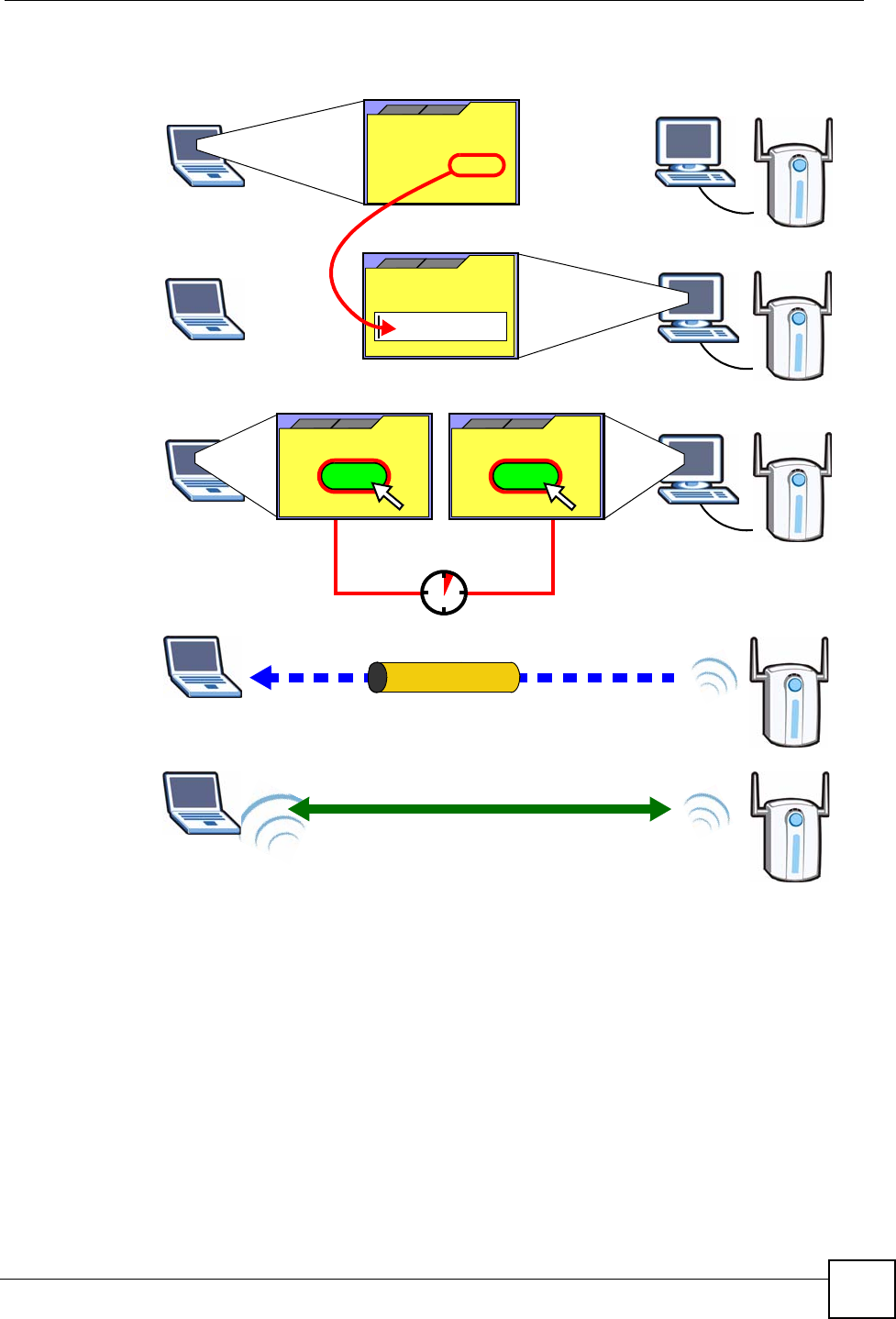
Appendix B Wireless LANs
V630 User’s Guide 193
Figure 180 Example WPS Process: PIN Method
How WPS Works
When two WPS-enabled devices connect, each device must assume a specific role. One device
acts as the registrar (the device that supplies network and security settings) and the other
device acts as the enrollee (the device that receives network and security settings. The registrar
creates a secure EAP (Extensible Authentication Protocol) tunnel and sends the network name
(SSID) and the WPA-PSK or WPA2-PSK pre-shared key to the enrollee. Whether WPA-PSK
or WPA2-PSK is used depends on the standards supported by the devices. If the registrar is
already part of a network, it sends the existing information. If not, it generates the SSID and
WPA(2)-PSK randomly.
The following figure shows a WPS-enabled client (installed in a notebook computer)
connecting to a WPS-enabled access point.
ENROLLEE
SECURE EAP TUNNEL
SSID
WPA(2)-PSK
WITHIN 2 MINUTES
COMMUNICATION
This device’s
WPS
Enter WPS PIN
WPS
from other device:
WPS PIN: 123456
WPS
START
WPS
START
REGISTRAR
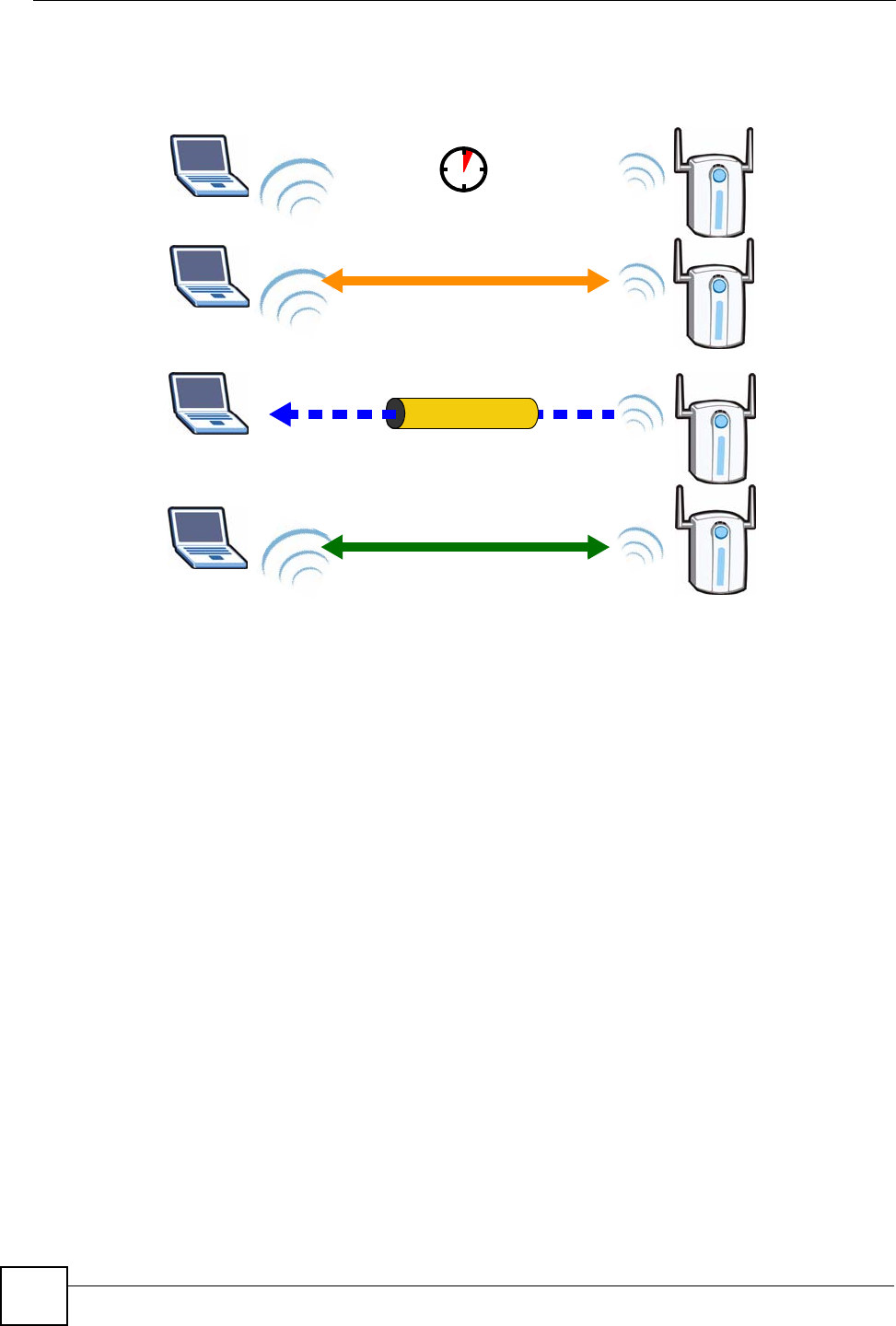
Appendix B Wireless LANs
V630 User’s Guide
194
Figure 181 How WPS works
The roles of registrar and enrollee last only as long as the WPS setup process is active (two
minutes). The next time you use WPS, a different device can be the registrar if necessary.
The WPS connection process is like a handshake; only two devices participate in each WPS
transaction. If you want to add more devices you should repeat the process with one of the
existing networked devices and the new device.
Note that the access point (AP) is not always the registrar, and the wireless client is not always
the enrollee. All WPS-certified APs can be a registrar, and so can some WPS-enabled wireless
clients.
By default, a WPS devices is “unconfigured”. This means that it is not part of an existing
network and can act as either enrollee or registrar (if it supports both functions). If the registrar
is unconfigured, the security settings it transmits to the enrollee are randomly-generated. Once
a WPS-enabled device has connected to another device using WPS, it becomes “configured”.
A configured wireless client can still act as enrollee or registrar in subsequent WPS
connections, but a configured access point can no longer act as enrollee. It will be the registrar
in all subsequent WPS connections in which it is involved. If you want a configured AP to act
as an enrollee, you must reset it to its factory defaults.
Example WPS Network Setup
This section shows how security settings are distributed in an example WPS setup.
SECURE TUNNEL
SECURITY INFO
WITHIN 2 MINUTES
COMMUNICATION
ACTIVATE
WPS
ACTIVATE
WPS
WPS HANDSHAKE
REGISTRAR
ENROLLEE
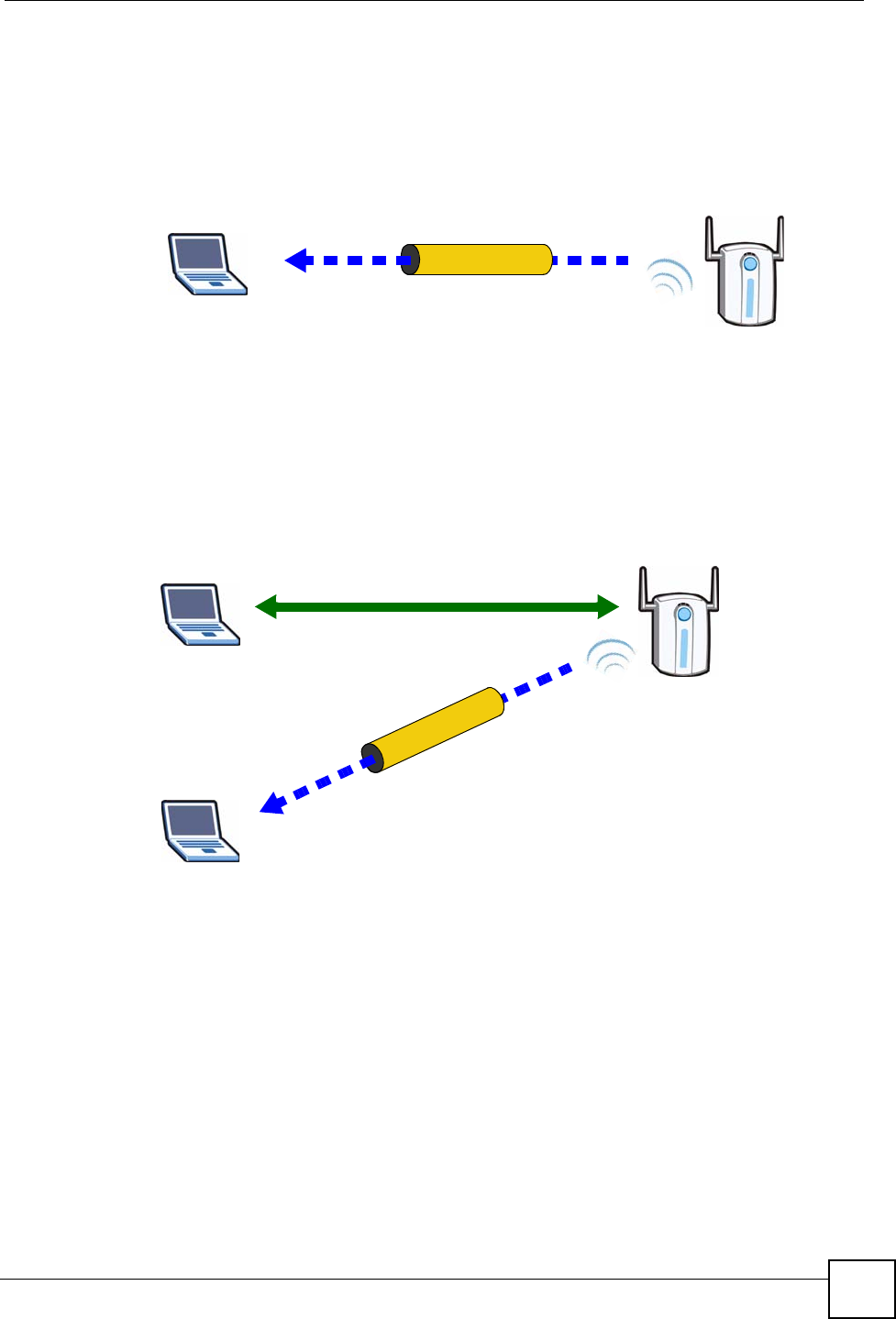
Appendix B Wireless LANs
V630 User’s Guide 195
The following figure shows an example network. In step 1, both AP1 and Client 1 are
unconfigured. When WPS is activated on both, they perform the handshake. In this example,
AP1 is the registrar, and Client 1 is the enrollee. The registrar randomly generates the security
information to set up the network, since it is unconfigured and has no existing information.
Figure 182 WPS: Example Network Step 1
In step 2, you add another wireless client to the network. You know that Client 1 supports
registrar mode, but it is better to use AP1 for the WPS handshake with the new client since
you must connect to the access point anyway in order to use the network. In this case, AP1
must be the registrar, since it is configured (it already has security information for the
network). AP1 supplies the existing security information to Client 2.
Figure 183 WPS: Example Network Step 2
In step 3, you add another access point (AP2) to your network. AP2 is out of range of AP1, so
you cannot use AP1 for the WPS handshake with the new access point. However, you know
that Client 2 supports the registrar function, so you use it to perform the WPS handshake
instead.
REGISTRARENROLLEE
SECURITY INFO
CLIENT 1 AP1
REGISTRAR
CLIENT 1 AP1
ENROLLEE
CLIENT 2
EXISTING CONNECTION
SECURITY INFO
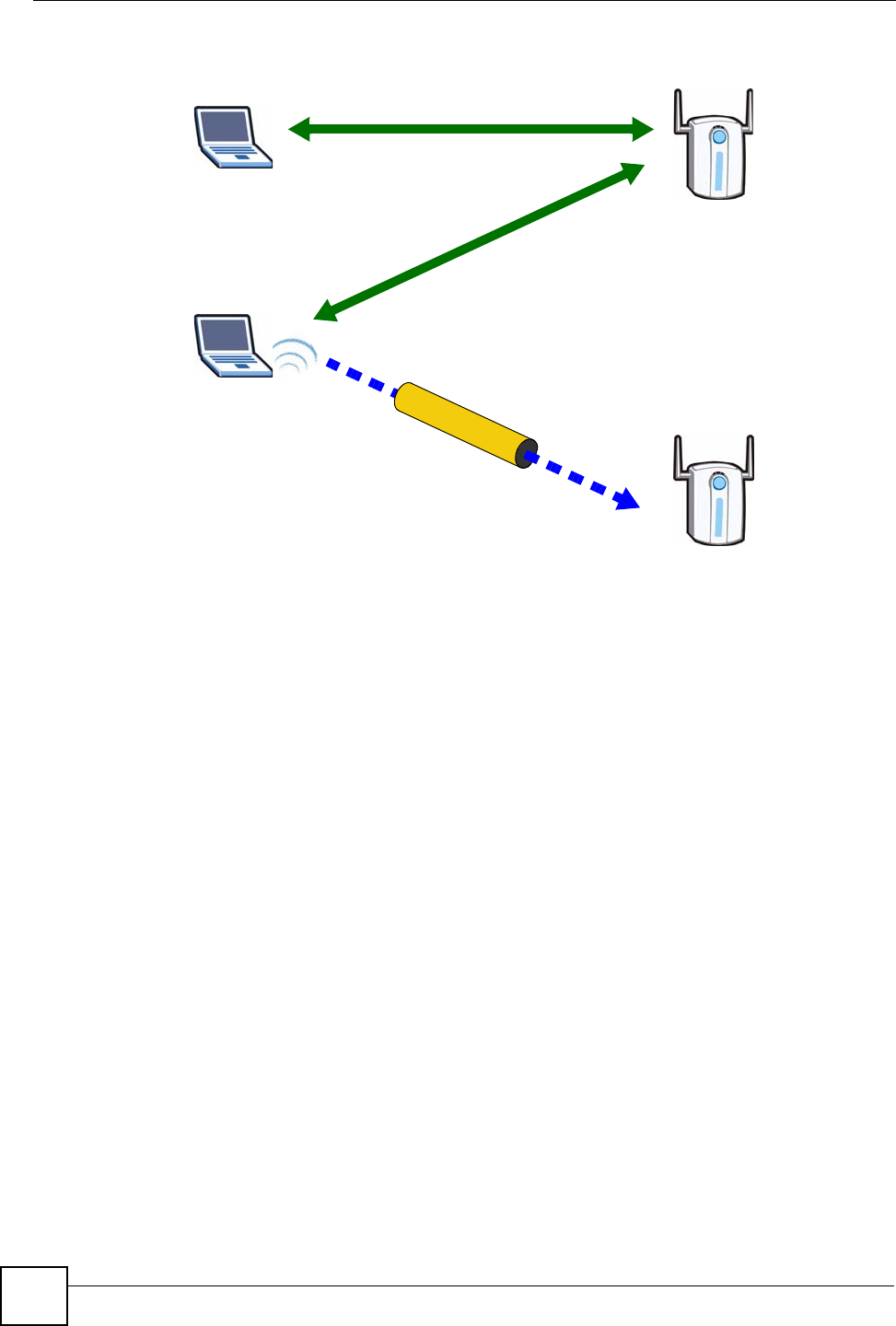
Appendix B Wireless LANs
V630 User’s Guide
196
Figure 184 WPS: Example Network Step 3
Limitations of WPS
WPS has some limitations of which you should be aware.
• WPS works in Infrastructure networks only (where an AP and a wireless client
communicate). It does not work in Ad-Hoc networks (where there is no AP).
• When you use WPS, it works between two devices only. You cannot enroll multiple
devices simultaneously, you must enroll one after the other.
For instance, if you have two enrollees and one registrar you must set up the first enrollee
(by pressing the WPS button on the registrar and the first enrollee, for example), then
check that it successfully enrolled, then set up the second device in the same way.
• WPS works only with other WPS-enabled devices. However, you can still add non-WPS
devices to a network you already set up using WPS.
WPS works by automatically issuing a randomly-generated WPA-PSK or WPA2-PSK
pre-shared key from the registrar device to the enrollee devices. Whether the network uses
WPA-PSK or WPA2-PSK depends on the device. You can check the configuration
interface of the registrar device to discover the key the network is using (if the device
supports this feature). Then, you can enter the key into the non-WPS device and join the
network as normal (the non-WPS device must also support WPA-PSK or WPA2-PSK).
• When you use the PBC method, there is a short period (from the moment you press the
button on one device to the moment you press the button on the other device) when any
WPS-enabled device could join the network. This is because the registrar has no way of
identifying the “correct” enrollee, and cannot differentiate between your enrollee and a
rogue device. This is a possible way for a hacker to gain access to a network.
CLIENT 1 AP1
REGISTRAR
CLIENT 2
EXISTING CONNECTION
SECURITY INFO
ENROLLEE
AP1
EXISTING CONNECTION

Appendix B Wireless LANs
V630 User’s Guide 197
You can easily check to see if this has happened. WPS works between only two devices
simultaneously, so if another device has enrolled your device will be unable to enroll, and
will not have access to the network. If this happens, open the access point’s configuration
interface and look at the list of associated clients (usually displayed by MAC address). It
does not matter if the access point is the WPS registrar, the enrollee, or was not involved
in the WPS handshake; a rogue device must still associate with the access point to gain
access to the network. Check the MAC addresses of your wireless clients (usually printed
on a label on the bottom of the device). If there is an unknown MAC address you can
remove it or reset the AP.

Appendix B Wireless LANs
V630 User’s Guide
198

V630 User’s Guide 199
APPENDIX C
Pop-up Windows, JavaScripts
and Java Permissions
In order to use the web configurator you need to allow:
• Web browser pop-up windows from your device.
• JavaScripts (enabled by default).
• Java permissions (enabled by default).
"Internet Explorer 6 screens are used here. Screens for other Internet Explorer
versions may vary.
Internet Explorer Pop-up Blockers
You may have to disable pop-up blocking to log into your device.
Either disable pop-up blocking (enabled by default in Windows XP SP (Service Pack) 2) or
allow pop-up blocking and create an exception for your device’s IP address.
Disable Pop-up Blockers
1In Internet Explorer, select Tools, Pop-up Blocker and then select Turn Off Pop-up
Blocker.
Figure 185 Pop-up Blocker
You can also check if pop-up blocking is disabled in the Pop-up Blocker section in the
Privacy tab.
1In Internet Explorer, select Tools, Internet Options, Privacy.

Appendix C Pop-up Windows, JavaScripts and Java Permissions
V630 User’s Guide
200
2Clear the Block pop-ups check box in the Pop-up Blocker section of the screen. This
disables any web pop-up blockers you may have enabled.
Figure 186 Internet Options: Privacy
3Click Apply to save this setting.
Enable Pop-up Blockers with Exceptions
Alternatively, if you only want to allow pop-up windows from your device, see the following
steps.
1In Internet Explorer, select Tools, Internet Options and then the Privacy tab.
2Select Settings…to open the Pop-up Blocker Settings screen.
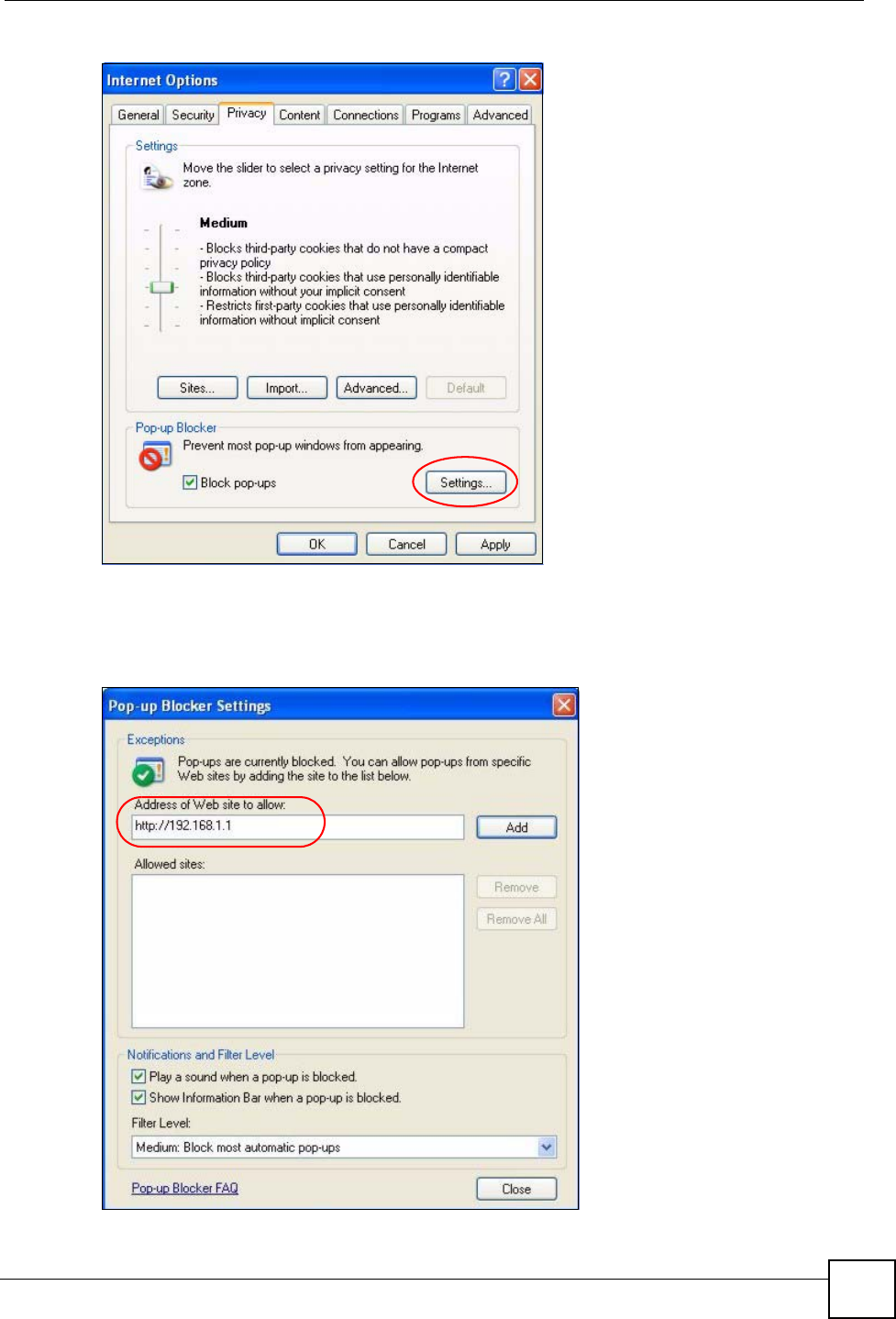
Appendix C Pop-up Windows, JavaScripts and Java Permissions
V630 User’s Guide 201
Figure 187 Internet Options: Privacy
3Type the IP address of your device (the web page that you do not want to have blocked)
with the prefix “http://”. For example, http://192.168.167.1.
4Click Add to move the IP address to the list of Allowed sites.
Figure 188 Pop-up Blocker Settings
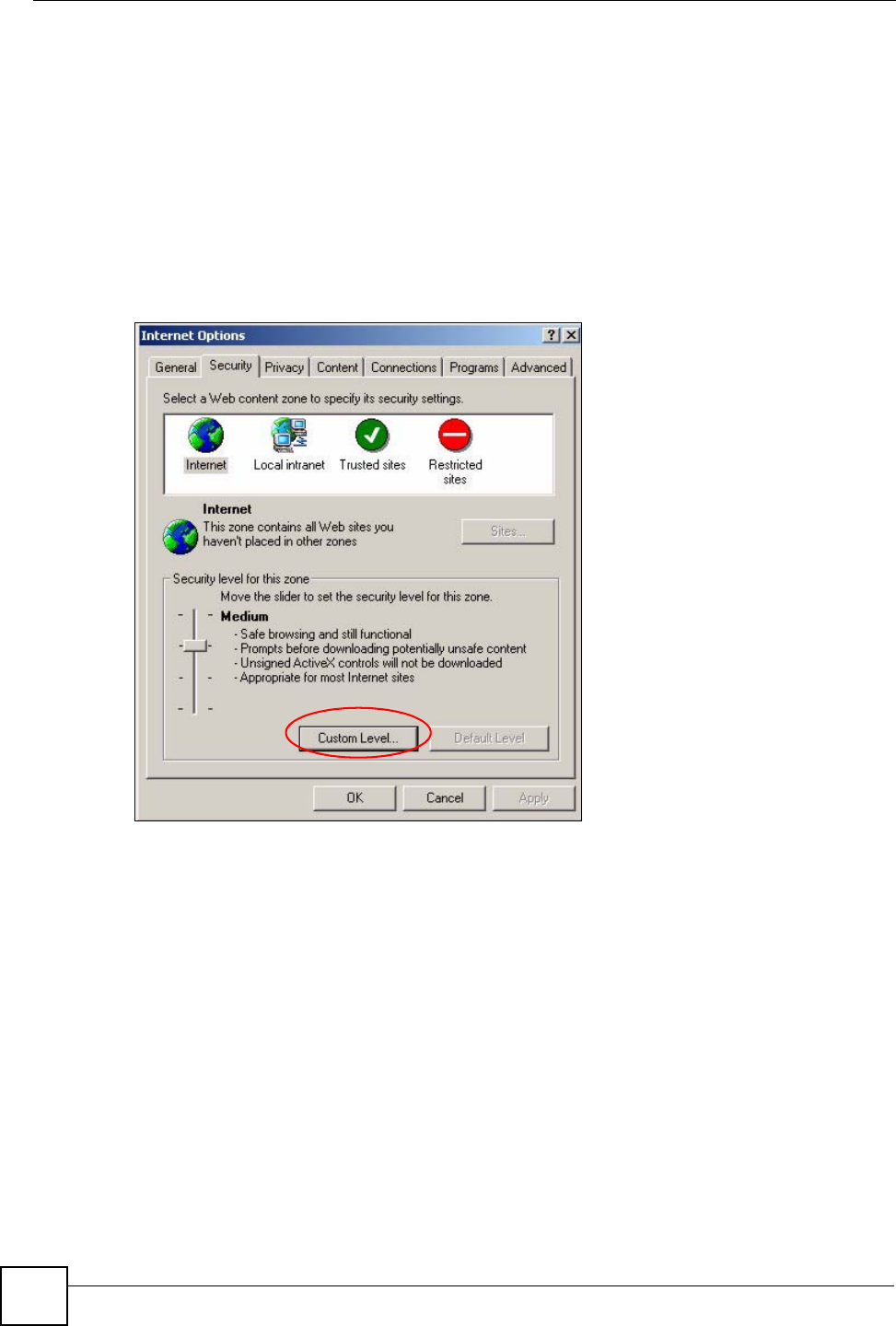
Appendix C Pop-up Windows, JavaScripts and Java Permissions
V630 User’s Guide
202
5Click Close to return to the Privacy screen.
6Click Apply to save this setting.
JavaScripts
If pages of the web configurator do not display properly in Internet Explorer, check that
JavaScripts are allowed.
1In Internet Explorer, click Tools, Internet Options and then the Security tab.
Figure 189 Internet Options: Security
2Click the Custom Level... button.
3Scroll down to Scripting.
4Under Active scripting make sure that Enable is selected (the default).
5Under Scripting of Java applets make sure that Enable is selected (the default).
6Click OK to close the window.
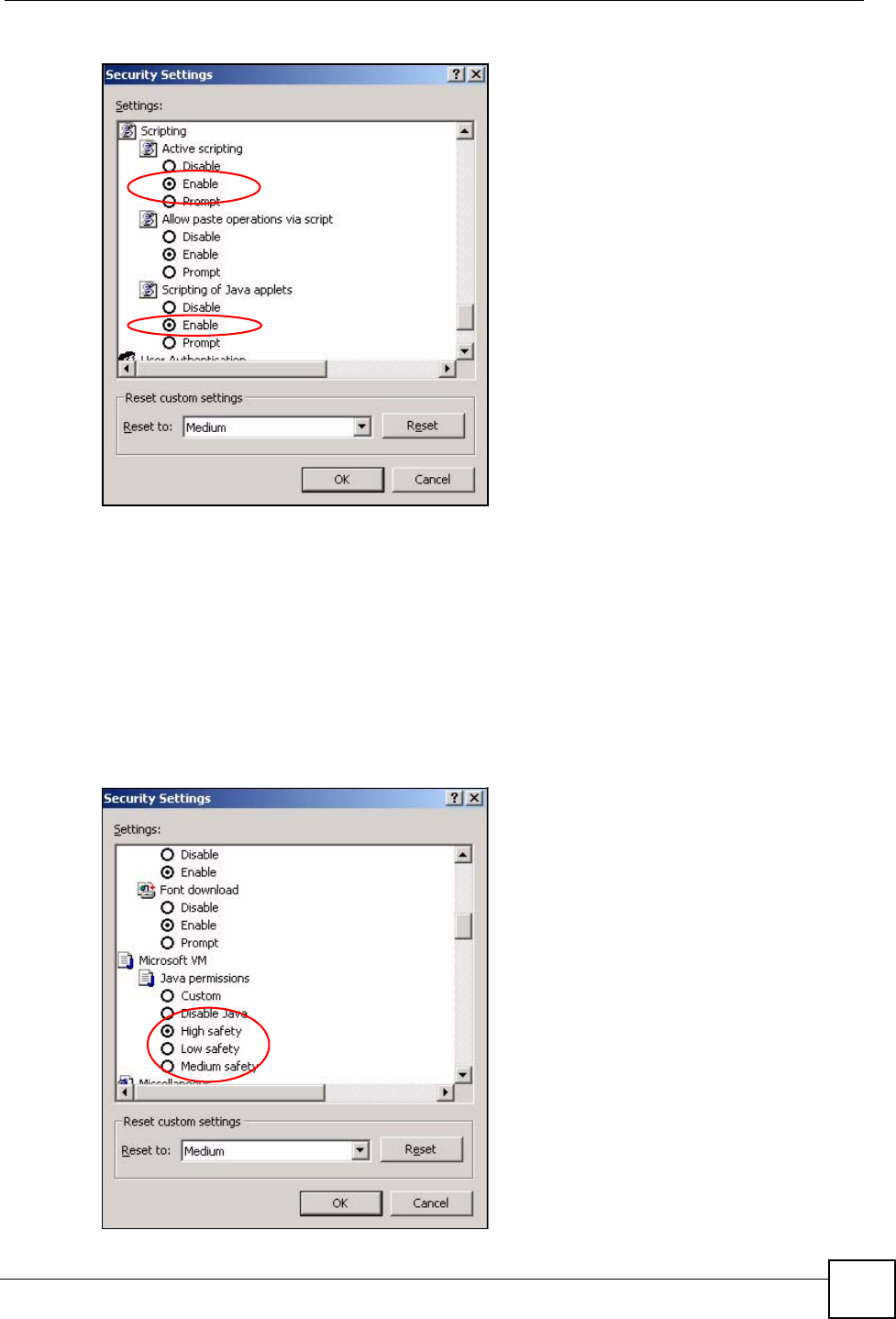
Appendix C Pop-up Windows, JavaScripts and Java Permissions
V630 User’s Guide 203
Figure 190 Security Settings - Java Scripting
Java Permissions
1From Internet Explorer, click Tools, Internet Options and then the Security tab.
2Click the Custom Level... button.
3Scroll down to Microsoft VM.
4Under Java permissions make sure that a safety level is selected.
5Click OK to close the window.
Figure 191 Security Settings - Java
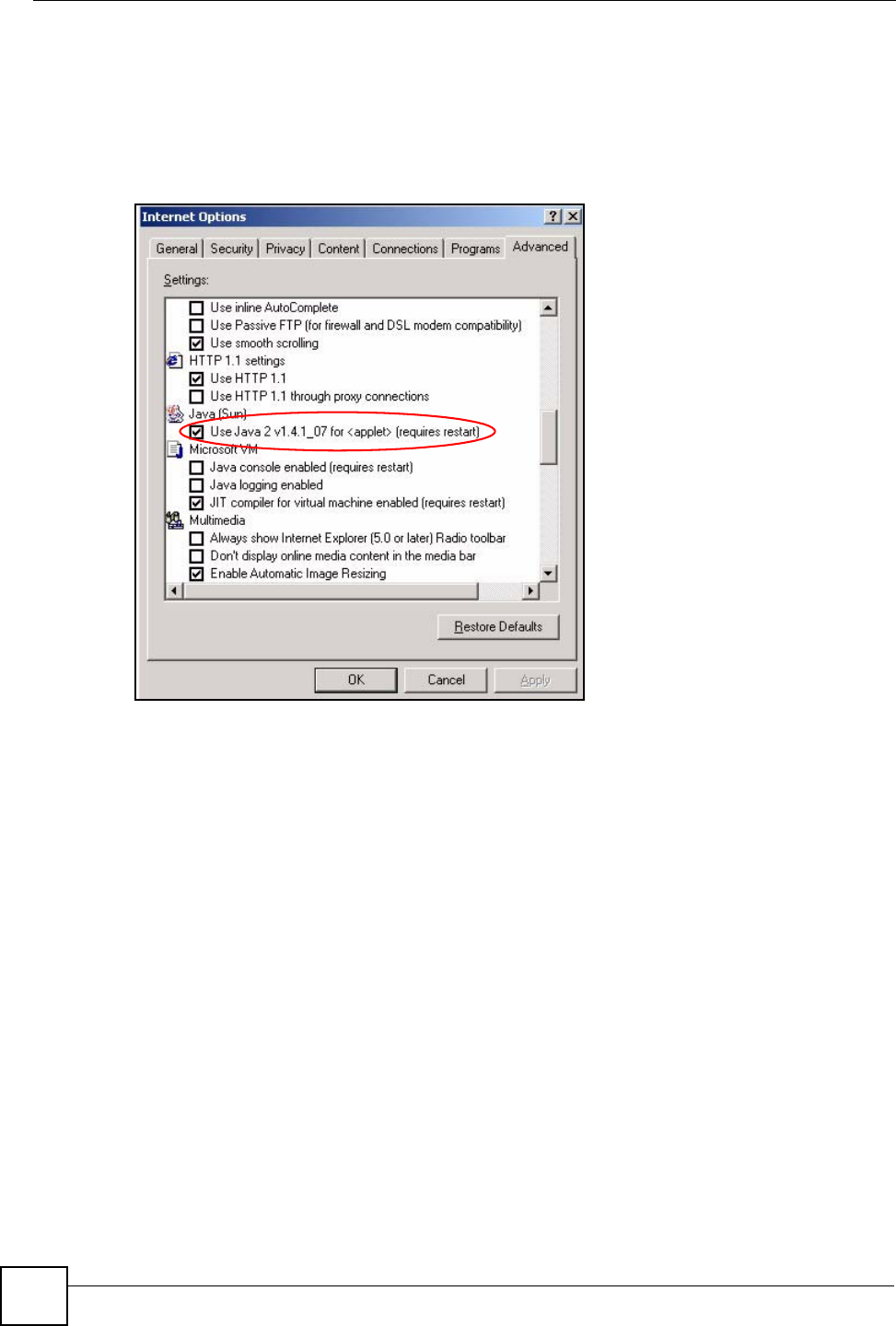
Appendix C Pop-up Windows, JavaScripts and Java Permissions
V630 User’s Guide
204
JAVA (Sun)
1From Internet Explorer, click Tools, Internet Options and then the Advanced tab.
2Make sure that Use Java 2 for <applet> under Java (Sun) is selected.
3Click OK to close the window.
Figure 192 Java (Sun)
Mozilla Firefox
Mozilla Firefox 2.0 screens are used here. Screens for other versions may vary.
You can enable Java, Javascripts and pop-ups in one screen. Click Tools, then click Options in
the screen that appears.
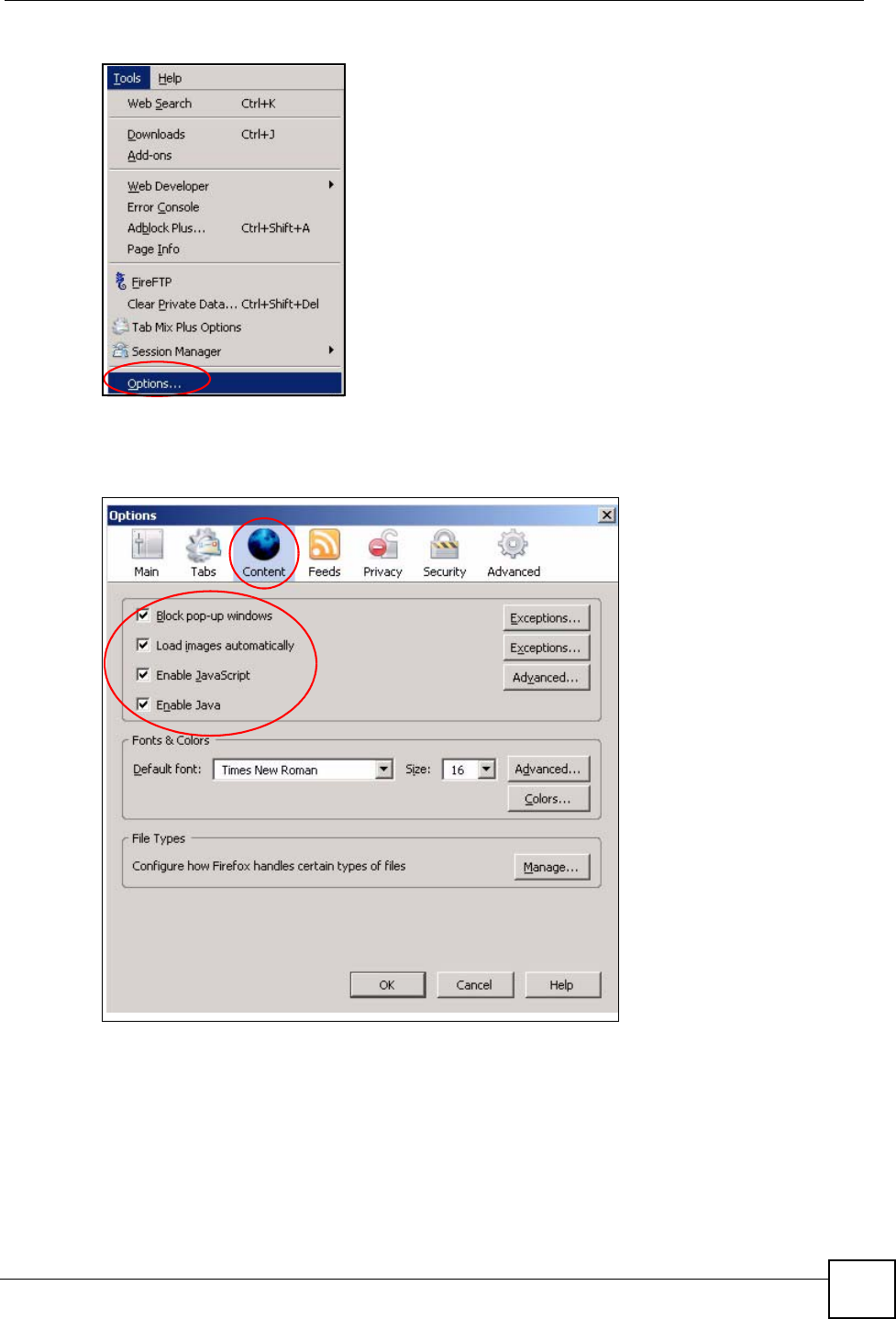
Appendix C Pop-up Windows, JavaScripts and Java Permissions
V630 User’s Guide 205
Figure 193 Mozilla Firefox: Tools > Options
Click Content.to show the screen below. Select the check boxes as shown in the following
screen.
Figure 194 Mozilla Firefox Content Security

Appendix C Pop-up Windows, JavaScripts and Java Permissions
V630 User’s Guide
206

V630 User’s Guide 207
APPENDIX D
IP Addresses and Subnetting
This appendix introduces IP addresses and subnet masks.
IP addresses identify individual devices on a network. Every networking device (including
computers, servers, routers, printers, etc.) needs an IP address to communicate across the
network. These networking devices are also known as hosts.
Subnet masks determine the maximum number of possible hosts on a network. You can also
use subnet masks to divide one network into multiple sub-networks.
Introduction to IP Addresses
One part of the IP address is the network number, and the other part is the host ID. In the same
way that houses on a street share a common street name, the hosts on a network share a
common network number. Similarly, as each house has its own house number, each host on the
network has its own unique identifying number - the host ID. Routers use the network number
to send packets to the correct network, while the host ID determines to which host on the
network the packets are delivered.
Structure
An IP address is made up of four parts, written in dotted decimal notation (for example,
192.168.1.1). Each of these four parts is known as an octet. An octet is an eight-digit binary
number (for example 11000000, which is 192 in decimal notation).
Therefore, each octet has a possible range of 00000000 to 11111111 in binary, or 0 to 255 in
decimal.
The following figure shows an example IP address in which the first three octets (192.168.1)
are the network number, and the fourth octet (16) is the host ID.
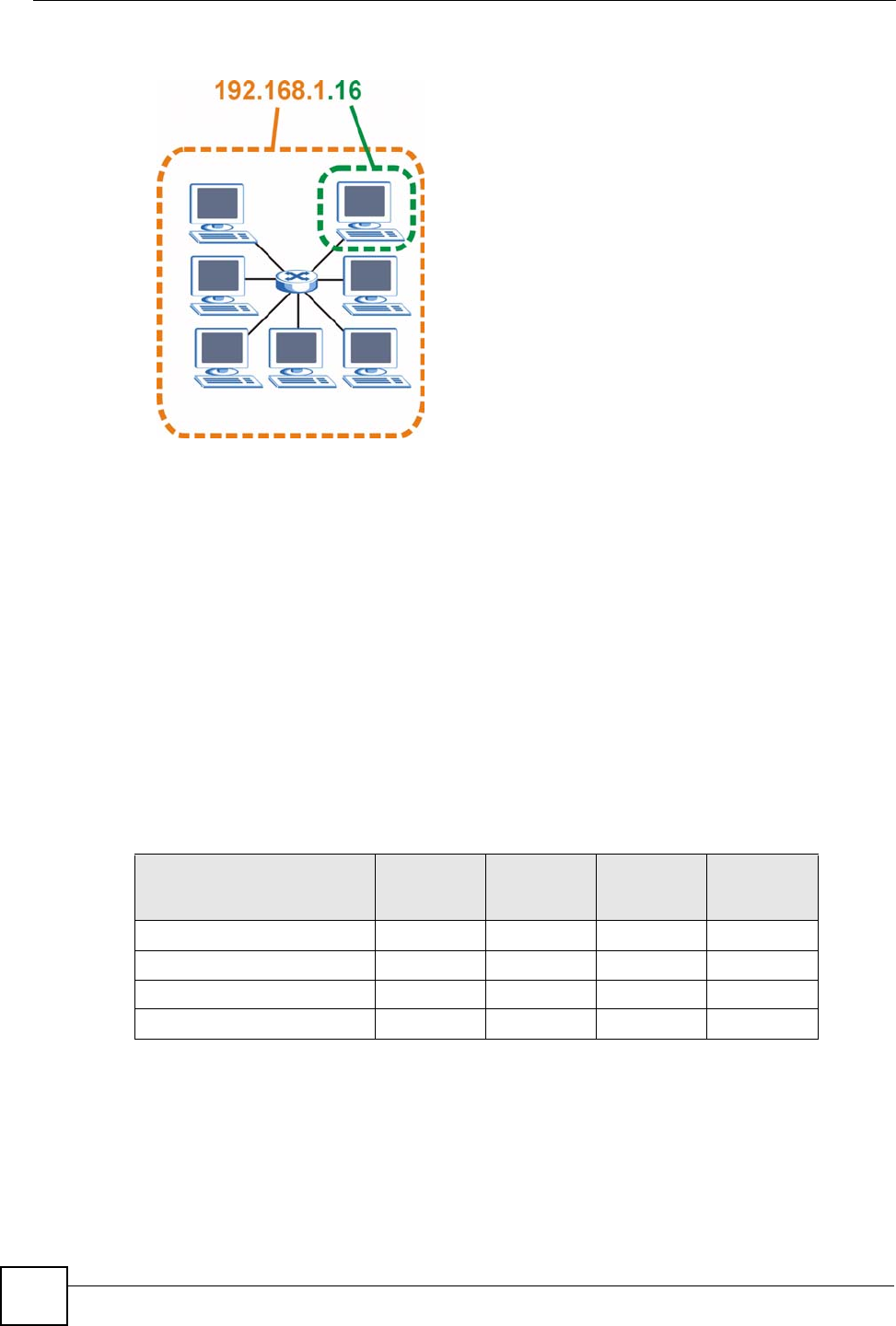
Appendix D IP Addresses and Subnetting
V630 User’s Guide
208
Figure 195 Network Number and Host ID
How much of the IP address is the network number and how much is the host ID varies
according to the subnet mask.
Subnet Masks
A subnet mask is used to determine which bits are part of the network number, and which bits
are part of the host ID (using a logical AND operation). The term “subnet” is short for “sub-
network”.
A subnet mask has 32 bits. If a bit in the subnet mask is a “1” then the corresponding bit in the
IP address is part of the network number. If a bit in the subnet mask is “0” then the
corresponding bit in the IP address is part of the host ID.
The following example shows a subnet mask identifying the network number (in bold text)
and host ID of an IP address (192.168.1.2 in decimal).
By convention, subnet masks always consist of a continuous sequence of ones beginning from
the leftmost bit of the mask, followed by a continuous sequence of zeros, for a total number of
32 bits.
Subnet masks can be referred to by the size of the network number part (the bits with a “1”
value). For example, an “8-bit mask” means that the first 8 bits of the mask are ones and the
remaining 24 bits are zeroes.
Table 116 IP Address Network Number and Host ID Example
1ST OCTET:
(192)
2ND
OCTET:
(168)
3RD
OCTET:
(1)
4TH OCTET
(2)
IP Address (Binary) 11000000 10101000 00000001 00000010
Subnet Mask (Binary) 11111111 11111111 11111111 00000000
Network Number 11000000 10101000 00000001
Host ID 00000010

Appendix D IP Addresses and Subnetting
V630 User’s Guide 209
Subnet masks are expressed in dotted decimal notation just like IP addresses. The following
examples show the binary and decimal notation for 8-bit, 16-bit, 24-bit and 29-bit subnet
masks.
Network Size
The size of the network number determines the maximum number of possible hosts you can
have on your network. The larger the number of network number bits, the smaller the number
of remaining host ID bits.
An IP address with host IDs of all zeros is the IP address of the network (192.168.1.0 with a
24-bit subnet mask, for example). An IP address with host IDs of all ones is the broadcast
address for that network (192.168.1.255 with a 24-bit subnet mask, for example).
As these two IP addresses cannot be used for individual hosts, calculate the maximum number
of possible hosts in a network as follows:
Notation
Since the mask is always a continuous number of ones beginning from the left, followed by a
continuous number of zeros for the remainder of the 32 bit mask, you can simply specify the
number of ones instead of writing the value of each octet. This is usually specified by writing
a “/” followed by the number of bits in the mask after the address.
For example, 192.1.1.0 /25 is equivalent to saying 192.1.1.0 with subnet mask
255.255.255.128.
The following table shows some possible subnet masks using both notations.
Table 117 Subnet Masks
BINARY
DECIMAL
1ST
OCTET 2ND
OCTET 3RD
OCTET 4TH OCTET
8-bit mask 11111111 00000000 00000000 00000000 255.0.0.0
16-bit mask 11111111 11111111 00000000 00000000 255.255.0.0
24-bit mask 11111111 11111111 11111111 00000000 255.255.255.0
29-bit mask 11111111 11111111 11111111 11111000 255.255.255.248
Table 118 Maximum Host Numbers
SUBNET MASK HOST ID SIZE MAXIMUM NUMBER OF HOSTS
8 bits 255.0.0.0 24 bits 224 – 2 16777214
16 bits 255.255.0.0 16 bits 216 – 2 65534
24 bits 255.255.255.0 8 bits 28 – 2 254
29 bits 255.255.255.248 3 bits 23 – 2 6
Table 119 Alternative Subnet Mask Notation
SUBNET MASK ALTERNATIVE
NOTATION LAST OCTET
(BINARY) LAST OCTET
(DECIMAL)
255.255.255.0 /24 0000 0000 0
255.255.255.128 /25 1000 0000 128
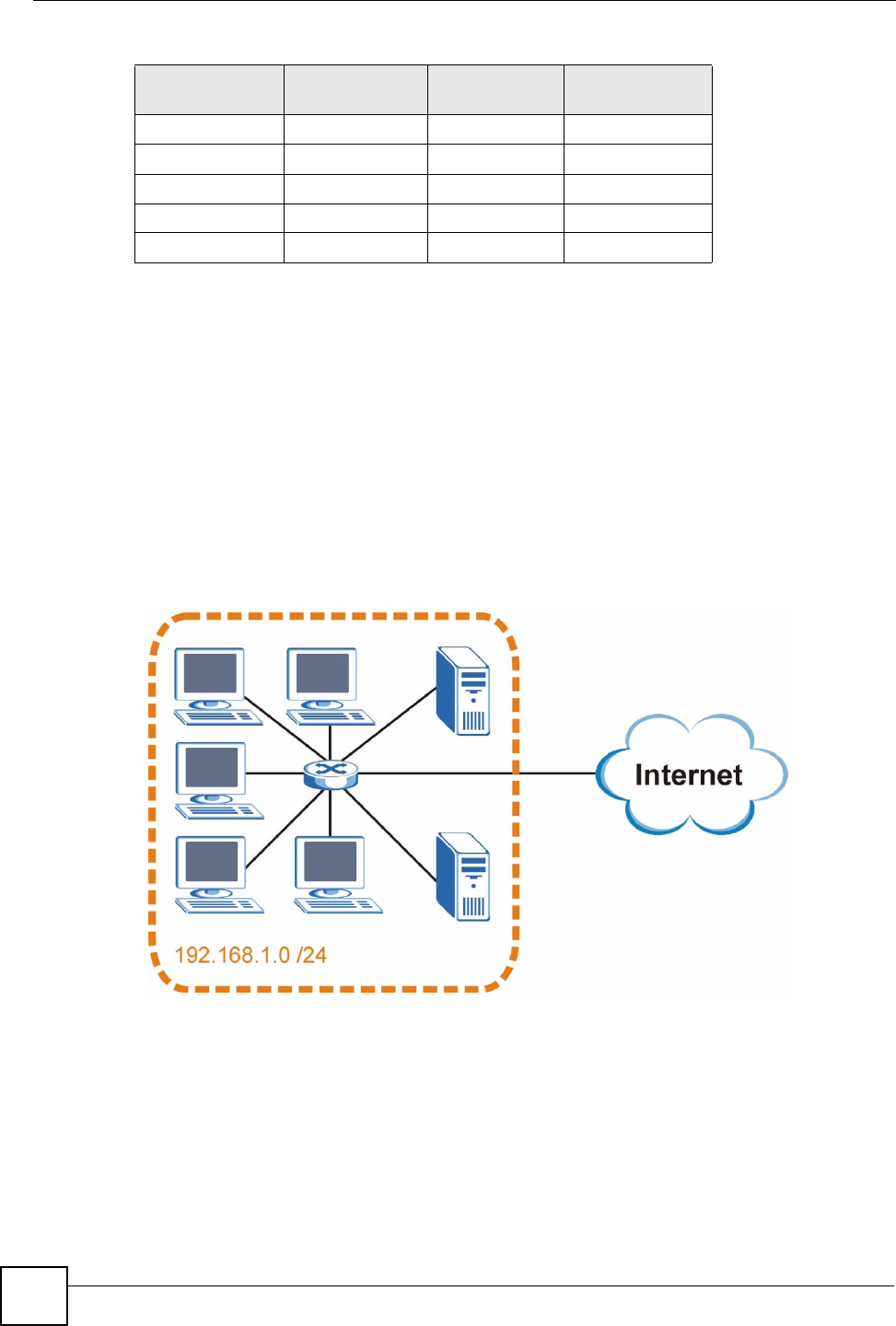
Appendix D IP Addresses and Subnetting
V630 User’s Guide
210
Subnetting
You can use subnetting to divide one network into multiple sub-networks. In the following
example a network administrator creates two sub-networks to isolate a group of servers from
the rest of the company network for security reasons.
In this example, the company network address is 192.168.1.0. The first three octets of the
address (192.168.1) are the network number, and the remaining octet is the host ID, allowing a
maximum of 28 – 2 or 254 possible hosts.
The following figure shows the company network before subnetting.
Figure 196 Subnetting Example: Before Subnetting
You can “borrow” one of the host ID bits to divide the network 192.168.1.0 into two separate
sub-networks. The subnet mask is now 25 bits (255.255.255.128 or /25).
The “borrowed” host ID bit can have a value of either 0 or 1, allowing two subnets;
192.168.1.0 /25 and 192.168.1.128 /25.
The following figure shows the company network after subnetting. There are now two sub-
networks, A and B.
255.255.255.192 /26 1100 0000 192
255.255.255.224 /27 1110 0000 224
255.255.255.240 /28 1111 0000 240
255.255.255.248 /29 1111 1000 248
255.255.255.252 /30 1111 1100 252
Table 119 Alternative Subnet Mask Notation (continued)
SUBNET MASK ALTERNATIVE
NOTATION LAST OCTET
(BINARY) LAST OCTET
(DECIMAL)
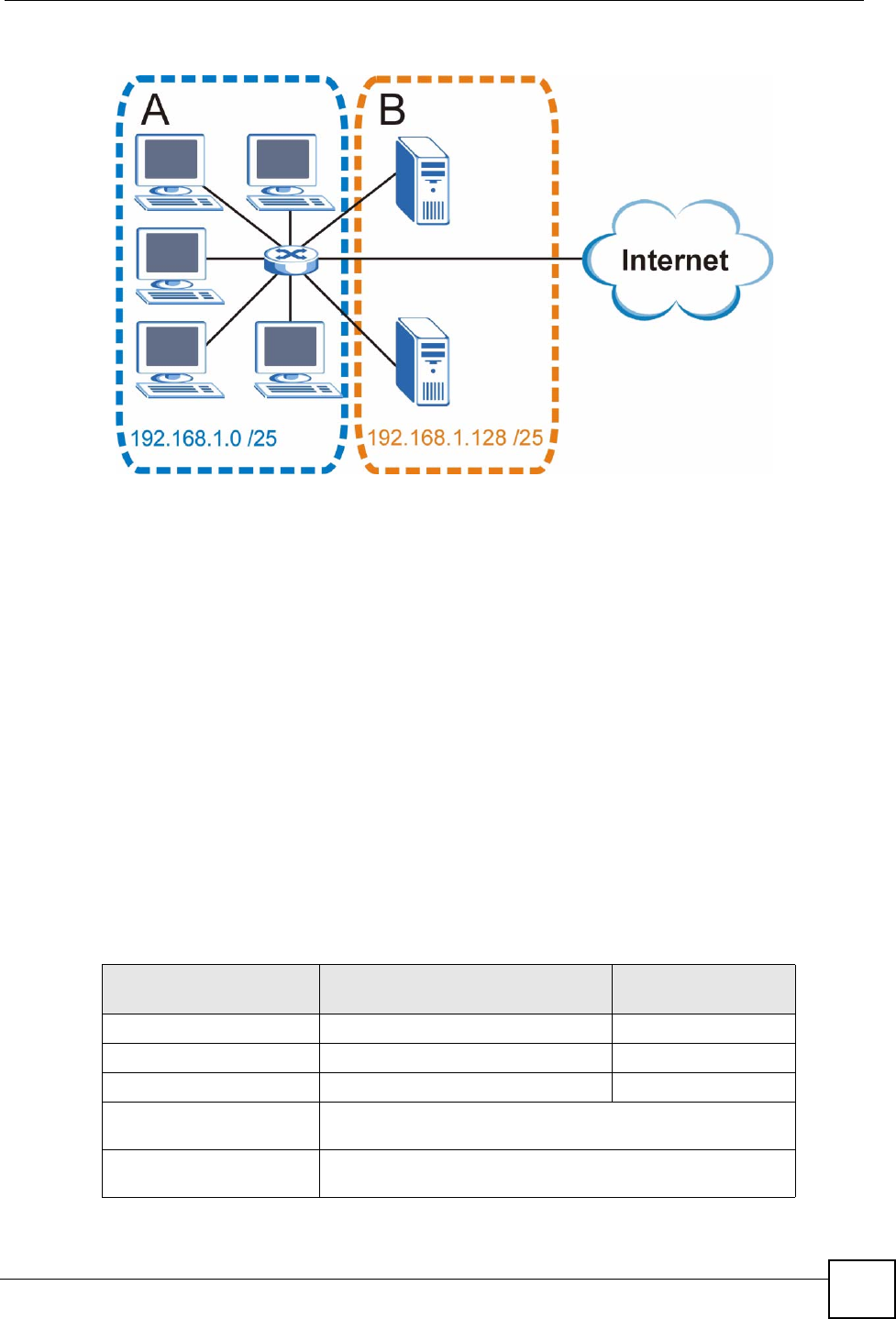
Appendix D IP Addresses and Subnetting
V630 User’s Guide 211
Figure 197 Subnetting Example: After Subnetting
In a 25-bit subnet the host ID has 7 bits, so each sub-network has a maximum of 27 – 2 or 126
possible hosts (a host ID of all zeroes is the subnet’s address itself, all ones is the subnet’s
broadcast address).
192.168.1.0 with mask 255.255.255.128 is subnet A itself, and 192.168.1.127 with mask
255.255.255.128 is its broadcast address. Therefore, the lowest IP address that can be assigned
to an actual host for subnet A is 192.168.1.1 and the highest is 192.168.1.126.
Similarly, the host ID range for subnet B is 192.168.1.129 to 192.168.1.254.
Example: Four Subnets
The previous example illustrated using a 25-bit subnet mask to divide a 24-bit address into two
subnets. Similarly, to divide a 24-bit address into four subnets, you need to “borrow” two host
ID bits to give four possible combinations (00, 01, 10 and 11). The subnet mask is 26 bits
(11111111.11111111.11111111.11000000) or 255.255.255.192.
Each subnet contains 6 host ID bits, giving 26 - 2 or 62 hosts for each subnet (a host ID of all
zeroes is the subnet itself, all ones is the subnet’s broadcast address).
Table 120 Subnet 1
IP/SUBNET MASK NETWORK NUMBER LAST OCTET BIT
VALUE
IP Address (Decimal) 192.168.1. 0
IP Address (Binary) 11000000.10101000.00000001. 00000000
Subnet Mask (Binary) 11111111.11111111.11111111. 11000000
Subnet Address:
192.168.1.0 Lowest Host ID: 192.168.1.1
Broadcast Address:
192.168.1.63 Highest Host ID: 192.168.1.62

Appendix D IP Addresses and Subnetting
V630 User’s Guide
212
Example: Eight Subnets
Similarly, use a 27-bit mask to create eight subnets (000, 001, 010, 011, 100, 101, 110 and
111).
The following table shows IP address last octet values for each subnet.
Table 121 Subnet 2
IP/SUBNET MASK NETWORK NUMBER LAST OCTET BIT
VALUE
IP Address 192.168.1. 64
IP Address (Binary) 11000000.10101000.00000001. 01000000
Subnet Mask (Binary) 11111111.11111111.11111111. 11000000
Subnet Address:
192.168.1.64 Lowest Host ID: 192.168.1.65
Broadcast Address:
192.168.1.127 Highest Host ID: 192.168.1.126
Table 122 Subnet 3
IP/SUBNET MASK NETWORK NUMBER LAST OCTET BIT
VALUE
IP Address 192.168.1. 128
IP Address (Binary) 11000000.10101000.00000001. 10000000
Subnet Mask (Binary) 11111111.11111111.11111111. 11000000
Subnet Address:
192.168.1.128 Lowest Host ID: 192.168.1.129
Broadcast Address:
192.168.1.191 Highest Host ID: 192.168.1.190
Table 123 Subnet 4
IP/SUBNET MASK NETWORK NUMBER LAST OCTET BIT
VALUE
IP Address 192.168.1. 192
IP Address (Binary) 11000000.10101000.00000001. 11000000
Subnet Mask (Binary) 11111111.11111111.11111111. 11000000
Subnet Address:
192.168.1.192 Lowest Host ID: 192.168.1.193
Broadcast Address:
192.168.1.255 Highest Host ID: 192.168.1.254
Table 124 Eight Subnets
SUBNET SUBNET
ADDRESS FIRST ADDRESS LAST
ADDRESS BROADCAST
ADDRESS
1 0 1 30 31
232 33 62 63
364 65 94 95
496 97 126 127

Appendix D IP Addresses and Subnetting
V630 User’s Guide 213
Subnet Planning
The following table is a summary for subnet planning on a network with a 24-bit network
number.
The following table is a summary for subnet planning on a network with a 16-bit network
number.
5128 129 158 159
6160 161 190 191
7192 193 222 223
8224 225 254 255
Table 124 Eight Subnets (continued)
SUBNET SUBNET
ADDRESS FIRST ADDRESS LAST
ADDRESS BROADCAST
ADDRESS
Table 125 24-bit Network Number Subnet Planning
NO. “BORROWED”
HOST BITS SUBNET MASK NO. SUBNETS NO. HOSTS PER
SUBNET
1255.255.255.128 (/25) 2126
2255.255.255.192 (/26) 462
3255.255.255.224 (/27) 830
4255.255.255.240 (/28) 16 14
5255.255.255.248 (/29) 32 6
6255.255.255.252 (/30) 64 2
7255.255.255.254 (/31) 128 1
Table 126 16-bit Network Number Subnet Planning
NO. “BORROWED”
HOST BITS SUBNET MASK NO. SUBNETS NO. HOSTS PER
SUBNET
1255.255.128.0 (/17) 232766
2255.255.192.0 (/18) 416382
3255.255.224.0 (/19) 88190
4255.255.240.0 (/20) 16 4094
5255.255.248.0 (/21) 32 2046
6255.255.252.0 (/22) 64 1022
7255.255.254.0 (/23) 128 510
8255.255.255.0 (/24) 256 254
9255.255.255.128 (/25) 512 126
10 255.255.255.192 (/26) 1024 62
11 255.255.255.224 (/27) 2048 30
12 255.255.255.240 (/28) 4096 14
13 255.255.255.248 (/29) 8192 6

Appendix D IP Addresses and Subnetting
V630 User’s Guide
214
Configuring IP Addresses
Where you obtain your network number depends on your particular situation. If the ISP or
your network administrator assigns you a block of registered IP addresses, follow their
instructions in selecting the IP addresses and the subnet mask.
If the ISP did not explicitly give you an IP network number, then most likely you have a single
user account and the ISP will assign you a dynamic IP address when the connection is
established. If this is the case, it is recommended that you select a network number from
192.168.0.0 to 192.168.255.0. The Internet Assigned Number Authority (IANA) reserved this
block of addresses specifically for private use; please do not use any other number unless you
are told otherwise. You must also enable Network Address Translation (NAT) on the V630.
Once you have decided on the network number, pick an IP address for your V630 that is easy
to remember (for instance, 192.168.1.1) but make sure that no other device on your network is
using that IP address.
The subnet mask specifies the network number portion of an IP address. Your V630 will
compute the subnet mask automatically based on the IP address that you entered. You don't
need to change the subnet mask computed by the V630 unless you are instructed to do
otherwise.
Private IP Addresses
Every machine on the Internet must have a unique address. If your networks are isolated from
the Internet (running only between two branch offices, for example) you can assign any IP
addresses to the hosts without problems. However, the Internet Assigned Numbers Authority
(IANA) has reserved the following three blocks of IP addresses specifically for private
networks:
• 10.0.0.0 — 10.255.255.255
• 172.16.0.0 — 172.31.255.255
• 192.168.0.0 — 192.168.255.255
You can obtain your IP address from the IANA, from an ISP, or it can be assigned from a
private network. If you belong to a small organization and your Internet access is through an
ISP, the ISP can provide you with the Internet addresses for your local networks. On the other
hand, if you are part of a much larger organization, you should consult your network
administrator for the appropriate IP addresses.
Regardless of your particular situation, do not create an arbitrary IP address; always follow the
guidelines above. For more information on address assignment, please refer to RFC 1597,
Address Allocation for Private Internets and RFC 1466, Guidelines for Management of IP
Address Space.
14 255.255.255.252 (/30) 16384 2
15 255.255.255.254 (/31) 32768 1
Table 126 16-bit Network Number Subnet Planning (continued)
NO. “BORROWED”
HOST BITS SUBNET MASK NO. SUBNETS NO. HOSTS PER
SUBNET
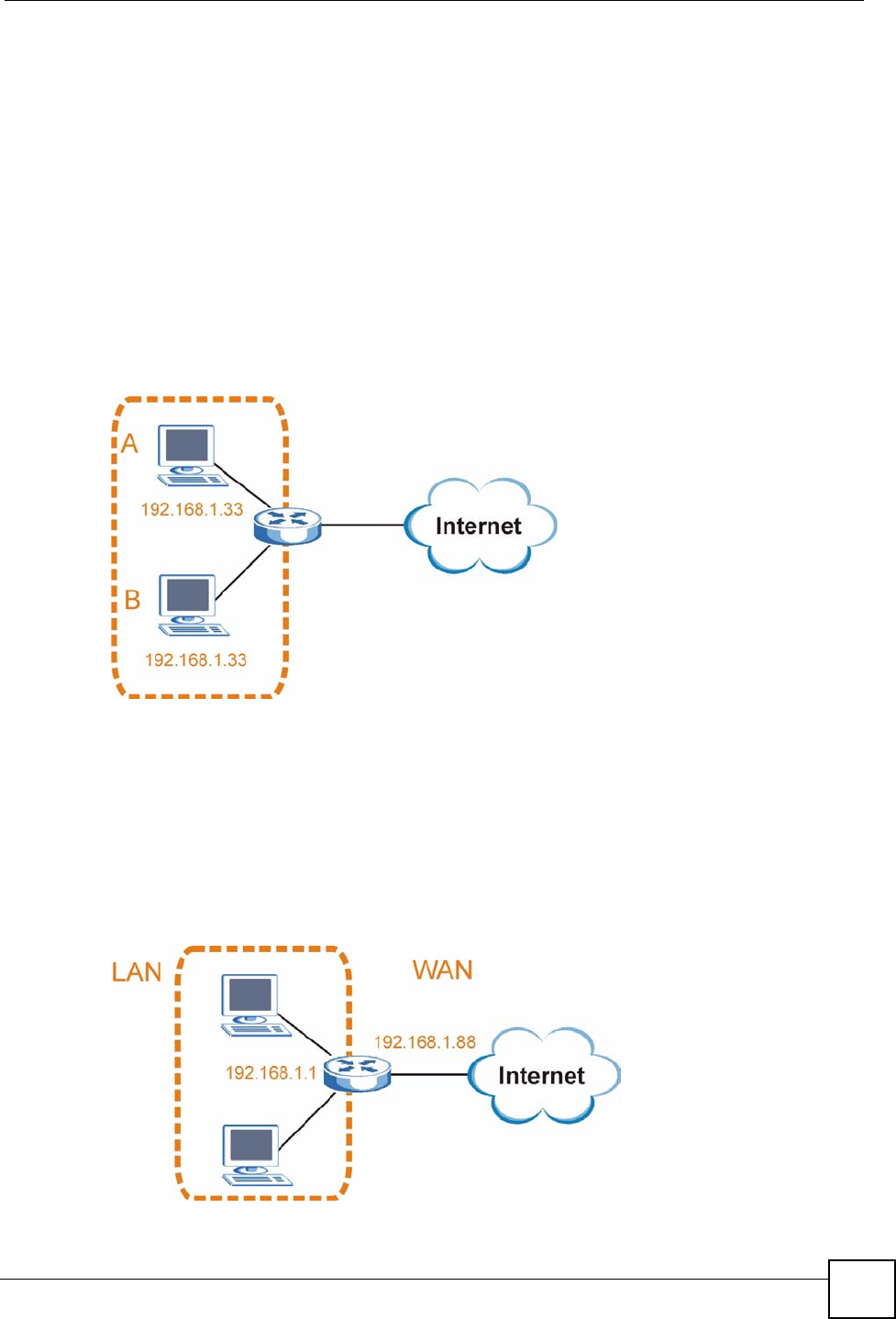
Appendix D IP Addresses and Subnetting
V630 User’s Guide 215
IP Address Conflicts
Each device on a network must have a unique IP address. Devices with duplicate IP addresses
on the same network will not be able to access the Internet or other resources. The devices may
also be unreachable through the network.
Conflicting Computer IP Addresses Example
More than one device can not use the same IP address. In the following example computer A
has a static (or fixed) IP address that is the same as the IP address that a DHCP server assigns
to computer B which is a DHCP client. Neither can access the Internet. This problem can be
solved by assigning a different static IP address to computer A or setting computer A to obtain
an IP address automatically.
Figure 198 Conflicting Computer IP Addresses Example
Conflicting Router IP Addresses Example
Since a router connects different networks, it must have interfaces using different network
numbers. For example, if a router is set between a LAN and the Internet (WAN), the router’s
LAN and WAN addresses must be on different subnets. In the following example, the LAN
and WAN are on the same subnet. The LAN computers cannot access the Internet because the
router cannot route between networks.
Figure 199 Conflicting Computer IP Addresses Example
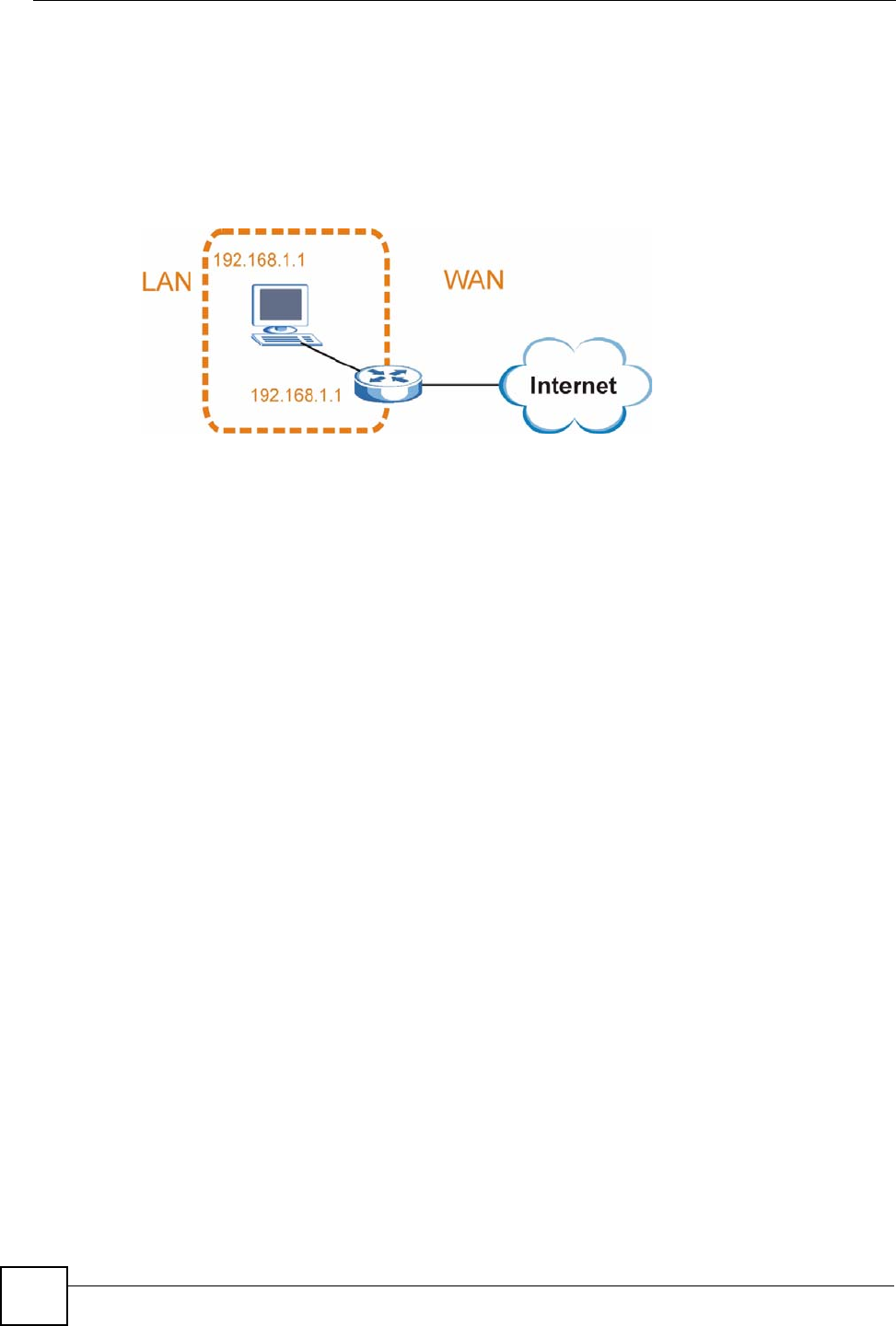
Appendix D IP Addresses and Subnetting
V630 User’s Guide
216
Conflicting Computer and Router IP Addresses Example
More than one device can not use the same IP address. In the following example, the computer
and the router’s LAN port both use 192.168.1.1 as the IP address. The computer cannot access
the Internet. This problem can be solved by assigning a different IP address to the computer or
the router’s LAN port.
Figure 200 Conflicting Computer and Router IP Addresses Example

V630 User’s Guide 217
APPENDIX E
Legal Information
Copyright
Copyright © 2008 by ZyXEL Communications Corporation.
The contents of this publication may not be reproduced in any part or as a whole, transcribed,
stored in a retrieval system, translated into any language, or transmitted in any form or by any
means, electronic, mechanical, magnetic, optical, chemical, photocopying, manual, or
otherwise, without the prior written permission of ZyXEL Communications Corporation.
Published by ZyXEL Communications Corporation. All rights reserved.
Disclaimers
ZyXEL does not assume any liability arising out of the application or use of any products, or
software described herein. Neither does it convey any license under its patent rights nor the
patent rights of others. ZyXEL further reserves the right to make changes in any products
described herein without notice. This publication is subject to change without notice.
Your use of the V630 is subject to the terms and conditions of any related service providers.
Trademarks
ZyNOS (ZyXEL Network Operating System) is a registered trademark of ZyXEL
Communications, Inc. Other trademarks mentioned in this publication are used for
identification purposes only and may be properties of their respective owners.
Certifications
Federal Communications Commission (FCC) Interference Statement
The device complies with Part 15 of FCC rules. Operation is subject to the following two
conditions:
• This device may not cause harmful interference.
• This device must accept any interference received, including interference that may cause
undesired operations.

Appendix E Legal Information
V630 User’s Guide
218
This device has been tested and found to comply with the limits for a Class B digital device
pursuant to Part 15 of the FCC Rules. These limits are designed to provide reasonable
protection against harmful interference in a residential installation. This device generates,
uses, and can radiate radio frequency energy, and if not installed and used in accordance with
the instructions, may cause harmful interference to radio communications. However, there is
no guarantee that interference will not occur in a particular installation.
If this device does cause harmful interference to radio/television reception, which can be
determined by turning the device off and on, the user is encouraged to try to correct the
interference by one or more of the following measures:
1Reorient or relocate the receiving antenna.
2Increase the separation between the equipment and the receiver.
3Connect the equipment into an outlet on a circuit different from that to which the
receiver is connected.
4Consult the dealer or an experienced radio/TV technician for help.
FCC Radiation Exposure Statement
• This device has been tested to the FCC exposure requirements (Specific Absorption Rate).
• This device complies with the requirements of Health Canada Safety Code 6 for Canada.
• Testing was performed on laptop computers with antennas at 0mm spacing. The maximum
SAR value is: 0.128 W/kg. The device must not be collocated with any other antennas or
transmitters.
• The device complies with FCC RF radiation exposure limits set forth for an uncontrolled
environment, under 47 CFR 2.1093 paragraph (d)(2). End users must follow the specific
operating instructions for satisfying RF exposure compliance. To maintain compliance
with FCC RF exposure compliance requirements, please follow operation instruction as
documented in this manual.
• This transmitter must not be co-located or operating in conjunction with any other antenna
or transmitter.
• IEEE 802.11b or 802.11g operation of this product in the U.S.A. is firmware-limited to
channels 1 through 11.
注意 !
依據 低功率電波輻射性電機管理辦法
第十二條 經型式認證合格之低功率射頻電機,非經許可,公司、商號或使用
者均不得擅自變更頻率、加大功率或變更原設計之特性及功能。
第十四條 低功率射頻電機之使用不得影響飛航安全及干擾合法通信;經發現
有干擾現象時,應立即停用,並改善至無干擾時方得繼續使用。
前項合法通信,指依電信規定作業之無線電信。低功率射頻電機須忍
受合法通信或工業、科學及醫療用電波輻射性電機設備之干擾。
在 5250MHz~5350MHz 頻帶內操作之無線資訊傳輸設備,限於室內使用。

Appendix E Legal Information
V630 User’s Guide 219
本機限在不干擾合法電臺與不受被干擾保障條件下於室內使用。
減少電磁波影響,請妥適使用。
Notices
Changes or modifications not expressly approved by the party responsible for compliance
could void the user's authority to operate the equipment.
This device has been designed for the WLAN 2.4 GHz network throughout the EC region and
Switzerland, with restrictions in France.
This Class B digital apparatus complies with Canadian ICES-003.
Cet appareil numérique de la classe B est conforme à la norme NMB-003 du Canada.
Viewing Certifications
1Go to http://www.zyxel.com.
2Select your product on the ZyXEL home page to go to that product's page.
3Select the certification you wish to view from this page.
ZyXEL Limited Warranty
ZyXEL warrants to the original end user (purchaser) that the V630 (not including the battery)
is free from any defects in materials or workmanship for a period of up to two years from the
date of purchase. ZyXEL warrants to the original end user (purchaser) that the V630’s battery
is free from any defects in materials or workmanship for a period of up to three months from
the date of purchase. During the warranty period, and upon proof of purchase, should the
product have indications of failure due to faulty workmanship and/or materials, ZyXEL will,
at its discretion, repair or replace the defective products or components without charge for
either parts or labor, and to whatever extent it shall deem necessary to restore the product or
components to proper operating condition. Any replacement will consist of a new or re-
manufactured functionally equivalent product of equal or higher value, and will be solely at
the discretion of ZyXEL. This warranty shall not apply if the product has been modified,
misused, tampered with, damaged by an act of God, or subjected to abnormal working
conditions.
Note
Repair or replacement, as provided under this warranty, is the exclusive remedy of the
purchaser. This warranty is in lieu of all other warranties, express or implied, including any
implied warranty of merchantability or fitness for a particular use or purpose. ZyXEL shall in
no event be held liable for indirect or consequential damages of any kind to the purchaser.
To obtain the services of this warranty, contact ZyXEL's Service Center for your Return
Material Authorization number (RMA). Products must be returned Postage Prepaid. It is
recommended that the unit be insured when shipped. Any returned products without proof of
purchase or those with an out-dated warranty will be repaired or replaced (at the discretion of

Appendix E Legal Information
V630 User’s Guide
220
ZyXEL) and the customer will be billed for parts and labor. All repaired or replaced products
will be shipped by ZyXEL to the corresponding return address, Postage Paid. This warranty
gives you specific legal rights, and you may also have other rights that vary from country to
country.
Registration
Register your product online to receive e-mail notices of firmware upgrades and information
at www.zyxel.com.

V630 User’s Guide 221
APPENDIX F
Customer Support
Please have the following information ready when you contact customer support.
Required Information
• Product model and serial number.
• Warranty Information.
• Date that you received your device.
• Brief description of the problem and the steps you took to solve it.
“+” is the (prefix) number you dial to make an international telephone call.
Corporate Headquarters (Worldwide)
• Support E-mail: support@zyxel.com.tw
• Sales E-mail: sales@zyxel.com.tw
• Telephone: +886-3-578-3942
• Fax: +886-3-578-2439
• Web: www.zyxel.com, www.europe.zyxel.com
• FTP: ftp.zyxel.com, ftp.europe.zyxel.com
• Regular Mail: ZyXEL Communications Corp., 6 Innovation Road II, Science Park,
Hsinchu 300, Taiwan
Costa Rica
• Support E-mail: soporte@zyxel.co.cr
• Sales E-mail: sales@zyxel.co.cr
• Telephone: +506-2017878
• Fax: +506-2015098
• Web: www.zyxel.co.cr
• FTP: ftp.zyxel.co.cr
• Regular Mail: ZyXEL Costa Rica, Plaza Roble Escazú, Etapa El Patio, Tercer Piso, San
José, Costa Rica
Czech Republic
• E-mail: info@cz.zyxel.com
• Telephone: +420-241-091-350
• Fax: +420-241-091-359
• Web: www.zyxel.cz

Appendix F Customer Support
V630 User’s Guide
222
• Regular Mail: ZyXEL Communications, Czech s.r.o., Modranská 621, 143 01 Praha 4 -
Modrany, Ceská Republika
Denmark
• Support E-mail: support@zyxel.dk
• Sales E-mail: sales@zyxel.dk
• Telephone: +45-39-55-07-00
• Fax: +45-39-55-07-07
• Web: www.zyxel.dk
• Regular Mail: ZyXEL Communications A/S, Columbusvej, 2860 Soeborg, Denmark
Finland
• Support E-mail: support@zyxel.fi
• Sales E-mail: sales@zyxel.fi
• Telephone: +358-9-4780-8411
• Fax: +358-9-4780-8448
• Web: www.zyxel.fi
• Regular Mail: ZyXEL Communications Oy, Malminkaari 10, 00700 Helsinki, Finland
France
• E-mail: info@zyxel.fr
• Telephone: +33-4-72-52-97-97
• Fax: +33-4-72-52-19-20
• Web: www.zyxel.fr
• Regular Mail: ZyXEL France, 1 rue des Vergers, Bat. 1 / C, 69760 Limonest, France
Germany
• Support E-mail: support@zyxel.de
• Sales E-mail: sales@zyxel.de
• Telephone: +49-2405-6909-69
• Fax: +49-2405-6909-99
• Web: www.zyxel.de
• Regular Mail: ZyXEL Deutschland GmbH., Adenauerstr. 20/A2 D-52146, Wuerselen,
Germany
Hungary
• Support E-mail: support@zyxel.hu
• Sales E-mail: info@zyxel.hu
• Telephone: +36-1-3361649
• Fax: +36-1-3259100
• Web: www.zyxel.hu
• Regular Mail: ZyXEL Hungary, 48, Zoldlomb Str., H-1025, Budapest, Hungary

Appendix F Customer Support
V630 User’s Guide 223
India
• Support E-mail: support@zyxel.in
• Sales E-mail: sales@zyxel.in
• Telephone: +91-11-30888144 to +91-11-30888153
• Fax: +91-11-30888149, +91-11-26810715
• Web: http://www.zyxel.in
• Regular Mail: India - ZyXEL Technology India Pvt Ltd., II-Floor, F2/9 Okhla Phase -1,
New Delhi 110020, India
Japan
• Support E-mail: support@zyxel.co.jp
• Sales E-mail: zyp@zyxel.co.jp
• Telephone: +81-3-6847-3700
• Fax: +81-3-6847-3705
• Web: www.zyxel.co.jp
• Regular Mail: ZyXEL Japan, 3F, Office T&U, 1-10-10 Higashi-Gotanda, Shinagawa-ku,
Tokyo 141-0022, Japan
Kazakhstan
• Support: http://zyxel.kz/support
• Sales E-mail: sales@zyxel.kz
• Telephone: +7-3272-590-698
• Fax: +7-3272-590-689
• Web: www.zyxel.kz
• Regular Mail: ZyXEL Kazakhstan, 43 Dostyk Ave., Office 414, Dostyk Business Centre,
050010 Almaty, Republic of Kazakhstan
Malaysia
• Support E-mail: support@zyxel.com.my
• Sales E-mail: sales@zyxel.com.my
• Telephone: +603-8076-9933
• Fax: +603-8076-9833
• Web: http://www.zyxel.com.my
• Regular Mail: ZyXEL Malaysia Sdn Bhd., 1-02 & 1-03, Jalan Kenari 17F, Bandar
Puchong Jaya, 47100 Puchong, Selangor Darul Ehsan, Malaysia
North America
• Support E-mail: support@zyxel.com
• Support Telephone: +1-800-978-7222
• Sales E-mail: sales@zyxel.com
• Sales Telephone: +1-714-632-0882
• Fax: +1-714-632-0858
• Web: www.zyxel.com

Appendix F Customer Support
V630 User’s Guide
224
• Regular Mail: ZyXEL Communications Inc., 1130 N. Miller St., Anaheim, CA 92806-
2001, U.S.A.
Norway
• Support E-mail: support@zyxel.no
• Sales E-mail: sales@zyxel.no
• Telephone: +47-22-80-61-80
• Fax: +47-22-80-61-81
• Web: www.zyxel.no
• Regular Mail: ZyXEL Communications A/S, Nils Hansens vei 13, 0667 Oslo, Norway
Poland
• E-mail: info@pl.zyxel.com
• Telephone: +48-22-333 8250
• Fax: +48-22-333 8251
• Web: www.pl.zyxel.com
• Regular Mail: ZyXEL Communications, ul. Okrzei 1A, 03-715 Warszawa, Poland
Russia
• Support: http://zyxel.ru/support
• Sales E-mail: sales@zyxel.ru
• Telephone: +7-095-542-89-29
• Fax: +7-095-542-89-25
• Web: www.zyxel.ru
• Regular Mail: ZyXEL Russia, Ostrovityanova 37a Str., Moscow 117279, Russia
Singapore
• Support E-mail: support@zyxel.com.sg
• Sales E-mail: sales@zyxel.com.sg
• Telephone: +65-6899-6678
• Fax: +65-6899-8887
• Web: http://www.zyxel.com.sg
• Regular Mail: ZyXEL Singapore Pte Ltd., No. 2 International Business Park, The Strategy
#03-28, Singapore 609930
Spain
• Support E-mail: support@zyxel.es
• Sales E-mail: sales@zyxel.es
• Telephone: +34-902-195-420
• Fax: +34-913-005-345
• Web: www.zyxel.es
• Regular Mail: ZyXEL Communications, Arte, 21 5ª planta, 28033 Madrid, Spain

Appendix F Customer Support
V630 User’s Guide 225
Sweden
• Support E-mail: support@zyxel.se
• Sales E-mail: sales@zyxel.se
• Telephone: +46-31-744-7700
• Fax: +46-31-744-7701
• Web: www.zyxel.se
• Regular Mail: ZyXEL Communications A/S, Sjöporten 4, 41764 Göteborg, Sweden
Thailand
• Support E-mail: support@zyxel.co.th
• Sales E-mail: sales@zyxel.co.th
• Telephone: +662-831-5315
• Fax: +662-831-5395
• Web: http://www.zyxel.co.th
• Regular Mail: ZyXEL Thailand Co., Ltd., 1/1 Moo 2, Ratchaphruk Road, Bangrak-Noi,
Muang, Nonthaburi 11000, Thailand.
Ukraine
• Support E-mail: support@ua.zyxel.com
• Sales E-mail: sales@ua.zyxel.com
• Telephone: +380-44-247-69-78
• Fax: +380-44-494-49-32
• Web: www.ua.zyxel.com
• Regular Mail: ZyXEL Ukraine, 13, Pimonenko Str., Kiev 04050, Ukraine
United Kingdom
• Support E-mail: support@zyxel.co.uk
• Sales E-mail: sales@zyxel.co.uk
• Telephone: +44-1344-303044, 08707-555779 (UK only)
• Fax: +44-1344-303034
• Web: www.zyxel.co.uk
• FTP: ftp.zyxel.co.uk
• Regular Mail: ZyXEL Communications UK Ltd., 11 The Courtyard, Eastern Road,
Bracknell, Berkshire RG12 2XB, United Kingdom (UK)

Appendix F Customer Support
V630 User’s Guide
226

Index
V630 User’s Guide 227
Index
A
AbS (Analysis-by-Synthesis) 134
access point, See AP 119
ACK message 130
address assignment 121
Advanced Encryption Standard
See AES.
AES 188
alphanumeric keypad 35
alternative subnet mask notation 209
Analysis-by-Synthesis (AbS) 134
AP 119
AP (access point) 181
B
Band 151
Basic Service Set, See BSS 179
block list 40
BSS 179
BYE request 130
C
CA 186
call forwarding 125
Certificate Authority
See CA.
certifications 217
notices 219
viewing 219
channel 119, 151, 181
interference 181
circuit-switched telephone networks 129
client server
SIP 130
client-server protocol 130
codec 133
codecs
and required bandwidth 134
hybrid waveform 134
coder/decoder 133
comfort noise generation 153
communications standards 151
contact information 221
contact list 40, 99, 103, 127, 128
copyright 217
CTS (Clear to Send) 182
customer support 221
D
data rate 152
decoder 133
dialing screen 99, 101, 102, 103
dimensions 151
disclaimer 217
DND white list 40
DNS server
address assignment 121
Domain Name System. See DNS.
dynamic jitter buffer 152
dynamic WEP key exchange 187
E
EAP Authentication 185
echo cancellation 153
encryption 121, 188
key 121
WPA compatible 120
entering text 36
ESS 180
Extended Service Set, See ESS 180
F
FCC interference statement 217
Firmware upload 142

Index
V630 User’s Guide
228
file extension
using HTTP
fragmentation threshold 182
frequency 151
G
G.168 153
G.711 133
G.726 133
G.729 134
gateway 65
group 40
H
hidden node 181
hide SSID 120
humidity 151
hybrid waveform codec 134
I
IANA 214
IBSS 179
IEEE 802.11g 183
Independent Basic Service Set
See IBSS 179
Industrial Scientific Medical Band 151
initialization vector (IV) 188
Internet Assigned Numbers Authority
See IANA 214
Internet Protocol Private Branch Exchange 30
Internet Telephony Service Provider 29
Internet telephony service provider 129
IP to IP Calls 31, 99
IP-PBX 30, 129
ITSP 29, 129
J
jitter buffer 152
K
keypad 35
keypad characters 36
L
lowercase mode 36
M
managing the device
good habits 31
Menu key 35
menu navigation 35
menus
overview 37
Message Integrity Check (MIC) 188
modulation 152
multimedia 129
N
NAT 214
NAT (Network Address Translation) 132
NAT routers 133
navigation 35
navigation panel 115
network address translators 133, 153
number mode 36
O
OK response 130
outbound proxy 132, 133
SIP 133
outbound proxy server 133
output power 152

Index
V630 User’s Guide 229
P
Pairwise Master Key (PMK) 188, 190
PBX services 129
PCM 133
peer-to-peer calls 31
Phone 127
phonebook 40, 99, 125, 127
delete 104, 107
edit 103
Point 31, 99
Point to Point Calls 31
Point-to-Point Protocol over Ethernet, See PPPoE 121
power specification 151
preamble mode 183
product registration 220
proxy server
SIP 131
PSK 188
pulse code modulation 133
Q
QoS 153
quality of service
see QoS
R
radio specifications 151
RADIUS 184
message types 185
messages 185
shared secret key 185
real-time transport protocol 132
redirect server
SIP 131
register server
SIP 132
registration
product 220
related documentation 3
required bandwidth, and VoIP 134
RFC 1631 132
RFC 1889 132
RFC 3489 133
ring tone 45
RTP 132
RTS (Request To Send) 182
threshold 181, 182
S
safety warnings 6
sensitivity 152
server, outbound proxy 133
Service Set IDentity, See SSID 122
Service Set IDentity, See SSID. 119
session initiation protocol
see SIP
silence suppression 152
SIP 129
SIP account 129
SIP ACK message 130
SIP BYE request 130
SIP call progression 130
SIP client 130
SIP client server 130
SIP identities 129
SIP INVITE request 130
SIP number 129
SIP OK response 130
SIP outbound proxy 133
SIP proxy server 131
SIP redirect server 131
SIP register server 132
SIP servers 130
SIP service domain 130
SIP URI 129
SIP user agent 130
speed dial 40
SSID 119, 122
hide 120
status screen 115
STUN 132, 133
subnet 207
subnet mask 65, 208
subnetting 210
symbol mode 36
syntax conventions 4

Index
V630 User’s Guide
230
T
temperature 151
Temporal Key Integrity Protocol (TKIP) 188
trademarks 217
U
uniform resource identifier 129
uppercase mode 36
use NAT 133
user agent, SIP 130
user authentication
weaknesses 121
V
VAD 152
voice activity detection 152
voice coding 133
voice mail 129
voice over IP
see VoIP
VoIP 129
and required bandwidth 134
W
WAN IP address 121
warranty 219
note 219
waveform codec 133
web configurator 113
Wi-Fi Protected Access 187
wireless
general settings 122
wireless client 119
wireless client WPA supplicants 189
wireless network
basic guidelines 119
channel 119
encryption 121
example 119
overview 119
security 120
SSID 119
wireless security 120, 183
WLAN
interference 181
security parameters 190
WPA 187
key caching 188
pre-authentication 188
user authentication 188
vs WPA-PSK 188
wireless client supplicant 189
with RADIUS application example 189
WPA compatible 120
WPA2 187
user authentication 188
vs WPA2-PSK 188
wireless client supplicant 189
with RADIUS application example 189
WPA2-Pre-Shared Key 187
WPA2-PSK 187, 188
application example 189
WPA-PSK 187, 188
application example 189





